Gear-obsessed editors choose every product we review. We may earn commission if you buy from a link. How we test gear.
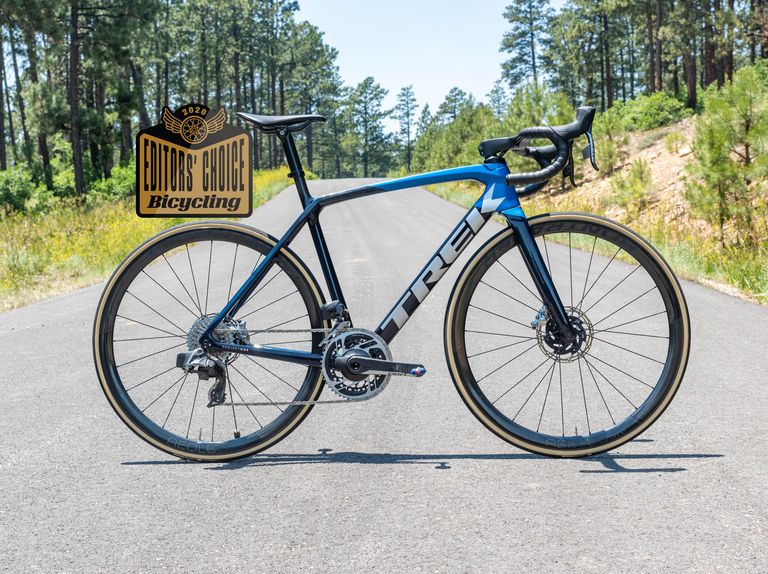

The New Trek Émonda Is Faster Than Ever
Already one of the fiercest climbing bikes available, the new Émonda is even faster thanks to a dose of aero.
The Takeaway: The Émonda SLR is a benchmark pro race bike—and it’s surprisingly rider friendly.
- It has 183 grams less drag than the previous generation, but the frame is only 33 grams heavier
- There are 10 models starting at $2,699
- SL models ($2,699 to $5,999) have the aerodynamic shaping and features but in a frame that’s about 400 grams heavier than the SLR
- SLR models ($6,699 and up) use a new carbon fiber composite that’s 30 percent stronger than Trek’s previous top-of-the-line carbon.
Price: $11,999 as tested (Émonda SLR 9 eTap) Weight: 14.75 lb. (54cm) View Gallery
Update: On August 25, 2022, Trek Bicycles and the CPSC announced a recall of this Émonda SLR model to address an issue with the Bontrager Aeolus RSL VR-C handlebar and stem. The bike's carbon handlebar/stem can crack if overloaded, causing the rider to lose control of the bike. Customers are asked to stop using the bike and to contact their local Trek dealer.
For Émonda SLR bicycles, Trek will provide an individual handlebar and stem until an updated handlebar/stem combo is available.
Additionally, all customers who bring in their handlebars for replacement will also receive a $100 in-store credit that can be used toward any Trek or Bontrager merchandise through December 31, 2022.
Remember professional road racing ? It’s that thing where super skinny people go unbelievably fast up and down hills and fly over flat roads for hours at a time. It’s been a while since the pros have beat up on each other for our entertainment, but there might, hopefully, be some races on the horizon. When the races do resume, Trek’s pro riders will be aboard its new third-generation Émonda climbing bike. The new Émonda isn’t lighter, but it is faster thanks to a dose of aerodynamic tuning.
—Five Cool Details—
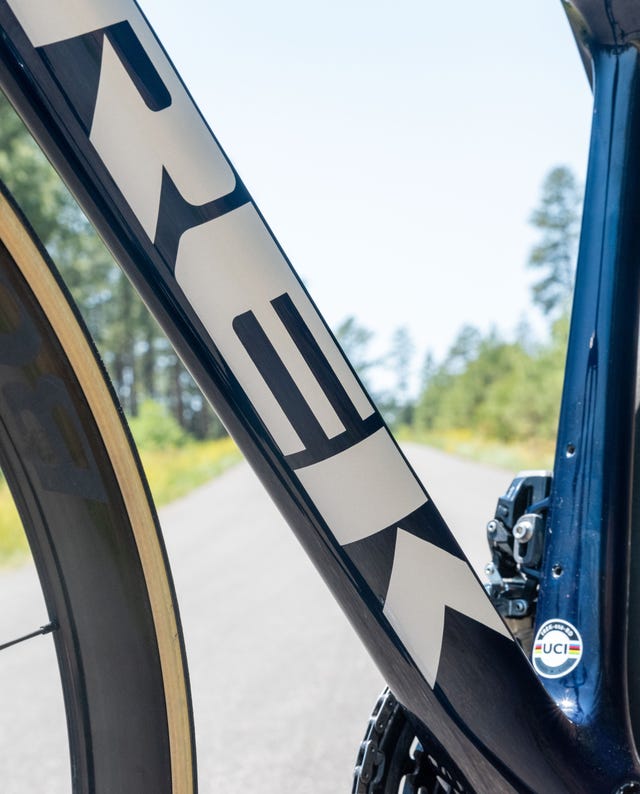
Now With Aero
The new Émonda gets a major drag reduction with a tiny weight gain.
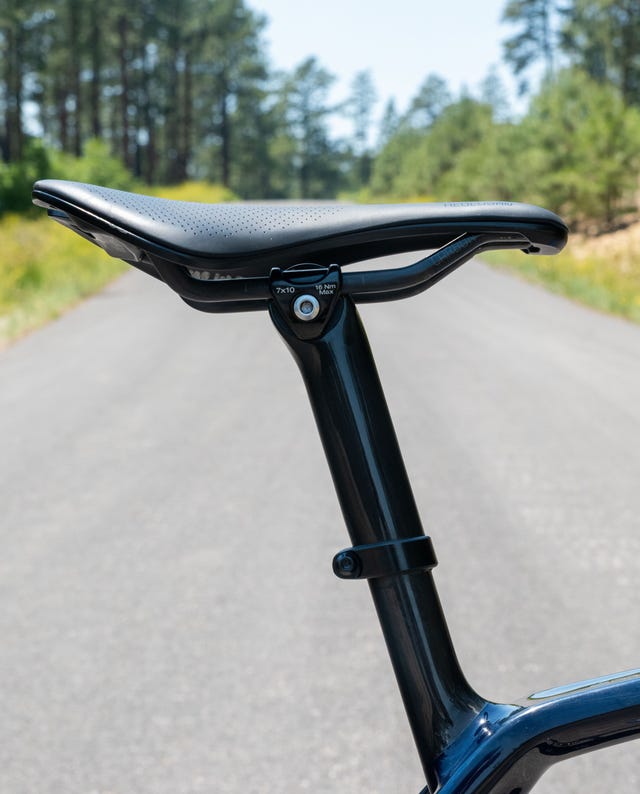
Simple Seat Mast
The seat mast has lots of adjustment range, and an easy-to-use saddle clamp.
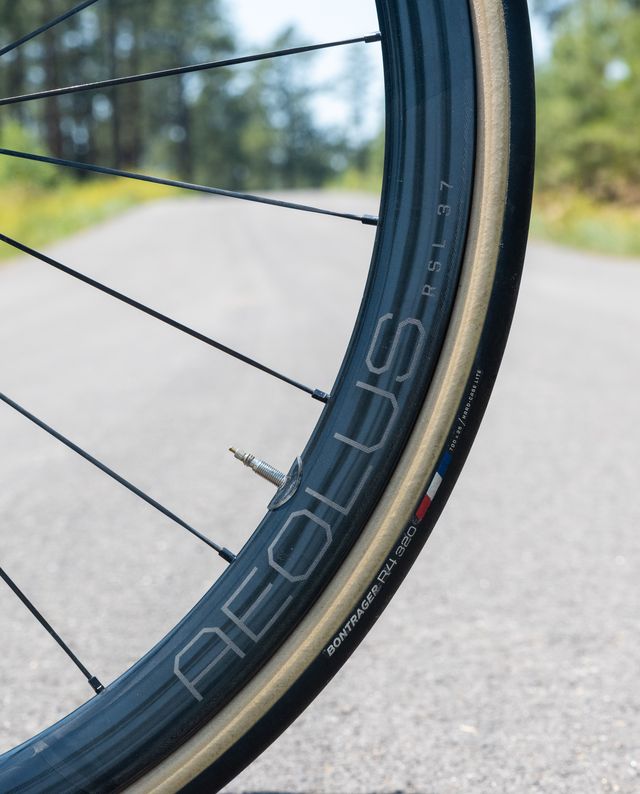
Light and Slippery
The new Bontrager Aeolus RSL 37 wheels are light, sleek, and stable.
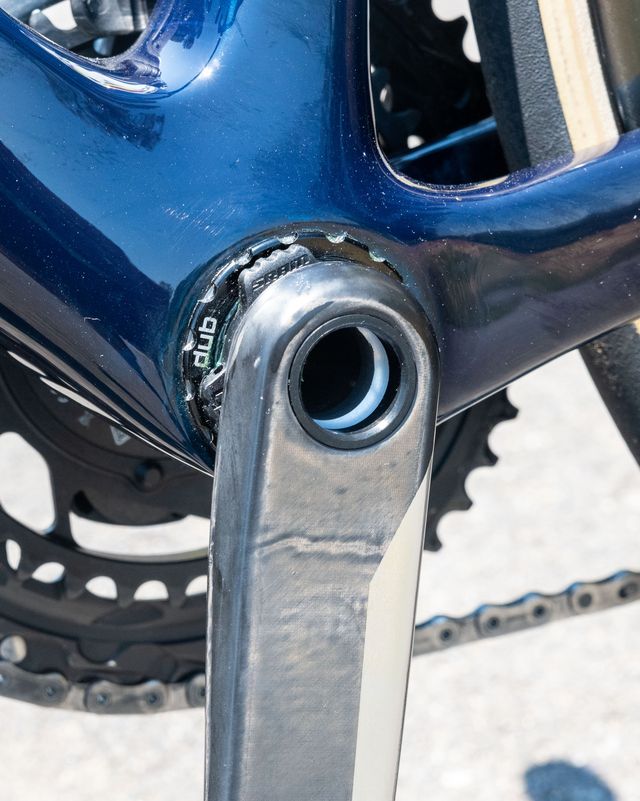
Wide and Threaded
The T47 bottom bracket has a wide stance, and user-friendly threads.
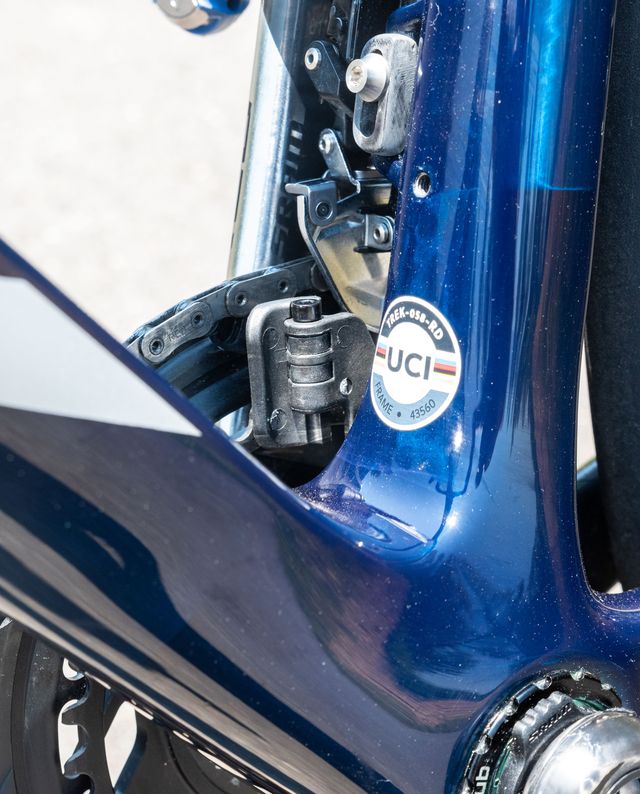
A built-in chain watcher prevents unwanted derailments.
Making the new Émonda frame more aerodynamic wasn’t exactly a tough hurdle as the previous Émonda had virtually zero aerodynamic optimization. But adding meaningful aerodynamic benefit while achieving the frame stiffness expected of a pro-caliber race bike, maintaining the well-regarded handling properties of the previous Émonda, and adding rider-friendly features like a threaded bottom bracket—all with adding only 33 grams (SLR frame, claimed)—is quite a feat.
Below you’ll find my review of the Émonda SLR—I’ve been on it since early March—followed by a dive into the technology and features of the new bike, and a brief model breakdown.
Ride Impressions: Émonda SLR 9 eTap

The Émonda SLR is a tool made to fulfill the needs of some of the world’s best road racers. This bike will never be as comfortable or versatile as a gravel bike. Going fast on pavement and climbing performance are its only goals. These are obvious facts, but that’s the lens through which it must be viewed. And through this lens, it is one of the very best.
The new Émonda was born out of a request from Trek’s pro racers and pitched as the company’s “fastest climbing bike ever.” So little surprise they set me up with the lightest model (the SLR 9 with SRAM Red eTap ), which also has a build kit almost identical to the team’s bikes. It’s also, excepting customized Project One builds, the most expensive model at a buck under 12 grand.
That massive pile of clams gets you an aerodynamic frame with disc brakes, power meter, and wireless electronic shifting that weighs less than 15 pounds (54cm). And that’s with a hefty T47 threaded bottom bracket unit, lustrous paint , clincher wheelset, a chain-watcher, standard butyl tubes, 37mm deep rims, 160mm disc rotors front and rear, and SRAM’s largest Red cassette (10-33). That’s “Holy shit!” impressive.
By cutting drag a ton without adding much weight, it’s hard to argue with Trek’s claim that the new Émonda is faster than the outgoing generation. But if you have any doubts, they’ll be erased when you ride it. This is an explosive bike: it feels as light as a feather and as solid as a steel girder at the same time.
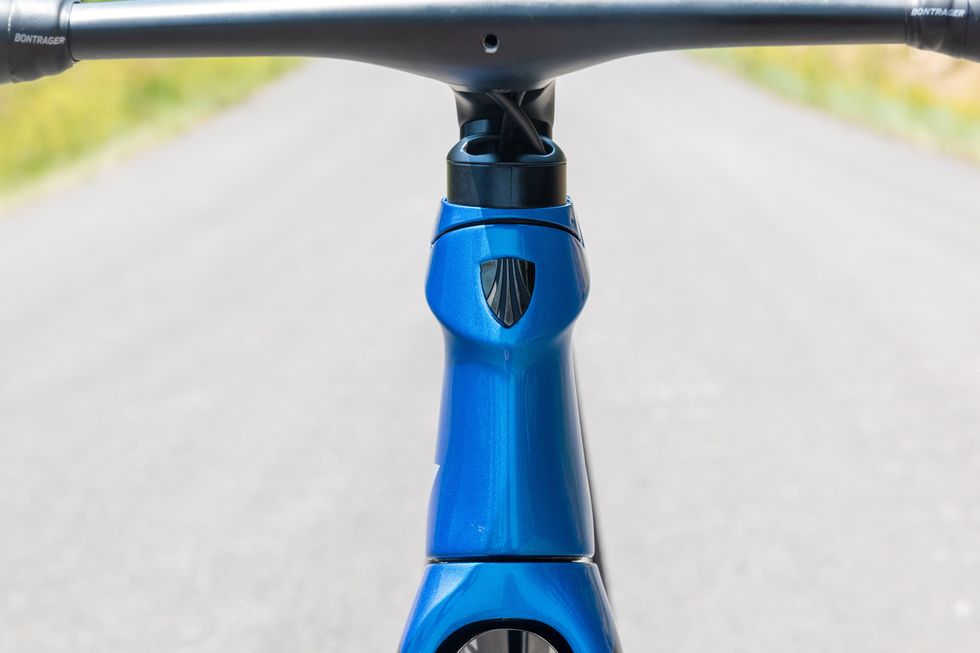
Trek’s Émonda has always been a raw and rowdy bike that feels a little wild and a bit dangerous in precisely the ways you want a race bike to feel: That’s not lost with the added aerodynamics. If anything, the new Émonda is even crisper and punchier than before, which is saying something.

A small downside to all this fury is the Émonda’s smoothness. Light and stiff race bikes aren’t a smooth-riding lot to begin with, but even measured against a stiffer riding genre, the new Émonda is on the firmer end of the scale. Still, it escapes harsh or punishing labels—I did a six-hour ride on the Émonda on the stock 25 tires and didn’t feel worn down by its ride. Swapping to 28s helped a lot (no surprise) and were on the Émonda for the bulk of my testing. I’d suggest reserving the lighter and more aerodynamic stock 25s for racing or PR attempts—assuming good roads—and use 28s as daily drivers.
The Émonda’s handling is excellent. Well, let me caveat that: Road racing geometry is pretty uniform, so whether I’m on a current race bike from Trek, Specialized, Cannondale, Cervélo, Canyon, Colnago, Wilier, Pinarello, BMC, Giant (etc., etc.), I find the broad strokes of their handling feel and performance quite similar. There wasn’t anything about the Émonda’s handling or cornering performance that set any new benchmarks for me, but there wasn’t anything to dislike either.
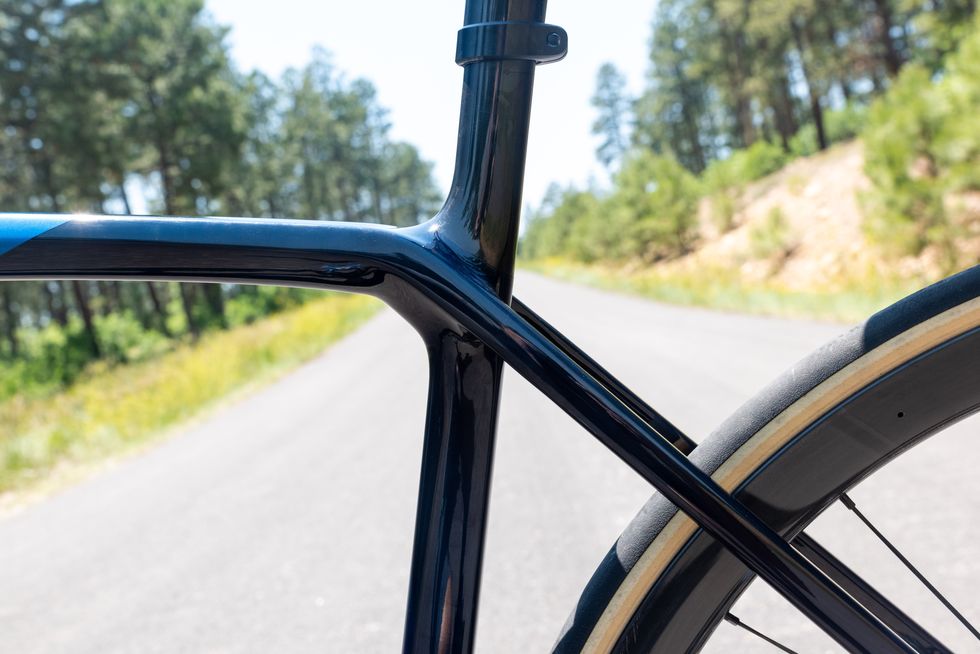
It was quick and accurate, diving into corners with a light touch. It offered great feedback, so I always knew where I was relative to its and my limits, and I could count on it to be consistent and predictable. It was maybe a touch less settled in bumpy corners than the Specialized Tarmac, but the Émonda never broke traction or skipped. Overall, for such a light bike, the Émonda is remarkably solid and drama free. I’d have no qualms barreling down a technical alpine descent on the Émonda.
I received this test bike in early March, giving me plenty of time to ride it back to back with its primary competition—a Specialized S-Works Tarmac , what I consider the benchmark for aero-ized lightweight bikes. The Tarmac is smoother over the bumps and has a silkier feel overall, but the new Émonda feels more efficient, like it can go faster more easily.
I’ve also ridden a good slice of the Émonda’s competition, including the Canyon Ultimate CF SLX , Colnago V3Rs, Cannondale SuperSix Evo , Cervélo R5, Wilier Zero SLR , Pinarello Dogma F12 . These are all superb bikes, but I feel the Émonda is the class leader. It feels sharper and more explosive than all of them. It feels faster, and that’s what matters most in a race bike. But I also like that the Émonda is pretty straightforward and rider-friendly.
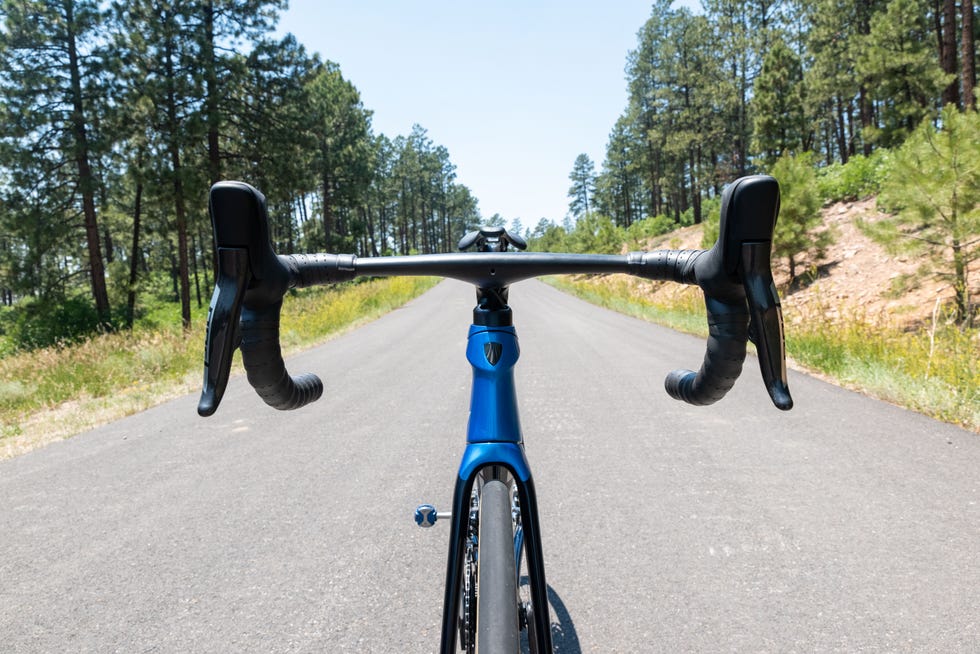
For example, I swapped the stock one-piece bar/stem for a standard stem and round bar. One, I could run a standard bar and stem on this bike, which you can’t say about every modern race bike. And two, I didn’t have to pull any cables, wires, or hoses to make the swap: Again, something you can’t say about all race bikes. For the record, the shape of the one-piece Aeolus bar/stem is great, and the tops are the most comfortable to grab of all the aero-topped bars I've used. The only reason I swapped is my preferred length and width combination (110x40) wasn't available yet.
The BB is threaded, which makes it easier to service and replace than a press-fit (however, I was getting some noise out of the BB area, which I never resolved). The wheels employ standard offset, and it uses regular thru-axles. It’s compatible with pod-style power meters and mechanical shifting. Its signature seat mast is pretty much the only non-standard thing about this frame, and even then, it’s pretty user-friendly. There’s no cutting necessary, height adjustment is ample, the saddle clamp is easy to use, and it’s travel-case friendly.
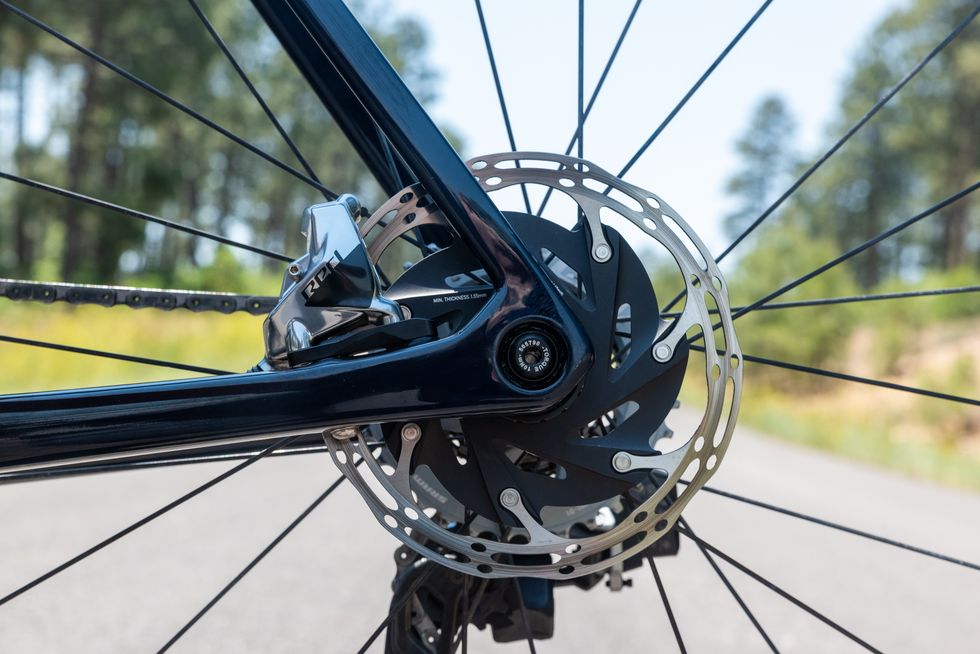
I expect so much from a modern high-end pro-level road racing bike that it’s hard to exceed those expectations. It’s rare when a bike does: The Émonda SLR is one of those rare bikes.
Team Request
The new Émonda is partially a result of a request from the Trek-Segafredo race team. “They are one of our primary customers,” said Jordan Roessingh, Trek’s director of road product. “And they started to realize that it’s not just weight, it’s not just stiffness and responsiveness, there’s this other thing—aerodynamics and speed—that’s also really important to be competitive and be faster on the bike. They had been one of the loudest voices saying, ‘We need the lightest-weight, stiffest bike possible.’ And now they started coming back saying ‘We need those things, but we also need the bike to be faster in order for us to be really competitive.’ ”
It is (comparatively) easy to make a light frame, it is easy to make a stiff frame, it is easy to make an aerodynamic frame. Making a frame that’s two of those three things is more challenging: Making a bike more aerodynamic usually makes it heavier, making a bike lighter typically makes it less stiff, etc. Making a frame that is light AND stiff AND aerodynamic enough to satisfy the demands of a top-level professional race team is extremely difficult.
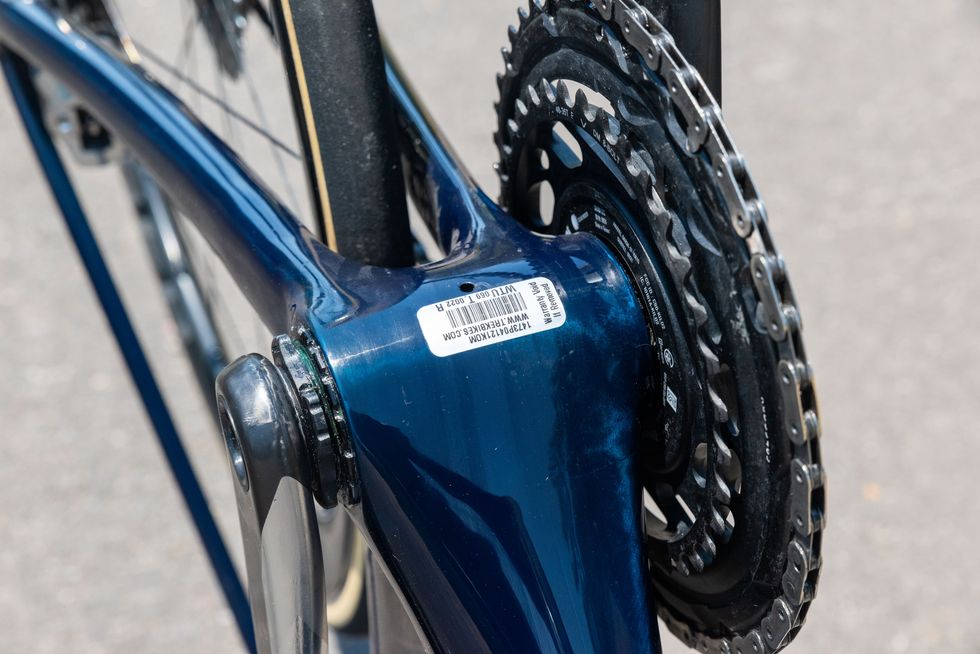
But not impossible. Many brands already make a light, stiff, and aero bike. The Specialized Tarmac is one, as are the Canyon Ultimate, the Cannondale SuperSix Evo, the Cervélo R5, the Wilier Zero SLR, the Pinarello F12, the Scott Addict, and the new Giant TCR . All of them seek to balance the three qualities—light, stiff, and aero—in the pursuit of the ideal race bike, and they all manage the balance differently. The common thread between these bikes: They’re all used by teams that compete against Trek-Segafredo.
Still Light, Now With Aero
The previous generation Émonda SLR Disc , launched in 2017, was an extremely light frame at 665 grams (claimed). But when a frame is already that light, it is much harder to make it even lighter. At least lighter enough to make a meaningful difference.
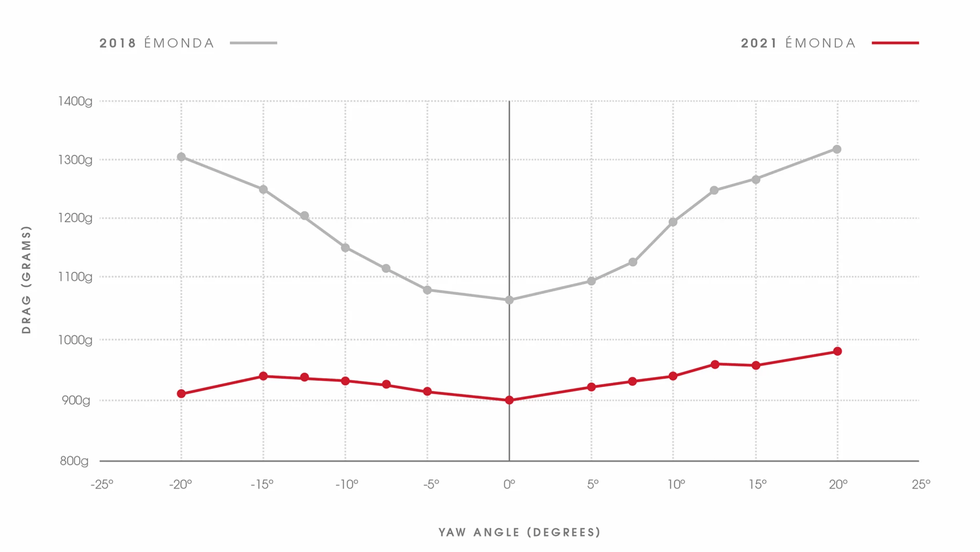
So, Trek took a different approach to making its climbing bike faster—instead of lighter, it made it more aerodynamic. The new Émonda frame is a touch heavier—yet still extremely light at 698 grams—but the bike has 183 grams less drag than the previous generation.
The important thing to note here is that, though the frame is more aerodynamic, the 183 gram drag reduction is not from the frame only. New wheels and a new aero bar (more info on both below) play a role. The specific setups Trek used to get that 183 gram number are: 2018 Émonda with 28mm-deep Bontrager XXX 2 wheels, and Bontrager XXX Bar/Stem Combo compared to the 2021 Émonda with 37mm deep Bontrager Aeolus RSL 37 Wheels and Bontrager Aeolus RSL Bar/Stem Combo.

Another drag saving upgrade: the housing, hoses and wires for the controls are almost fully inside the frame. They dive into the frame at the head tube passing through the upper headset bearing. The front brake hose runs into the fork steerer and down the left leg before popping out just above the brake caliper. The fork steerer’s flattened sides provide room for the rear brake hose and derailleur control lines to travel down and into the frame. Though it has flattened sides, the fork steerer is still compatible with standard 1 1/8” stems.
The overall drag reduction results in a bike that is 18 seconds per hour faster when climbing an 8.1 percent grade (the average grade of Alpe d’Huez ), and 60 seconds per hour faster on flat roads than the previous Émonda. Trek also claims the new Émonda is 13 seconds per hour faster than a Specialized Tarmac when climbing an 8.1 percent grade (all assuming the rider maintains a constant 350 watts).
Eight Point One Percent
With three qualities—aero, stiffness, weight—that work in opposition to each other, how do you decide how much to optimize one quality when you know it will negatively affect the other two? How aero is aero enough? At what point is improved aerodynamics offset by the weight added to get there?
The team behind the Émonda used a legendary climb to help them decide: Alpe d’Huez. “It represents an extreme example of what most people see on a regular basis when they’re doing a big climbing ride,” said Roessingh, “It’s around an 8 percent grade, and it’s about an hour-long climb for the pros—amateurs might go a little slower. It gives us a good understanding of what the benefit of a drag savings is relative to a weight savings.”
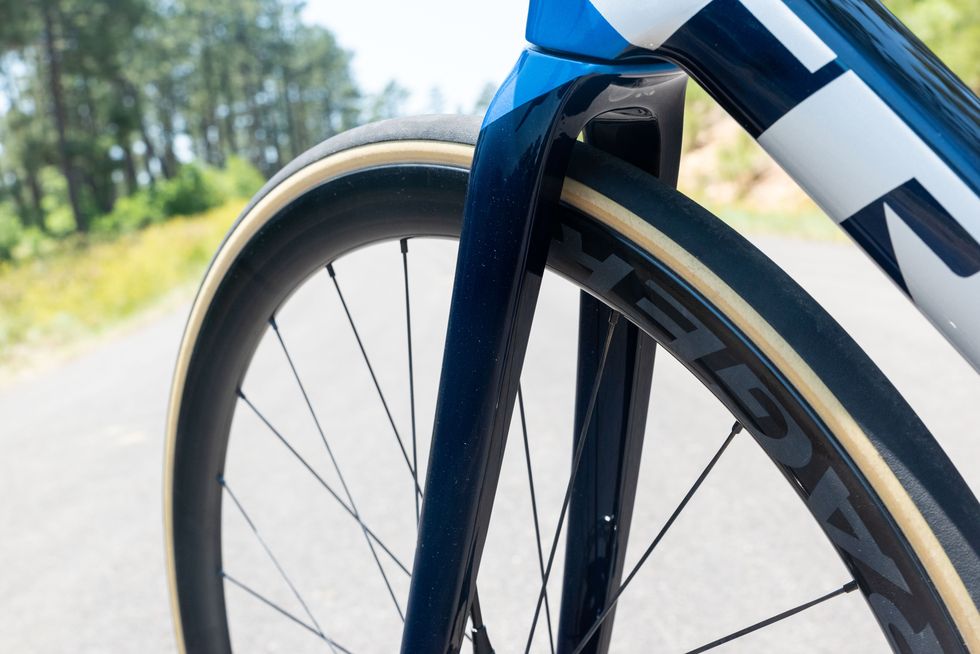
By optimizing the weight and aerodynamic balance around this climb, Roessingh claims the Émonda is faster on Alpe d’Huez and also faster on everything shallower than the famous climb, “which is the vast majority of the environments that most riders are going to ride in, including the team,” said Roessingh. “So if we can say it’s faster up Alpe d’Huez, it’s going to be significantly faster everywhere because the flatter it is, the more aerodynamics benefit you.”
Computer-Aided Optimization
Achieving the weight to the aerodynamic balance of the new Émonda required careful design of each tube shape. Aiding the Émonda’s team was supercomputing horsepower. The abridged and simplified version of the process goes like this: into the computer was fed a rough draft of the shape based on Trek’s aerodynamic experience and other information like UCI regulations. The program then varies the tube’s parameters within a predefined range and spit back several iterations of the shape, each with a different weight to aerodynamic balance. The Émonda’s team evaluated the alternatives and picked the one most suited to its location in the frame and best able to help the frame achieve its overarching goal.
Roessingh says that Trek cannot afford to buy the computing hardware necessary to run the CFD and FEA optimizations (in a timely manner) that helped shape the new Émonda’s tubes. The processing happens in the cloud where Trek rents time on Google, Microsoft, or Amazon’s supercomputers. It’s more affordable than buying a supercomputer. Even so, it is not cheap, “Cloud computing is becoming a relatively significant budget line item for us because we’re doing so many of these optimizations in CFD and FEA and all that processing happens in the cloud.”
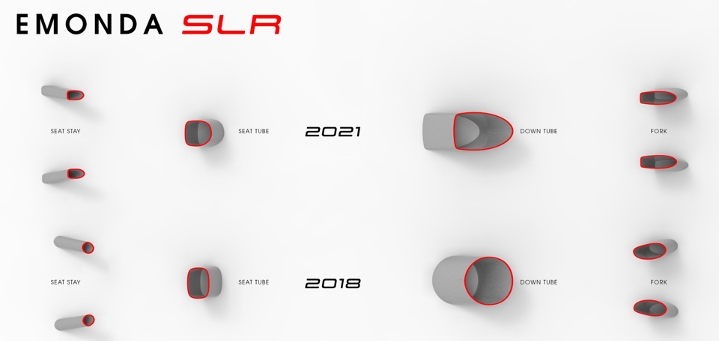
The new Émonda’s fork legs, head tube, down tube, seat tube, and seat stays all use a variation of a truncated airfoil. The top tube and chainstays, which have virtually no effect on drag, are optimized almost entirely for stiffness to weight.
In Trek’s line, the new Émonda’s aerodynamic performance is equal to the third generation Domane ; the Madone is still significantly more aero. But while the more aerodynamic Madone is faster in flatter terrain, once the climb hits about 5.5 percent, the lighter Émonda becomes the faster bike. And for many of the Trek-Segafredo team riders—and many amateurs—that means the Émonda is fastest when it matters most: the hardest part of a race or ride, which is almost always on a steep climb.
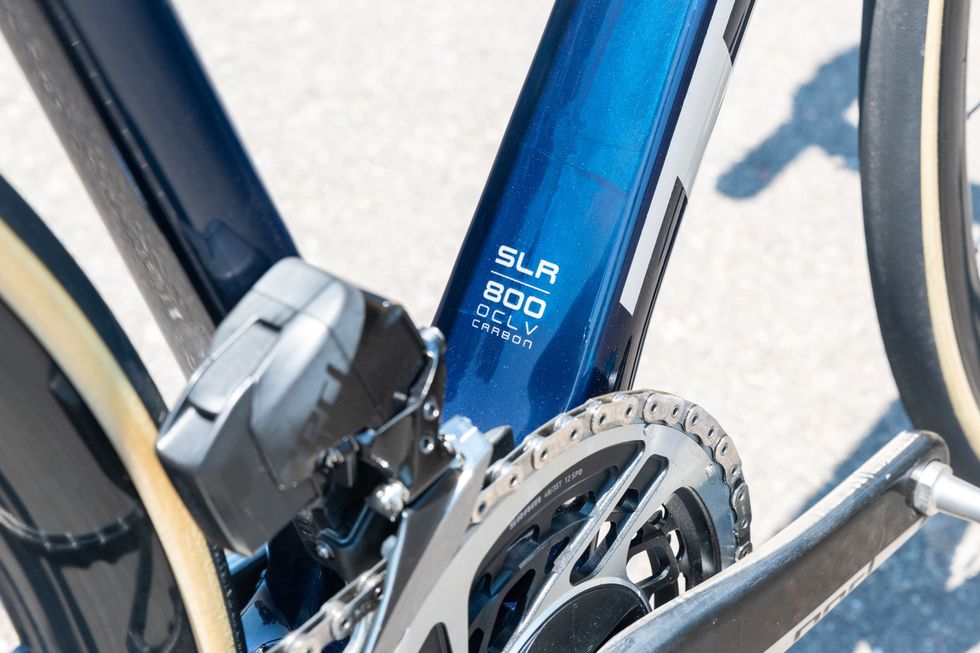
OCLV 800 Carbon
Getting the new Émonda SLR to be as light as it is while adding aerodynamic shaping would not be possible without employing a new carbon-fiber composite, said Roessingh. The new OCLV 800 composite is 30 percent stronger than Trek’s previous top-of-the-line composite (OCLV 700). Because it is stronger, they can use less: By using OCLV 800, Trek’s team was able to make the Émonda SLR frame 60 grams lighter than if they used OCLV 700.
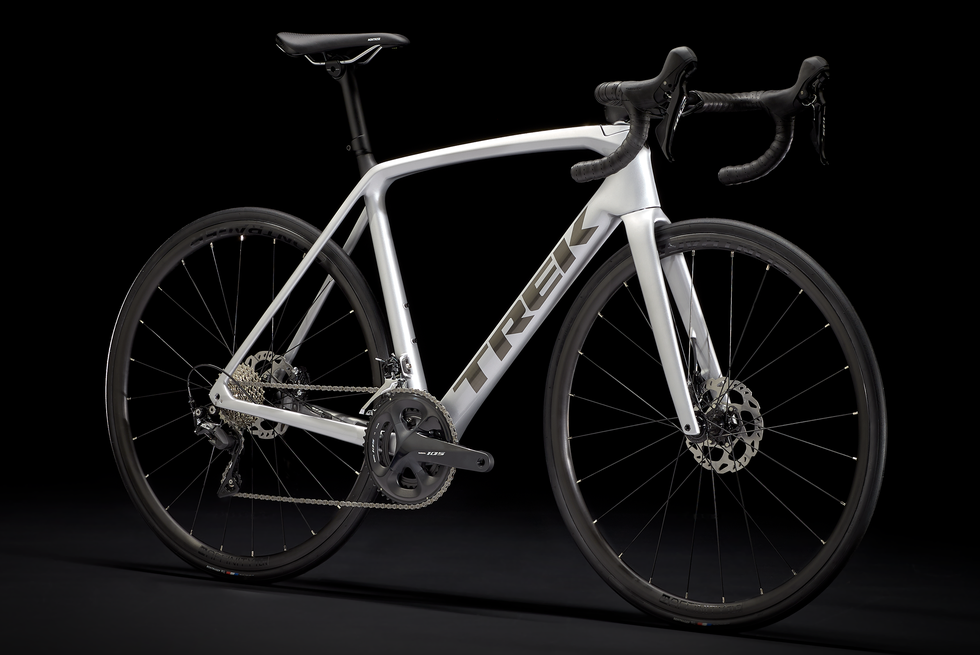
The Émonda SLR is very cool, but it’s also very expensive (bike prices start at $6,699). For the 99 percenters, there’s the Émonda SL (models start at $2,699).
The SL uses OCLV 500 composite, and the frame is quite a bit heavier than the SLR’s. The SL’s frame comes in at 1,142 grams, with a 380-gram fork (SLR fork weight: 365 grams).
But material (and weight) are the only difference between the SL and SLR.
Aeolus Bar Stem
While a ton of work made the Émonda’s frame tubes faster, a big chunk of the new bike’s drag savings comes from the one-piece Aeolus bar stem. It alone is responsible for 70 grams of the Émonda’s 183-gram drag reduction. This means that if a traditional stem and round bar are installed on the new Émonda, its drag advantage over the previous-generation bike drops to 113 grams. And it means that you can make any bike with a round bar and traditional stem significantly more aerodynamic by merely installing the Aeolus. Retail price is $650.
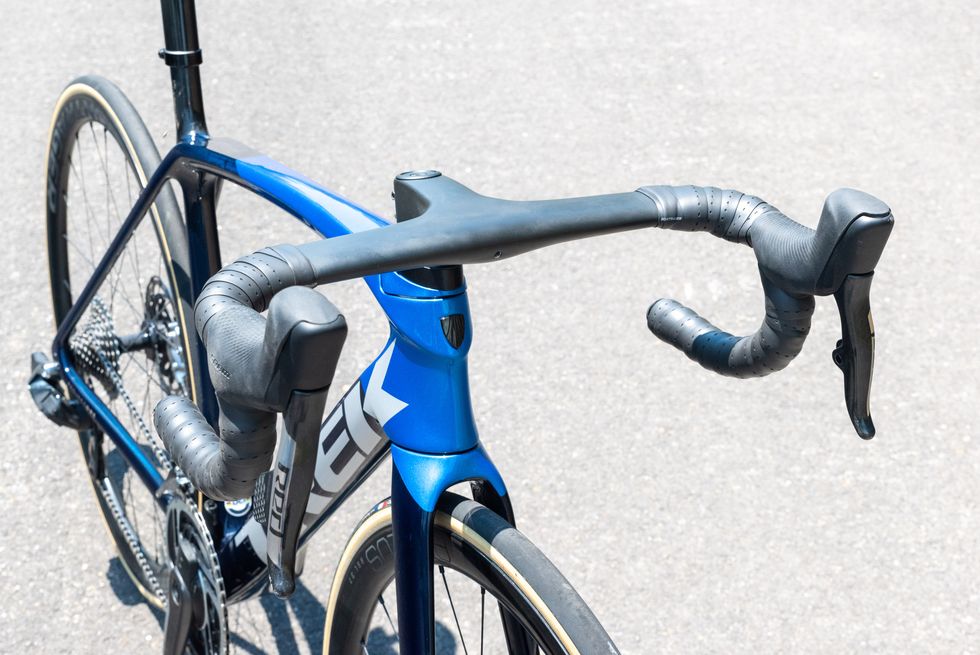
The integrated Aeolus is made of carbon-fiber composite, of course, with a claimed weight of 297 grams (42x120). It’s offered in 14 length and width combinations, from 44x120 to 38x80. Hoses, housing, and wires run externally for easier service and repairs, but in a groove that keeps them out of the wind. A bolt-on plate keeps the control lines tucked and organized where they turn off the bar tops to run in line with the stem.
The Aeolus employs a mount that works with Bontrager’s line of Blendr accessories for mounting computers and lights.
Aeolus 37 Wheels
Another new Bontrager product rolling out with the Émonda is the Aeolus 37 wheelset. It comes in two models: the Aeolus RSL 37 (1,325 grams/pair, $2,400) and the Aeolus Pro 37 (1,505 grams/pair, $1,300).
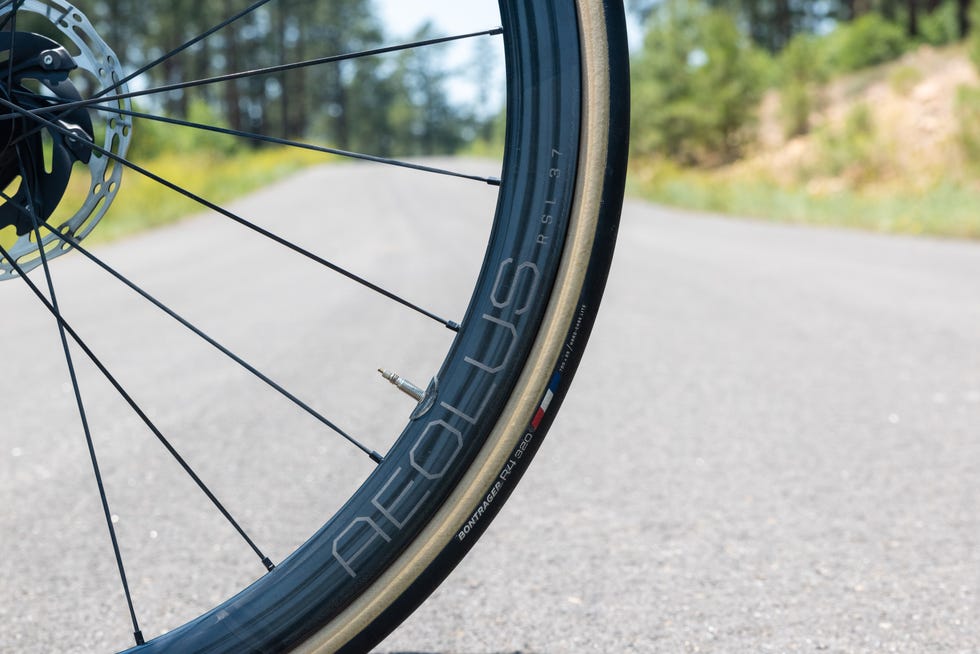
The RSL 37 is claimed to be lighter than Zipp’s 32mm-deep 202, yet more aerodynamic and more stable than Zipp’s 45mm-deep 303. Both wheels are disc brake only (only Center Lock interface), tubeless compatible, use DT-Swiss internals, have no rider weight limit, and come with a lifetime warranty.
Surprisingly Rider Friendly
Though the new Émonda is clean and integrated looking and uses high-performance standards, it is also remarkably rider-friendly. Cables, hoses, and housing run externally on the one-piece Aeolus bar/stem for easier repair and service (with one exception: wiring for a Shimano Di2 or Campagnolo EPS bar-end junction box runs partially inside the bar). If you prefer a more traditional cockpit, it can be run with a standard bar and stem with 1⅛-inch steerer clamp.
The bottom bracket uses the threaded T47 standard , which is compatible with almost all common crank-axle standards.
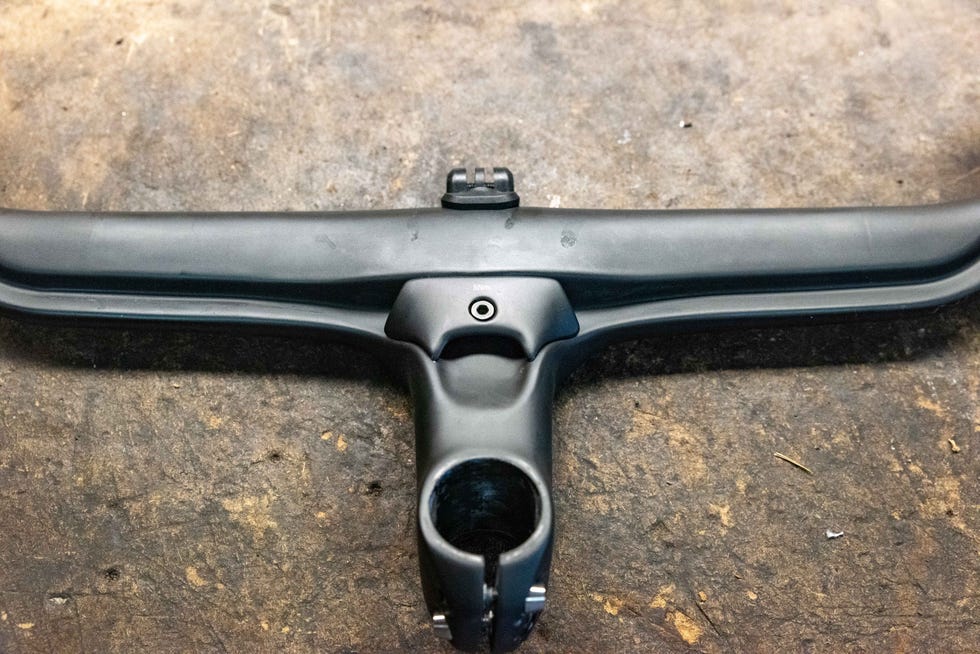
Front and rear thru-axles are standard 12x100 and 12x142mm, and the wheels employ a standard dish. The standard flat mounts for the brake calipers are compatible with 140, 160, or 180mm rotors.
Tire clearance is officially 28mm, but that’s with a ton of extra space. I fit 32mm tires in the Émonda with ease.
And though all models do use a seat mast, it’s a no-cut variety with lots of adjustment range.
H1.5 Geometry
Trek did offer its top-of-the-line race bikes in the aggressive H1 geometry for riders seeking an ultra-long and low geometry, or H2 which was an endurance fit. The new Émonda is offered only in H1.5, which splits the difference between H1 and H2. The result is pretty typical dimensions for a modern race bike—a 54cm Émonda H1’s geometry is remarkably similar to a 54cm Specialized Tarmac.
There are eight sizes starting at 47cm and topping out at 62cm.
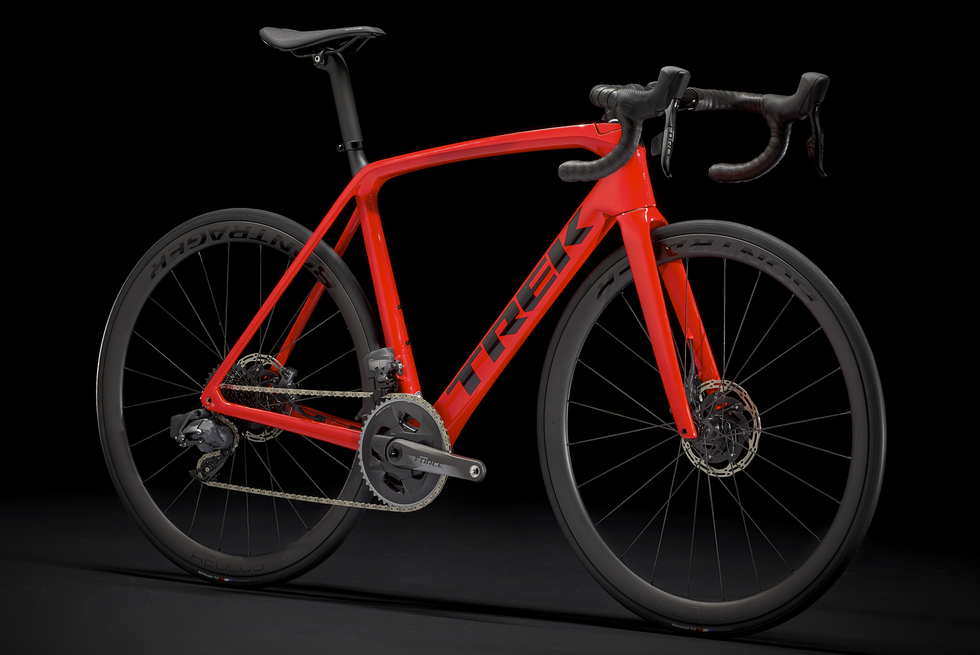
There are 10 models of the new Émonda. SL models start at $2,699 and are priced up to $5,999. SLR models start at $6,699 and go up to $11,999.
Only SLR models come with the Aeolus integrated bar/stem stock; and only the Émonda SL 7 ($5,499) and up come with the Aeolus 37 wheelset.
The new Émonda is a disc brake-only platform.
Project One
The new Émonda is in Trek’s Project One paint and parts personalization program. If that’s not luxe enough for you, Trek’s Project One Ultimate program allows you to work with a designer to come up with a one-of-a-kind finish, and Trek will source any parts you want for your new bike.

Trek Émonda SLR 9 eTap
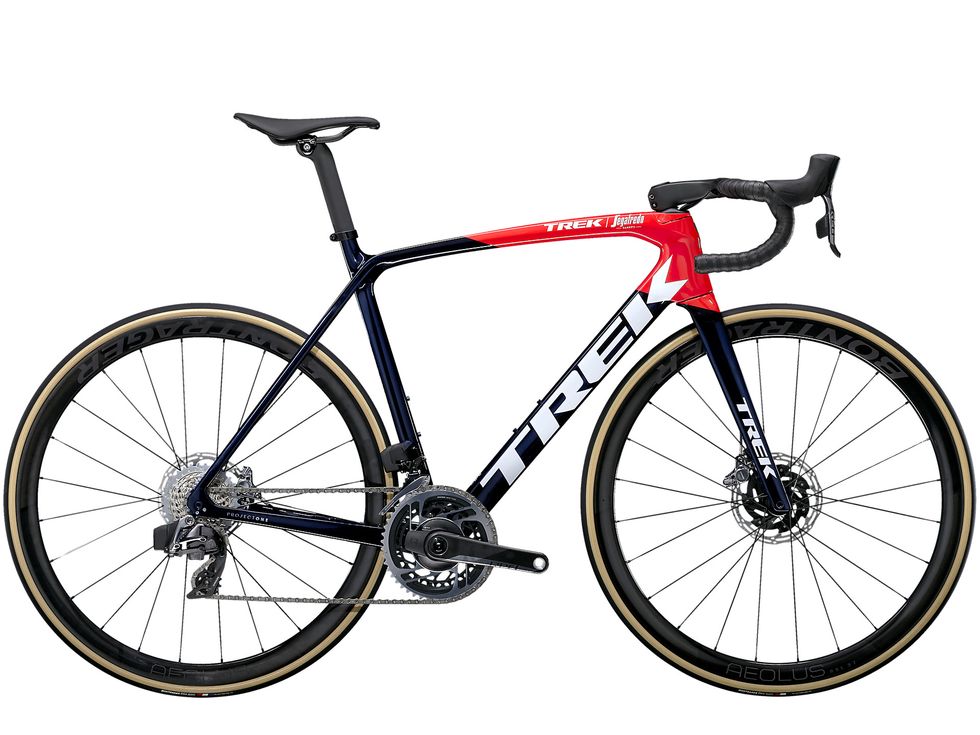
A gear editor for his entire career, Matt’s journey to becoming a leading cycling tech journalist started in 1995, and he’s been at it ever since; likely riding more cycling equipment than anyone on the planet along the way. Previous to his time with Bicycling , Matt worked in bike shops as a service manager, mechanic, and sales person. Based in Durango, Colorado, he enjoys riding and testing any and all kinds of bikes, so you’re just as likely to see him on a road bike dressed in Lycra at a Tuesday night worlds ride as you are to find him dressed in a full face helmet and pads riding a bike park on an enduro bike. He doesn’t race often, but he’s game for anything; having entered road races, criteriums, trials competitions, dual slalom, downhill races, enduros, stage races, short track, time trials, and gran fondos. Next up on his to-do list: a multi day bikepacking trip, and an e-bike race.
Bike Reviews

The 13 Best Road Bikes of 2024

Firefly’s Custom Gravel Bike is Cycling Artwork

The 14 Best Electric Bikes, Tested by Our Editors

Trek Checkpoint & Checkmate Gravel Bikes Reviewed

This Bike Made Me Laugh, Cry, and Puke—Buy It!

The Specialized Crux DSW Is Simple and Brilliant

Best Hybrid Bikes You Can Buy Right Now

The 10 Best Mountain Bikes You Can Buy Right Now

Giant TCR Advanced Improves on Its Legacy

Speed, Balance, Refinement: Trek's Gen 4 Top Fuel

Tested: Trek’s Eighth-Generation Madone

Specialized’s Stumpjumper 15 Changes Trail Bikes

Enjoy up to 15% off using these discount codes.
Trek Émonda Bikes Compared: Which One to Choose?
CyclistsHub is supported by its readers. We may receive a commission if you buy products using our links.
I’ll help you navigate the Trek Émonda aero road bikes in this article by comparing the Émonda SL 6 to SLR 9 .
You will also learn:
- Who are they best suited for?
- Why I think you shouldn’t buy Trek Émonda with SRAM groupset.
- And which model gives you the best value for your money?
KEY TAKEAWAY
Trek Émonda bikes are ideal for climbing and hilly terrain. They are the lightest bike family of all Trek road bikes . The models differ in components (e.g., electronic shifting) and frames. The more expensive ones are usually lighter and have a higher-grade carbon frame, but usually diminishing returns.
Let’s dive deeper to help make your decision easier.
This article compares Trek Émonda Gen 6 and 7. The main difference between Émonda Gen 6 and Gen 7 is that Gen 6 has IsoSpeed decoupler, while Gen 7 has IsoFlow.
Trek Émonda ALR 5 to SLR 9
The following table summarizes the main differences between all Émonda road bikes.
Émonda Pros & Cons Summary
I summarized the pros & cons of the Émonda series below.
Émonda Pros
- Lighter than Madone road bikes
- Aluminum and carbon models are available
- Relaxed geometry
- Availability in multiple sizes and colors
- Integrated cable routing
- Lifetime warranty
Émonda Cons
- Slower than Madone road bikes
- Narrow tire clearance (28mm)
Émonda Main Features
Let me now explain the most important features of the Trek Émonda aero bikes.
Frame and Geometry
The Émonda bikes are part of Trek’s road bike lineup . They’re made of aluminum or carbon .

The names of the bikes have abbreviations that refer to the type of material used for the frame:
- ALR are aluminum frame bikes.
- SL are bikes with 500 series OCLV* carbon (mid-range).
- SLR are bikes with 800 series OCLV carbon (high-end).
*OCLV carbon is Trek’s patented carbon fiber process ( learn more ).
ALR Émondas are great entry-level road bikes , thanks to their affordability. However, they are still a bit more expensive than less-known competitors.
SLs are the best mid-range option. They are slightly heavier than SLRs but about 25% cheaper.
And SLRs are ideal for people who have more money to spend and don’t want to compromise.
Most Émondas are available in 47-62 sizes and multiple colors, giving you a wide range of options.
Their geometry is more relaxed than on other racing bikes, so you won’t experience as much strain on your lower back and neck. The following picture shows the comparison with Specialized Tarmac SL 7.

Weight & Aerodynamics
Trek Émonda frame weighs 760g in size 56. The highest-end Émonda even weighs below the UCI 6.8 kg limit. However, low weight is not everything. Stiffness and aerodynamics are also important.
Trek claims Émonda frames are also relatively stiff and aero (of course, less aero than Madone). They are 18 seconds per hour faster at 8% gradients. ( Source ) However, more information on the methodology is not available.

Émondas are lightweight, thanks to the absence of an IsoSpeed decoupler that adds weight.
Wheels and Tires
Although the wheels on some Émonda models may be different, Émonda bikes typically come with Bontrager Aeolus Pro 37 wheels.
Of course, the low-end models have cheaper aluminum wheels . Fortunately, all Émondas come with tubeless-ready wheels. But remember, the tires are clinchers. So, if you want tubeless tires, you have to buy them separately.
One of the things that surprised me is that the lower-end Émondas have 28mm tires, while the higher-end only have 25mm. Most road bikes these days (except for some aero bikes) have 28mm or 30mm tires.
Unfortunately, Émondas only have tire clearance for 28mm tires.
Unsurprisingly, the Émonda bikes have a 2X drivetrain, as is customary for road bikes.
Trek fits them with Shimano and SRAM groupsets, and the number in the bike name indicates the groupset.
- Models ending with 5 use Shimano 105 (R7000) groupset.
- Models ending with 6 use Shimano Ultegra , 105 Di2 (R7100) or SRAM Rival AXS groupsets.
- Models ending with 7 use Shimano Ultegra Di2 (R8100) or SRAM Force AXS groupsets.
- Models ending with 9 use Shimano Dura-Ace Di2 (R9200) or SRAM Red AXS groupsets.

Interestingly, the Émondas with SRAM are heavier than the Émondas of the same series with the Shimano groupset. In addition, those with Shimano are also cheaper.
This is somewhat strange because Shimano retail prices are higher than SRAM’s. That’s why I recommend choosing Trek bikes with Shimano groupsets unless you prefer SRAM.
TIP : You might also be interested in this comparison of Shimano vs. SRAM .
So, which Trek Émonda bike is the best?
If you’re considering buying an Émonda, I suggest a model with a Shimano groupset. They are lighter and less expensive than the equivalent SRAM models.
For better value, consider the Émonda SL. It’s around 30% cheaper than the SLR but offers almost the same performance. From all models, I believe the Émonda SL 6 Pro with the Shimano 105 Di2 is the best deal.
However, if you don’t want to compromise, go for the SLR, which is more expensive but lighter.
Trek Émonda FAQ
Trek Émonda bikes are for pro cyclists, competitive roadies, and enthusiast cyclists who want a lightweight road bike. They are ideal for hilly, mountainous terrain and short, medium, and long-distance rides.
The main difference between Émonda and Madone is that Émonda is a lightweight road bike, while Émonda is an aero road bike. For more detailed info, please check out my comparison of Émonda vs. Madone .
The main difference between Émonda and Domane is that Émonda is a lightweight aero road bike. Domane is an endurance road bike with wider tire clearance, and it is also suitable for off-road adventures. Domane is somewhere between Émonda and Madone. Learn more in my Émonda vs. Domane comparison.
About The Author
Petr Minarik
Leave a comment cancel reply.
Your email address will not be published. Required fields are marked *
Save my name, email, and website in this browser for the next time I comment.
Start typing and press enter to search
Powered by Outside
2021 Trek Emonda SL Pro 6 road bike review: for the climb lovers
The first review from our 2021 road bike field test. we review and compare the mid-priced version of trek's newly overhauled emonda race bike..
- Share on Facebook
- Share on Reddit
Don't miss a moment of the 2024 Tour de France! Get recaps, insights, and exclusive takes with Velo's daily newsletter. >","name":"in-content-cta","type":"link"}}'>Sign up today! .
When it was first released, the Emonda was a climber’s dream that Trek claimed as the world’s lightest production offering. Dealer events would have the ultra-premium 4.6 kg (10.25 lb) SLR 10 hanging from large helium balloons, and the American company made a big deal of it providing a benchmark stiffness-to-weight ratio.
In many ways the Emonda back-filled the void left by the once round-tubed and low-weight Madone that was then becoming more aero. And as the Madone further trended to becoming Trek’s full aero racer (with an obvious element of comfort, too), the Emonda kept to its round tubes and stiff hill-attacking personality.
That changed for 2021 with Trek overhauling the Emonda in a similar way to how almost every other brand has overhauled its lightweight race machine. The Emonda, now disc-only, gained a little weight by moving to slippery truncated airfoil tubes and a wholly new approach to cable routing in an effort to make it sleeker all-around. Additionally it should run quieter with a new threaded bottom bracket format, too.
All of those techy details (and more) were covered in James Huang’s review of the top-tier Emonda SLR . And while James went pretty deep with that review, he left a few unanswered questions in relation to the more affordable 2021 Emonda SL. And so it’s exactly this more-affordable, second-tier version – specifically the Shimano Ultegra-equipped Emonda SL 6 Pro – that we took to our Field Test in Victoria’s High Country .
Emonda SLR vs Emonda SL
Story highlights.
What: A second-tier version of Trek’s all-round lightweight race bike. ||Key updates: Aero frame design, a more performance-oriented geometry, sleek semi-concealed cable routing, T47 threaded bottom bracket||Weight: 8.01 kg for the Emonda SL 6 Pro as tested (54 cm, without pedals), claimed frame weight is 1,142 g (56 cm). ||Price: US$3,800 / AU$5,500 / £3,350 / €3,880-4,000||Highs: Obviously a race bike with geometry to match, agile handling, high-end looks, more tyre clearance than claimed, threaded bottom bracket, Shimano Ultegra is hard to fault, great saddle. ||Lows: Stiff ride quality, weight penalty in frame versus premium option, heavy carbon wheels, bend of handlebar is too tight.
There’s no denying that the Emonda SL (starting from US$2,700 / AU$4,000 / £2,275 / €2,580-2,600) is substantially cheaper than the pro-level SLR (starting from US$6,700 / AU$9,300 / £5,450 / €6,200), but what are you giving up in the process? Simply, it’s a matter of weight.
An unpainted 56 cm Emonda SLR frame has a claimed weight of 698 g, while the matching fork adds 365 g. By comparison, the Emonda SL frame sits at 1,142 g, with the fork at 380 g. This 450-gram difference is simply attributed to the carbon composite layup used (in Trek marketing speak, that’s OCLV 800 vs OCLV 500), and simply less material is needed when the more expensive fibres and resins are stiffer and stronger.
That 1,142 g figure for the Emonda SL isn’t terribly heavy, but it is noticeably plumper than many other second-tier racing frames on the market. For example, the new Giant TCR Advanced frame offers a claimed weight of just 850 g, while Canyon’s comparable Ultimate CF SL frame has a figure of 980 g. And the Emonda SL’s higher frame weight is of course reflected in the complete bike weight, too, with our 54 cm SL 6 Pro tester tipping the scales at 8.01 kg (without pedals).
Beyond the weight, the Emonda SL and SLR framesets are remarkably similar. They share the same moulds, and therefore the geometry and aero tube profiles are identical. Trek claims the stiffness profiles, and therefore ride quality is effectively equal. The way the cables are funnelled through the front of the head tube is the same, the new threaded T47 bottom bracket is mirrored, and likewise for the use of Trek’s reverser topper seatpost design. And heck, even the paint of our SL 6 Pro was an almost exact match to the SLR 9 that James tested.

Beyond the frame there are some more apparent differences. The SLR models feature a wonderfully light Bontrager one-piece carbon handlebar and stem, while the SL models use a more traditional bar and stem setup. And it’s a similar story for the other components which are lighter (and more expensive) on the SLR models.
A race-ready geo and ride
The Emonda of old had two geometry options. There was the low and aggressive “H1” pro fit (offered in the SLR level only), and then the more mainstream “H2” with its more accessible and upright stack figure. For 2021 Trek combined those two fits into one with “H1.5” being used across all Emonda models.

That means the new Emonda SL is more aggressive than the last, and relatively speaking the reach figures are on the long side and the stack figures are fairly low. For example, our 54 cm tester offers reach and stack figures of 386 mm and 541 mm respectively, right in the realm of where many race-focused machines sit.
The handling is equally as sporty, with a traditional 73º head angle and 45 mm fork offset combining for a 58 mm trail figure with the control 28 mm Continental GP500 tyres fitted (25 mm Bontrager tyres are fitted as stock). And the wheelbase is kept fairly tight, too.
Trek balances that longer reach by fitting a shorter-than-usual stem (90 mm on the 54 cm), and as a result the bike fits a little more upright than the figures may suggest. At the same time, that shorter stem produces a bike that handles even quicker and with less input than other race bikes with comparable trail figures.
And it’s this quick-feeling attitude that will reward a rider with good handling skills. The Emonda can dive into turns and jump back out of them with little input. And it does that without an inkling of instability at speed.

Further rewarding a good handler is the stiff frame that pounces when called on and lets you feel what the tyres are doing through your hands and bum. No doubt, this was the firmest-riding bike we had at our small Field Test, and despite the wider 28 mm tyres, I could still feel the cracks and inconsistencies in the road surface. Thankfully that stiffness manages to find the right side of the line between a bike that speaks to you and one that skips about.
Both Andy van Bergen and I agreed the Emonda was the most impressive under power when directly compared to the Giant TCR Advanced Pro and Canyon Ultimate CF SL , and similarly it beats the Specialized Tarmac SL6s that we both have sitting at our respective homes. I’d most liken the ride to BMC’s recently updated and stiffened Teammachine SLR01 .

That stiffness is great for riders who like out-of-the-saddle attacks and to feel their energy reach the rear wheel, but it’s less ideal for those seeking a smooth and compliant machine. And while many other brands utilise flexible seatposts to achieve more comfort through the saddle, Trek’s own reverse topper seatpost design just rides stiffer than the company claims and there are no options to change it for something more flexible – a somewhat surprising element given the company has gone to great lengths with its IsoSpeed technology to produce seated flex in its aero race and endurance platforms.
Instead your best bet to add comfort to the Emonda is through the tyres. Trek officially states the Emonda can fit up to a 28 mm tyre, however that figure is extremely conservative. I trialled some 32 mm GP5000s (measured 32 mm width) in the frame without any sign of issue.

Compared to the previous version, living with the new Emonda frameset has some wins and losses. The new internal cable routing sees the brake hoses and shift cables enter through a funnel at the proprietary headset top cap, and then squeeze between the squared-off fork steerer and top headset bearing. It looks wonderfully clean, but as James previously covered, it does introduce some servicing difficulty, and that’s especially true for this model that uses mechanical shift cables.
Perhaps offsetting that servicing pain is the new T47 threaded bottom bracket , something that’s more universally compatible with oversized crankset spindles and surely simpler to service than Trek’s previous BB90 design that saw bearings pressed directly into the carbon frame. And while that new bottom bracket (made by Praxis) does require a unique tool, servicing it is vastly more accessible than with the former press-fit design.

I won’t get into the nitty-gritty of the aerodynamic design – we’ve done that – but I will say that the lines of this bike are quite stunning. The aero head tube is just so distinct, the wide and concave top tube offers a wonderfully interesting curvature, and similar can be said for where the long and flowing seat stays connect.
The paint is also well done and makes this look far more expensive than it is. And as an added bonus there’s a second choice of colours, too (dark grey with chrome lettering). Although, perhaps Trek could have been a little more subtle with its logo, rather than turning the down tube into a rolling billboard.
Carbon wheels aren’t always light
The tested Emonda SL 6 Pro sits smack bang in the middle of the Emonda’s range and features a full Shimano Ultegra R8020 mechanical groupset matched with a smorgasbord of Bontrager components (Trek’s own component and accessory brand).
Below the SL 6 Pro (US$3,800 / AU$5,500 / £3,350) is the SL 6 (US$3,300 / AU$n/a / £2,900). The two bikes are effectively the same with the exception of the rolling stock. The cheaper SL 6 features Bontrager’s aluminium Paradigm Disc wheelset shod with the company’s R2 Hard-Case Lite tyres in a 28 mm size, whereas the tested Pro version moves to the carbon-rimmed Aeolus Elite 35 Disc wheels wrapped in a 25 mm version of the same tyre model.
Adding US$500 to the bike’s price, those carbon rims offer a relatively shallow 35 mm aero-profiled rim that handles remarkably well without any sign of the flutter often present with deeper wheels in crosswinds. They offer a fairly modern profile, with an inner width of 19.2 mm and an outer width at 27.7 mm. However, the material is somewhat misleading and these wheels aren’t as light as you may expect. I weighed my sample set at 1,740 g for the pair (770 g front, 970 g rear).

That weight doesn’t sound like much, but it impacted how the bike felt when attacking steep slopes, with Andy remarking that it made the bike feel sluggish to respond. Carbon isn’t always an upgrade.
Another area that left Andy and I underwhelmed was the Bontrager Elite VR-C handlebar. We just didn’t get along with the ultra compact shape of the drops which left me complaining of wrist clearance issues, while Andy found that he was unable to make comfortable use of the drops due to his hand sitting proud within the tight radius. We both agreed that the handlebar would be the first thing we’d change.
Thankfully that’s the extent of our issues, and the rest of the build kit is hard to fault. Bontrager’s basic alloy stem works with its Blendr series of computer and light attachments (some of which are supplied), while the new Bontrager Aeolus Comp saddle features a modern short-nose design with a generous centre channel. And all the smaller details, including the proprietary headset top cap and seat post topper, add to a premium look and feel.

And finally there’s the Shimano Ultegra groupset. One thing James wasn’t able to test in his review of the SLR 9 was how the internal cable routing impacted mechanical shifting quality. I can confirm that it doesn’t. The shifts were just as snappy and consistent on this bike as they were on other bikes, and they should remain that way for a fair while with full-length housing used from shifter to derailleur. And that full-length housing should ease future repairs, although it does add to the bike’s total weight.
Champagne tastes on a (craft) beer budget
Despite the lower price, Trek has done a solid job of bringing the Emonda SLR’s attributes to the SL. It offers the same handling, stiffness and aesthetic of its pro-level sibling, and that makes for an impressively enjoyable bike to ride.
However where the more expensive Emonda jumps with joy at every thought of an attack, the extra mass of the SL sees it hesistate somewhat. That difference may not be reflected on the clock, but it sure can be felt and it’s a constant reminder of the price tag attached to this ride.
The new Emonda SL will be a good fit for the rider wanting a well-rounded race bike that handles and behaves like a WorldTour machine. However it’s best to avoid this one if you’re seeking an opulent ride quality or the lightest bike for the given sticker price.
trekbikes.com
Photo gallery

Popular on Velo

- Forum Listing
- Marketplace
- Advanced Search
- Manufacturer Forums
Trek Emonda 2021 - ALR or SL
- Add to quote
Hi There From Switzerland and looking to change my 5 years old Canyon Endurace AL 6.0, the Trek Emonda seems to me to hit the right spot. The budget is what it is and the max I could afford is the SL 5. Maybe the SL 6 but the I don’t really see the benefit of the Ultegra groupset over 105. Another solution is to buy the ALR 5 or 6 and add a good set of wheels, like the Zipp 303s or DT Swiss ARC 1100. The open point for me is to understand if the carbon frame is really better than the aluminium one? And if yes, how and why? Cheers folks Sam
For road/gravel, I ride 3 main bikes. 2 are aluminum and 1 is carbon. I think they are all great bikes, personally don't feel much ride difference between them if at all. On a good day I can set a PR on my aluminum road bike even though it's alloy and 8 years older than my carbon bike. But in your case... I believe the Emonda is supposed to be a first-rate climbing bike which should be light... so almost certainly the carbon one fits that bill better. Yeah, the components and wheels offset that... but your next upgrade down the line could be wheels. There are always good deals to be found.
Thanks for your answer [emoji120] As you, i dont care about the frame material. The ride characteristics, the ride feeling I should say as the weight, is more important to me. The aluminium frame is lighter than the carbon OCLV 500 one ... if it’s more aerodynamic (but at my speed and I’m not riding at 40 km/h) or more comfortable, then I’ll take it. I’m riding mostly on ondulated, wavy roads and sometimes goes for a big alpine ride. And I want just a bike to ride everywhere, anytime.
It will be an Emonda SL 5. Wheel upgrade in a few months, when the temperature will rise a bit. Should be here for the week-end.
Interesting choice. I’d be interested to know the weight out of the box - you know, before pedals and accessories, but including saddle and bars.
Good choice. Most of the pro riders on the Trek teams (men and women) use the Emonda, which is Trek’s lightest bike. Those riders have a choice of the Madone (go fast aero), Domane (all-rounder, Spring classics) and Emonda (tour, climber). Enjoy! Sent from my iPhone using Tapatalk
It’s a size 54 and it weights 8.7 kg. I will change the tires for tubeless ready and mount it without tubes for sure in the next weeks. As it is now, and due to a miserable weather here in Switzerland (I rode 30 km yesterday with a medium temperature of zero celsius), it has only seen 130 km in total.
SamCH said: It’s a size 54 and it weights 8.7 kg. Click to expand...
Great choice. I guess... as I had been looking at Emonda Al as a winter / travel bike too. I decided to dedicate my BMC Road Machine Two for the winter. It’s carbon and I mounted mud ( crud ) guards. I look at it like this. .. if i’m going to have the discipline to consistently ride the road in cold of winter; I want the best ride I can get . A harsh aluminum road frame does not meet that criteria. I also want a decent group, 105 and a comfortable carbon frame. Let’s see your new bike 🚲 if you get the right pic . What Winter Road shoes are you wearing? Hint: Tubeless flats in the winter are a no fix on the road side. Better think tube.
rudge66 said: I look at it like this. .. if i’m going to have the discipline to consistently ride the road in cold of winter; I want the best ride I can get . A harsh aluminum road frame does not meet that criteria. I also want a decent group, 105 and a comfortable carbon frame. Click to expand...
You should really be happy with your SL5. I got the blue version back in June with the intent of upgrading wheels, handlebar and components as they become available. So far I've only been able to upgrade the wheels to full carbon and the seatpost to carbon. The aluminum wheels that come stock are fine, but on the heavy side. The 105 groupset works just fine, but is not as refined as Ultegra, mind you I was coming from an older Dura Ace 9000 groupset on an aluminum framed bike. I think it is definitely a bike you can grow with (as in upgrading as your budget allows). I wanted a bike with disc brakes and I'm not disappointed. Hope you don't have to wait long for it, if you haven't already gotten the bike.
hunstamash said: You should really be happy with your SL5. I got the blue version back in June with the intent of upgrading wheels, handlebar and components as they become available. So far I've only been able to upgrade the wheels to full carbon and the seatpost to carbon. The aluminum wheels that come stock are fine, but on the heavy side. The 105 groupset works just fine, but is not as refined as Ultegra, mind you I was coming from an older Dura Ace 9000 groupset on an aluminum framed bike. I think it is definitely a bike you can grow with (as in upgrading as your budget allows). I wanted a bike with disc brakes and I'm not disappointed. Hope you don't have to wait long for it, if you haven't already gotten the bike. Click to expand...
Back after almost 300km ridden. And I will buy new wheels ASAP. I’m not convinced yet I need mid-height aero wheels such as Zipp 303 S. I will maybe go for a nice light pair of aluminium wheels (yes it’s also a matter of budget). For example DT Swiss PR 1400 db. I asked a few people if mid-height aero wheels are worth the price and the weight penalty if I’m not riding faster than a 30 km/h average. Until now, no definitive answer to this question.
Lookin at gettin a Sl-5 or 6, any updates on weight(wheels) & any other things about the bike, all the dealers here are tellin me to pay in full & wait till poss. november - december for delivery which is crazy to tie up that much & possibly run into problem gettin a refund for whatever reason,thanx
- ?
- 206.4K members
Top Contributors this Month

Test: Trek Emonda SLR Disc 2018 – is lighter really better?

6.7 kg for a production disc brake bike? Over at their HQ in Wisconsin, Trek introduced us to the new Émonda with the tagline of ‘Making the lightest lighter.’ Despite bearing many of the same visual traits as its predecessor, Trek claim this is basically a brand new bike. On the rolling hills of the Mid-West, we got to ride this record-breakingly light Project One disc brake race bike to find out if lighter really is better.
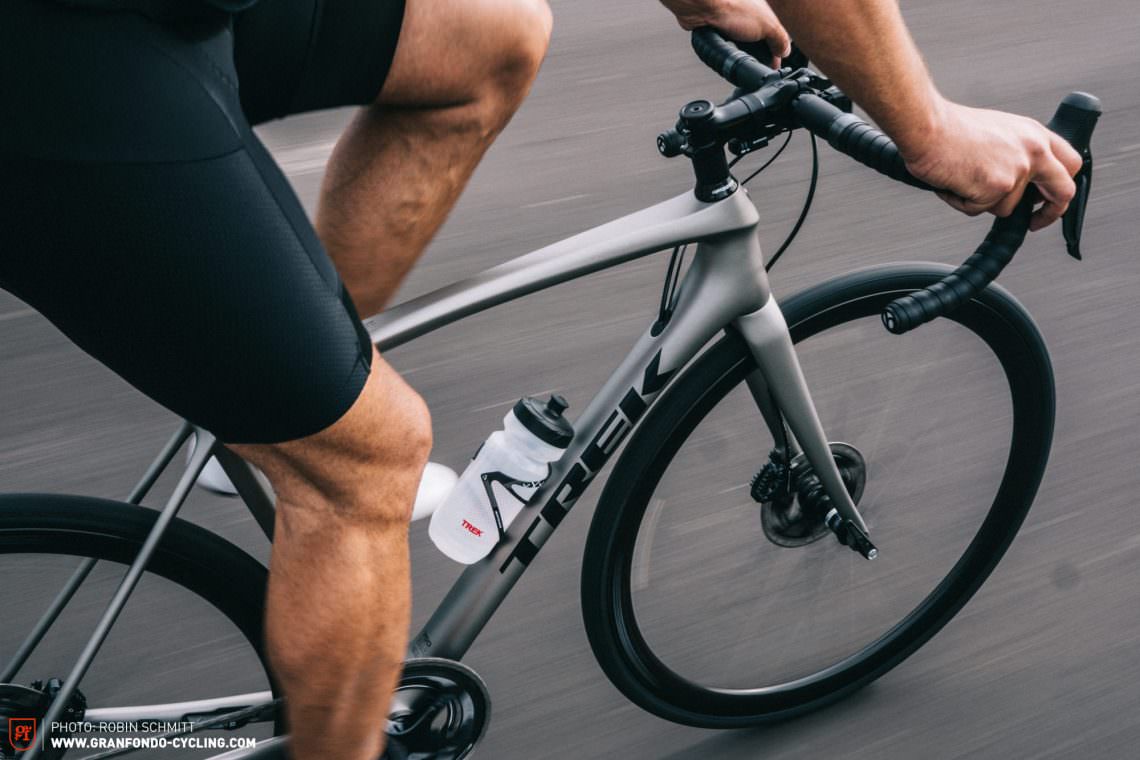
Trek Émonda – Digital Prototyping
Lighter, stiffer, more comfortable: Trek headed into the complex world of digital simulations in a bid to pin down these goals. Their data-driven options that showed the most promise were rendered into prototypes, before undergoing lab testing and real-world riding. During our visit to the brand’s HQ in Waterloo, we got an exclusive glimpse into their intricate R&D, prototyping, lab and production facilities. The most striking outcome of their research is that the frame is now 5% lighter than its former iteration. We learned that the frame – and tube profile – wouldn’t have come to being without digital prototyping, which is a marked step forwards for the cycling industry.

Trek Émonda SLR 2018: weight and key features
As Trek don’t dispute the advantages of both disc brakes and rim brakes, the Émonda 2018 is going to be launched in both versions. Minus hardware, the new Émonda SLR 2018 weighs in at 640 g for the frame in a size 56 with the H1 geometry. (That’s basically the pro geometry model with a lower front end than the H2). The disc brake-equipped frame is 665 g, and the former model was 690 g. The Émonda SLR fork weighs 313 g, while the disc brake one is 350 g. The newest iteration also offers more tire clearance, allowing the bike to be ridden with tires up to 28 mm, in fact we tested the bike in this setup.
But it doesn’t end here: the new Trek Émonda SLR is kitted with many of Trek’s tried-and-tested features like the Ride Tuned seat mast, an E2 Tapered steerer, integrated DuoTrap S speed and cadence sensors – alongside the ultimate decision regarding the more aggressive H1 or comfort-focused H2 geometry.
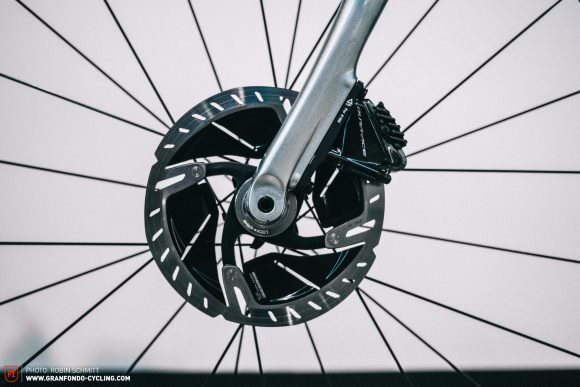
Trek Émonda 2018: Models, prices
The Émonda line-up can be split into three: the Trek Émonda SLR, SL and ALR. The SLR is the flagship build with a brand new frame designed out of 700 OCLV carbon. The SL model is based on the current Emonda SLR, but has adopted a more affordable carbon lay-up. The rim brake frame model weighs in at 1091 g while the disc model is 1149 g. The ALR is clearly the aluminium model. Then there’s the SLR RSL, with RSL representing Race Shop Limited, which is the preserve of Trek’s H1 geometry Project One bike. In other words: a bike fit for the pros!
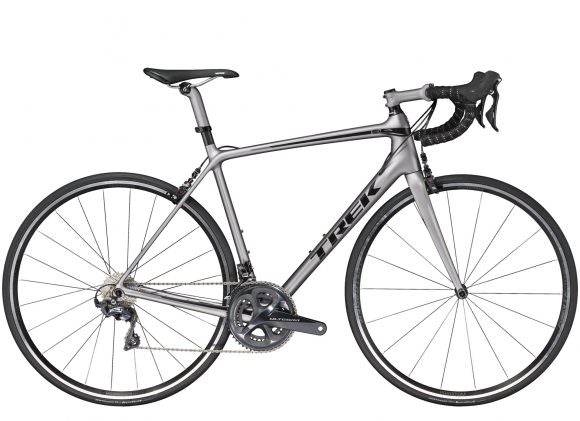
Trek Émonda 2018: The geometry
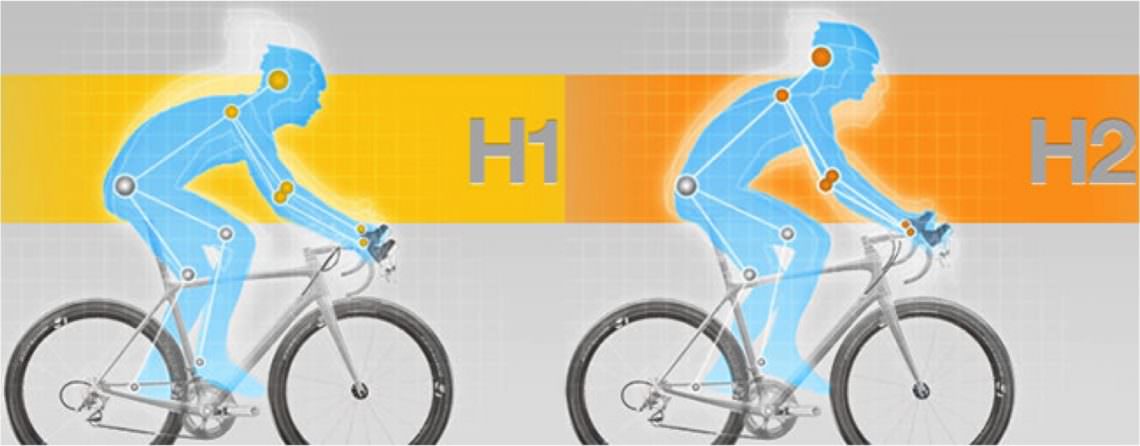
Trek Émonda H1 Fit
Trek émonda h2 fit, trek precision fit.
Before we got the green light to ride our test models we were ushered into the fitting lab, where our shoe soles, riding position and general bike set-up were personally tuned.

Trek rely on the German biomechanics experts Gebiomized to ensure their Precision Fit is bang on. Wise choice; we often turn to the expertise of Gebiomized for our group tests too.
Trek’s Precision Fit approach goes for analysis through filming and pressure point sensors, which revealed excessive pressure on the saddle and a hunched upper body in our case. Raising the saddle by 3 mm led to an immediate drop in the pressure on the saddle, plus the bars were dropped slightly by removing a spacer to reduce the stress on the arms. The effect was a bit of a ‘wow’ moment!
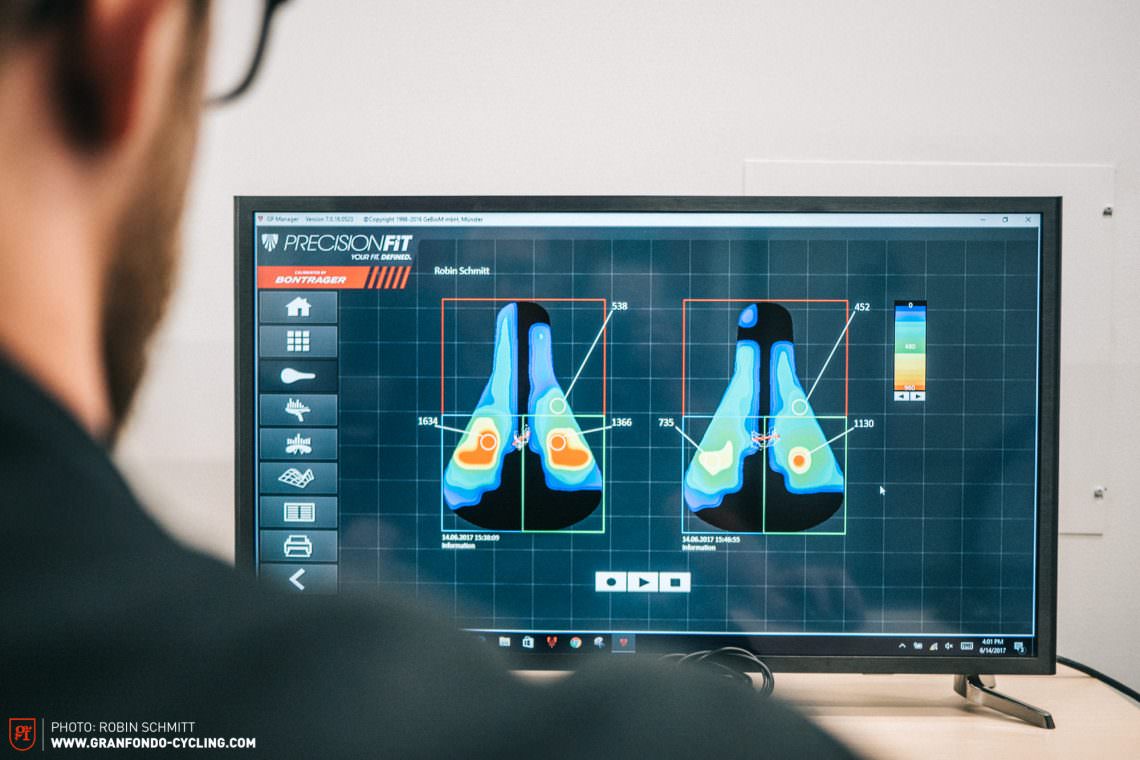
These minor tweaks impressed us with their pretty major effects on how we ride, which is yet more proof that a good bike fitting is worth more than expensive aero wheels!
First ride: Trek Émonda SLR Disc 2018
The first few pedal strokes showed us that this 6.7 kg lightweight disc brake race bike is responsive and able to accelerate like a dream. We were riding the Trek Émonda SLR Disc in a size 56 with their more aggressive H1 geometry setup, which has a lower steerer tube, giving a less upright position on the bike.

The words ‘aggressive’ and ‘responsive’ are pretty apt here, as the bike demonstrated serious agility – so much so in fact that we reckon it was just too nervous. On the climbs and the descents, the front end doesn’t track very confidently, meaning it’s hard to settle it into a continuous rhythm and it lacks stability on the downhills. This could be appealing to certain racers, but we felt it was a little too extreme and we yearned for the H2 geometry version!

You might notice that our test bike was kitted with Bontrager Flare R daytime riding lights, which is testament to Trek’s focus on safety and visibility. However, this struck us as somewhat of a juxtaposition to this bike, as the relatively nervous handling does ask for more concentration at all times and requires an experienced hand to maneuver. Perhaps that’s where the H2 geometry suits less-experienced riders more. Fortunately, the Shimano disc brakes allow you to put the anchors on with great modulation and power.
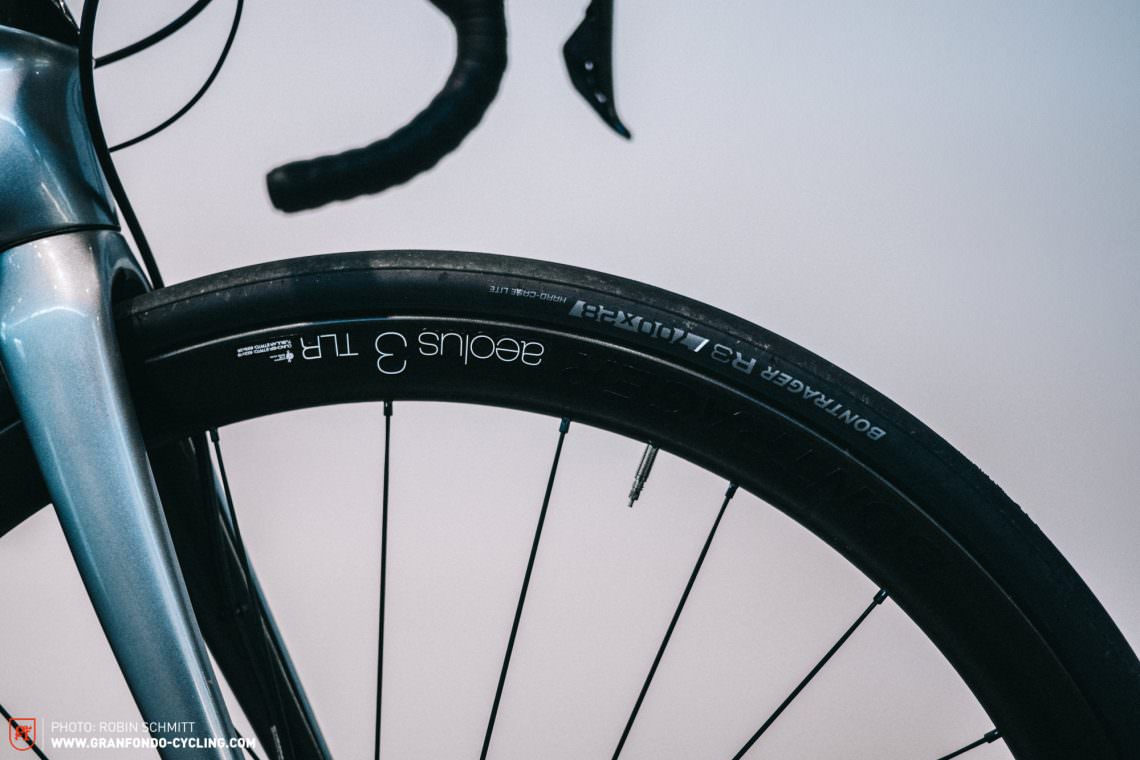
It might sound odd but we were in awe of this ultra-light race bike’s comfort on gravel sections. Trek even go so far as to describe the Émonda as a bit of an all-rounder and we’d be keen to agree (if you overlook that twitchy handling!). Its all-round credentials are certainly aided by those great 28 mm Bontrager R3 tires fitted to Bontrager Aeolus Pro 3 TLR wheels with a bang-up-to-date inner rim width of 19.5 mm.
Trek Émonda 2018 – so how aero is the bike
Everyone knows that we’re not aero obsessives. Seriously, we’re turned off by aero helmets and don’t pay any attention to milliseconds. However, we’re aware that aerodynamics make a difference when you’re hunting seconds. When Trek were questioned about the aerodynamic performance of the Émonda, their response was that they’d focused on weight rather than aero gains, choosing not to carry out any wind tunnel testing. We were momentarily stunned to hear that this was a race bike without any specific aerodynamic design!

In today’s very competitive field of bikes, you can’t ignore aerodynamics anymore. If you want to excel in a category of bikes, you have to look at the whole bike and beyond convention: whether a bike is statistically the lightest or most aerodynamic, you won’t be quick unless the fit is right – or vice versa. For pros focused on the mountain classification, it’s enough that a bike climbs well so they’re potentially more willing to compromise on its handling! However, for regular riders, we believe they demand a balance between performance and stability – one that’s just as good as coming down as it is as going up.
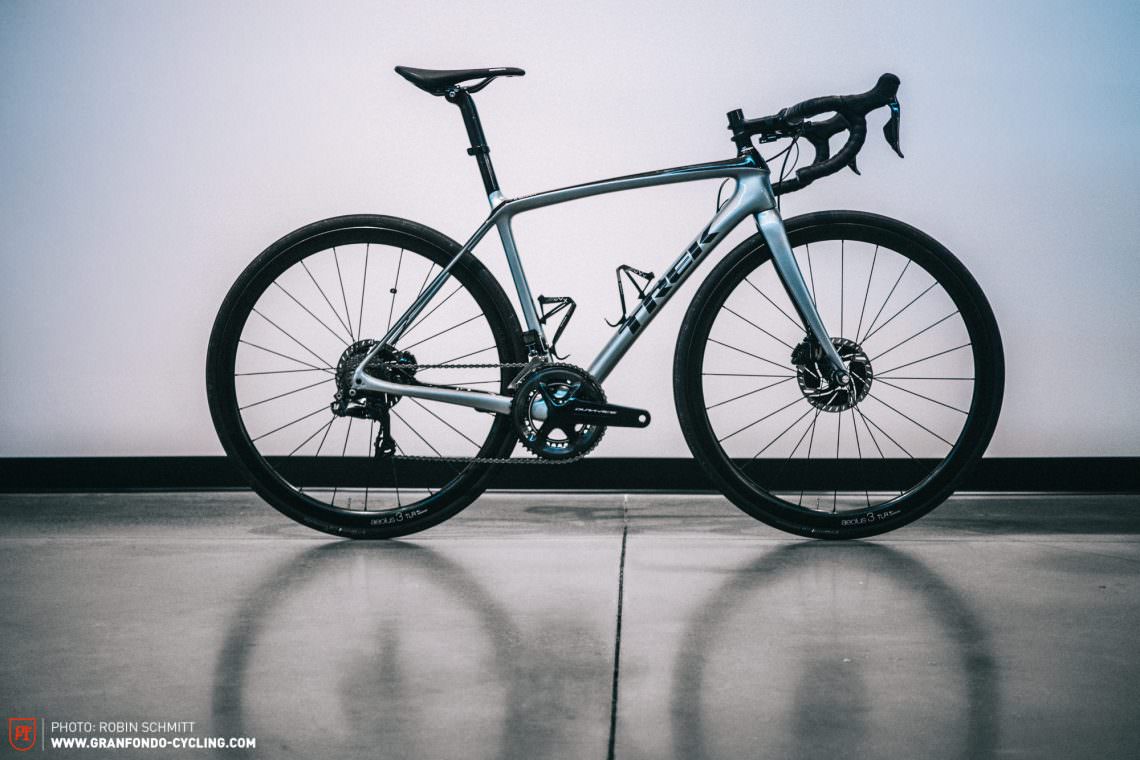
Our thoughts
The new Trek Émonda SLR 2018 has pushed boundaries for production disc brake bikes and at 6.7 kg even sits under the UCI weight limit. In Alberto Contador’s words: Querer es poder, which translates to ‘Where there’s a will there’s a way.’ The new Émonda with its record-breaking weight is a veritable milestone in terms of the pro tour acceptance of disc brakes. However, it could only partially convince us of its performance and we think it’s one that’s best left for the elites. Based on the sheer numbers of crashes for over-ambitious gran fondo riders, there’s a real need for bikes that are more stable and less skittish than those ridden by the pros. Put simply: we don’t all have Contador’s skills. Discs help here, but geometry and balance are also vital elements (much more than weight!). We doth our hat to Trek’s impressive engineering but we see the Émonda’s concept as not contemporary anymore, overly focussed on weight and stiffness. For the mass market a confidence-inspiring and more stable bike is essential.
For more info head to: trekbikes.com
Did you enjoy this article? If so, we would be stoked if you decide to support us with a monthly contribution. By becoming a supporter of GRAN FONDO, you will help secure a sustainable future for high-quality cycling journalism. Click here to learn more .
Words & Photos: Robin Schmitt
You may also like

The big 2024 aero wheel group test – 11 high-performance carbon wheels head to head

Vision Metron 60 SL Disc on test

Bontrager Aeolus RSL 51 TLR on test

Reserve 52|63 on test

CADEX 50 Ultra on test

Roval Rapide CLX II on test
Trek Emonda SLR 9 eTap Long-Term Review: Light for Climbing, Slippery for Speed
Share this:.
- Click to share on Facebook (Opens in new window)
- Click to email a link to a friend (Opens in new window)

Trek has touted the Emonda as its climbing bike since introducing it in 2014. But the 2021 revision threw aerodynamics into the light-is-right alchemy, producing a road race bike that blurs category lines.
Editor’s note: Trek issued a recall on this bike and is replacing the integrated stem and handlebar free of charge to the customer. Learn more in our full article .
The claimed aerodynamic gains over the prior model are huge. Trek states that the current Emonda is 60 seconds faster per hour at 350 watts of output on the flats. The claimed gain on an 8% grade is 18 seconds.
And the bike is still substantially lighter than Trek’s aero road race bike, the Madone. The current equivalent Madone has a claimed weight of over 1.3 pounds heavier than the Emonda SLR 9 eTap.
I used the Trek Emonda SLR 9 eTap as a long-term review bike, putting it on the roads for 18 months. The bike rolled across super smooth, new tarmac and neglected country blacktop. I tested other parts on the bike and took it on several trips to ride terrain different from my home in the Hill Country of Central Texas. It has been in my testing rotation longer than any bike.
In short: The Trek Emonda SLR 9 eTap is a pure race bike at the highest end. Although it may be called a climbing bike, the new aerodynamics vault it into a well-rounded road racing machine of the highest caliber. And it still satisfies the weight weenies.
How Aero Is the Emonda?
Aerodynamics on a bicycle frame is mainly dependent on tubing shapes. And often, going “full aero” means losing vertical compliance, which hinders comfort. Super aero tubing also often adds weight.
Trek had to walk fine lines to keep the weight and compliance advantages and maintain lateral and torsional stiffness. But engineers wanted substantial free speed offered by improved aerodynamics.
Modern bike designers use CFD (computational fluid dynamics) and CAD (computer-aided design) to help them in their quest for the ultimate alchemy of shapes to produce the intended results. And Trek claims they scrutinized every inch over hundreds of CFD and CAD models.

The result is truncated-airfoil profiles other than the seat tube, which is still round. Trek also went integrated, with a one-piece bar and stem that hides the cables from the wind.
The claimed reduction in drag is 182 g, with the claimed frame weight for an unpainted 56 cm size being 698 g.
Somewhat surprisingly, Trek kept the non-dropped seat stays. This greatly pleased my antiquated tastes in bicycle aesthetics.
Other Significant Frame Changes
Trek didn’t stop at the truncated airfoil. The brand incorporated several other significant changes.

Trek used to offer aggressive (H1) and more upright (H2) geometries but split the difference on the new Emonda SLR with the middle-of-the-road H1.5. This singular geometry follows the lead of the full aero Madone.
Surprisingly, Trek omitted women’s-specific Emonda frames. But it does offer a full spread of sizes, from 47 cm to 62 cm.
T47 Bottom Bracket
Gone is the BB90 press-fit bottom bracket. A T47 threaded bottom bracket takes its place, pleasing home mechanics everywhere. The BB90 was reportedly problematic, although I never experienced issues with any Trek BB90 bottom brackets.
Not only does this follow the current trend to a homologated bottom bracket standard, but T47 also allows oversized crank spindles where BB90 did not.
800 Series OCLV Carbon

Trek’s longstanding OCLV (Optimum Compaction Low Void) carbon on the Emonda SLR frame moved from 700 series to 800 series, purportedly to allow aero profiles without a concomitant increase in weight.
The Waterloo, Wisconsin-based brand claims the new carbon contains fibers that are 30% stronger, with the same amount of stiffness as before, and with no gain in mass. This means less material is required to maintain the same positive characteristics, which translates to aero shapes without adding weight.
Trek also developed over 50 new carbon layups (how the carbon fibers are aligned) to create the new 800 Series OCLV. Real-world testing of the final layup choices was done by the professional Trek-Segagredo team. And the brand builds these frames in Waterloo.
Trek Emonda SLR 9 Ride Experience

Testing high-end road bicycles these days is an act of trying to split hairs that have already been split. All these bikes are sublime. Any differences in performance are minuscule, and much of it is subjective. But here’s my best attempt after 18 months of solid use.
Damn, It’s Light
There is no getting around how light the bike is (our 56 cm tester weighs a verified 14 pounds, 5 ounces with tubed tires). That attribute alone brought me joy when accelerating or climbing. The Emonda SLR 9 eTap floated like a butterfly. No need for more explanation. Remember when race bikes were 21 pounds?
The H1.5 geometry fits me exceptionally well. I have had custom-built titanium road race frames, and if I ever ordered one again, I would replicate the Emonda SLR geometry.
I am 6 feet tall, but my inseam is only 32 inches, making my torso long. My lower back is accustomed to road racing positioning, but my hips and hamstrings are not exceptionally flexible. I found the reach and stack spot on, and the stock-integrated 100mm stem, without spacers, was also perfect.
The 42cm-wide bars of the Bontrager RSL felt correct, but I had to move the SRAM Red brake hoods a touch higher up the bar’s primary curve to feel comfortable. Moving the hoods up the bar created slack in the brake hoses that was hard to manage. The stiff hoses run straight from the underside of the bars through the head tube.
A tiny range of brake hose lengths will provide a clean run. So this is a concern to anyone that wants to change the dimensions of the front cockpit. But lines are not threaded through the bar, simplifying at least that part of the process.
Stiffness vs. Compliance

Climbing out of the saddle and sprinting revealed that the Trek Emonda SLR chassis is plenty stiff laterally and torsionally about the head tube. The bottom bracket felt equally rigid, and I never felt like the frame was squandering energy.
Riding a stiff, efficient bike typically means trading off some vertical compliance and comfort. And I felt the Emonda SLR chassis sat on the efficient side more than the comfortable side. But it wasn’t overly so, as it tends to be with super light bikes. Much of how the bike felt regarding compliance came down to wheels and tires.

The Emonda SLR 9 eTap came with tubeless-ready Bontrager Aeolus RSL 37 wheels, which felt like a great all-around road wheel. But the Bontrager R4 320 tires (with tubes) were 25c. I felt wider tires on hookless rims with lower air pressures would drastically improve the comfort. Trek states that the frame can accept 28c tires.
It was ridden with various wheels and tires over 18 months as a long-term review bike. Using hookless wheels, 28c tires, and lower pressures improved comfort drastically.

I felt like just swapping the tires to 28c on the RSL 37 stock wheels would be such a welcome change. But going to a wheel like a Zipp 404 Firecrest or Zipp 353 NSW with the ability to use lower pressures (for me, on those wheels, I ran under 72 psi) was an absolute game changer.
It gave me the best of both worlds. A light, super efficient bike that kept me comfortable over long hauls on rough chip seal blacktop.
As expected, the Trek Emonda SLR 9 eTap was a snappy, quick-turning bike. On twisty tarmac, it felt like it wanted to turn about the head tube axis, with the rest of the bike to follow — more of a “turn and flick” instead of the other way around. It was one of the quicker-steering road bikes I’ve tested over the last few years.
Yes, the bike required attention on the straights and in groups, but I never thought it was twitchy or nervous. It reacted to small inputs without delay, but that’s what I expect in a WorldTour race bike. The bike wasn’t a lazy café cruiser, and it shouldn’t be.
On wider radius turns on smooth pavement at high speeds, the Emonda was pure joy. I felt the chassis was reading my mind, putting the tire contact patches precisely where I desired, and fed me the tactile information I needed to predict how it would respond to any slight irregularities in the road.
How Fast Is the Trek Emonda SLR 9 eTap?
The bike came with a SRAM Red eTap AXS groupset with a power meter. And I’m familiar with the power output versus speed on my regular routes. I’m not a human strain gauge, but subjective feelings mated with the power output did convince me that for a “non-aero” bike on moderately aero wheels, the Emonda SLR 9 eTap was a rocket.
On calm days on smooth, flat pavement, the feeling of speed while churning a tall gear was palpable and brought a big grin to my face. Trek’s data points to an aero gain while climbing, but I felt the bike’s super light weight and stiffness contributed more to my feeling of speed on ascents.
With either the Bontrager RSL 37 wheels or the mentioned Zipp wheels, I didn’t feel any buffeting or other negatives of aero profiles except in extremely windy conditions. Only once did the buffeting cause an unstable feeling to the point where I tensed up.
I had exited the cover of trees on a speedy descent, and the sudden, super-gusty, 90-degree crosswind got me pretty good. I cannot say that about other “full aero” setups, which I’ve found somewhat puckering when large trucks pass me.
So, in the end, I felt like the aero gains of the new tube shapes delivered free speed without much downside.
Final Thoughts

One trend in cycling that I don’t necessarily like is the continued segmentation of products. The number of mountain bikes one could “need” is astounding. And coming from road racing in the ’80s, the “need” for a climbing bike and an “aero” bike seems superfluous. Now throw in gravel rigs, and you could have a garage full of bikes.
I can somewhat understand having multiple mountain bikes, as different terrains’ travel and handling requirements dictate wholly differing chassis. But road bikes? Most of us will never see the level of competition that demands different chassis and a slew of wheels. But plenty of serious recreational cyclists buy high-end road bikes, and it’s the category that splits choices into “aero” and “climbing.”
Although Trek labels the Emonda SLR 9 eTap as a “climbing” bike, with the aero gains, it makes a perfect all-around high-end road bike. It’s under the minimum legal weight for the WorldTour, satisfying the weight-obsessed.
It has enough aero shaping for legitimate free speed gains, yet it doesn’t ride like a brick (especially with wider tires and lower pressures). And it’s super efficient.
The MSRP of the Trek Emonda SLR 9 eTap is an astonishing $13,000 . It sits at the top of the Emonda SLR lineup. But the pricing is in line with other bikes of the same caliber. And for that money, to me, the bike should perform well in all areas. Which it absolutely did.
Trek does offer Emonda SL bikes with the same aero gains at a much lower price, using 500 Series OCLV carbon.

Trek Domane Gets Racier, Looks to Keep Reputation for Comfort
Trek cut up to 1.5 pounds of frame weight off the Domane, its all-around road bike that cyclists have long known for a comfy ride. Read more…

Seiji Ishii is an Editor at Large at the AllGear network and the Climbing, Cycling, Fitness, Travel, and Powersports editor at GearJunkie.
He has been writing about cycling, climbing, outdoor endeavors, motorsports, and the gear and training for those pursuits for 20+ years.
Before AllGear, Ishii was a freelance contributor to print and web publications related to his interests and professional experiences. He continues to pursue climbing and cycling objectives seriously.
Follow Us On
Subscribe Now
Get adventure news and gear reviews in your inbox!
Join Our GearJunkie Newsletter
Gear Top Stories Deals

Emonda goes aero

The Trek Emonda lineup of bikes has been one of Trek’s lightest road bikes and is defined by their race-ready geometry and performance. With the Emonda SLR bikes, Trek has taken that winning formula and added additional aerodynamic tweaks to make the bikes even faster. In this review, we’ll be looking at the latest Emonda SLR 7 which retail for $8,999.99 and sits in the middle of the SLR range. The SLR 7 combines the 800 Series OCLV carbon fiber frame with fast shifting Shimano Ultegra R8100 Di2 12 speed drivetrain. Aerodynamic tube shaping optimizes the bikes performance while the Bontrager Aeolus RSL integrated bars eliminate any exposed cabling. What makes the Emonda SLR bikes feel special is the H1.5 race fit geometry that provides stability and responsiveness.
In terms of the Emonda SLR lineup, there are quite a few bikes to choose from. The top-of-the-line version is currently the $13.2k SLR 9 AXS which includes all the Bontrager RSL goodies and SRAM Red AXS drivetrain. A step down from that is the $12.7k SLR 9 which features Dura-Ace Di2. Then there are the SLR 7 pairs which includes the $9k SLR 7 we have here and a $9.7k AXS version featuring SRAM Force AXS. The SLR 7 uses a few Bontrager Pro components instead of the RSL versions. Additionally, there are the $8.4k SLR 6 AXS using SRAM Rival AXS and the $7.7k SLR 6 with Shimano 105 Di2. Trek also offers the SLR Disc frameset for $4.2k which gives you the opportunity to build up your own bike. It’s also important to note Trek offers various Emonda SL and even an aluminum Emonda ALR that are much more budget friendly.
The Trek Emonda SLR 7 combines an aerodynamically tuned carbon frame with stable and responsive handling.
We were lucky enough to receive the Trek Emonda SL7 as a part of the Trek Red Barn Refresh program which is Trek’s certified preowned bike program. That meant we received the bike in used condition but with a full warranty and professional inspection. Unlike other bike boxes, the Red Barn Refresh offers a more user-friendly design that allows the entire front portion of the box to flip open. That makes it easy to access all the bike components and even provides a working surface to stand on. The bike itself came nearly fully assembled with only the handlebars, front wheel and saddle removed. Setting up the bike was a simple process of sliding the integrated bars onto the fork and putting the thru-axle through the front wheel. The proprietary seat mast design allows you to simply slide the seat onto the frame and then torque everything down to factory specs. Trek does include a 5 Nm torque bit, but you’ll want a torque wrench like the Topeak Torq Pro Stick to achieve the proper torque amounts.

FIT AND FINISH
Visually, the Trek Emonda SLR bikes have a classic double triangle frame design with curved top tube that’s constructed from Trek’s 800 OCLV carbon fiber. While the SLR bikes may lack the distinctive wedge cutout of the Trek Madone bike, it’s clear that Trek has optimized the aerodynamics. Starting from the front you’ll find the integrated Bontrager Aeolus RSL aero bars with internally routed cabling. In fact, the only cabling that is exposed is where it tucks into the front of the headset and where it enters the brake calipers. Even the stem spacers are cut to match the headtube profile with a fun “go go go” text printed on the backside that’s only visible at higher steering angles. The headtube and top tube have a sharp curved profile that flow into each other with aerodynamically shaping tubing to optimize the bike’s performance.

Trek currently offers the Emonda SLR 7 in seven different color variations from traditional black finishes to bright metallic and gorgeous color shifting options. Many of the colors are shared across the SLR lineup which means there are plenty of options to choose from. There is also the Project One program which lets you customize the bike colors and logo designs for an additional charge. The bike in this review is the Deep Smoke version which has a matte black finish and a color shifting Trek logo on the downtube for a pop of color. While it’s not our favorite color scheme it’s a sharp looking bike that’s nearly blacked out for a sinister appearance. A small Trek Shield head badge sits on the headtube along with simple Emonda branding on the top tube.
With a retail price of nearly $9k it’s not no surprise that the Emonda SLR 7 comes very well equipped. Unlike budget bikes such as the State Bicycle Core-Line that uses unbranded parts, the SLR 7 features the latest and greatest Shimano and Bontrager parts. Specifically the SLR 7 is equipped with the wireless Shimano Ultegra R8100 Di2 drivetrain which is an ultra fast 12 speed setup. The bike is set up with a compact 52/36 Ultegra crank and 11-30 cassette which provides enough gearing to tackle the steepest climbs. The hydraulic 160mm disc brakes provide smooth and powerful braking to bring the Bontrager Aeolus Pro 37 wheelset to a stop. These are a tubeless ready carbon fiber wheelset with a relatively light 1505g claimed weight and versatile 37mm depth.
Trek has mounted the Bontrager R3 700×25 tires onto the bike which provide nice grip and durability. The SLR bikes all have a claimed max tire size of 28mm but it seems like many have had success sizing up slightly wider than that without clearance issues. Not surprisingly, the SLR bikes also have quite a bit of other Bontrager branded parts such as the Bontrager Aeolus Elite saddle and Bontrager bar tape. Perhaps one of the most notable parts of the bike is the integrated bars which are the sleek one-piece Bontrager Aeolus RSL. Although the integrated bar eliminates any adjustment, it’s a beautiful design with a tapered aerodynamic center section and a nice 124 mm drop with internal cable routing. As with other SLR bikes, the SLR 7 has Trek’s seat mast design which means the seat post slides over the frame. It’s a clever design that is easy to adjust but it limits you to using Trek’s seat masts.

RIDING IMPRESSIONS
We were impressed with the Emonda SLR 7 from our very first ride. The Emonda SLR’s magic sauce is the H1.5 race geometry which gives the SLR bikes responsive handling while still being stable. That means the bike handles instantly to any steering input without feeling twitchy or nervous. It’s an impressive feat as it makes the Emonda SLR equally comfortable to ride on training rides or for high-effort sprints. The stock wheelset feels like and offers plenty of grip to make you feel comfortable even on rough pavement. We suspect that’s partially due to the relatively skinny 700×25 tire setup which feels light and allows the SLR 7 to quickly accelerate.
Comparing the 56cm SLR 7 to our 56cm ALR Disc, it’s easy to see just how aggressive the bike geometry is. The handlebars of the SLR 7 with the stock multi-spacer setup are at the same height as our slammed ALR Disc with flipped stem. That was surprising for us considering the fact that the SLR 7 bars could be dropped another few inches by just cutting the stem and losing a few spacers. Even with similar seat to handlebar drops, the SLR 7 feels far more responsive then our ALR Disc and older SL5 Specialized Tarmac. Despite that, the SLR 7 is still quite compliant and smooth even over rough roads and is comfortable on multi-hour rides. Although it’s not as plush as the more endurance Domane lineup, the SLR achieves an impressive balance of speed and stability.
While we’re still skeptical of integrated bar setups, the Aeolus RSL one piece carbon bars on the SLR bikes fit the bike perfectly. Their smooth aerodynamic shaping and internal cable routing give the bike a clean look while still being ergonomic. The center section of the bars taper which makes them comfortable to hold when you’re cruising while still having a nice drop to them. The Shimano Ultegra Di2 drivetrain is also a highlight of the SLR 7 bike as it offers lightning fast and smooth shifting. In fact, the gears shift happen nearly instantaneously and are completed before you can even lift your fingers off the levers. With the focus of the Emonda SLR bikes on climbing, Trek has done a great job gearing the bike with a compact crank that lets you spin up even the steepest climbs.
THE VERDICT
Overall, we found the Trek Emonda SLR to be a fast and responsive road bike. The combination of the 800 OCLV carbon frame, aerodynamic optimization and fast electronic shifting make the SLR perfect for chasing PR’s on climbs or riding centuries. We were particularly impressed with the H1.5 Race geometry which gives the bike a responsive feel without being twitchy. It’s clear that Trek has sweated the details as the SLR bikes all of a sleek frame design, integrated bar setup and hidden cabling. All the performance doesn’t come cheap though as the base SLR 6 still costs $7.7k and you are limited by Trek’s Seat Mast design. That said, if you’re looking for an aggressive and fast bike that doesn’t sacrifice comfort for speed then the Trek Emonda SLR bikes are tough to beat.
Disclaimer: The product for this review was provided by Trek . The views expressed on this website are solely those of the authors and are here to help people make an informed choice before a purchase. The authors or the blog itself does not get any monetary compensation from the product manufacturer or third-party websites/vendor links that are posted here.
Share this:
- Click to share on Facebook (Opens in new window)
- Click to share on Pinterest (Opens in new window)
- Click to share on Twitter (Opens in new window)
- Click to share on Reddit (Opens in new window)
- Click to share on WhatsApp (Opens in new window)
Leave a Reply Cancel reply
- off.road.cc
- Dealclincher
- Fantasy Cycling
Support road.cc
Like this site? Help us to make it better.
- Sportive and endurance bikes
- Gravel and adventure bikes
- Urban and hybrid bikes
- Touring bikes
- Cyclocross bikes
- Electric bikes
- Folding bikes
- Fixed & singlespeed bikes
- Children's bikes
- Time trial bikes
- Accessories - misc
- Computer mounts
- Bike bags & cases
- Bottle cages
- Child seats
- Lights - front
- Lights - rear
- Lights - sets
- Pumps & CO2 inflators
- Puncture kits
- Reflectives
- Smart watches
- Stands and racks
- Arm & leg warmers
- Base layers
- Gloves - full finger
- Gloves - mitts
- Jerseys - casual
- Jerseys - long sleeve
- Jerseys - short sleeve
- Shorts & 3/4s
- Tights & longs
- Bar tape & grips
- Bottom brackets
- Brake & gear cables
- Brake & STI levers
- Brake pads & spares
- Cassettes & freewheels
- Chainsets & chainrings
- Derailleurs - front
- Derailleurs - rear
- Gear levers & shifters
- Handlebars & extensions
- Inner tubes
- Quick releases & skewers
- Energy & recovery bars
- Energy & recovery drinks
- Energy & recovery gels
- Heart rate monitors
- Hydration products
- Hydration systems
- Indoor trainers
- Power measurement
- Skincare & embrocation
- Training - misc
- Cleaning products
- Lubrication
- Tools - multitools
- Tools - Portable
- Tools - workshop
- Books, Maps & DVDs
- Camping and outdoor equipment
- Gifts & misc

Trek likes to keep it simple, stupid when it comes to navigating its road bike range. Madone: that's the aero one. Domane: that's the comfort one. Emonda: that's the lightweight one. Easy-peasy.
The Emondas are then divided up into the aluminium ALR and the S, SL and SLR carbon fibre frame platforms, getting progressively lighter and – because this is the way things generally work – more expensive.
Coming in at 8.55kg (18.8lb), the Emonda SL 5 is light but it doesn't feel like Trek has filled the tubes with helium (the frame weight is a claimed 1,091g, size 56cm). The Merlin Nitro SL (£200 more expensive at £1,999.99) that we reviewed back in the summer hit the scales at 7.7kg (17.0lb), for instance, while the Boardman SLR Endurance Disc 9.0 (also £1,999.99) we tested was 8.2kg (18.2lb).

Don't get too hung up on weight, though. I only really bring it up because Trek makes such a big deal of it when talking about the Emonda. Climb aboard the SL 5 and it immediately feels alive, responding keenly as soon as you turn the pedals. Put a serious amount of power through the cranks and it springs forward as if it was just waiting for the flag to drop. Both the head tube and the down tube are enormous, holding the frame firmly in shape when you're recruiting every muscle fibre on an out-of-the saddle sprint or climb.
Relaxed but performance-orientated
Speaking of climbing, the Emonda SL 5 is fitted with a Shimano 105 compact chainset (50/34-tooth chainrings) which, matched to an 11-28 11-speed cassette, provides enough low gears to get you up the steep stuff in relative comfort. All of the other Emonda SLs are fitted with compact chainsets too, by the way, and they all come with frames built to Trek's H2 fit. That requires an explanation and, as luck would have it, there's one coming along right now... While Trek's H1 fit puts you into a low, flat-backed, aggressive riding position, H2 is a little more relaxed, although it's still performance orientated.

I have the 58cm Emonda SL 5 here with a 57.3cm effective top tube, a 55.3cm seat tube and a 19cm head tube. The stack height is 596mm and the reach is 391mm.
With an H1 fit (the Emonda SLR Race Shop Limited frameset is available in H1) the reach is a little longer (400mm) and the stack is quite a lot lower (567mm). You all know what reach and stack are... (no? stack is the vertical and reach the horizontal measurements from the centre of the bottom bracket to the top of the head tube).
Don't get the impression that the Emonda SL 5's H2 fit will have you sitting bolt upright in the saddle because it's a long, long way from that. For comparison, a 58cm Domane SL 5 has a stack height that's 15mm higher and a reach that's 11mm shorter. In other words, the H2 fit sits somewhere in the middle, an Aristotelian golden mean. Or Goldilocks' favourite porridge, if that's a cultural reference that works better for you. Put simply, a lot of people will get on well with the fit because it requires less flex in the back and neck than a traditional race fit without binning off the idea of efficiency.
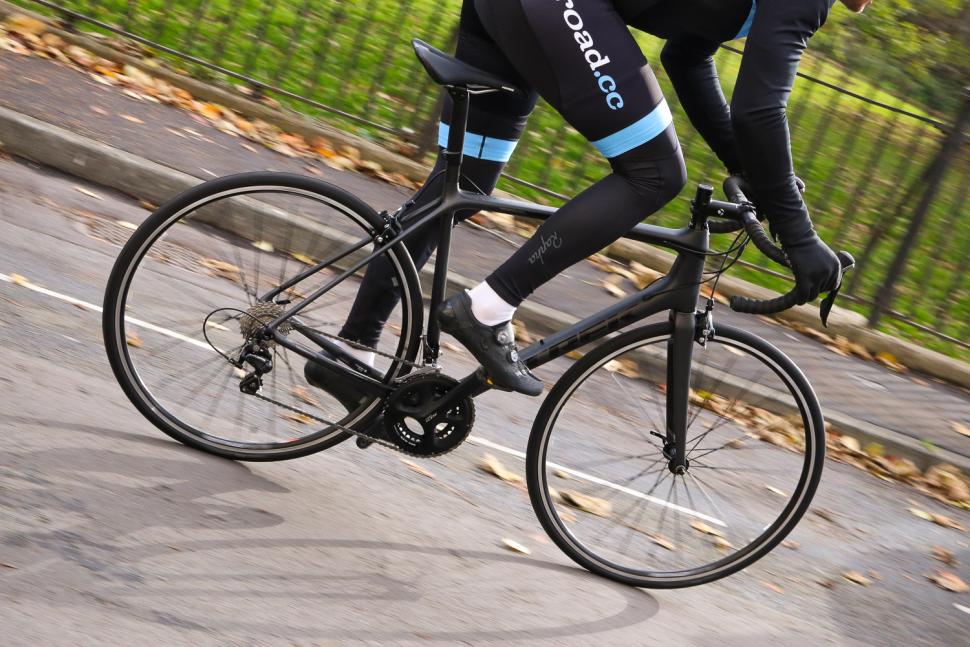
One aspect of the Emonda SL 5's ride that surprised me is the level of comfort on offer here, particularly for a performance bike with 25mm-wide tyres. Okay, you don't get a clever IsoSpeed decoupler like you'll find on a Madone or a Domane to cushion the ride, but there's a decent amount of give in the seatmast and cap that Trek provides instead of a more traditional seatpost, and in the flattened, ultra-skinny seatstays.
As we all know, saddles always come down to personal preference – what feels like an armchair to one person can feel like a razor blade to another – but the steel-railed Bontrager Montrose Comp specced here has a pressure-relief channel/hole in the centre and loads of flex in the shell so I imagine it'll make more friends than enemies.
Great groupset
The Emonda SL 5 descends with assurance, giving you the confidence to lay off the brakes when others are nervously feathering theirs. When you do need to slow down the Shimano 105 brakes work on the alloy rims to provide plenty of predictable power. Shimano does make very good brakes. These are of the direct mount variety and they can be relied upon to hold tight when you need them. They even put in a decent performance in damp conditions although, like any rim brakes, they're outperformed by disc brakes when it's properly wet. If that bothers you and you can stretch to £2,650, the Emonda SL 6 is available in a disc version – with 12mm thru-axles front and rear, a Shimano Ultegra groupset including flat mount hydraulic discs, and an 11-32t cassette.
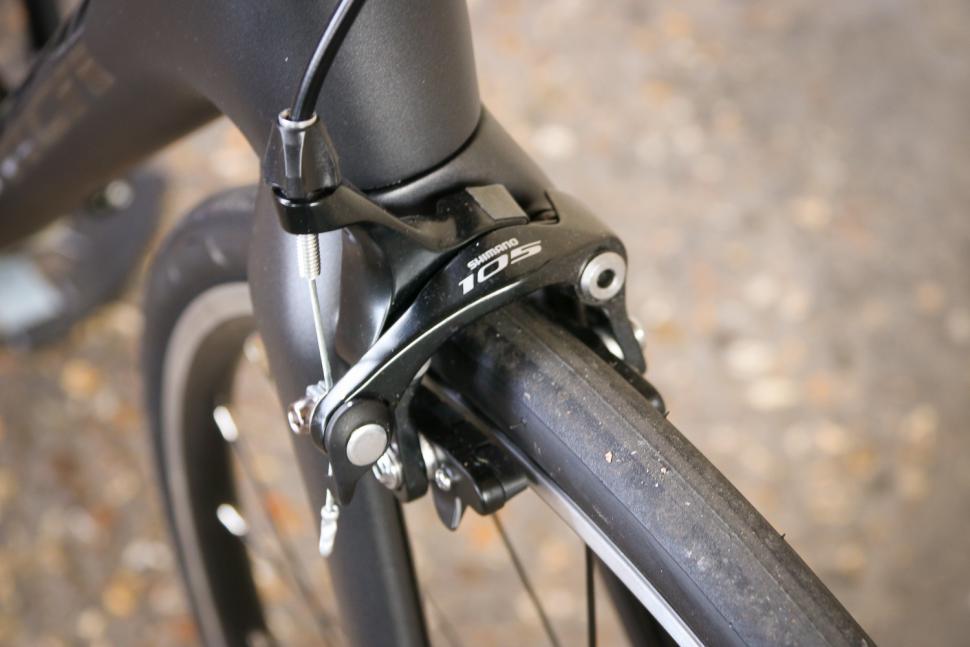
As well as the brakes, the SL5's shifters, derailleurs, chainset, cassette and chain are all Shimano 105. We've covered this groupset a million times on road.cc and it really is difficult to fault for the money.
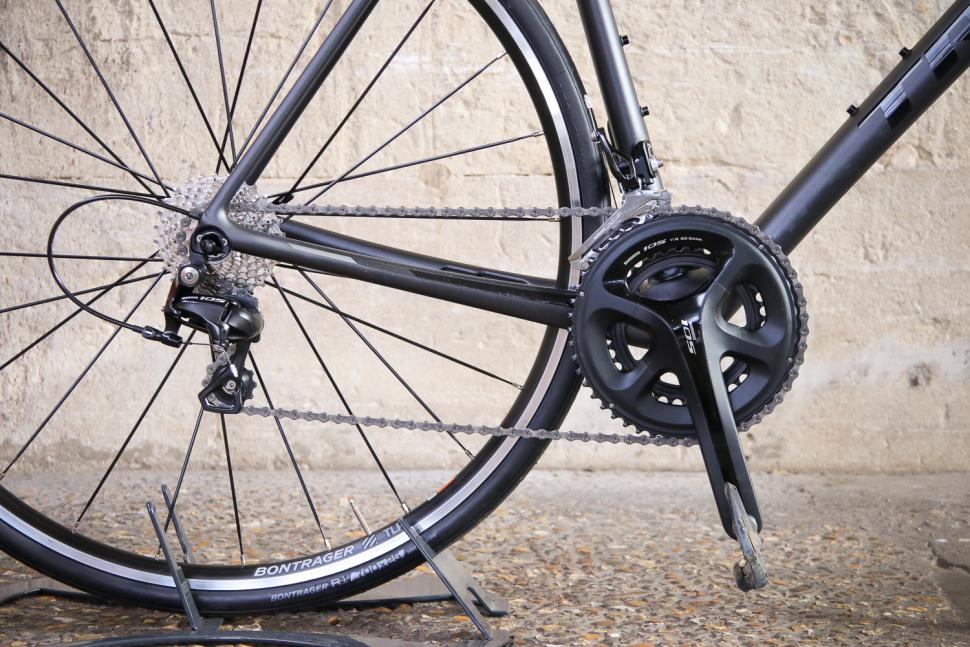
I particularly like the light action shifters. They're slim, comfortable and easy to operate from either the hoods or the drops. There's not a massive difference between these and more expensive Ultegra, or even top of the pile Dura-Ace mechanical shifters. Sure, you can tell them apart but in use... puh! I'd happily use 105 on every ride. It's amazingly popular and rightly so. Although a couple of others run it close, 105 is still arguably the best value groupset out there.
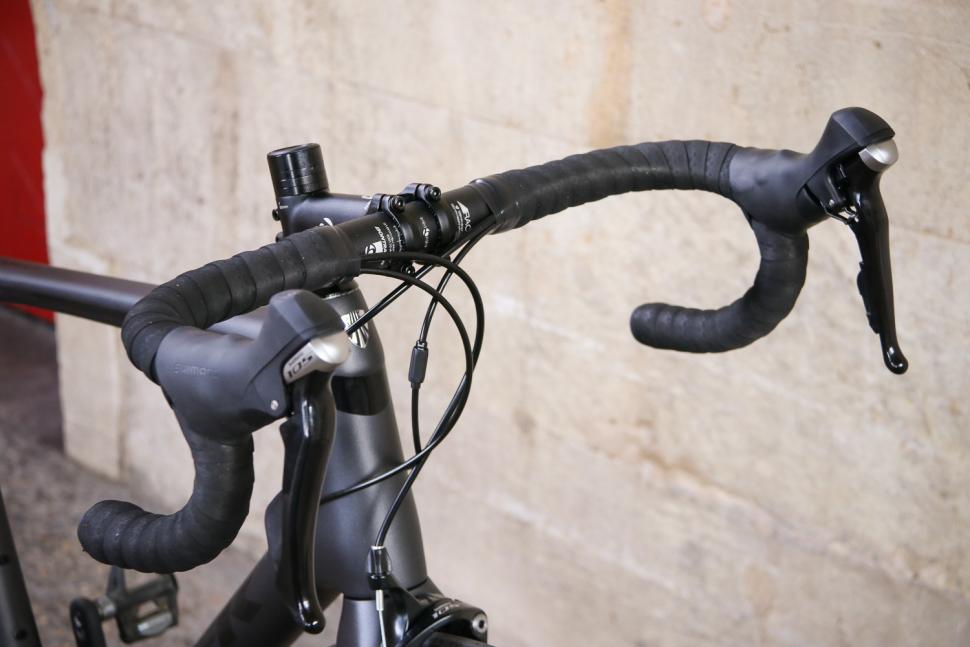
> Head to head: Shimano 105 vs Shimano Ultegra
> And: Shimano Tiagra vs Shimano 105
This has all been a bit of a lovefest so far, but my one tiff with the Emonda SL 5 was right at the start of our relationship. I picked up the bike and was riding home from the office on it – five miles in, whistling a happy tune, thinking about what I'd have for tea, you know the sort of thing – and the front end started to feel... odd. I got out of the saddle on a climb and it felt decidedly spongy. Weird!
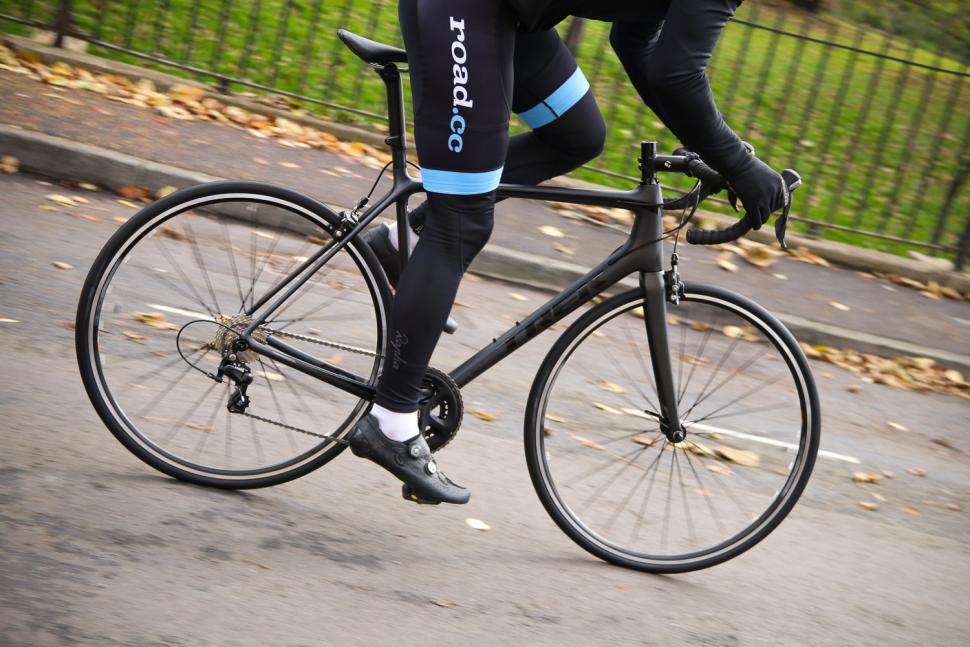
I stopped to check everything and it turned out that several spokes had loosened – about eight of them, I think. And I mean that they'd really loosened to the point that the nipples were just about holding on by their fingertips (shut up! Of course they do). My multi-tool has a spoke wrench on it so I tightened them up at the side of the road, then did a proper job when I got home. Since then the wheel has been fine.
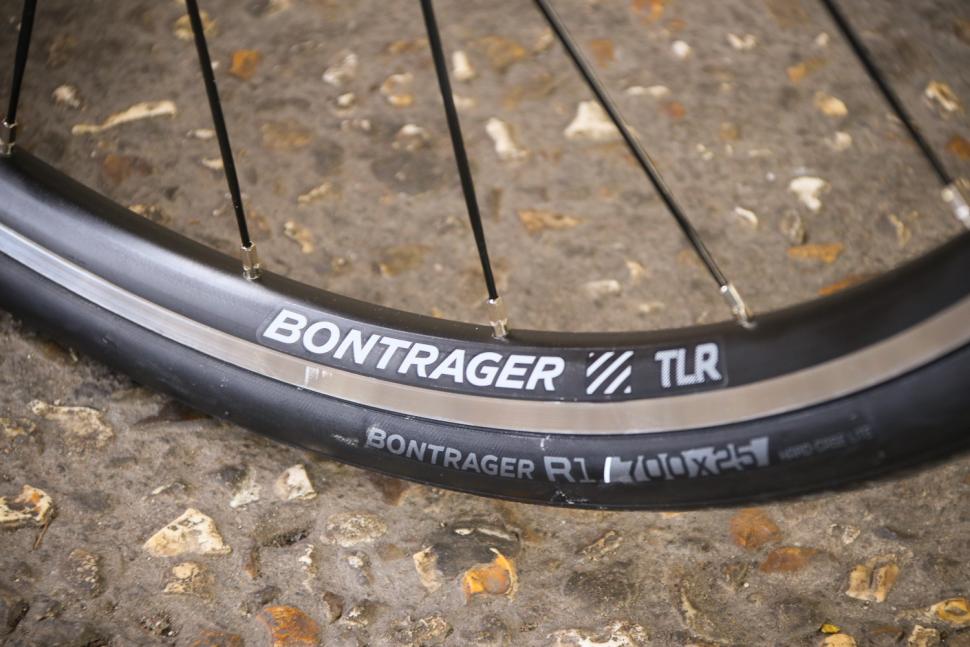
I've reviewed loads of Treks before and this hasn't been an issue in the past, so I'm happy to put it down to bad luck. To be honest, if you know which way up to hold a spoke wrench it's not a massive problem, but it would be a pain if you had to book your bike in to a shop and have a mechanic do the fettling for you. Anyway, I've forgiven the Emonda SL 5 for that now and we've both moved on.
Spoilt for choice
The Emonda range is large, kicking off with the Shimano Tiagra-equipped ALR 4 at £1,000 and going right up to the SLR 9, with Shimano Dura-Ace Di2 components, at £8,500 (a customisable Project One version of the Emonda SLR 9 is also available).
There are four SL models ranging in price from £1,500 (SL 4, Shimano Tiagra) up to £4,300 (SL 7, Shimano Ultegra Di2). At £2,000, the Emonda ALR 6, with an aluminium frame, is actually more expensive than the SL 5 courtesy of a next-level-up Shimano Ultegra groupset. The SL 5 is also available as a women's model.
Oh, and you can buy an Emonda SL frameset for £1,350 – but why would you do that when you can get a complete Emonda SL 4 for £1,500?
> Check out our guide to Trek's 2018 road bike range here
As well as the Emonda SL 6 Disc mentioned earlier, there's an Emonda SL 7 Disc, equipped with a Shimano Ultegra Di2 groupset and Bontrager Aeolus Pro 3 Tubeless Ready wheels, for £4,400.
You can certainly get complete bikes with carbon fibre frames and Shimano 105 components considerably cheaper than the Emonda SL. The Focus Izalco Race Carbon 105, for example, is £1,399 and Giant's TCR Advanced 2 is £1,449. Those two are killer value. Equally, there are plenty of carbon/105 bikes out there that are more expensive. Cervelo's R2 105 is £2,199, for example, and BMC's Teammachine SLR02 Two is £2,250.
I would say that you're getting an extraordinarily good frame with the Trek Emonda SL 5 – one that'll handle considerable upgrading if you fancy doing that gradually as and when individual components wear out. It's that which makes this bike such impressive value for money.

Overall, the Trek Emonda SL 5 is excellent. I had an early issue with one of the wheels but that doesn't detract from the fact that this is a fast and nimble road bike that reacts like something considerably more expensive. Also comfortable and well behaved, it makes you question whether it's worth spending any more money than this.
A fast and nimble road bike that puts in an exceptional performance for its price
road.cc test report
Make and model: Trek Emonda SL 5
Size tested: 58cm
About the bike
State the frame and fork material and method of construction. List the components used to build up the bike.
Frame Ultralight 500 Series OCLV Carbon, ride-tuned performance tube optimisation, E2 tapered head tube, BB90, direct mount brakes, internal cable routing, DuoTrap S compatible, Ride Tuned seatmast
Fork Emonda carbon, E2 steerer, direct mount brakes
Wheels Bontrager Tubeless Ready
Tyres Bontrager R1 Hard-Case Lite, 700x 25c
Shifters Shimano 105, 11-speed
Front derailleur Shimano 105, braze-on
Rear derailleur Shimano 105
Chainset Shimano 105, 50/34 (compact)
Bottom bracket BB90
Cassette Shimano 105, 11-28, 11-speed
Chain Shimano 105
Brakeset Shimano 105, direct mount
Saddle Bontrager Montrose Comp, chromoly rails
Seatpost Bontrager Ride Tuned alloy seatmast cap, 10mm offset
Handlebar Bontrager Race VR-C, 31.8 mm
Handlebar tape Bontrager
Stem Bontrager Elite, 31.8 mm, 7-degree, w/computer and light mounts
Headset Integrated, cartridge bearing, sealed, 1 1/8in top, 1 1/2in bottom
Tell us what the bike is for
It's a road bike designed for racers and other performance-type riders who are interested in speed and fitness.
Frame and fork
Tell us about the build quality and finish of the frame and fork?
The quality is exceptionally good throughout.
Tell us about the materials used in the frame and fork?
The frame is made from Trek's 500 Series OCLV carbon fibre. The fork is carbon too.
Tell us about the geometry of the frame and fork?
Like all the Emonda SL frames, this bike is built to Trek's H2 geometry which sits somewhere between a low and stretched H1 fit and a more upright endurance setup. H2 is certainly performance-focused, it's just not as aggressive as H1.
How was the bike in terms of height and reach? How did it compare to other bikes of the same stated size?
It's about what you'd expect.
Riding the bike
Was the bike comfortable to ride? Tell us how you felt about the ride quality.
It's surprisingly comfortable for a bike of this type. You only get so much cushioning from 25mm tyres but the seatmast certainly helps to damp vibration and soften the blows.
Did the bike feel stiff in the right places? Did any part of the bike feel too stiff or too flexible?
The super-wide down tube holds the bottom bracket firmly in place and the tapered (1 1/8in to 1 1/2in) head tube keeps the front end in order.
How did the bike transfer power? Did it feel efficient?
It felt efficient, without a doubt.
Was there any toe-clip overlap with the front wheel? If so
Some. It's only ever an issue for tight manoeuvres at walking pace.
How would you describe the steering? Was it lively Lively.
Tell us some more about the handling. How did the bike feel overall? Did it do particular things well or badly?
It offers a great ride whether you're going uphill, downhill or on the flat. It's a well-balanced bike that feels like it can cope with pretty much anything.
Which components had the most effect (good or bad) on the bike's comfort? would you recommend any changes?
The seatmast and seatmast cap take some of the credit here, along with Bontrager's saddle.
You can swap to 28mm wide tyres if you want to run lower pressures for more comfort.
The drivetrain
Wheels and tyres
I have to take into account that several spokes came loose almost immediately. The rims are tubeless ready, if you want to go down that route.
After an initial scare they were fine.
Anything else you want to say about the componentry? Comment on any other components (good or bad)
The Shimano 105 groupset put in an excellent performance.
Your summary
Did you enjoy riding the bike? Yes
Would you consider buying the bike? Yes
Would you recommend the bike to a friend? Yes
Use this box to explain your overall score
The Trek Emonda SL 5 puts in a really strong performance. You'd be hard-pressed to tell from riding it alone that this wasn't a considerably more expensive bike. You're getting an exceptionally good bike for the money, and that equates to a 9.
Overall rating: 9 /10
About the tester
Age: 43 Height: 190cm Weight: 75kg
I've been riding for: Over 20 years I ride: Most days I would class myself as: Expert
I regularly do the following types of riding: commuting, club rides, sportives, general fitness riding
Help us to fund our site
We’ve noticed you’re using an ad blocker. If you like road.cc, but you don’t like ads, please consider subscribing to the site to support us directly. As a subscriber you can read road.cc ad-free, from as little as £1.99.
If you don’t want to subscribe, please turn your ad blocker off. The revenue from adverts helps to fund our site.
Help us to bring you the best cycling content
If you’ve enjoyed this article, then please consider subscribing to road.cc from as little as £1.99. Our mission is to bring you all the news that’s relevant to you as a cyclist, independent reviews, impartial buying advice and more. Your subscription will help us to do more.
Mat has been in cycling media since 1996, on titles including BikeRadar, Total Bike, Total Mountain Bike, What Mountain Bike and Mountain Biking UK, and he has been editor of 220 Triathlon and Cycling Plus. Mat has been road.cc technical editor for over a decade, testing bikes, fettling the latest kit, and trying out the most up-to-the-minute clothing. He has won his category in Ironman UK 70.3 and finished on the podium in both marathons he has run. Mat is a Cambridge graduate who did a post-grad in magazine journalism, and he is a winner of the Cycling Media Award for Specialist Online Writer. Now over 50, he's riding road and gravel bikes most days for fun and fitness rather than training for competitions.
Add new comment
16 comments.

I share similar thoughts on Emonda SL 5. Bought new in 2019 as 2018 model for only 1.200 € and it seemed like a great deal. But wheels almost fell appart after 30 km, most of the spokes were totaly loosened. I was lucky to find that out just before the fast descent. Both wheels, front and rear! I took it to dealer and they said I was just unlucky, one in a million. Then I waited more than 2 months for new pair of wheels, replaced under guarantee. Got Bontrager Affinity TLR wheels. They were fine but bearings seem to be totaly destroyed after about 7000 km. So I did upgrade to Mavic Cosmic.
What do I think about the bike now? It is a great bike, with perfect geometry for me, very responsive and good for climbing. Not super light but good enough. Not aero at all but new wheels are doing the job much much better. It's a climber not a TT bike. Would I recommend the bike to anybody? Probably not, due to the serious issue with wheels that could affect safety.
I still cannot understand how can a company like Trek put so awfull wheels on a nice carbon bike like Emonda 5. In my eyes this was a recall situation and obviously not a one in a million case.
- Log in or register to post comments
I might be corrected but up to last year or perhaps this, the model was fitted with lighter 'Race' wheels. They kept the price at £1800 and put cheaper wheels on it. It's a shame as the frame and groupset is excellent, in my opinion.
"Coming in at 8.55kg (18.8lb), the Emonda SL 5 is light...
Don't get too hung up on weight, though. I only really bring it up because Trek makes such a big deal of it when talking about the Emonda".
How does a carbon bike which sells for £1800 and weighs over eight and a half kilos get described as LIGHT ?
For comparison at £1800: the Canyon Endurace CF8.0 is size Medium is 7.2 kilos.
The £1800 Rose GF Team 4 Ultegra is 7.1 kilos.
Both bikes have a complete Ultegra groupset - no sneaky substitutions, both have excellent DT Swiss wheels and are well equipped right down to Conti's top tyres.
What they seem to lack (apart from a kilo and a half) is the word Trek written down the side.
macbob wrote: "Coming in at 8.55kg (18.8lb), the Emonda SL 5 is light... Don't get too hung up on weight, though. I only really bring it up because Trek makes such a big deal of it when talking about the Emonda". How does a carbon bike which sells for £1800 and weighs over eight and a half kilos get described as LIGHT ?
If the original article was from 2014 when the SL5 was launched, then 8.55 Kg would have been viewed as somewhat light for a fast endurance bike back then.
"If the original article was from 2014 when the SL5 was launched, then 8.55 Kg would have been viewed as somewhat light for a fast endurance bike back then".
All true, although the article is bylined:
by Mat Brett May 25 2018
and a quick check of the Evans website suggests the bike is still nearly eight and a half kilos.
macbob wrote: "If the original article was from 2014 when the SL5 was launched, then 8.55 Kg would have been viewed as somewhat light for a fast endurance bike back then". All true, although the article is bylined: by Mat Brett May 25 2018 and a quick check of the Evans website suggests the bike is still nearly eight and a half kilos.
Unlike the German bikes this bike does come with boat anchors for wheels and wire bead tyres. Along with the 105 groupset that would explain most of the weight difference.
The review suggests though that the frame is fantatsic so a wheel + tyre upgrade would leave you wth a fantastic bike. Sure it would cost more than the German bikes but there's more to a bike than just it's weight.
Joe Totale wrote: macbob wrote: "If the original article was from 2014 when the SL5 was launched, then 8.55 Kg would have been viewed as somewhat light for a fast endurance bike back then". All true, although the article is bylined: by Mat Brett May 25 2018 and a quick check of the Evans website suggests the bike is still nearly eight and a half kilos.
European reviews of the Rose & UK and European reviews of the Canyon suggest the frames on both those bikes are excellent too. So the question is: do you want a lightweight bike with an excellent frame, a complete Ultegra groupset, highly regarded DT Swiss wheels and top drawer finishing kit... or do you want the Trek.
Or you could take the view that a bike is more than just a frame, a groupset, wheels, tyres and finishing kit in which case the big American brands with their overweight, under specced and overpriced offerings are for you.
"Updated May 25th 2018". It was a recycled article, hence my comment......
Why is this bike being compared to the Boardman SLR Endurance Disc 9.0? The calliper version comes in at 7.6kg and gives you an almost complete Dura-Ace groupset and a better wheelset for only £99 more. https://www.boardmanbikes.com/gb_en/products/242-slr-9.2-endurance.html
Did a few hundred KMs on a rented SL5 in Mallorca earlier this year.
Nice machine, although the most impressive element was the 105 groupset (especially the brakes), which is easy to find on other makes/models.
It was definitely comfortable, and reasonably light - although I couldn't say I noticed a huge improvement on my 725-framed Equilibrium. May be my own frame which means a couple of KG off the bike doesn't make much obvious difference, of course...
So certainly not a bad option but I'd be tempted to look around a bit more before splashing that sort of cash.
Decent / good frame with full 105, own brand everything else (bars, stem, seatpost, wheels, tyres, may be ok stuff) inc wheels which look very spokey.
giant tcr advanced pro 2 would be a potentially better bike
in a sale at £1800 it has giant tcr frame (one of stiffest on market) giant slr carbon wheels and 105.
beaut bike would reccomend. Its weight is also 7kg
spinner98 wrote: giant tcr advanced pro 2...has giant tcr frame
Well that's very reassuring.
Incredibly generous considering the wheel supplied was in a dangerous condition.
An ordinary person may not have noticed the odd feeling and ridden it until it collapsed under them, throwing them under a car. It’s pretty serious.
Prosper0 wrote: Incredibly generous considering the wheel supplied was in a dangerous condition. An ordinary person may not have noticed the odd feeling and ridden it until it collapsed under them, throwing them under a car. It’s pretty serious.
Well that really depends, for most people that would have been picked up by the shop you purchased the bike from. For everyone who orders it direct I would expect them to check the wheel before riding it
Really? They'd notice the wheel not fitting between the brake pads a long time before collapsing.
Latest Comments
Didn't know the Silver Machine bit!...
Not in some dialects of English, eg Scottish. But it's a glide in most forms of English
It's the little round thing on the side of the shears, it has a prong in the middle.
Probably had 35s also but the combination of 28 M+ (with tube) and the random wheels on the old tourer was often tear-inducing - and I (had) fairly...
BMW 1-Series crashes in Bournemouth town centre pub https://www.bournemouthecho.co.uk/news/24554262.bmw-1-series-crashes-bou...
Have a good night, Andy. Two nights at Street? Plans for Sunday?
Cybertruck
It's not like the BBC don't know what term to use when they think it matters not to imply that there's nobody to blame.
Is this with the same wheels etc? 3mph seems wild to me when manufacturers are talking about a handful of watts at best.
Brought to you by Logan's Run? Or Brave New World (for a few extra years)?
Related Reviews

Merida Scultura 4000 2024
Fun, fast and comfortable race bike at an affordable price
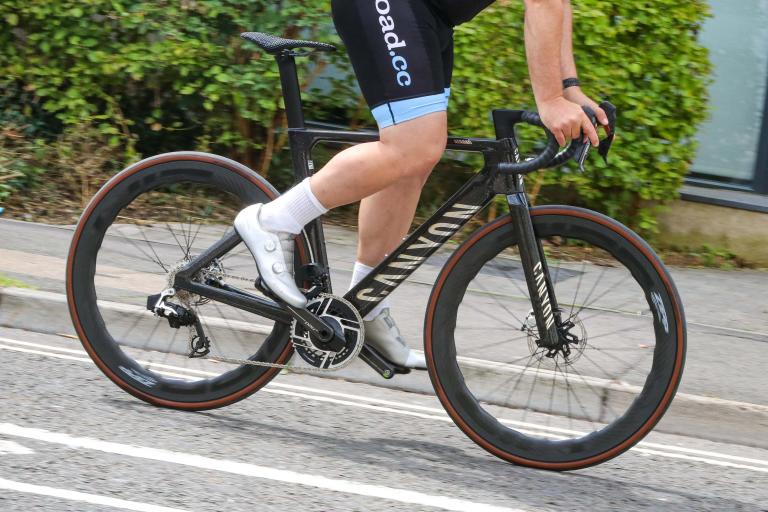
Canyon Aeroad CFR AXS 2024
Stunning performance right across the board from this versatile aero machine
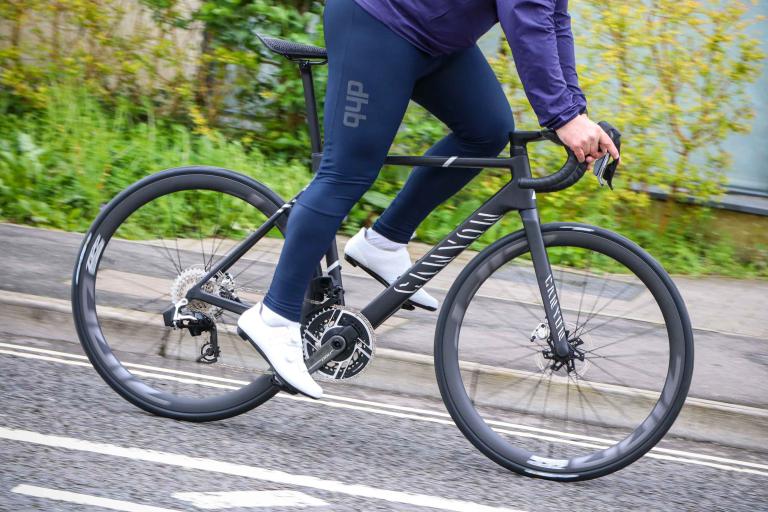
Canyon Ultimate CFR AXS 2024
Stunning performance thanks to excellent stiffness, a very low weight and a sublime ride quality

Enigma Eikon Frame 2024
Excellent in terms of the ride, and the handmade build quality is stunning
Trek Emonda SL6 Pro review
Trek's latest GC/climbing bike has undergone an aero transformation, but has it helped?
- Sign up to our newsletter Newsletter
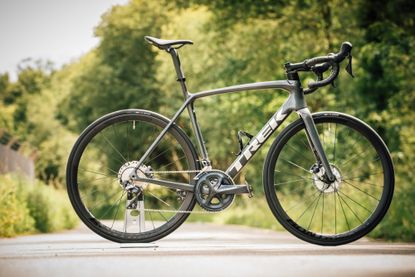
The radical changes brought about in this new Emonda frame are somewhat hampered within the SL range owing to the heavier nature of the frame and subsequent ride quality of the 500 Series OCLV carbon. It is a solid all-round performer and there's no getting away from the fact the ride quality provides a good balance of efficiency and ride comfort. It's just if you were looking for an improvement on the ride of the previous model you'll need to hold off and get one of the higher level SLR models to truly see improvements.
Efficient power transfer
Excellent handling prowess
Compliant ride
New SL frame has lost some of the excitement of the existing Émonda
Heavy for a 'climbing' bike
You can trust Cycling Weekly. Our team of experts put in hard miles testing cycling tech and will always share honest, unbiased advice to help you choose. Find out more about how we test.
Trek recently released a brand new re-imagining of the Emonda, the brand's lightweight climbing/GC model platform, featuring a drastically aero-ised chasis. The model family is split into a higher tier SLR and the lower SL range that this SL6 Pro sits in, the critical difference is in the carbon layup and the enhanced integration sported by the SLR range.
The frame on the Emonda SL6 Pro is constructed of Trek's own 500 Series OCLV carbon fibre. This carbon layup might be heavier than the newly showcased ultra light 800 Series OCLV of the top level SLR Émonda's but is considerably more economical to produce, helping keep the SL range prices in a much more affordable tier.
>>> The Trek Madone gets an update, but you won't spot it
The new Emonda features a completely new set of tube shapes, most of which have gone down the aero route. But Trek is at pains to keep the comparisons to the Madone aero race bike to a minimum; this isn’t simple a ‘Madone Lite’. Rather than being the same elongated shapes as found on a proper aero race bike, the aero shaping of the Emonda’s tubes is much more subtle and is based around the principle of unsteady aerodynamics.
>>> Best road bikes reviewed

In this case it’s more about how drag is affected through wind gusts and other factors at slower speeds than the usual 45km/h, after all, not even pros climb at these speeds. There are still the characteristic truncated airfoil shapes that we associate with aero frames but the effect is far less dramatic and produces a frame that still has a traditional look.
Trek Madone SLR9 Disc review
Trek hasn’t jumped on the dropped seatstay bandwagon with the new frame either, preferring to stick to a set of widely spaced yet aero shaped, thin seat stays.

The new frame also enjoys a little more integration, bringing it more in-line with the Madone. All models now see the cable routing brought neatly into the frame at the front of the headtube keeping the front end profile as slippery as possible.
The other notable feature of the new frame is a wholesale move to the T47 bottom bracket standard . This style marries the reliability of a threaded shell with the capability of running larger diameter internal bearings and enables Trek to maintain its characteristic wide and efficient bottom bracket stance.
The new Emonda range has also been designed with Trek’s middle-ground H1.5 geometry ensuring a set of numbers that sits it half way between the ultra-aggressive pro H1 and its laid back and relaxed, endurance specific H2 geometry. A tall stack of split spacers under the stem provides plenty of height adjustment for a wide range of rider requirements.
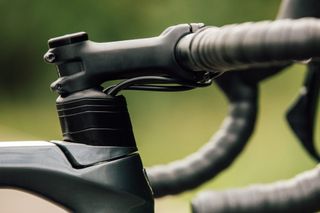
And finally, keeping the Emonda in a pretty rigid user set Trek has bucked another trend and limited tyre clearance to just 28c putting the focus of the bike purely on road going high performance.
The SL6 Pro sits near the top of the SL range and as such has a a pretty decent spec sheet. A mechanical Shimano Ultegra is the least we would expect at the +£3,000 price point and we don't need to point out how reliable and consistent it is in providing smooth shifting and braking.
As with the entire Emonda range the SL6 Pro runs on Bontrager wheels; Aeolus Elite 35 to be precise. These feature a carbon 35mm depth and complement the new 'aero' frame without compromising too much on weight and climbing ability. They feel stiff under power and spin up to speed relatively quickly. There are lighter and faster wheels that would suit the new frame but at this price point the Aeolus Elite is spot on. The tyres are Bontrager as well, in this instance 25mm R2 Hardcase Lite tyres. These are not Bontrager's fastest tyres, more classed as an everyday tyre with plenty of puncture protection.
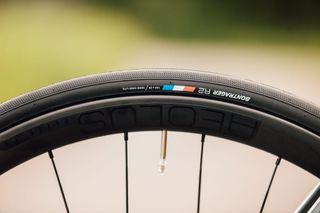
In a complete whitewash the entirety of the finishing kit is also provided by Bontrager. Unlike the integrated carbon bar/stem of the higher end SLR models, the SL6 Pro is fitted with a standard aluminium handlebar and separate stem, allowing for much simpler cockpit customisation. Despite the more ordinary setup the cable routing is still really neat underneath the stem without needing any additional housing.
The Émonda maintains the 'reversed' seat post, with a larger diameter seatpost mast fitted over the seat tube. This allows for plenty of adjustment plus further lengths are available if needed. The Bontrager Aeolus saddle also stands out for being incredibly comfortable even when sat right on the nose.

I was curious to see if the new Emonda was able to improve on the ride quality of the highly rated existing version and the short answer is yes, well kind of....
The first thing to note is that in this new guise, the lower SL version I have on test feels a little chunky at over 8 kilograms - not something you expect when the bike's raison d'etre is all about low weight and climbing. However a total mass doesn't always equate to an anchor of a ride experience and this is true of the Émonda.
Trek has managed to provide a level of stiffness around the bottom bracket that enables the Émonda to deliver in its promise of rewarding effort. Granted it takes less effort to maintain speeds on flat and rolling terrain, much like the Madone aero bike, and I'm certain it is a 'faster' bike than the last version. But I can't help but feel that this new design has stifled some of the existing model's lively and exciting ride nature - it feels like using adjectives such as solid and dependable is more appropriate, almost like the Domane endurance bike.

Trek's relaxing of the geometry on the Emonda has increased its ability to keep you comfortable and riding hard on a long ride and I had no issue taking on some challenging and long routes around Dorset and South Wales. The tall stack of shaped and split spacers sit the cockpit a little too high for my personal preference but luckily I was able to drop the stem height by using some standard spacers on top of the stem, without needing to cut the steerer. This put a little more weight on the front wheel which enabled me to descend the Émonda with aplomb and happily stuff it into downhill corners at high speed without any of the vague feeling that can come with a front end that is a touch too high.
Climbing is where the Emonda should thrive and it certainly is no slouch on your typical British climb, however it doesn't set the tarmac alight and the near eight kilo weight does neuter the Émonda's ability to counter attack when your riding mates try to accelerate away from you on a climb.
It feels like I'm being a little harsh and critical of the Emonda SL6 Pro, after all in most respects it is a solid all-rounder and I have enjoyed my time riding the bike over the last few months. It's a great looking bike and I expect most riders will be satisfied with the performance, it's just I feel it has a lost a little of the magic the old version had. If you are looking for the sort of engaging ride the Emonda is known for I suspect you would need to save your pennies and opt for one of the lighter SLR options and certainly if it was my money that would be what I would need to do.
Thank you for reading 20 articles this month* Join now for unlimited access
Enjoy your first month for just £1 / $1 / €1
*Read 5 free articles per month without a subscription
Join now for unlimited access
Try first month for just £1 / $1 / €1
Get The Leadout Newsletter
The latest race content, interviews, features, reviews and expert buying guides, direct to your inbox!
James Bracey's career has seen him move from geography teacher, to MBR writer, to Cycling Weekly's senior tech writer and video presenter. He possesses an in-depth knowledge of bicycle mechanics, as well as bike fit and coaching qualifications. Bracey enjoys all manner of cycling, from road to gravel and mountain biking.
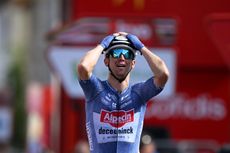
Visma-Lease a Bike controlled the action all day for Van Aert but the Belgian couldn't hold off Groves in Villablino
By Flo Clifford Published 31 August 24

The Australian hung onto red on Friday, but lost almost two minutes
By Adam Becket Published 30 August 24
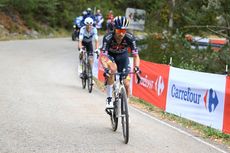
Wout van Aert takes a clear lead in the king of the mountains competition
By Vern Pitt Published 30 August 24
Useful links
- Tour de France
- Giro d'Italia
- Vuelta a España
buyers-guides
- Best road bikes
- Best gravel bikes
- Best smart turbo trainers
- Best cycling computers
- Editor's Choice
- Bike Reviews
- Component Reviews
- Clothing Reviews
- Contact Future's experts
- Terms and conditions
- Privacy policy
- Cookies policy
- Advertise with us
Cycling Weekly is part of Future plc, an international media group and leading digital publisher. Visit our corporate site . © Future Publishing Limited Quay House, The Ambury, Bath BA1 1UA. All rights reserved. England and Wales company registration number 2008885.

Émonda SL 6 Pro Ridden and Reviewed
Filter by category:, an early contender for "bike of the year".
Trek's launch of the new generation Émonda is a big deal. The previous generation was a very good bike but I felt it was out-classed by its arch rival the Tarmac SL6 (no harm there as the Tarmac was exceptional, but Trek and Specialized products are much closer in abilities in the aero road and endurance categories).
So a new Émonda is an exciting prospect; especially when the hype coming from the Pro teams has been so loud - this bike is aero enough that it will apparently replace the Madone as the main stage race weapon. That's some welcome extra versatility for a very light bike.
Being a bike tart I was initially focused on the top of the range Émonda SLR series (and I do have one on order).
But when we looked at the specs we realised the SL series (made with OCLV 500 carbon vs the 800 on the flagship range) looked a cracking bike for the money, and the pick of the bunch was the SL 6 Pro at £3350. A lightweight climbing bike with aero advantages, Ultegra disc groupset and carbon wheels. That's a heck of a bike for the money.
And it comes in a super smart Lithium Grey / Brushed Chrome finish (well, these things matter too!) that belies the price point.
In the first week it was launched we sold 10 of the SL 6 Pros; everyone loved it and I said to Dan that based on spec and first impressions this was a (very) early contender for 2020 Bike of the Year. And so, in the interests of editorial thoroughness, I decided to buy one myself and see how it performed.
I have wheelsets that cost more than this entire bike; so I was really keen to see how it performed vs the £9000 super bikes I kid myself I 'need'.

Initial impressions
On unboxing my first impressions were immediately very positive; it looks very smart indeed. I have always loved dark grey (slightly darker than Nardo grey if you are a car geek) and the chrome decals really set it off. Its a really good looking bike, with a sleek look from the aero tubes that still manages to be quite 'classic' in profile.
The SL range don't have the trick one piece bar/stem that features on the SLR models. Instead it comes with a separate alloy stem and an alu bar with Bontrager's VR-C shape. This is the first time I have ridden them and they are long - 100mm reach when most bars are 75-80mm; so my maths shows that all things being equal you need to lose some stem length. My bike comes with a 110mm stem in 58cm, and truth be told I might go down to 100mm (which hurts the ego... but fit matters!). But the bar shape overall is great, and the drops are super useful.
The saddle is the new Aeolus shape; with a massive pressure-relieving cut out in the middle, running almost the full length of the saddle. It comes in a posh one at £150 (with carbon rails and shell), a middle range one at £90, and this 'budget one', the Comp, which retails on its own at £49. The Comp is relatively heavy at 280g, thanks to steel rails, but that's my only issue with it; the shape is great and £49 for a saddle this good is outrageous value for money.

I like mechanical Shimano; I have Dura Ace 9000 and 9100 on other bikes; but this was the first time I have ever owned a bike with a mechanical disc groupset. As ever with Shimano shifting is flawless, and I really like the shape of the hoods (whisper it, but more than the Di2 version) as there is a lot to grab hold of; its closer in size to AXS than Di2 (and to me, thats a good thing).
My only change from the stock bike is to put my SRM power meter crankset on the bike, replacing the stock Ultegra crank. Everything else is 'as is'.
Those carbon Aeolus 35 wheels look the part, the only thing I would recommend changing from stock immediately is the Bontrager R2 tyres which are decidedly 'budget' in feel and don't roll that well. You can feel the stiffness in the casing, and a more supple tyre would improve the ride and handling at little cost.
I popped on a set of my favourite Specialized Turbo Cotton 320TPI in 28mm and it really made the ride come alive. Sacrilege, I know, but they're what I had to hand. Something like the Vittoria Corsa would also be a superb option when you're looking to upgrade from the stock tyres, that supple casing makes all the difference.

Ride impressions after 4 rides
It's still early days; but I have tested enough bikes to know that good bikes rarely become bad, but sometimes bikes you don't immediately gel with can come good with some small positional or component tweaks.
I am pleased to say the Emonda SL 6 Pro is simply a very good bike from the off. I had to keep reminding myself it was 'only' £3350; apart from some small weight gain and cheaper tyres it rides like a bike that costs double this. Swap the tyres out and it's even better.
Trek have mirrored the Madone geometry. There's no longer the choice of H2 (moderately relaxed) or H1 (Pro aggressive), but instead they've gone to H1.5 across the range. This to me is a welcome development - it's a Goldilocks geometry; aggressive enough to be racey but not so low or long as to need lots of spacers.
It's hard to 'feel' the aero gains of the new Émonda; I am coming off a Venge with 65mm wheels so that's setting a pretty high benchmark. But it doesn't feel slow on the flat by any means; it's certainly competitive (especially vs the old Émonda which was a bit of a brick wall aerodynamically). Where it does shine is uphill; the thing just flies.
I have read some people think the SL 6 rides 'harsh'; I certainly don't agree. Direct and responsive yes, but definitely not harsh, and swapping out to 28mm tyres (vs the stock 25mm) has improved things further, without any downsides.

Upgrade pOTENTIAL
Trek offer the Émonda SL 6 as standard in two variants; the SL 6, at £2900 with Bontrager Paradigm alloy rims and the SL 6 Pro at £3350, which is the same bike but equipped with Bontrager's Aeolus Elite 35 carbon wheels.
Both wheelsets are tubeless ready, but the Paradigm are a fairly "entry level" wheelset, tough and durable but not especially matching the light weight of the frame (at approx 1750g per pair). So for the relatively small uplift in price it's no surprise that the SL 6 Pro is proving to be vastly more popular, it's a really cost effective way to get some decent carbon wheels from the offset.
I was really impressed with the 35mm deep Aeolus Elite carbon wheelset in my testing, it packs a lot of punch for the money, part of the new generation of superb value wheels that have reduced the cost of entry to carbon.
The Émonda SL though is a bike that makes a perfect platform for upgrading over time, it's such a strong base to build on. I couldn't resist trying it with some of my other wheelsets (some of which are £2000+ and thus 2/3rds of the bike's price!). You can tell a good bike when good wheels "lift" it further.
That's certainly the case here, and as seen in my photos I've been putting in some miles on the ENVE SES 5.6 and my Rovals, both of which take things up a notch further still. With a high-end wheelset the SL 6 really flies, it can hold its own with bikes costing much more.

As you can tell, overall I really liked the bike. It's an outstanding privateer's race bike; for £3350 it offers everything you need; an aero climbing bike, with disc brakes and carbon wheels. The pace of technology is such that this is better than a £10,000 bike was a generation ago...
Of course me being me, I can't help but wonder when I get the SLR frame (rumoured to be 400gm lighter than the SL one) just how good it will be! But that'll get its own review, I'll just have to wait...
In the meantime the SL 6 is already proving to be a justified sales success for Trek, and has got the revamped Émonda line off to a superb start. If you're looking for an exceptionally capable race day bike and this fits your budget, it's got to be on your (very) shortlist. Its the most impressive new bike I have ridden in 2020.
words and pictures by Barry Scott
- At Bespoke we offer the full Trek range, perfectly fitted. For more info and to discuss your own Émonda, get in touch

Ultralight and Aero - the new Trek Émonda
Trek have unveiled their new generation Émonda, bringing all the climb-focused light weight you'd expect (sub-700g for the SLR frame) together with new aero benefits. We've...
New Project One ICON paint schemes
Trek's Project One programme offers a world of custom colour options. They've marked the launch of the new Émonda with some very special editions in their ICON series.

All New Trek Domane
Trek have unveiled a very fresh take on their ever-popular Domane, with an all new design for the 2020 model year.
- MAGAZINE OFFERS
- BIKE INSURANCE
- Best Products
- Maintenance
- Accessories
- Long-Term Reviews
- First Look Friday
- Bike of the Week
- Tech Features
- Routes and Rides
- Bike Galleries
- BikeRadar Bargains
- Buyer's Guides
- Fitness & Training
- Sizing & Fit
- Mountain Biking UK
- Cycling Plus
- BikeRadar Podcast
Trek Emonda SL 6 review
The legendary Madone gets another anagram
Robert Smith
Warren Rossiter
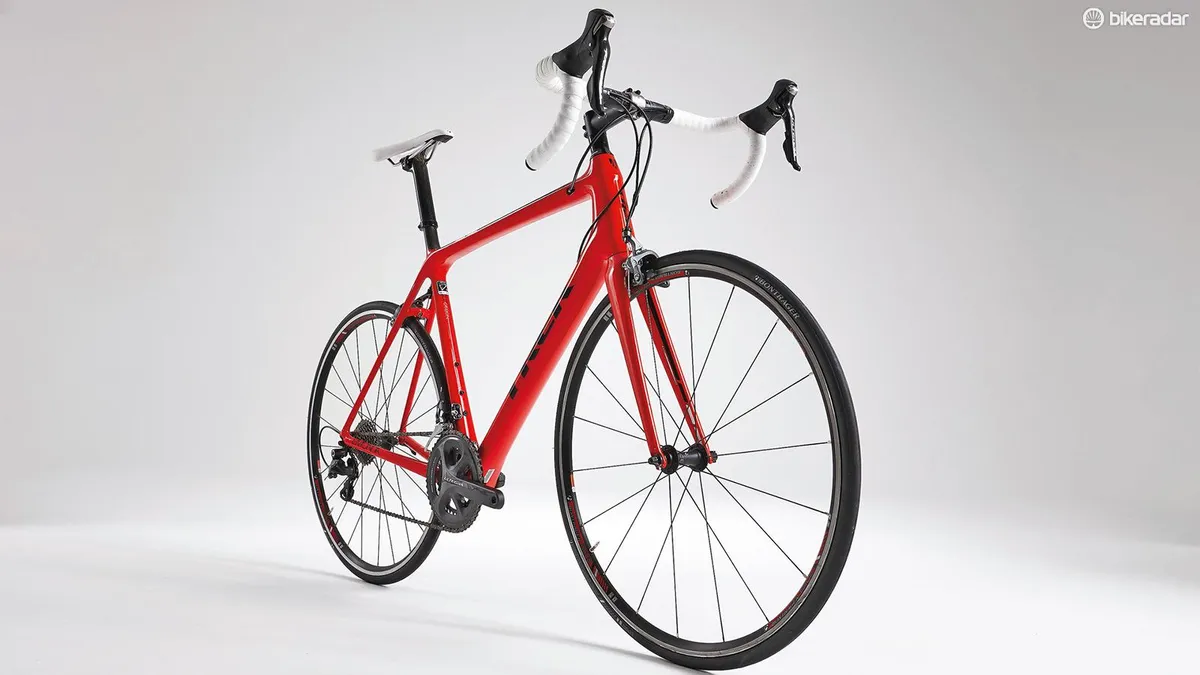
Trek’s rivals in the big three bike brands both launched aero-road machines in the form of Giant's Propel and the Venge from Specialized. Trek followed suit in the last revision of the Madone with it morphing into an aero-tweaked race special. With the innovative Domane, with its ‘decoupler’ soft tail design, being a straight-up rival for Specialized’s Roubaix and Giant’s Defy, the Madone was always in direct competition with the big S’s Tarmac and Giant’s TCR. Its aero revisions left a big hole in Trek's arsenal, which the Emonda is here to fill.
- Highs: A ride full of life and excitement, a future classic
- Lows: Average wheels and mediocre bars
- Buy if: You want a true all rounder in the classic sense
Emonda may be an anagram, but it’s also derived from the French verb emonder, meaning to prune and trim away. So at the core of the design its lightweight with any extraneous material and features trimmed back. That’s certainly true of the flagship SLR 10 and its astonishing 690g frame weight and 4.65kg (56cm) complete weight (though its price tag certainly won't appear pared-down to anyone except the super-rich).
This SL6 uses the new 500 series OCLV carbon to create a frame weight of 1050g. That's impressive enough, especially for a bike at this price – the complete weight of our 58cm test ride is a very respectable 7.74kg – but it’s certainly not all about grams here.
The SL6 is well equipped, with a full Shimano Ultegra groupset
The SL6 is one of the best equipped Treks we’ve seen in a long time. In the past we’ve criticised them for their mix and match approach to component specs, which often saw a few lower grade items dropped into the drivetrain to save a few bucks. For 2015 though we are seriously impressed that Trek has gone the complete route with a full Shimano Ultegra groupset that adds an impressive value status to the overall equation.
Though the Emonda is an all-new bike, within minutes of hopping into the saddle we felt right at home. If for a moment we hark back to the glory days of the Madone, when it was one of the lightest in the peloton and winning everything (no matter how tainted those victories are now), the essence of that bike's excellence was its mix of lightness and handling prowess – and the SL6 has that and more.
The familiar H2 fit, slightly taller than the pro-level bikes, and slightly shorter in reach too (our 58cm bike has a 57.3cm top tube) gives a comfortable yet commanding riding position. We were still able to get down in the drops and push the pace without ever feeling cramped, yet rise up onto the hoods and you can push the pedals all day and cover epic distances free of aches and pains.
Climbing is where the Emonda excels – it may not be class-leadingly light, with its average weight wheels and middleweight finishing kit, yet it climbs with the vigour of a spider monkey escaping a hungry predator.
Crest the brow of a hill and point the SL6 back down and the chassis’ liveliness uphill transforms into a compliant ground hugging missile that floats over bumpy and broken surfaces with a limpet-like tenacity for holding its line. The amount of grip it exudes through hard cornering is mighty. The only negative is the alloy bar's narrow diameter, which doesn't offer the most comfortable of holds – and its overly stiff nature is at odds with the rest of this hugely impressive 2015 debut.
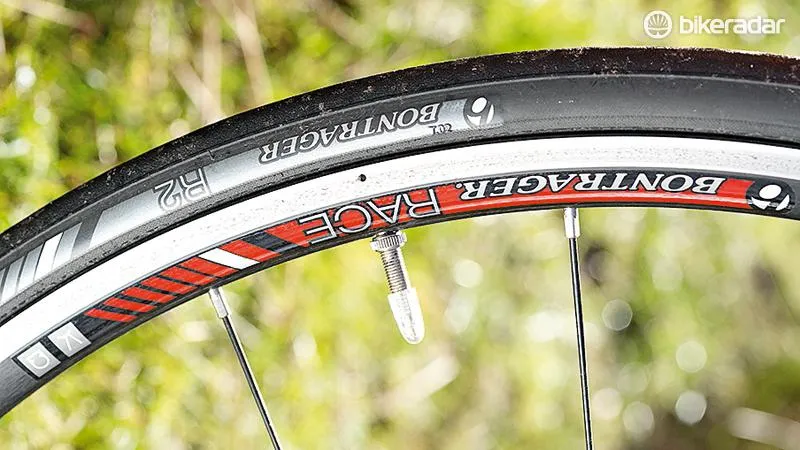
The Trek’s comfortable frame doesn’t need wider than 23c rubber
The Bontrager Race wheels are the most basic Trek offers, but even these are tubeless ready (admittedly, we're all still waiting to see if tubeless will ever take off on the road). They're decent enough – under hard sprint efforts we managed to induce a little brake rub, but nothing of any real concern and only apparent because the Emonda is so damn good at everything else it does. The slim 23c rubber they're shod with offers great all-weather grip and proved plenty tough enough in testing, and it's testament to just how smooth the bike is that Trek hasn’t resorted to anything wider for extra comfort.
In all the Emonda is the rightful heir to the classic Madone, blending ride quality, lightness and a whole shedload of riding fun. Its set to be one of the stars of 2015 and fully deserves the accolades that will undoubtedly come its way.
Share this article

Senior technical editor

- Terms & Conditions
- Subscribe to our magazines
- Manage preferences
- Vuelta a España stage 13 Live - Van Aert and breakaway battling for stage; GC fight set for final climb
Wind tunnel tested: 11 superbikes go head to head
We took 11 road bikes, including the S-Works Tarmac SL8, new Trek Madone, Cervélo S5, Giant Propel, Pinarello Dogma F, Van Rysel RCR Pro, Canyon Aeroad CFR and more to a wind tunnel to see which was fastest. Here's what we learned

- Conclusions
Individual Results
To many cyclists, lusting after high-end road bikes is as much a part of the allure of our sport as actually riding.
These machines can be expensive - often prohibitively so - but they remain undeniably exciting, leading to the whiling away of many a lunch break browsing your favourite cycling magazine or website.
The bikes
The test
Full results
Conclusions
► Baseline: Trek Emonda ALR 2015
► Look Blade 795 RS
► Giant Propel Advanced SL 0
► Trek Madone SLR 7 Gen 8
► Van Rysel RCR Pro
► Specialized S-Works Tarmac SL8
► Pinarello Dogma F
► Cannondale SuperSix Evo 4
► Canyon Aeroad CFR
► Cervélo S5
► Scott Foil RC Pro
► Factor Ostro VAM
Even if our budget doesn't allow us to shop with legitimate intent, trickle-down technology means that the cutting-edge innovations we covet today may become accessible to us in the future. So captivated we are that we continue to browse, even if purchasing a new bike isn't on the horizon at all.
For a long time, the major selling point of a road bike was its weight. Aerodynamics had grown in importance, but it wasn't until the early 2010s that manufacturers really started investing in 'aero' when designing bikes. Soon after, the aero road bike category was born.
For a time, this meant brands often had two race bikes in their stable; one for climbing mountains and another for sprinters or flatter terrain. Some even had a third 'endurance' bike, which were favoured by amateurs and occasionally raced on the cobbled roads of the Spring Classics.
Many still operate that three-bike stable, but things have moved on a little. Aero bikes have become lighter, lightweight bikes have become more aero, and some brands have even converged the two into a single 'one bike to rule them all'.
While you'd think that makes things simple when buying, the truth is that buying a road bike can still be complicated.
Nowadays, it's rare to find a new bike launch without aerodynamic claims that look something like "10 watts faster at 40km/h," or "27 seconds faster over 40km." In isolation, those claims can be handy, but they rarely help us get a sense of the bigger picture.
Often, brands will compare their latest launch with their own outgoing model; or another bike in their range. Almost never will you see a brand compare its bike to the competition, but this is we suspect down to legal reasons or differences in testing protocols; you can bet your bottom dollar they're all doing competitor analysis.
That's where we come in.

We took 11 of today's best road bikes (as well as an old rim-brake bike from 2015 as a baseline) to the wind tunnel for a back-to-back test to find out which was fastest, which was slowest, and how much faster they are than that baseline. We also ran some additional tests on position and wheel upgrades, which we will share in the coming weeks.
Before we get into the thick of it, a quick interlude to say that this feature is not sponsored. We paid the normal commercial rate for our wind tunnel access and bought or borrowed everything used in the test. This content was made possible solely and entirely by our paying subscribers.
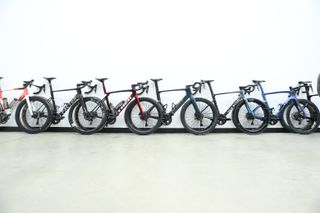
Our aim was to have a selection of high-end road bikes that offered a balance between what consumers might be looking to buy, and a reflection of the bikes seen in today's WorldTour peloton. We wanted a similar-level of bike from each brand, because although the aerodynamic difference between two groupsets will be negligible, we find that in some cases Dura-Ace / SRAM Red level bikes are specced with one-piece cockpits whereas cheaper models have two-piece bar and stem setups. The same goes for high-end wheels with bladed spokes.
Some of the bikes in the test are 'all out aero', such as the Cervélo S5 and the Scott Foil, whereas others fall more in the 'aero all-rounder' category, such as the Specialized Tarmac and the new Trek Madone.
Where brands offered both an aero model and an aero all-rounder, such as Cannondale with the SystemSix and SuperSix Evo respectively, we chose the bike that was more commonly raced in the WorldTour.
In alphabetical order, the bikes are as follows:
- Cannondale SuperSix Evo 4 Hi-Mod Team Edition
Canyon Aeroad CFR
- Cervélo S5
Factor OSTRO VAM
Giant propel advanced sl 0.
- Look 795 Blade RS
Pinarello Dogma F
Scott foil rc pro, specialized s-works tarmac sl8, trek madone slr 7 gen 8.
- Van Rysel RCR Pro Team Replica
- And our baseline: My own 2015 Trek Emonda ALR with box-section rims, rim brakes, external cables and round bars.
Each bike was a size 56cm or the brand's closest equivalent.
We were limited, to a point, by what we could get our hands on. For example, we wanted to include the Colnago V4Rs (for a Pogačar vs Vingegaard bike comparison), a Merida Scultura, the BMC Teammachine R, the Bianchi Oltre, the Enve Melee, the new Van Rysel aero bike, and others, but either the bikes were unavailable or our attempts to contact the brands went unanswered.

Sign up to the Musette - our subscriber-only newsletter
We took the bikes to the wind tunnel at the Silverstone Sports Engineering Hub, testing each one's aerodynamic performance, measured in Coefficient of Drag x Area (CdA).
This is quantified in metres squared, or M^2. The drag coefficient is effectively a definition of how easily air passes over an item's surface, and is largeley affected by the shape of the item but it can also be affected by surface material, and that's why many cyclists wear aero socks instead of bare legs. The area is quite simply the item's frontal area, or size.
We did this via two tests - the bike alone, and then with a rider (me!) - and we wanted to understand three things:
- Which is the fastest superbike? Of the bikes we were able to get our hands on, which would take the crown?
- Or are all modern bikes within such a tight margin that, as a result, you can effectively ignore aerodynamic claims when buying your next bike, and instead focus on other factors such as weight, comfort, spec and customer experience?
- How much faster are they than our baseline? Using my own entry-level 2015 Trek Emonda ALR to represent the age-old bike you've been riding for years or the entry-level model that ignited your passion more recently, we wanted to know how much you stand to gain by upgrading to a modern-day race bike.
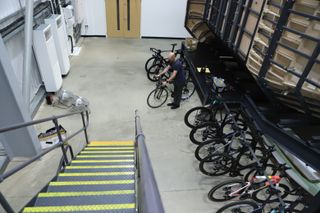
Present on the day were:
- Me - Josh Croxton - guiding proceedings as well as pedalling the bike in the rider-on tests.
- Tom Wieckowski - in charge of bike preparation and standardisation, ensuring the day could run smoothly.
- Sam Gupta - All the excellent photography you see here.
- Andrew Daley - the excellent video capture which will cover our social media.
- Max, Nick, Jack and Graham from Silverstone Sports Engineering Hub (SSE Hub) - in charge of running the tunnel itself, mounting each bike to the wind tunnel stanchions, and guiding the protocol, as explained below.
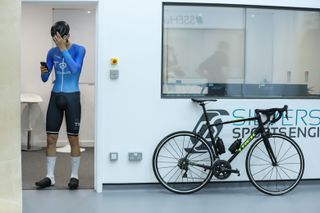
Our protocol
The protocol was designed by myself with guidance from the aero experts from SSE Hub.
We tested at seven yaw angles: -15, -10, -5, 0, +5, +10 and +15 degrees. Yaw, for the uninitiated, is just aerodynamicist speak for the angle of wind as it is experienced by the rider (and the bike, more pertinently). It takes into account the forward motion of the bike and rider, so the faster you ride the closer your average yaw will be to zero degrees, but by doing a spread we gather data for how well the bikes cope in cross-headwinds as well as a block headwind, or still day where your forward motion creates a zero degree yaw angle situation.
All tests were performed at 40km/h (24.85mph), representative of a typical amateur road race, a fast club ride, or a slow professional peloton (the 2024 Tour de France was raced at an average of 41.4kmh).
We began the day capturing at 30km/h too, to reflect a more all-day pace for well-trained amateurs, but soon realised we would run out of time to get through all of our bikes before the day was up. I also found that during the second sweep of rider-on testing, fatigue of holding the solid position would set in before the end of the test and the data would become less reliable. We decided to bin that 30km/h data and forge on at 40km/h only.
For the rider-on test, we tested for 30 seconds per yaw. We could have tested longer on each test, but found this was a nice sweetspot between a long enough capture to get trustworthy data, but short enough that fatigue didn't set and nullify the repeatability and allowed us to get through all the bikes in the allotted time. Cadence was held at a consistent rate of around 90 RPM.
For the bike-only test, we ensured the wheels were spinning at the correct speed; the behaviour of airflow over the rim and spokes is very different on a static wheel, and thus not representative of the real world. We tested for 15 seconds per yaw here. The data here is much 'cleaner' (there's no rider pedalling or having to hold a position) so better accuracy can be obtained without the need for longer captures.

Standardisations
The wind tunnel itself is designed to account for any changes in temperature or air density in its results. Prior to each test, the wind tunnel underwent a taring process, similar in principle to the tare on your kitchen scales or zero-offsetting your power meter to ensure accurate readings.
As always, we standardised as many variables as possible. This included the bike size, rider position, the front tyre, computer mounts, and where relevant, the bottles and cages on each bike.
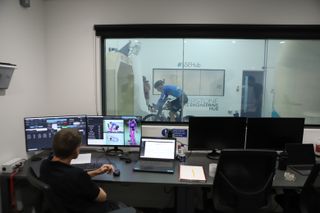
The wind tunnel also projects an 'edge' or an outline of my position from the baseline test from three angles (front-on, side-on and top-down) onto the floor, so that I could remain in a consistent position for subsequent runs.
Each test bike was a size 56cm, or the closest equivalent per the brand's geometry chart. Upon receipt, each bike was fitted to me, and positions matched to each other as closely as possible. More on this below.
We wanted to test each bike as closely to how a buying customer would use them in the real world, but with some concessions where necessary to ensure consistent testing.
We removed computer mounts from all bikes. We know that 95% of riders will run an out-front mount, but only around half of the bikes featured actually came with one. We didn't want some tested with and others without, so in the absence of an available mount for the remaining bikes, we ran them all without.
The Madone, Propel and Supersix were all designed with aero bottle cages, so we ran them for the test. The remaining bikes were all given Elite Vico Carbon cages and Elite Fly bottles - both a common sight in the WorldTour. Our thinking here is that if you buy those bikes and have those aero cages, you’ll use them. Therefore the aero performance of the bike with those cages is more relevant to you than without them.
The Factor OSTRO VAM also offers aero cages too, but sadly we couldn't get our hands on those in time for the test.
I kept the helmet on all day to ensure it was fitted consistently. I also marked my skinsuit position so it could be made the same again after toilet breaks.
This was calculated by testing the baseline Trek Emonda ALR at the beginning and the end of the day in identical setups.
There seems to be some discussion about the best way to then calculate the error margin from this. Some will take the average CdA from the entire sweep (all seven yaw angles) and calculate the difference between the two. If we took this approach, our error margin would have been 0.24% and 0.53% for the bike-only and rider-on tests respectively.
However, others compare each yaw angle individually and take the biggest of these differences. We chose to take this approach in the interest of offering fairer, more confident conclusions for our readers.
In addition, the following factors could affect the results:
- The handlebars fitted ranged from 38cm to 42cm, which meant my hands were in a slightly different position. Using the 'Edge' markings that Silverstone provides, I was able to roll my wrists inward or outward to standardise my riding position, and we were meticulous enough with our pre-test bike fit adjustments that I was able to offset the differences and hold myself in the baseline position well. We, and more importantly the team from SSE Hub, were satisfied that my body position was consistent across tests.
- The bike-only tests would also be affected by differing bar widths due to the increased surface area, but without the potential effect on the rider’s position. The effect is small when compared to the entire bike’s size and the drag coefficient of each constituent part hitting the wind (front on or downstream), but not insignificant.
- Holding each bike in place was a set of stanchions. No adjustments are made to account for them, given they're the same for all bikes and we're interested in the differences rather than the absolute values. However, an extra plate was added in order to mount the Pinarello due to its blind drive-side dropouts, reducing our confidence in the dataset for this bike. We still think the data will be interesting to our readers, so have chosen to share our findings as we have them. Canyon and Cannondale's bikes also feature blind dropouts, but both brands sent drilled-out bikes that could be mounted as normal.

Additional details and disclaimers
Cyclingnews does not claim that this data is the final word on the aerodynamic performance of the bikes featured, but rather an additional stream of independent, unbiased testing and information for our readers.
The results are simply representative of our day of testing. We hope that being clear about our method and our protocol allows readers to appreciate the data while also understanding the bigger picture.
The charts shown in the results below show the data with the error margins highlighted. For simplicity, when we report the CdA for each bike/test, we will do so as it came out of the wind tunnel to four significant figures.
With this data, we've done some calculations to solve for power (watts) and speed (km/h) at different power outputs. These calculations do not factor in additional losses such as drivetrain friction or rolling resistance, nor do they factor in the likelihood of experiencing such yaw angles at the given speeds. These are made to help our readers understand the potential impact (big or small) that CdA may have.
We have also included the weight of each bike. These are real weights taken moments before being sent into the wind tunnel in their ready-to-test state with pedals and bottle cages fitted.
We also understand that other factors come into play when buying a road bike, such as how it rides, weight, comfort, spec, tyre clearance, aesthetics, customer experience and more. The best road bikes for you will be a balance of those features alongside aerodynamics, each weighted per your preferences.
The results
Rider on bike results

Here you can see the CdA plotted against Yaw for each bike. The two lines that sit higher than the rest are the two runs we did on our baseline bike. This shows that all of our new superbikes have a lower drag coefficient than a 10-year-old alloy bike: A positive start!
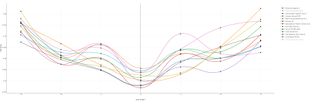
Removing the two baseline runs, you can see that the rest of the bikes are close to each other, with the lines overlapping at various points. At face value, this suggests that some bikes are more aerodynamic at certain yaw angles, while being slower at others.

However, when you add in our error bars, drawn from our confidence margin explained above, it becomes clear that the results overlap. We can't confidently conclude a stand-out winner here.

Using just the average CdA figures, this bar chart with the error bars overlaid shows things more clearly. Of the first 10 bikes, we can't confidently conclude an order. Besides knowing that the baseline bike is significantly slower, we can only really conclude that the Look Blade 795 RS is slower than the Specialized, Trek, Factor Cervélo and Canyon.

This graph shows the power required at 40km/h for each of the bikes. The Specialized Tarmac sits at 280.2 watts (+/- our error of 3.91 watts).
The Look Blade 795 RS is at 286.29 watts, again with the same 3.91-watt leeway. Factoring in that margin, the difference between our superbikes could be nothing at all, but it could be as much as 13.91 watts.
The baseline Trek Emonda ALR came out at 304.67 watts. Factoring in that margin again, the S-Works Tarmac is at least 16.65 watts faster than the baseline but could be as much as 32.29 watts faster.
Bike only results
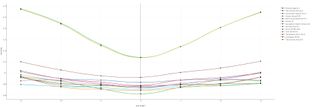
As with the rider-on-bike data above, we can see that most of the race bikes sit in a cluster together, while the two baseline bike runs sit significantly higher. This shows that the race bikes are generally more aerodynamic than the baseline. Another good start!
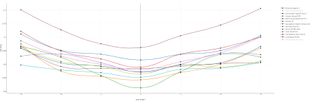
However, with the two baseline runs removed we can see that, unlike the rider-on-bike data, the remaining lines have a bit more consistency. By this, we mean that a bike that is faster at a given yaw is commonly faster at other yaw angles too. There are some instances of lines crossing over, but the data appears cleaner.

And here, with the error margin added in, we can see that although there is still some crossover, we can confidently conclude that some of the bikes are faster than others, and that the Look is markedly slower. We still can't quite tease out an outright winner, but we can be confident in saying the Cervelo S5 is fast at zero yaw, adding more drag in the crosswinds, whereas the Factor OSTRO tends to be less quick at zero yaw, but performs well across the full sweep.

And here with the average CdA across the full sweep for each bike, and showing the error bars again, we can conclude that the Factor OSTRO VAM is fastest, with an average CdA of 0.0882 (+/- 0.0010).
However, the Scott Foil and Cervélo S5 were close enough (at 0.0897 and 0.0900 respectively (+/- 0.0010)) that they fall within our margin of error, so they too can lay claim to victory.
The Canyon Aeroad and Cannondale SuperSix sit close behind, within 0.0004 m^2 of each other, and therefore can both lay claim to 2nd place.
The Pinarello Dogma F and S-Works Tarmac sit a little further back, but can both lay claim to a podium finish when our margin is factored in.
The Van Rysel RCR Pro, Giant Propel and Trek Madone all sit mid table, while the Look Blade 795 RS is further behind. All bikes are significantly faster than our baseline, with its CdA of 0.1370.

We know that bikes cannot pedal themselves, but for comparison, this graph shows the power required at 40km/h for each of their respective CdA figures above.
The Factor OSTRO VAM lands at 72.59 watts (+/- 0.85 watts).
Our slowest superbike, the Look Blade 795 RS, sits at 84.95 watts with that same 0.85-watt margin.
The baseline bike's best result was 112.74 watts, but when you factor in that margin, you stand to save between 38.45 and 41.85 watts.
It's worth remembering, however, that this is a reflection of bike-only data. Given the bike is only a fraction of the total CdA a cyclist will have, the effect will be reduced, hence the smaller difference outlined in the rider-on-bike data above.
The conclusions
Which bike is the fastest.
Although the Specialized Tarmac came out on top in our rider-on-bike test, closely followed by the Trek Madone and the Factor OSTRO VAM, our margin of confidence means that on another day, any of the bikes could have landed on top.
It is therefore difficult to draw any meaningful or confident conclusion as to the fastest bike.
What's more, at each different yaw angle, the order flip-flops quite a lot, further suggesting our variability is greater than the difference between each bike. While our margin is reflective of typical rider-on-bike data, when combined with the other considerations and the tightly packed results, we're unable to confidently say that any one bike is the out-and-out fastest. Therefore, if considering which one to buy, we would look at other factors such as weight and ride quality.
From the bike-only data, the results appear cleaner, with more consistent results across the seven yaw angles. The top of the table is packed with the more dedicated aero bikes such as the Factor, Scott and Cervelo, but the more 'all-rounder' bikes hold their own well at around 2-5 watts behind.
Taking into account an unweighted average CdA at the seven yaw angles, the Factor Ostro was the fastest in this test, but when factoring in our margin of error, it could finish as low as 3rd. That's still a very impressive result given it was also the second-lightest on the day at 7.23kg.
However, you could argue that the Cervélo S5 would actually be the fastest in the real world due to its low-yaw performance. At 40km/h you are more likely to experience lower yaw angles due to the onrushing wind.
The Cannondale SuperSix Evo also performed well for an 'all-rounder', and although it landed in 5th on the day, given our CdA error margin of 0.0010, it could finish as high as 2nd.
The only bike to sit outside of the ballpark is the Look Blade 795 RS at around 12 watts behind.
Our baseline Trek Emonda sits at a further ~28 watts back, or around 40 watts behind the OSTRO VAM.
To answer our earlier question of whether modern bikes are all within such a small margin that you can ignore the aero claims made by manufacturers, the answer is... sort of! We might have been unable to confidently conclude which bike is the fastest, but we were able to find the slowest, and all of our superbikes were a marked step above the baseline.
With that in mind, you cannot ignore aerodynamics entirely when buying your next bike. Given the rider-on difference between the best and worst race bikes here could be as big as 13.90 watts, you still stand to lose speed if you buy the wrong bike.
How many watts can you save vs your old bike?
If we're happy to accept that our baseline Trek Emonda from 2015 is representative of your generic old bike , then the savings can be anywhere between 16.65 and 32.29 watts when compared to the fastest on test.
Even at a more attainable solo ride pace of 30km/h, you stand to save between 7.03 and 13.62 watts.
However, if you extrapolate the data to 50km/h, the saving grows to between 32.54 and 63.05 watts, but it's worth saying you're unlikely to be able to hold this pace fore more than a few minutes without drafting in a group, where the aerodynamic requirement becomes lessened.
It's also worth noting that there are cheaper ways to save this many watts. You could buy an aero helmet, a skinsuit, some new wheels and improve your position for significantly less than even the cheapest bike on this test, but if you're looking for a reason to spend the money, you now have one. You're welcome.
Results and data for each individual bike
We have ordered this section by the average (unweighted) CdA from the seven yaw angles from the more reliable bike-only test data. Starting with our baseline, we will work down from the least aerodynamic to the most, as the results came out of the wind tunnel.
For each bike, we will list the unweighted average CdA from the seven yaw angles in each test individually, along with an accompanying line graph.
We will then use it to calculate the power required to ride at 40km/h (24.85mph) using the following calculation, where velocity = metres per second.
Power (watts) = 0.5 x AirDensity x CdA x Velocity^3
We will also calculate the time taken to ride 40km at a steady 250 watts, using the following calculation:
Speed (km/h) = 3.6 x ((Power / (0.5 x AirDensity x CdA)) ^⅓)
For both, we will use a consistent air density of 1.2kg/m3.
We will report both as a delta (the difference) against our baseline bike.
Baseline: Trek Emonda ALR 2015
Specifications.
Average CdA 0.3702
Power at 40km/h 304.67
Time to cover 40km at 250w 01:04:05
Average CdA 0.1370
Power at 40km/h 112.74
Time to cover 40km at 250w 00:46:01
The baseline bike for our test is my very own bike. I bought it in around 2017 as a winter training bike. It served me well for around three years, but ever since I started at Cyclingnews, it has been in retirement as other test bikes took precedence.
The reason for using this bike is twofold. First, it's ours - we can keep it in this exact state and bring it back to the wind tunnel in future tests and hopefully be able to compare future test data to the data featured here.
What's more, we think it loosely represents Your Generic Basic Bike. So you can get a feel for how many watts you're likely to save by upgrading from a basic bike to an aero-optimised race bike.
Look Blade 795 RS
Average CdA 0.3478
Watts saved at 40km/h 18.38
Time saved over 40km at 250w 00:01:19
Average CdA 0.1032
Watts saved at 40km/h 27.79
Time saved over 40km at 250w 00:04:09
At 7.75kg, it's not the lightest here - the S-Works Tarmac is over 500g lighter - but it certainly isn't the heaviest. However, it is the slowest of our superbikes in terms of drag, coming in last place in both tests.
That isn't conclusive in the rider-on test with our margin of error taken into account, but in the bike-only test, it was slower than every other bike at each of the seven yaw angles tested.
With that said, it was still significantly faster than our baseline bike, and our Look 795 Blade RS review shows there's more to a bike than just aero stats. With a rider on, you'd still stand to save between 10.57 and 26.19 watts by upgrading. It is also perhaps worth noting that Look itself states 'efficiency' was the goal for this machine rather than simply aerodynamics, and a few watts were willing to be spared in the name of useability.
Average CdA 0.3438
Watts saved at 40km/h 21.67
Time saved over 40km at 250w 00:01:33
Average CdA 0.0959
Watts saved at 40km/h 33.81
Time saved over 40km at 250w 00:05:09
By definition, the Propel is Giant's dedicated aero race bike, sitting alongside the pure featherweight TCR.
Hampered somewhat by the UCI's 6.8kg rule, the TCR was launched this year with a primary focus on better construction and improved aerodynamics, while the Propel launched last year aiming to be more of a one-bike solution, shedding weight in the process. They seem destined to merge in the coming years.
With that said, Giant designs its bikes with a pedalling mannequin, (rightly) arguing that bikes don't pedal themselves, so you should bear that in mind when reading the bike-only results shown here.
Average CdA 0.3406
Watts saved at 40km/h 24.31
Time saved over 40km at 250w 00:01:45
Average CdA 0.0954
Watts saved at 40km/h 34.19
Time saved over 40km at 250w 00:05:13
The latest Madone is the result of Trek's decision to merge its lightweight Emonda and aero Madone models into one bike, and although it uses slimmed down tubes, Trek says it actually outperforms the outgoing aero-first Madone in the wind tunnel.
Trek admits that this is thanks in large part to the aero bottle cages, but we can't dispute the argument that if you have them, you'll use them. That's why we ran them for this test.
Like the Propel above, the Madone is another that fared better with a rider on than without.
Van Rysel RCR Pro
Watts saved at 40km/h 21.69
Average CdA 0.0936
Watts saved at 40km/h 35.70
Time saved over 40km at 250w 00:05:29
First up, I must apologise for claiming that a £9000 bike is anywhere near a budget-friendly. I appreciate that's still an inordinate amount of money for a bicycle, but as a brand, Van Rysel is building its reputation on price.
The brand was sprung into the spotlight when its parent company, Decathlon, became the title sponsor of French WorldTour team, Decathlon AG2R La Mondiale.
And compared to the competitors here, it is the value option. With a top-tier Dura-Ace groupset, the Van Rysel is £299 cheaper than the next-cheapest equivalent-spec bike, the Aeroad CFR from direct-to-consumer brand Canyon.
The Trek Madone does actually come in cheaper, but the bike we managed to source was the Force AXS equipped, rather than the top-tier Red AXS.
Despite that price difference, it's well within the aero and weight ballpark. It is in the bottom half of a tightly-packed aero table, and weighs just 7.54kg.
Average CdA 0.3404
Watts saved at 40km/h 24.47
Time saved over 40km at 250w 00:01:46
Average CdA 0.0917
Watts saved at 40km/h 37.23
Time saved over 40km at 250w 00:05:45
The Specialized S-Works Tarmac SL8, complete with new SRAM Red AXS groupset here, made headlines at its launch in 2023 when the protruding head tube was dubbed the 'speed sniffer'.
The Tarmac is arguably the bike with the biggest fan base in this list, perhaps even the world. Evidence of that came a week prior to its launch, when, such was the appetite to know about the impending new bike, that almost of all of Specialized's marketing material was hacked and leaked.
It is the lightest bike on this list at 7.18kg with pedals and bottle cages, but it was outperformed in the aerodynamics stakes. It landed in at 7th in our bike-only test, but with the error margin taken into account, it can lay claim to as high as 3rd place.
Average CdA 0.3444
Watts saved at 40km/h 21.24
Time saved over 40km at 250w 00:01:32
Average CdA 0.0915
Watts saved at 40km/h 37.47
Time saved over 40km at 250w 00:05:48
The Dogma F launched just ahead of the 2024 Tour de France, claiming to be 108g lighter - just under half of which came through a new cockpit - as well as a longer wheelbase, 30c tyre clearance, and a 0.2% improvement in the drag coefficient. For context, that's around 0.00027kg/m^2 difference in CdA, or around 0.28 watts at 40km/h.
In our tests, we were forced to mount the Dogma F using an additional plate due to the closed or 'blind' dropouts. This could have added a small amount of drag, but we can't be sure exactly how much.
The Dogma was also one of the lighter bikes in our test, tipping our scales at 7.20kg on the nose.
Cannondale SuperSix Evo 4
Average CdA 0.3442
Watts saved at 40km/h 21.37
Average CdA 0.0905
Watts saved at 40km/h 38.28
Time saved over 40km at 250w 00:05:57
I know this page is all about scientifically proven data, but allow me this one opinion: The SuperSix Evo 4, in this colourway, is the best-looking bike of the bunch.
Unfortunately you can't actually buy the exact bike we tested. We got our hands on one of the team-edition Hi-Mod bikes with the Dura-Ace groupset.
The closest we could get as a consumer is buying the Lab71 model with SRAM Red, at an eyewatering £12,500.
Regardless, the SuperSix landed a fairly decent result given it's not even Cannondale's dedicated aero bike (that claim goes to the SystemSix). It came out 5th in our bike-only test, but with the margin of error, it can lay claim to 2nd place. That margin goes the other way too, though, so it could also be as low as 7th.
Average CdA 0.3428
Watts saved at 40km/h 22.54
Time saved over 40km at 250w 00:01:37
Average CdA 0.0904
Watts saved at 40km/h 38.31
At the launch of this latest Aeroad, Canyon found it was faster than the Tarmac SL8 on average, and faster than the Cervélo S5 at higher yaw, with the Cervélo edging slightly ahead at zero yaw. Our raw data agrees, but due to our error margin, we cannot guarantee that it wasn't simply a result of a change in conditions throughout the day.
The Aeroad CFR offers excellent value when compared to the rest of the bikes here. It might be a few hundred pounds more than the Van Rysel, but with its width-adjustable handlebars and height-adjustable cockpit (that doesn't need you to cut the steerer tube in the process), it will save you from possibly needing to buy a separate cockpit once you've had a bike fit.
It is Canyon's dedicated aero bike, sitting alongside the more lightweight Ultimate CFR. Despite that, it weighs about the same as the Look Blade 795 RS, or around 740 grams less than the Force-AXS equipped Cervélo. Like Giant's Propel/TCR combo, we also predict these two will merge in a few years.
Also like Giant, Canyon designs the bike with a pedalling dummy it calls Ferdie, and as such, you should bear that in mind when reading the bike-only results shown here.
Cervélo S5
Average CdA 0.3418
Watts saved at 40km/h 23.38
Time saved over 40km at 250w 00:01:41
Average CdA 0.0900
Watts saved at 40km/h 38.66
Time saved over 40km at 250w 00:06:01
The Cervélo S5 is unashamedly a dedicated aero bike, with its v-shaped cockpit, deep tubes and rear-wheel-wrapping seat tube. As a result, it's no featherweight.
That's a slightly unfair assessment given the bike we have here is Force-AXS equipped, rather than Red, but it still tips the scales at 340 grams more than the similarly-specced Madone.
Found beneath the Visma-Lease a Bike team, the S5 has crossed many a finish line in first place, although the team's two-time Tour de France winner, Jonas Vingegaard, often reaches for the lighter-weight R5 on hillier days.
In our bike-only test, the S5 is one of just three bikes that can lay claim to 1st place, once our margin of error has been factored in. However, given that it goes both ways, it could also drop to 7th.
Average CdA 0.3441
Watts saved at 40km/h 21.48
Average CdA 0.0897
Watts saved at 40km/h 38.90
Time saved over 40km at 250w 00:06:03
Although the rumourmill is telling us that a new Scott Addict 'all-rounder bike' should be launching in the not-too-distant future, we're yet to see anything beneath the riders at the brand's sponsored WorldTour team, DSM-Firmenich-Post NL. Their race bike of choice continues to be the Foil aero bike.
At 7.87kg, it's not going to trouble the UCI minimum weight rule anytime soon, but that's less of a concern given its main concern is going fast on flatter terrain. If our results are anything to go by, it should do that well, as it landed in 2nd place.
With our error margin, it can lay claim to 1st place, but as that goes both ways, it could also fall as low as 7th.
Average CdA 0.3407
Watts saved at 40km/h 24.25
Average CdA 0.0882
Watts saved at 40km/h 40.15
Time saved over 40km at 250w 00:06:17
The fastest bike in our bike-only test, the Factor OSTRO VAM is also the second lightest, just 50 grams heavier than the Tarmac SL8. With our error margin factored in, it is still guaranteed a podium finish, only the Cervelo and the Scott can usurp it; an impressive result for a comparatively small brand.
Unfortunately, we were unable to get hold of the aero bottle cages that the bike will traditionally ship with, so for anyone buying it, it might be even faster.
I recently interviewed the brand's founder and CEO, Rob Gitelis , who spoke of his own career, how Factor came to be, and his loyalty to his employees through the tough COVID period.
Given the performance of this bike, that loyalty is seemingly paying off.
The takeaways
There we have it, 11 superbikes plus my old winter bike as a baseline comparison.
We've drawn out the conclusions above, highlighting some interesting differences in the bike-only tests, as well as concluding that the differences are small enough with a rider on that modern bikes are all within a ballpark, but that ballpark still stands to save you a good few watts against a budget-friendly bike.
Or to put it another way, you can save watts by upgrading your bike, but when it comes to deciding what to upgrade to, other factors such as weight and ride quality are more important than the one or two watts you might (or might not) save.
With these conclusions in mind, what have we learned?
1. Aero isn't everything
Despite aerodynamics (rightly) taking precedence when comparing bike performance, one thing we can learn here is that once you are confident that you are in the ballpark, you can focus your attention elsewhere.
Whether that means you focus on weight, spec, or simply the bike you like the colour of most, it doesn't really matter. You do you.
2. Buy a new helmet first
This isn't the first time we've been to the wind tunnel to test cycling tech. You might recall that we went to a wind tunnel in May to test road bike helmets , and back in 2022 to aero test road wheels .
The winner of our helmet test was the POC Procen Air, which saved 12.76 watts against the slowest on test at 40km/h.
The winner of our wheel test was the DT Swiss ARC 1100 Dicut, at 62mm deep. Compared to the slowest on test, they would save you 3.87 watts at 40km/h. The caveat there is that the 'slowest' were still high-quality aero wheels from Reserve.
As the data came out of our wind tunnel (ignoring our margin for a second), the difference between the Tarmac SL8 here and our baseline Emonda is 24.47 watts (with a rider on) but when compared to the least aero of the new bikes, the Look Blade 795 RS, the difference is much less, at just 6.09 watts.
It's worth noting that somewhere around 3-4 watts is about as little a difference in wattage as it's possible to 'feel', and this is only in the context of something back to back like switching a dynamo powered light on or off.
Given a new helmet will cost you three figures, whereas a bike and wheels will cost you four, that's where we'd spend our money first.
As always, the gains on the table are totally dependent on what you're starting with, so common sense shall prevail. Or you could treat yourself and upgrade everything!
3. You don't have to be a pro to ride a fast bike
The watt savings here have been calculated at 40km/h for reasons outlined above, but we can extrapolate the CdA to different speeds to calculate the savings.
Most keen amateurs will be able to hold 30km/h for extended periods of time, and the difference on offer here at that speed is still significant. Upgrading from the Trek Emonda ALR to the fastest bike on test, you stand to save between 7.03 and 13.62 watts.
To round off, I wanted to end this feature with a few thank yous to those who helped make it possible.
Each of the brands featured : For the loan of the bikes shown
Silverstone Sports Engineering Hub : For their guidance on protocol, running the wind tunnel for us, and for spending the evening prior to the test working out how to mount the Pinarello Dogma F, with its blind dropouts, so we could make the most of the following day's testing.
Special thanks to Canyon , who sent its drilled-out Aeroad used in its own wind tunnel testing, to help us get around the blind dropouts.
Special thanks to Cannondale , who shipped the brand's drilled-out fork overnight from the USA to the UK, to help us get around the blind dropout.
Madison UK : For the loan of Elite Vico Carbon bottle cages and Elite Fly bottles.
Continental Tyres : For the loan of GP5000 S TR tyres.
If you subscribe to Cyclingnews, you should sign up for our new subscriber-only newsletter. From exclusive interviews and tech galleries to race analysis and in-depth features, the Musette means you'll never miss out on member-exclusive content. Sign up now .

This is subscriber exclusive content and can only be viewed if you have an active subscription with us.
Join now to access our subscriber exclusive content and have unlimited access to all our usual content with no limits
Enjoy your first month for just £1 / $1 / €1
*After your trial you will be billed £4.99 $7.99 €5.99 per month
Join now for unlimited access
Try your first month for just £1 / $1 / €1
Josh is Associate Editor of Cyclingnews – leading our content on the best bikes, kit and the latest breaking tech stories from the pro peloton. He has been with us since the summer of 2019 and throughout that time he's covered everything from buyer's guides and deals to the latest tech news and reviews.
On the bike, Josh has been riding and racing for over 15 years. He started out racing cross country in his teens back when 26-inch wheels and triple chainsets were still mainstream, but he found favour in road racing in his early 20s, racing at a local and national level for Somerset-based Team Tor 2000. These days he rides indoors for convenience and fitness, and outdoors for fun on road, gravel, 'cross and cross-country bikes, the latter usually with his two dogs in tow.
Redshift Switch Aero System and ShockStop stem review: Odd on their own, but transformative together
Look X-Track Power pedal review: Testing Look's $1,000 dual-sided off-road power meter pedals
UCI MTB World Championships - Isabella Holmgren wins XCC U23 women rainbow stripes
Most Popular
All-new Trek Emonda ALR takes lightweight frame tech to alloy models
- Click to share on Facebook (Opens in new window)
- Click to share on X (Opens in new window)
- Click to email a link to a friend (Opens in new window)

When Trek announced their Emonda carbon road bike line , they backed up their “world’s lightest” claims with an impressive frame and fork and an even more impressive 10.25lb (4.6kg) complete bike. Now, they’re adding an alloy Emonda ALR option that’s also lightweight yet far more affordable.
To earn the Emonda badge, the frame uses their top-level 300-series Alpha Aluminum that’s been hydroformed into size specific tubes, then welded together using a no-see technique that produces smooth joints that use less material to save weight.
The process is called Invisible Weld Technology, which they say produces stronger, stiffer welds despite using less material. Video, pics and more details below…
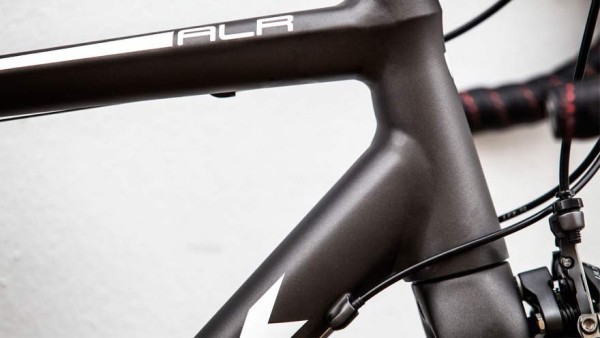
Trek told us the unpainted frame is 1050g (56), and a painted fork is 358g w/240mm steerer.
Like the ultralight Emonda carbon models, the ALR uses their H2 race geometry, E2 tapered headtube (standard 1-1/8″ to 1-1/2″) and wide Pressfit BB 86.5, meaning this bike is made to go fast. Other frame details include a braze-on front derailleur mount (no need to add a clamp if you’re getting the frameset) and external cable routing.

We’ve requested a more technical description of the welding process (update as we get it), but the frame is only part of the story. The complete bikes come equipped with built-in extras like the a Blendr stem with integrated light/computer mount, and it has Duotrap S compatibility (their ANT+/Bluetooth 4.0 speed/cadence sensor, sold separately for about $60).
You also get a complete group, so the Emonda ALR 6 with Ultregra gets a full Ultegra group from chain to brakes to cassette and everything else. There are no mis-matched parts or down spec’d bits to cut costs. A full carbon fiber tapered fork completes the package.
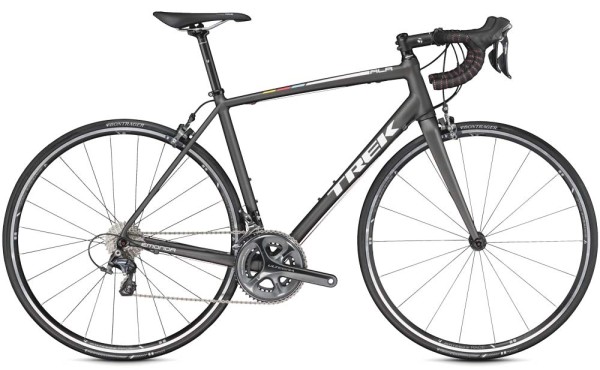
The Emonda ALR will initially come in two builds, the “6” with full Ultegra, Bontrager Race tubeless ready wheels with R2 tires, and a Bontrager cockpit with alloy short reach/drop bar and carbon seatpost for $2,249.99. Our local Trek Bike Store says complete bike weight is claimed at 17.25lb (7.82kg).

The Emonda ALR 5 drops down to a full Shimano 105 group with non-series Bontrager tubeless ready alloy wheels, R1 tires and a full alloy Bontrager cockpit for $1,759.99. Claimed weight is 18.77lb (8.51kg), colors will be the gloss black/hi-viz yellow and blue shown here, plus a racing red coming soon.

The frameset shares the same paint scheme as the “6” and comes with an FSA sealed cartridge bearing headset for $989.99. The frames have a lifetime warranty carrying a 275lb rider weight limit.
Just for fun, here’s the companion lifestyle video.
All three models shown here are available now and should hit stores soon. Our sources tell us there’ll also be an Emonda ALR 5 with Tiagra, an ALR 8 with Dura-Ace mechanical and ALR 9 with Dura-Ace Di2 coming soon. That last model suggests they’ll have an electronic-only frame, too, since these first models only have external cable routing. At the very top, in terms of light weight anyway, will be the ALR 10 with a full SRAM Red group.
TrekBikes.com
Tyler Benedict is the Founder of Bikerumor.com , where he’s been writing about the latest bikes, components, and cycling technology for almost two decades. Prior to that, Tyler launched and built multiple sports nutrition brands and consumer goods companies, mostly as an excuse to travel and ride in new places.
Based in North Carolina, Tyler also loves the Vanlife & family adventure travel and is always on the lookout for the next shiny new part and off-grid adventure.
This site uses Akismet to reduce spam. Learn how your comment data is processed .
looks like a rebadged Allez
The invisible welding looks a lot like what pretty much every other company calls smooth welding. And has been using for years. You weld the tube normally then go back over it without filler material and “reweld” it. The process smooths out the weld and helps it wet out. REVOLUTIONARY TREK!!!
Interesting that they are using hydroformed tubes but didn’t choose the aero tube shapes of the Madone design.
@Robert W – my sources say the Madone is on the way out. & if the story is about weight vs. areo it would make sense to mimick the emonda shapes. Also, the 2 series aluminum frames are already Madone-esqe.
I always find it funny that companies state how they’ve extensively optimized tube shapes for their flagship carbon fiber bikes, but then seemingly can successfully apply those shapes to materials with very different properties. There is a little marketing lie in their somewhere.
Anyway. Glad to see these Al bikes. CF has been getting too pricey fort me.
I like how they quote an unpainted frame weight, then only offer it in a painted variety. But lets also make sure we pair that unpainted weight with a painted fork weight.
Looks legit. Seeing they are coming out of the Giant factory why not put on the overdrive 2 fork and stem and really take it next level?
Aluminum, how quaint.
Why not sell them unpainted if they weight them unpainted? JBikes if I read you right what your saying is the shapes have far mo9re to do with design than engineering.all thes tube shapes are probaly coming from kitchen appliance design firm and they bs riders who rarely go over 20mph that aero is worth buying a new bike for
That Bontrager cycling kit is pretty damn nice. “Understated” as the hipsters like to say.
How about US made aluminum, with giant tubes, some internal routing, and some really funky paint jobs. Oh wait…
Hasn”t specialized already been doing this for like 3 years now? And better welded joints? Revolutionary-nothing is more like it, just another slightly modified copy frame.
Roy – no I was just commenting on the fact it’s stated how non aero tube shapes are optimized for carbon fiber for whatever properties (stiffness, weight, ride) but then a vastly different material can achieve the same with the same tube shapes? I’m sure they vary material thickness and such, but given the vast difference in CF and Al, I’d think tube shapes would vary more between the two materials, unless the CF and Al frames ride completely different.
Jesus, tough crowd. Lightweight aluminum, full component groups and small price tags… Sounds good to me.
Full Ultegra! Well… except the wheels. Of which, the Bontrager Race spec is a few notches below Ultegra…
y’all are haters. you can pick on the marketing and on random bits and pieces but in the end this is the bike you’re going to start seeing at all the local crits and races. So they have weird marketing, worry about the bike and what it can do for you.
Aluminum is the new carbon.
Yeah a bunch of haters here, Go buy a Specialized because they are not owned by the big man, Oh wait, Specialized is own by a conglomerate, and Trek is family owned. Seems like most people don’t understand the definition of “the man” Don’t hate on them just because you don’t like it that more people ride Trek than any other brand in the US.
@Durianrider, you’re killing me! Lol
When you think about it, it’s a bike people actually look for: Workhorse, and the no-nonsense but clean aesthetic.
Considering the Propel SLR might not come stateside, as well as the update TCR SLR before it, it’s nice to have another potential alloy option on the market that isn’t an Allez or CAAD.
I really like where Trek is going with their new paint schemes. Very minimal branding and no stupid racing stripes and decals. Keep it premium!
Jbikes: I understand why you’re asking about why two frames with different materials have the same tube shapes, but in fact they probably should have the same shapes.
In the bike industry (and many others), it’s common practice to design using isotropic material properties (e.g., with aluminum) for a first pass. The resulting stiffness (quantified through FEA) ensures you’re getting the most sectional modulus you can out of a given tube shape. Only then do you go back and design a laminate schedule with anisotropic materials (e.g., carbon fiber).
This allows the designer to clearly separate the modulus (stiffness) due to tube shape and the modulus due to the laminate schedule. That way, each can be optimized as a discrete step.
Except for a few corner cases, optimal frame tube shape is material-independent. Surprising but true!
Looks like a great bike at a good price. I love nice aluminum race bikes. But why no H1 geometry option? It irks me that companies (not just Trek) spec the really race oriented stuff at the high-end of the price scale. I know a short head tube doesn’t work for everyone but why not give us the option? What does the size of your wallet have to do with your flexibility?
I’m wondering if some of the frames are anodized, so unpainted weight would be pretty relevant.
JasonK – thanks! Great info. Never really thought of it that way but it makes sense.
I like the emonda and the CrossRip frame for my commuter. I would seriously consider if I was in the market and carbon was not an option.
Man that’s a light frame. Nice to see they are using full groupset specs.
I wonder if the welding is a form of aluminium brazing using a lower melting temperature brazing rod. I think this is what Shimano do with the external reinforcing tabs on the aluminium rims. This is supposed to be lower strength than welding but coming up with some newer technology is not beyond Trek’s resources. Or maybe they have come up with a way to modify the pulse action of a TIG welder with a certain filler wire application. Either way, the old double pass method for aluminium is old hat now.
Most companies claim unpainted frame weights. Use this general guide: If a company says “…painted frame weight is…” then it’s including paint. If they don’t specifically say painted then you can guarantee it’s an unpainted frame weight.
The only reason I wouldn’t buy one of these is the head tube is too tall…
I applaud Trek for coming out with a ‘light’ and ‘inexpensive’ aluminum frameset but I’m still not sold on the H2 geometry.
Sincerely, Worlds longest head tube.
I like the option of a high end aluminum frame as well….but this one misses the mark for me because trek refuses to make any bike with its “racer” H1 geometry that doesn’t cost at least 4,500 for a frameset. If they only would make H1 options of their emonda sl frame or this new all I’d buy one in a second. Trek already makes a million bike models….why not better fit options? Ever since they did away with the 6 series madone the options for the budget conscious racer have gone to zero. Bleh. And more seatmast length options trek!
Nearly the same weight as a Cannondale frame that was first manufactured out of the same material about 6 years ago
I think this will make a GREAT race frame.
Certainly beats trying to replace a carbon frame someone broke for you in that ‘last corner of the criterium’ crash.
If I see one more I’m-so-flexible-I-can-stick-my-head-up-my-ass comment about the lack of H1 geometry, I might give up trolling comments on bike rumor all together. Seriously, 5 years at a Trek dealer and we sold maybe 3 H1 bikes (all as special order). We ordered dozens more project 1 bikes in the ‘normal’ H2. Working now at a Cervelo dealer I have very few people balk at the head tube height, and MOST are running a positive angle on the stem anyways. At 6’3″ I run 14cm of bar drop. I have had zero issue getting a proper fit on stock bikes, including Trek. Currently on the newly updated (i.e. market norm) stack of the 2015 Cervelo S5 I still have 15mm of spacers under my stem. If H2 geo just doesn’t do it for you, grab a Cannonade with a low profile headset cap and go ride. They are making a bike for the largest market, obviously the budget racers this bike is designed for are too busy riding their bikes to complain on Bike Rumor…..
Looks like a great bike for the money and your avg rider. Nothing wrong with that. Kudos too for specing a complete group build, awesome!
Waiting for my ALR 5 to arrive!! Last bike I bought was in 1986, a Myata One Ten. Hopefully this one will last another 29 years.
uhhh… the allez actually looks good
http://www.specialized.com/us/en/bikes/road/allez/allez-comp-race
the only thing actually missing from these frames are some colorway options like the tarmacs
i had a domane and the headtube was too tall.
i might get one of these. its pretty affordable all things considered.
There doesn’t seem too much, if anything at all, to complain about here. The Emonda ALR frame MSRP is right in line with a CAAD10 frame MSRP ($10 cheaper actually). It looks good, and it’s certainly not a heavyweight bike. If it rides as good as it looks, it will be a great deal.
@MikeC – Are you kidding? I haven’t seen anyone refer to a full groupset as including the wheel since like 1999. Some people are just desperate to find something to bitch about. The Bontrager Race wheels are great. They only weigh 200g more than the Ultegras, and unlike every Shimano wheel, they are specced completely with off-the-shelf parts that are easily purchasable in any bike shop.
@Adam – Yes, because Cannondale were the first company with an aluminum racing bike. You forget the Trek, via Klein, were making awesome lightweight aluminum race bikes when Cannondale was still welding together soda cans.
@H1 Lovers – You’re all on crack. A quarter of the Trek pros don’t even ride the H1, and I promise you that you are not that fast. I can also tick off a list of local heroes, Cat 1 and PRO dudes, who get by just fine on the H2, usually preferring it to the H1.
@Psi – And the Trek is clearly much better specced than the Cannondale, with an Ultegra crank and Bontrager Race wheels, not to mention a cockpit that won’t require immediate replacement.
Wait to you see the next gen cannondale frame before you jump on this..
I am happy this exists. Buyers beware if you crash this thing it’s probably going to dent up like tinfoil.
@badbikemechanic – What makes you say that? There is a generation of high end aluminum out there that holds up just fine to the rigors of daily life. I personally have an aluminum Allez that I regularly leave locked up outside of bars, the grocery store, as well as race, and it hasn’t even scratched the anodized finish yet.
As always, opinions abound….and everyone is “right.” The H1 vs. H2 debate is clearly a hotter topic than I thought. What it boils down to though is “choice.”
Trek offers the option, meaning there are people that prefer it. I rode a 60 cm H1 Madone 6 series last year, and absolutely loved it. Sadly it was a team bike and I had to give it back at the end of the year. In looking for a replacement I want a bike with similar geometry, but don’t want to spend 4,500 to have the OPTION to get the geometry I like. The head tube on the H1 is 18 cm…compared with 21 cm on the H2. That is a LARGE difference. I don’t think anyone is right or wrong to ride whatever geometry they like. All I’m saying is that for me…the H1 geometry is perfect, and I don’t need to run a -17 stem to get my preferred position of the bike. Being a pro, being fast or slow, is irrelevant. I would just like to see the option available at a reasonable price point.
These bikes are epic. And yes, they blow the competition out of the water.
About time Trek offers something for the Joe-Racers out there. Yes, carbon is super nice but you guess what: so is aluminum. I have a locally-made Aluminum bike and it rides *amazing*. So did my old Caad7 and I bet Specialized’s aluminum bike is also fantastic. We need more people in the sport, and to do that we need a much lower entry-level bar. if for $2,200 you get a nice Al Trek with good geometry, good wheels (i own the bontis tlr and they’re indestructible and readily serviceable), good parts and cockpit that are either race-ready or hammer-ready, then god bless Trek. For the record i own a cannondale six and it’s a phenomenal bike. but my aluminum rig is my favorite. way to go, Trek – kudos indeed.
Arguing that “some pros ride H2, therefore nobody needs H1” is well, just a poor excuse for an argument. An H1 aluminum Emonda would be a hit, and I would purchase one as soon as it were available. I’ve owned and ridden both H1/H2 models, and greatly prefer the H1. As an aside, direct mount breaks on this beast would be the icing on the cake. Think about it Trek.
This bike compared with the new caad 12 is nothing …
I’ve got a current model year Allez smartweld frame built up with full 105 and tubeless Shimano wheels. I certainly didn’t do it for $1760 retail, but then some parts on my bike (bars, saddle, tires) are from a very much higher trim level. I’ve also got all the accessories (cages, tools, &c) in my price, and I was unable to use the economy of scale a manufacturer can.
ANYWAY. The ride quality of my Allez is nothing short of amazing considering. It is *as smooth* as my steel 3-speed with 38mm tires over brick roads. I have no problems riding the Allez a hundred miles, though I run out of water. The Allez smartweld is making me completely re-think aluminum as a frame material, especially for amateur racer types.
These Treks seem to DIRECTLY compete with the Allez smartweld introduced last year, which is great, since it engenders competitive designs. When you get an Allez Comp (with 105), you pay less, but you miss out on the excellent 5800 brakes and crankset, and get bog standard training wheels. Moving up to an Allez Expert (with Ultegra), gets you a full groupset with carbon SL-K crank and ‘Fulcrum’ wheels at a competitive price.
I’d love to ride these Treks back to back with my Allez.
I am happy to see Trek jump into the “high end” aluminum market. I have owned & loved several iterations of CAAD’s. I have also read good things about Specialized redesigned Allez frames. I am now hearing of a redesigned CAAD12(?) to be released later this Summer…(anyone else hearing any details?) I would have liked to have seen a disc version from Trek… (Spec as well.) I believe that road disc offerings from every manufacturer will increase exponentially once the pro’s are riding them. I wanted my next road bike purchase to have discs so that I can look for second set of wheels that will be future proof…(thru-axles coming next?) I had my eye this year’s CAAD10 Rival disc, hoping the boys at Cannondale offer an Ultegra disc spec on the CAAD12 later this year. 🙂
Just ordered my alr 6 today! I work at a trek dealer, and I have to say H2 is usually great for 99% of our customers, and they usually have the stem flipped up. For the 1% of people that actually want that huge bar drop, you can always size down and make it look super pro with a longer stem! Nothing wrong with that!
Follow Us On
Subscribe Now
Sign up to receive BikeRumor content direct to your inbox.
business plan development in entrepreneurship
11.4 the business plan.
Learning objectives.
By the end of this section, you will be able to:
- Describe the different purposes of a business plan
- Describe and develop the components of a brief business plan
- Describe and develop the components of a full business plan
Unlike the brief or lean formats introduced so far, the business plan is a formal document used for the long-range planning of a company’s operation. It typically includes background information, financial information, and a summary of the business. Investors nearly always request a formal business plan because it is an integral part of their evaluation of whether to invest in a company. Although nothing in business is permanent, a business plan typically has components that are more “set in stone” than a business model canvas , which is more commonly used as a first step in the planning process and throughout the early stages of a nascent business. A business plan is likely to describe the business and industry, market strategies, sales potential, and competitive analysis, as well as the company’s long-term goals and objectives. An in-depth formal business plan would follow at later stages after various iterations to business model canvases. The business plan usually projects financial data over a three-year period and is typically required by banks or other investors to secure funding. The business plan is a roadmap for the company to follow over multiple years.
Some entrepreneurs prefer to use the canvas process instead of the business plan, whereas others use a shorter version of the business plan, submitting it to investors after several iterations. There are also entrepreneurs who use the business plan earlier in the entrepreneurial process, either preceding or concurrently with a canvas. For instance, Chris Guillebeau has a one-page business plan template in his book The $100 Startup . 48 His version is basically an extension of a napkin sketch without the detail of a full business plan. As you progress, you can also consider a brief business plan (about two pages)—if you want to support a rapid business launch—and/or a standard business plan.
As with many aspects of entrepreneurship, there are no clear hard and fast rules to achieving entrepreneurial success. You may encounter different people who want different things (canvas, summary, full business plan), and you also have flexibility in following whatever tool works best for you. Like the canvas, the various versions of the business plan are tools that will aid you in your entrepreneurial endeavor.
Business Plan Overview
Most business plans have several distinct sections ( Figure 11.16 ). The business plan can range from a few pages to twenty-five pages or more, depending on the purpose and the intended audience. For our discussion, we’ll describe a brief business plan and a standard business plan. If you are able to successfully design a business model canvas, then you will have the structure for developing a clear business plan that you can submit for financial consideration.
Both types of business plans aim at providing a picture and roadmap to follow from conception to creation. If you opt for the brief business plan, you will focus primarily on articulating a big-picture overview of your business concept.
The full business plan is aimed at executing the vision concept, dealing with the proverbial devil in the details. Developing a full business plan will assist those of you who need a more detailed and structured roadmap, or those of you with little to no background in business. The business planning process includes the business model, a feasibility analysis, and a full business plan, which we will discuss later in this section. Next, we explore how a business plan can meet several different needs.
Purposes of a Business Plan
A business plan can serve many different purposes—some internal, others external. As we discussed previously, you can use a business plan as an internal early planning device, an extension of a napkin sketch, and as a follow-up to one of the canvas tools. A business plan can be an organizational roadmap , that is, an internal planning tool and working plan that you can apply to your business in order to reach your desired goals over the course of several years. The business plan should be written by the owners of the venture, since it forces a firsthand examination of the business operations and allows them to focus on areas that need improvement.
Refer to the business venture throughout the document. Generally speaking, a business plan should not be written in the first person.
A major external purpose for the business plan is as an investment tool that outlines financial projections, becoming a document designed to attract investors. In many instances, a business plan can complement a formal investor’s pitch. In this context, the business plan is a presentation plan, intended for an outside audience that may or may not be familiar with your industry, your business, and your competitors.
You can also use your business plan as a contingency plan by outlining some “what-if” scenarios and exploring how you might respond if these scenarios unfold. Pretty Young Professional launched in November 2010 as an online resource to guide an emerging generation of female leaders. The site focused on recent female college graduates and current students searching for professional roles and those in their first professional roles. It was founded by four friends who were coworkers at the global consultancy firm McKinsey. But after positions and equity were decided among them, fundamental differences of opinion about the direction of the business emerged between two factions, according to the cofounder and former CEO Kathryn Minshew . “I think, naively, we assumed that if we kicked the can down the road on some of those things, we’d be able to sort them out,” Minshew said. Minshew went on to found a different professional site, The Muse , and took much of the editorial team of Pretty Young Professional with her. 49 Whereas greater planning potentially could have prevented the early demise of Pretty Young Professional, a change in planning led to overnight success for Joshua Esnard and The Cut Buddy team. Esnard invented and patented the plastic hair template that he was selling online out of his Fort Lauderdale garage while working a full-time job at Broward College and running a side business. Esnard had hundreds of boxes of Cut Buddies sitting in his home when he changed his marketing plan to enlist companies specializing in making videos go viral. It worked so well that a promotional video for the product garnered 8 million views in hours. The Cut Buddy sold over 4,000 products in a few hours when Esnard only had hundreds remaining. Demand greatly exceeded his supply, so Esnard had to scramble to increase manufacturing and offered customers two-for-one deals to make up for delays. This led to selling 55,000 units, generating $700,000 in sales in 2017. 50 After appearing on Shark Tank and landing a deal with Daymond John that gave the “shark” a 20-percent equity stake in return for $300,000, The Cut Buddy has added new distribution channels to include retail sales along with online commerce. Changing one aspect of a business plan—the marketing plan—yielded success for The Cut Buddy.
Link to Learning
Watch this video of Cut Buddy’s founder, Joshua Esnard, telling his company’s story to learn more.
If you opt for the brief business plan, you will focus primarily on articulating a big-picture overview of your business concept. This version is used to interest potential investors, employees, and other stakeholders, and will include a financial summary “box,” but it must have a disclaimer, and the founder/entrepreneur may need to have the people who receive it sign a nondisclosure agreement (NDA) . The full business plan is aimed at executing the vision concept, providing supporting details, and would be required by financial institutions and others as they formally become stakeholders in the venture. Both are aimed at providing a picture and roadmap to go from conception to creation.
Types of Business Plans
The brief business plan is similar to an extended executive summary from the full business plan. This concise document provides a broad overview of your entrepreneurial concept, your team members, how and why you will execute on your plans, and why you are the ones to do so. You can think of a brief business plan as a scene setter or—since we began this chapter with a film reference—as a trailer to the full movie. The brief business plan is the commercial equivalent to a trailer for Field of Dreams , whereas the full plan is the full-length movie equivalent.
Brief Business Plan or Executive Summary
As the name implies, the brief business plan or executive summary summarizes key elements of the entire business plan, such as the business concept, financial features, and current business position. The executive summary version of the business plan is your opportunity to broadly articulate the overall concept and vision of the company for yourself, for prospective investors, and for current and future employees.
A typical executive summary is generally no longer than a page, but because the brief business plan is essentially an extended executive summary, the executive summary section is vital. This is the “ask” to an investor. You should begin by clearly stating what you are asking for in the summary.
In the business concept phase, you’ll describe the business, its product, and its markets. Describe the customer segment it serves and why your company will hold a competitive advantage. This section may align roughly with the customer segments and value-proposition segments of a canvas.
Next, highlight the important financial features, including sales, profits, cash flows, and return on investment. Like the financial portion of a feasibility analysis, the financial analysis component of a business plan may typically include items like a twelve-month profit and loss projection, a three- or four-year profit and loss projection, a cash-flow projection, a projected balance sheet, and a breakeven calculation. You can explore a feasibility study and financial projections in more depth in the formal business plan. Here, you want to focus on the big picture of your numbers and what they mean.
The current business position section can furnish relevant information about you and your team members and the company at large. This is your opportunity to tell the story of how you formed the company, to describe its legal status (form of operation), and to list the principal players. In one part of the extended executive summary, you can cover your reasons for starting the business: Here is an opportunity to clearly define the needs you think you can meet and perhaps get into the pains and gains of customers. You also can provide a summary of the overall strategic direction in which you intend to take the company. Describe the company’s mission, vision, goals and objectives, overall business model, and value proposition.
Rice University’s Student Business Plan Competition, one of the largest and overall best-regarded graduate school business-plan competitions (see Telling Your Entrepreneurial Story and Pitching the Idea ), requires an executive summary of up to five pages to apply. 51 , 52 Its suggested sections are shown in Table 11.2 .
Are You Ready?
Create a brief business plan.
Fill out a canvas of your choosing for a well-known startup: Uber, Netflix, Dropbox, Etsy, Airbnb, Bird/Lime, Warby Parker, or any of the companies featured throughout this chapter or one of your choice. Then create a brief business plan for that business. See if you can find a version of the company’s actual executive summary, business plan, or canvas. Compare and contrast your vision with what the company has articulated.
- These companies are well established but is there a component of what you charted that you would advise the company to change to ensure future viability?
- Map out a contingency plan for a “what-if” scenario if one key aspect of the company or the environment it operates in were drastically is altered?
Full Business Plan
Even full business plans can vary in length, scale, and scope. Rice University sets a ten-page cap on business plans submitted for the full competition. The IndUS Entrepreneurs , one of the largest global networks of entrepreneurs, also holds business plan competitions for students through its Tie Young Entrepreneurs program. In contrast, business plans submitted for that competition can usually be up to twenty-five pages. These are just two examples. Some components may differ slightly; common elements are typically found in a formal business plan outline. The next section will provide sample components of a full business plan for a fictional business.
- Executive Summary
The executive summary should provide an overview of your business with key points and issues. Because the summary is intended to summarize the entire document, it is most helpful to write this section last, even though it comes first in sequence. The writing in this section should be especially concise. Readers should be able to understand your needs and capabilities at first glance. The section should tell the reader what you want and your “ask” should be explicitly stated in the summary.
Describe your business, its product or service, and the intended customers. Explain what will be sold, who it will be sold to, and what competitive advantages the business has. Table 11.3 shows a sample executive summary for the fictional company La Vida Lola.
Business Description
This section describes the industry, your product, and the business and success factors. It should provide a current outlook as well as future trends and developments. You also should address your company’s mission, vision, goals, and objectives. Summarize your overall strategic direction, your reasons for starting the business, a description of your products and services, your business model, and your company’s value proposition. Consider including the Standard Industrial Classification/North American Industry Classification System (SIC/NAICS) code to specify the industry and insure correct identification. The industry extends beyond where the business is located and operates, and should include national and global dynamics. Table 11.4 shows a sample business description for La Vida Lola.
Industry Analysis and Market Strategies
Here you should define your market in terms of size, structure, growth prospects, trends, and sales potential. You’ll want to include your TAM and forecast the SAM . (Both these terms are discussed in Conducting a Feasibility Analysis .) This is a place to address market segmentation strategies by geography, customer attributes, or product orientation. Describe your positioning relative to your competitors’ in terms of pricing, distribution, promotion plan, and sales potential. Table 11.5 shows an example industry analysis and market strategy for La Vida Lola.
Competitive Analysis
The competitive analysis is a statement of the business strategy as it relates to the competition. You want to be able to identify who are your major competitors and assess what are their market shares, markets served, strategies employed, and expected response to entry? You likely want to conduct a classic SWOT analysis (Strengths Weaknesses Opportunities Threats) and complete a competitive-strength grid or competitive matrix. Outline your company’s competitive strengths relative to those of the competition in regard to product, distribution, pricing, promotion, and advertising. What are your company’s competitive advantages and their likely impacts on its success? The key is to construct it properly for the relevant features/benefits (by weight, according to customers) and how the startup compares to incumbents. The competitive matrix should show clearly how and why the startup has a clear (if not currently measurable) competitive advantage. Some common features in the example include price, benefits, quality, type of features, locations, and distribution/sales. Sample templates are shown in Figure 11.17 and Figure 11.18 . A competitive analysis helps you create a marketing strategy that will identify assets or skills that your competitors are lacking so you can plan to fill those gaps, giving you a distinct competitive advantage. When creating a competitor analysis, it is important to focus on the key features and elements that matter to customers, rather than focusing too heavily on the entrepreneur’s idea and desires.
Operations and Management Plan
In this section, outline how you will manage your company. Describe its organizational structure. Here you can address the form of ownership and, if warranted, include an organizational chart/structure. Highlight the backgrounds, experiences, qualifications, areas of expertise, and roles of members of the management team. This is also the place to mention any other stakeholders, such as a board of directors or advisory board(s), and their relevant relationship to the founder, experience and value to help make the venture successful, and professional service firms providing management support, such as accounting services and legal counsel.
Table 11.6 shows a sample operations and management plan for La Vida Lola.
- Marketing Plan
Here you should outline and describe an effective overall marketing strategy for your venture, providing details regarding pricing, promotion, advertising, distribution, media usage, public relations, and a digital presence. Fully describe your sales management plan and the composition of your sales force, along with a comprehensive and detailed budget for the marketing plan. Table 11.7 shows a sample marketing plan for La Vida Lola.
Financial Plan
A financial plan seeks to forecast revenue and expenses; project a financial narrative; and estimate project costs, valuations, and cash flow projections. This section should present an accurate, realistic, and achievable financial plan for your venture (see Entrepreneurial Finance and Accounting for detailed discussions about conducting these projections). Include sales forecasts and income projections, pro forma financial statements ( Building the Entrepreneurial Dream Team , a breakeven analysis, and a capital budget. Identify your possible sources of financing (discussed in Conducting a Feasibility Analysis ). Figure 11.19 shows a template of cash-flow needs for La Vida Lola.
Entrepreneur In Action
Laughing man coffee.
Hugh Jackman ( Figure 11.20 ) may best be known for portraying a comic-book superhero who used his mutant abilities to protect the world from villains. But the Wolverine actor is also working to make the planet a better place for real, not through adamantium claws but through social entrepreneurship.
A love of java jolted Jackman into action in 2009, when he traveled to Ethiopia with a Christian humanitarian group to shoot a documentary about the impact of fair-trade certification on coffee growers there. He decided to launch a business and follow in the footsteps of the late Paul Newman, another famous actor turned philanthropist via food ventures.
Jackman launched Laughing Man Coffee two years later; he sold the line to Keurig in 2015. One Laughing Man Coffee café in New York continues to operate independently, investing its proceeds into charitable programs that support better housing, health, and educational initiatives within fair-trade farming communities. 55 Although the New York location is the only café, the coffee brand is still distributed, with Keurig donating an undisclosed portion of Laughing Man proceeds to those causes (whereas Jackman donates all his profits). The company initially donated its profits to World Vision, the Christian humanitarian group Jackman accompanied in 2009. In 2017, it created the Laughing Man Foundation to be more active with its money management and distribution.
- You be the entrepreneur. If you were Jackman, would you have sold the company to Keurig? Why or why not?
- Would you have started the Laughing Man Foundation?
- What else can Jackman do to aid fair-trade practices for coffee growers?
What Can You Do?
Textbooks for change.
Founded in 2014, Textbooks for Change uses a cross-compensation model, in which one customer segment pays for a product or service, and the profit from that revenue is used to provide the same product or service to another, underserved segment. Textbooks for Change partners with student organizations to collect used college textbooks, some of which are re-sold while others are donated to students in need at underserved universities across the globe. The organization has reused or recycled 250,000 textbooks, providing 220,000 students with access through seven campus partners in East Africa. This B-corp social enterprise tackles a problem and offers a solution that is directly relevant to college students like yourself. Have you observed a problem on your college campus or other campuses that is not being served properly? Could it result in a social enterprise?
Work It Out
Franchisee set out.
A franchisee of East Coast Wings, a chain with dozens of restaurants in the United States, has decided to part ways with the chain. The new store will feature the same basic sports-bar-and-restaurant concept and serve the same basic foods: chicken wings, burgers, sandwiches, and the like. The new restaurant can’t rely on the same distributors and suppliers. A new business plan is needed.
- What steps should the new restaurant take to create a new business plan?
- Should it attempt to serve the same customers? Why or why not?
This New York Times video, “An Unlikely Business Plan,” describes entrepreneurial resurgence in Detroit, Michigan.
- 48 Chris Guillebeau. The $100 Startup: Reinvent the Way You Make a Living, Do What You Love, and Create a New Future . New York: Crown Business/Random House, 2012.
- 49 Jonathan Chan. “What These 4 Startup Case Studies Can Teach You about Failure.” Foundr.com . July 12, 2015. https://foundr.com/4-startup-case-studies-failure/
- 50 Amy Feldman. “Inventor of the Cut Buddy Paid YouTubers to Spark Sales. He Wasn’t Ready for a Video to Go Viral.” Forbes. February 15, 2017. https://www.forbes.com/sites/forbestreptalks/2017/02/15/inventor-of-the-cut-buddy-paid-youtubers-to-spark-sales-he-wasnt-ready-for-a-video-to-go-viral/#3eb540ce798a
- 51 Jennifer Post. “National Business Plan Competitions for Entrepreneurs.” Business News Daily . August 30, 2018. https://www.businessnewsdaily.com/6902-business-plan-competitions-entrepreneurs.html
- 52 “Rice Business Plan Competition, Eligibility Criteria and How to Apply.” Rice Business Plan Competition . March 2020. https://rbpc.rice.edu/sites/g/files/bxs806/f/2020%20RBPC%20Eligibility%20Criteria%20and%20How%20to%20Apply_23Oct19.pdf
- 53 “Rice Business Plan Competition, Eligibility Criteria and How to Apply.” Rice Business Plan Competition. March 2020. https://rbpc.rice.edu/sites/g/files/bxs806/f/2020%20RBPC%20Eligibility%20Criteria%20and%20How%20to%20Apply_23Oct19.pdf; Based on 2019 RBPC Competition Rules and Format April 4–6, 2019. https://rbpc.rice.edu/sites/g/files/bxs806/f/2019-RBPC-Competition-Rules%20-Format.pdf
- 54 Foodstart. http://foodstart.com
- 55 “Hugh Jackman Journey to Starting a Social Enterprise Coffee Company.” Giving Compass. April 8, 2018. https://givingcompass.org/article/hugh-jackman-journey-to-starting-a-social-enterprise-coffee-company/
As an Amazon Associate we earn from qualifying purchases.
This book may not be used in the training of large language models or otherwise be ingested into large language models or generative AI offerings without OpenStax's permission.
Want to cite, share, or modify this book? This book uses the Creative Commons Attribution License and you must attribute OpenStax.
Access for free at https://openstax.org/books/entrepreneurship/pages/1-introduction
- Authors: Michael Laverty, Chris Littel
- Publisher/website: OpenStax
- Book title: Entrepreneurship
- Publication date: Jan 16, 2020
- Location: Houston, Texas
- Book URL: https://openstax.org/books/entrepreneurship/pages/1-introduction
- Section URL: https://openstax.org/books/entrepreneurship/pages/11-4-the-business-plan
© Jan 4, 2024 OpenStax. Textbook content produced by OpenStax is licensed under a Creative Commons Attribution License . The OpenStax name, OpenStax logo, OpenStax book covers, OpenStax CNX name, and OpenStax CNX logo are not subject to the Creative Commons license and may not be reproduced without the prior and express written consent of Rice University.
What is a Business Plan? Definition, Tips, and Templates
Published: June 28, 2024
Years ago, I had an idea to launch a line of region-specific board games. I knew there was a market for games that celebrated local culture and heritage. I was so excited about the concept and couldn't wait to get started.

But my idea never took off. Why? Because I didn‘t have a plan. I lacked direction, missed opportunities, and ultimately, the venture never got off the ground.

And that’s exactly why a business plan is important. It cements your vision, gives you clarity, and outlines your next step.
In this post, I‘ll explain what a business plan is, the reasons why you’d need one, identify different types of business plans, and what you should include in yours.
Table of Contents
What is a business plan?
What is a business plan used for.
- Business Plan Template [Download Now]
What does a business plan need to include, types of business plans.
.webp)
Free Business Plan Template
The essential document for starting a business -- custom built for your needs.
- Outline your idea.
- Pitch to investors.
- Secure funding.
- Get to work!
Download Free
All fields are required.
You're all set!
Click this link to access this resource at any time.
A business plan is a comprehensive document that outlines a company's goals, strategies, and financial projections. It provides a detailed description of the business, including its products or services, target market, competitive landscape, and marketing and sales strategies. The plan also includes a financial section that forecasts revenue, expenses, and cash flow, as well as a funding request if the business is seeking investment.
The business plan is an undeniably critical component to getting any company off the ground. It's key to securing financing, documenting your business model, outlining your financial projections, and turning that nugget of a business idea into a reality.
The purpose of a business plan is three-fold: It summarizes the organization’s strategy in order to execute it long term, secures financing from investors, and helps forecast future business demands.
Business Plan Template [ Download Now ]

Working on your business plan? Try using our Business Plan Template . Pre-filled with the sections a great business plan needs, the template will give aspiring entrepreneurs a feel for what a business plan is, what should be in it, and how it can be used to establish and grow a business from the ground up.
In an era where 48% of businesses survive half a decade on, having a clear, defined, and well-thought-out business plan is a crucial first step for setting up a business for long-term success.
Here’s why I think a business plan is important:
1. Securing Financing From Investors
Since its contents revolve around how businesses succeed, break-even, and turn a profit, a business plan is used as a tool for sourcing capital. This document is an entrepreneur's way of showing potential investors or lenders how their capital will be put to work and how it will help the business thrive.
I’ve seen that all banks, investors, and venture capital firms will want to see a business plan before handing over their money. Therefore, these investors need to know if — and when — they‘ll be making their money back (and then some).
Additionally, they’ll want to read about the process and strategy for how the business will reach those financial goals, which is where the context provided by sales, marketing, and operations plans come into play.
2. Documenting a Company's Strategy and Goals
I think a business plan should leave no stone unturned.
Business plans can span dozens or even hundreds of pages, affording their drafters the opportunity to explain what a business' goals are and how the business will achieve them.
To show potential investors that they've addressed every question and thought through every possible scenario, entrepreneurs should thoroughly explain their marketing, sales, and operations strategies — from acquiring a physical location for the business to explaining a tactical approach for marketing penetration.
These explanations should ultimately lead to a business' break-even point supported by a sales forecast and financial projections, with the business plan writer being able to speak to the why behind anything outlined in the plan.
3. Legitimizing a Business Idea
I’ve seen that everyone‘s got a great idea for a company — until they put pen to paper and realize that it’s not exactly feasible.
A business plan is an aspiring entrepreneur's way to prove that a business idea is actually worth pursuing.
As entrepreneurs document their go-to-market process, capital needs, and expected return on investment, entrepreneurs likely come across a few hiccups that will make them second guess their strategies and metrics — and that's exactly what the business plan is for.
It ensures you have everything in order before bringing their business idea to the world and reassures the readers that whoever wrote the plan is serious about the idea, having put hours into thinking of the business idea, fleshing out growth tactics, and calculating financial projections.
4. Getting an A in Your Business Class
Speaking from personal experience, there‘s a chance you’re here to get business plan ideas for your Business 101 class project.
If that's the case, might I suggest checking out this post on How to Write a Business Plan , which provides a section-by-section guide on creating your plan?
5. Identifying Potential Problems
Business plans act as early warning systems that identify potential problems before they escalate into major obstacles.
How? When you conduct thorough market research, analyze competitor strategies, and evaluate financial projections, your plan pinpoints vulnerabilities and risks. This allows you to develop contingency plans and risk mitigation strategies.
This helps you prevent costly mistakes and shows investors and lenders you’re well-prepared and have considered various scenarios.
6. Attracts and Retains Talent
A well-articulated plan outlines your company's vision, mission, and values, showcasing a clear direction and purpose. People who want meaningful work that aligns with their ambitions will love this.
Also, it shows the company's potential for growth and stability. This instills confidence in employees and assures them of a secure future and opportunities for career advancement.
When you show growth potential and highlight a positive work culture, your business plan becomes a magnet for top talent.
7. Provides a Roadmap
A business plan provides a detailed roadmap for your company's future. It outlines your objectives, strategies, and the specific actions you need to achieve your goals.
When you define your path forward, a business plan helps you stay focused and on track, even when you face challenges or distractions. It’s a great reference tool that allows you to make smart decisions that align with your overall vision.
This way, having a comprehensive roadmap in the form of a business plan provides direction and clarity at every stage of your business journey.
8. Serves as a Marketing Tool
A business plan is not only an internal guide but also serves as a powerful marketing tool. Your business plan can showcase your company‘s strengths, unique value proposition, and growth potential when you’re looking for investors, partnerships, or new clients.
It provides a professional and polished overview of your business, which shows your commitment and strategic thinking to potential stakeholders.
Your business plan helps you attract the right people by clearly articulating your target market, competitive advantages, and financial projections. In summary, it acts as a persuasive sales pitch.
- Business Plan Subtitle
Company Description
- The Business Opportunity
- Target Market
- Financial Summary
- Funding Requirements
1. Business Plan Subtitle
Every great business plan starts with a captivating title and subtitle. You’ll want to make it clear that the document is, in fact, a business plan, but the subtitle can help tell the story of your business in just a short sentence.
2. Executive Summary
Although this is the last part of the business plan that you’ll write, it’s the first section (and maybe the only section) that stakeholders will read.
The executive summary of a business plan sets the stage for the rest of the document. It includes your company’s mission or vision statement, value proposition, and long-term goals.
3. Company Description
This brief part of your business plan will detail your business name, years in operation, key offerings, and positioning statement.
You might even add core values or a short history of the company. The company description’s role in a business plan is to introduce your business to the reader in a compelling and concise way.
4. The Business Opportunity
The business opportunity should convince investors that your organization meets the needs of the market in a way that no other company can.
This section explains the specific problem your business solves within the marketplace and how it solves them. It will include your value proposition as well as some high-level information about your target market.
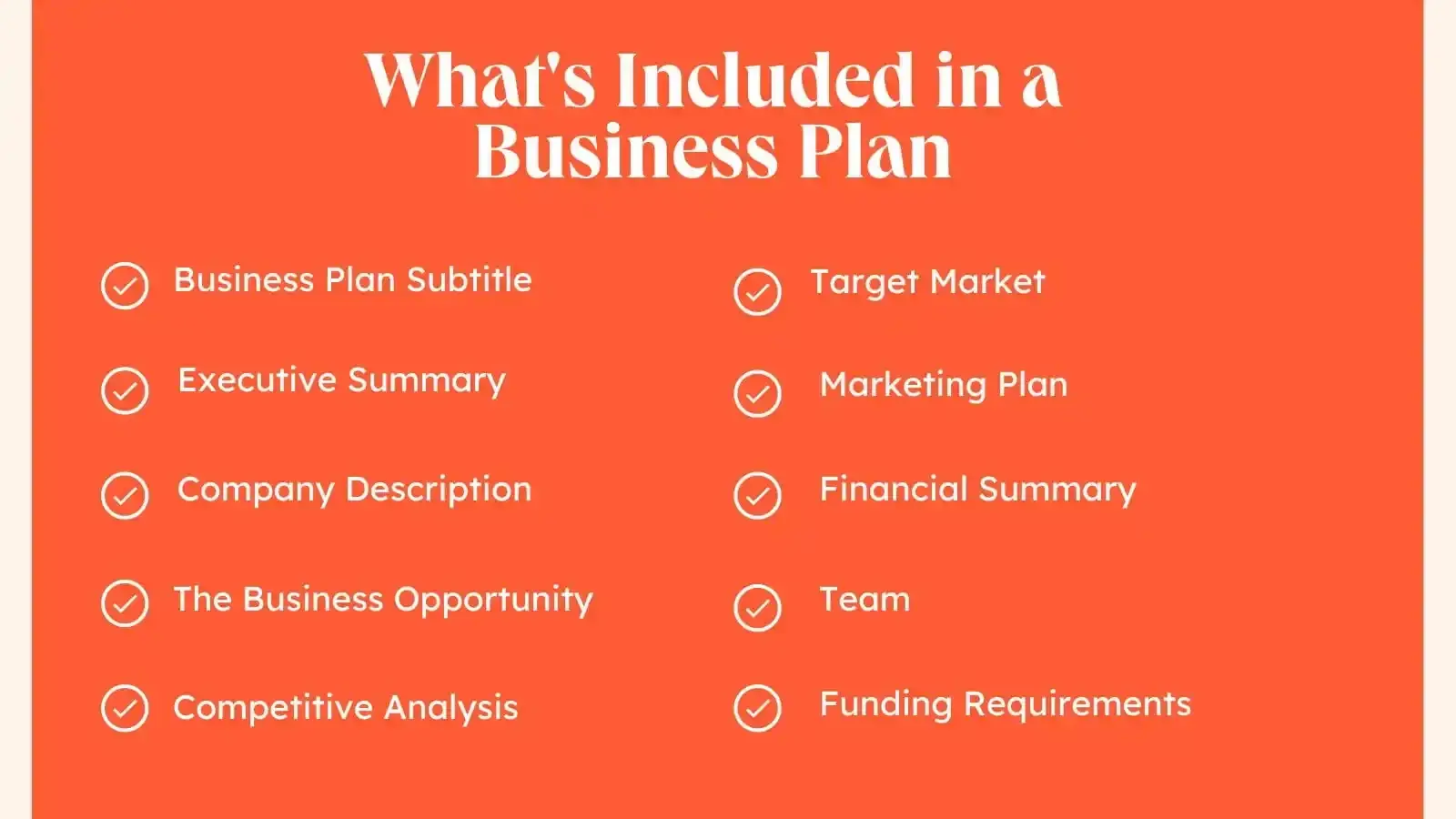
5. Competitive Analysis
Just about every industry has more than one player in the market. Even if your business owns the majority of the market share in your industry or your business concept is the first of its kind, you still have competition.
In the competitive analysis section, you’ll take an objective look at the industry landscape to determine where your business fits. A SWOT analysis is an organized way to format this section.
6. Target Market
Who are the core customers of your business and why? The target market portion of your business plan outlines this in detail. The target market should explain the demographics, psychographics, behavioristics, and geographics of the ideal customer.
7. Marketing Plan
Marketing is expansive, and it’ll be tempting to cover every type of marketing possible, but a brief overview of how you’ll market your unique value proposition to your target audience, followed by a tactical plan, will suffice.
Think broadly and narrow down from there: Will you focus on a slow-and-steady play where you make an upfront investment in organic customer acquisition? Or will you generate lots of quick customers using a pay-to-play advertising strategy?
This kind of information should guide the marketing plan section of your business plan.
8. Financial Summary
Money doesn’t grow on trees. Even the most digital, sustainable businesses have expenses. Outlining a financial summary of where your business is currently and where you’d like it to be in the future will substantiate this section.
Consider including any monetary information that will give potential investors a glimpse into the financial health of your business. Assets, liabilities, expenses, debt, investments, revenue, and more are all useful additions here.
So, you’ve outlined some great goals, the business opportunity is valid, and the industry is ready for what you have to offer. Who’s responsible for turning all this high-level talk into results?
The “team” section of your business plan answers that question by providing an overview of the roles responsible for each goal.
Don’t worry if you don’t have every team member on board yet. Knowing what roles to hire for is helpful as you seek funding from investors.
10. Funding Requirements
Remember that one of the goals of a business plan is to secure funding from investors, so you’ll need to include funding requirements you’d like them to fulfill.
Considering that global funding fell 61% from 2021 to 2023 , it’s very important to be clear in this section. Include the amount your business needs, for what reasons, and for how long.
- Startup Business Plan
- Feasibility Business Plan
- Internal Business Plan
- Strategic Business Plan
- Business Acquisition Plan
- Business Repositioning Plan
- Expansion or Growth Business Plan
There’s no one size fits all business plan as there are several types of businesses in the market today. From startups with just one founder to historic household names that need to stay competitive, every type of business needs a business plan that’s tailored to its needs. Below are a few of the most common types of business plans.
For even more examples, check out these sample business plans to help you write your own .
1. Startup Business Plan
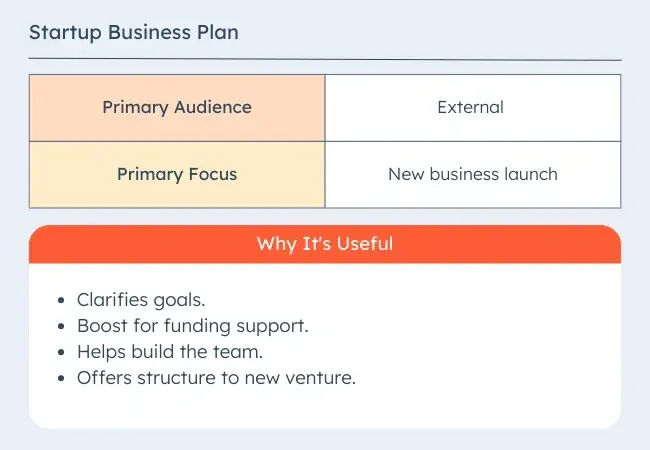
As one of the most common types of business plans, a startup business plan is for new business ideas. This plan lays the foundation for the eventual success of a business.
I think the biggest challenge with the startup business plan is that it's written completely from scratch. Startup business plans often reference existing industry data. They also explain unique business strategies and go-to-market plans.
Because startup business plans expand on an original idea, the contents will vary by the top priority goals.
For example, say a startup is looking for funding. If capital is a priority, this business plan might focus more on financial projections than marketing or company culture.
Eric Heckstall , the founder and CEO of EDH Signature Inc ., which offers premier grooming products, also suggests keeping your startup business plan short.
“The traditional business plan can be 40+ pages, which is too large of a document to really be useful, can be difficult for staff to understand, and have to dig for information which most people won’t do,” Heckstall says.
Conversely, a one-to-two-page business plan improves clarity and focus. Heckstall says this format “is easy to use on a day-to-day basis, teams as well as potential investors can understand the purpose and direction of the company, and can easily be incorporated into team meetings.”
2. Feasibility Business Plan
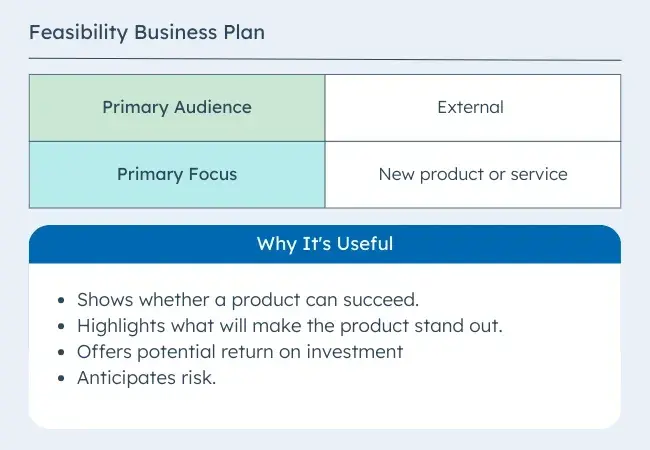
This type of business plan focuses on a single essential aspect of the business — the product or service. It may be part of a startup business plan or a standalone plan for an existing organization. This comprehensive plan may include:
- A detailed product description.
Market analysis.
- Technology needs.
- Production needs.
- Financial sources.
- Production operations.
Startups can fail because of a lack of market need and mistimed products. Plus, nearly half of entrepreneurs , founders, CEOs, and COOs report that price sensitivity and evolving market conditions are the number one prospect and customer challenges they face right now.
Some businesses will complete a feasibility study to explore ideas and narrow product plans to the best choice. They conduct these studies before completing the feasibility business plan. Then, the feasibility plan centers on that one product or service.
Zach Dannett , co-founder at rug company Tumble highlights how some business owners take a very idealistic approach too. And forget barriers to entry like regulatory issues in the process.
He adds how considering this aspect in their business plan helped.
Before launching the team, Dannett first took time to understand regulatory requirements in our industry, checking to make sure we needed to secure any certifications or licenses.
Then, “we reviewed financial requirements, which would cover initial investments, operational costs, and potential expenses. We then conducted thorough market research to understand our market, how saturated this market is, and identify major competitors with significant market share,” Dannett says
3. Internal Business Plan
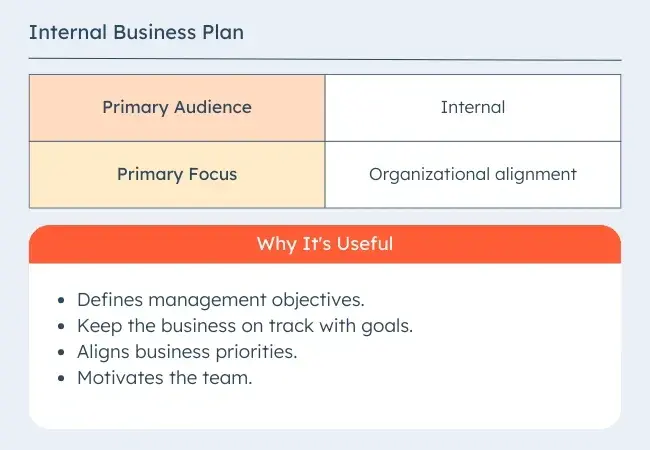
Internal business plans help leaders communicate company goals, strategy, and performance. This helps the business align and work toward objectives more effectively.
Besides the typical elements in a startup business plan, an internal business plan may also include:
- Department-specific budgets.
- Target demographic analysis.
- Market size and share of voice analysis.
- Action plans.
- Sustainability plans.
Most external-facing business plans focus on raising capital and support for a business. But, an internal business plan helps keep the business mission consistent in the face of change.
You can also reduce your workload by using a free business template that helps you get a headstart on what to include.
4. Strategic Business Plan
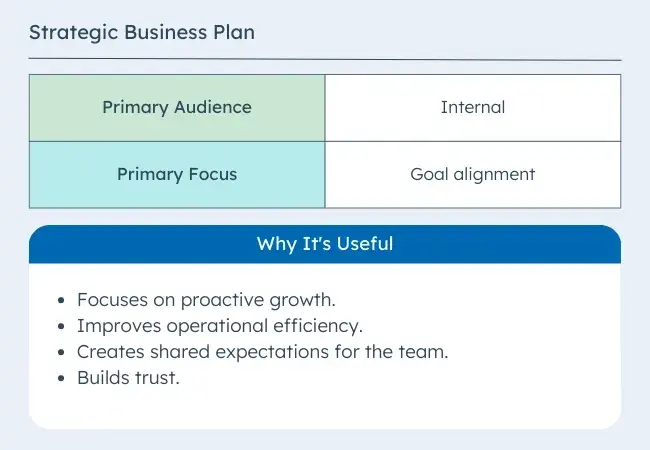
Strategic business plans focus on long-term objectives for your business. They usually cover the first three to five years of operations. This is different from the typical startup business plan which focuses on the first one to three years. The audience for this plan is also primarily internal stakeholders.
These types of business plans may include:
- Relevant data and analysis.
- Assessments of company resources.
- Vision and mission statements.
It's important to remember that, while many businesses create a strategic plan before launching, some business owners just jump in.
David Sides , marketing specialist at The Gori Law , highlights how it’s important not to create this plan in isolation and involve key stakeholders from across the organization in the planning process.
“We make a point of bringing together attorneys, paralegals, and support staff to discuss our long-term goals and how we can work together to achieve them. This not only helps ensure buy-in and alignment, but it also allows you to tap into a wider range of perspectives and ideas,” Sides says.
This way, the strategic business plan can add value by outlining how your business plans to reach specific goals and considering a holistic perspective from the most important stakeholders. This type of planning can also help a business anticipate future challenges.
5. Business Acquisition Plan
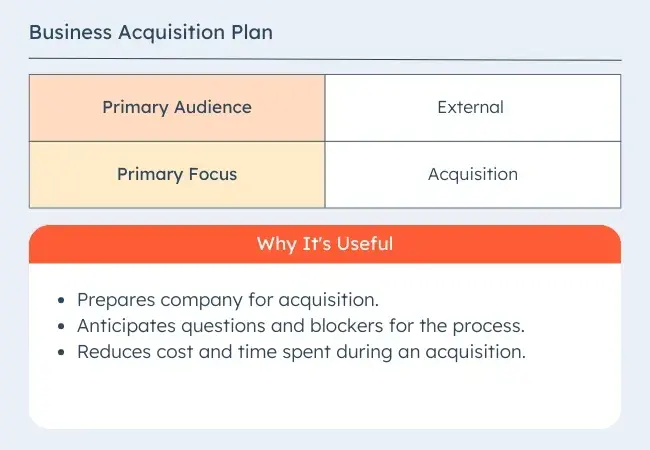
Investors use business plans to acquire existing businesses, too — not just new businesses.
I recommend including costs, schedules, or management requirements. This data will come from an acquisition strategy.
A business plan for an existing company will explain:
- How an acquisition will change its operating model.
- What will stay the same under new ownership.
- Why things will change or stay the same.
- Acquisition planning documentation.
- Timelines for acquisition.
Ilia Tretiakov , owner and lead strategist, at So Good Digital , a marketing agency suggests adding a Day Zero Plan. This is a thorough plan outlining the steps you will take the moment the acquisition is completed.
It consists of stakeholder communication plans, critical system integration, quick operational adjustments, and cultural alignment initiatives.
Here’s why Ilia believes it’s important.
“A Day Zero Plan establishes the framework for the integration process and guarantees a seamless transition. This comprehensive strategy goes above and beyond the typical post-acquisition integration plan, taking care of urgent issues and laying the groundwork for long-term success,” Tretiakov says,
Apart from this, I believe the business plan should speak to the current state of the business and why it's up for sale.
For example, if someone is purchasing a failing business, the business plan should explain why the business is being purchased. It should also include:
- What the new owner will do to turn the business around.
- Historic business metrics.
- Sales projections after the acquisition.
- Justification for those projections.
6. Business Repositioning Plan
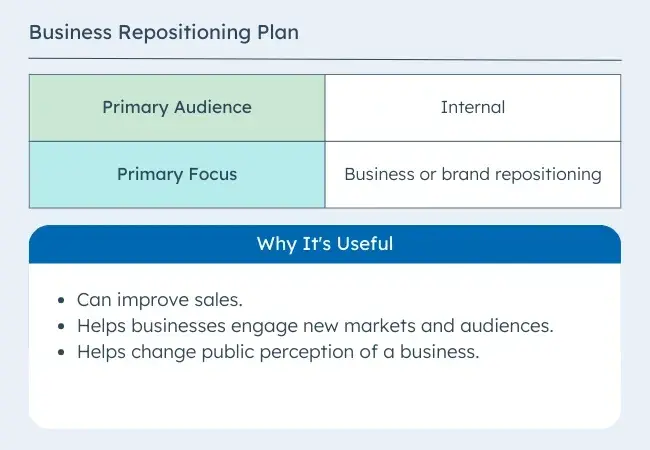
When a business wants to avoid acquisition, reposition its brand, or try something new, CEOs or owners will develop a business repositioning plan.
This plan will:
- Acknowledge the current state of the company.
- State a vision for the future of the company.
- Explain why the business needs to reposition itself.
- Outline a process for how the company will adjust.
Companies planning for a business reposition often do so — proactively or retroactively — due to a shift in market trends and customer needs.
For example, shoe brand AllBirds plans to refocus its brand on core customers and shift its go-to-market strategy. These decisions are a reaction to lackluster sales following product changes and other missteps.
7. Expansion or Growth Business Plan
When your business is ready to expand, a growth business plan creates a useful structure for reaching specific targets.
For example, a successful business expanding into another location can use a growth business plan. This is because it may also mean the business needs to focus on a new target market or generate more capital.
This type of plan usually covers the next year or two of growth. It often references current sales, revenue, and successes. It may also include:
- SWOT analysis.
- Growth opportunity studies.
- Financial goals and plans.
- Marketing plans.
- Capability planning.
These types of business plans will vary by business, but they can help you quickly rally around new priorities to drive growth.
Getting Started With Your Business Plan
At the end of the day, a business plan is simply an explanation of a business idea and why it will be successful. The more detail and thought you put into it, the more successful your plan — and the business it outlines — will be.
I personally recommend using the feasibility business plan template. It helps me assess the viability of my business idea before diving in head-first.
By completing a feasibility plan, I feel more confident and prepared to tackle the full business plan. Plus, it saves me time and effort in the long run by ensuring I'm pursuing an idea with real potential.
When writing your business plan, you’ll benefit from extensive research, feedback from your team or board of directors, and a solid template to organize your thoughts. If you need one of these, download HubSpot's Free Business Plan Template below to get started.
Editor's note: This post was originally published in August 2020 and has been updated for comprehensiveness.

Don't forget to share this post!
Related articles.

18 of My Favorite Sample Business Plans & Examples For Your Inspiration
![business plan development in entrepreneurship The 8 Best Free Flowchart Templates [+ Examples]](https://www.hubspot.com/hubfs/free-flowchart-template-1-20240716-6679104-1.webp)
The 8 Best Free Flowchart Templates [+ Examples]
![business plan development in entrepreneurship 7 Gantt Chart Examples You'll Want to Copy [+ 5 Steps to Make One]](https://www.hubspot.com/hubfs/gantt-chart-1-20240625-3861486-1.webp)
7 Gantt Chart Examples You'll Want to Copy [+ 5 Steps to Make One]
![business plan development in entrepreneurship How to Write an Executive Summary Execs Can't Ignore [+ 5 Top Examples]](https://www.hubspot.com/hubfs/executive-summary-example_5.webp)
How to Write an Executive Summary Execs Can't Ignore [+ 5 Top Examples]
20 Free & Paid Small Business Tools for Any Budget

Maximizing Your Social Media Strategy: The Top Aggregator Tools to Use

The Content Aggregator Guide for 2024

16 Best Screen Recorders to Use for Collaboration

The 25 Best Google Chrome Extensions for SEO
2 Essential Templates For Starting Your Business
Marketing software that helps you drive revenue, save time and resources, and measure and optimize your investments — all on one easy-to-use platform
How to make a business plan

How to make a good business plan: step-by-step guide.
A business plan is a strategic roadmap used to navigate the challenging journey of entrepreneurship. It's the foundation upon which you build a successful business.
A well-crafted business plan can help you define your vision, clarify your goals, and identify potential problems before they arise.
But where do you start? How do you create a business plan that sets you up for success?
This article will explore the step-by-step process of creating a comprehensive business plan.
A business plan is a formal document that outlines a business's objectives, strategies, and operational procedures. It typically includes the following information about a company:
Products or services
Target market
Competitors
Marketing and sales strategies
Financial plan
Management team
A business plan serves as a roadmap for a company's success and provides a blueprint for its growth and development. It helps entrepreneurs and business owners organize their ideas, evaluate the feasibility, and identify potential challenges and opportunities.
As well as serving as a guide for business owners, a business plan can attract investors and secure funding. It demonstrates the company's understanding of the market, its ability to generate revenue and profits, and its strategy for managing risks and achieving success.
Business plan vs. business model canvas
A business plan may seem similar to a business model canvas, but each document serves a different purpose.
A business model canvas is a high-level overview that helps entrepreneurs and business owners quickly test and iterate their ideas. It is often a one-page document that briefly outlines the following:
Key partnerships
Key activities
Key propositions
Customer relationships
Customer segments
Key resources
Cost structure
Revenue streams
On the other hand, a Business Plan Template provides a more in-depth analysis of a company's strategy and operations. It is typically a lengthy document and requires significant time and effort to develop.
A business model shouldn’t replace a business plan, and vice versa. Business owners should lay the foundations and visually capture the most important information with a Business Model Canvas Template . Because this is a fast and efficient way to communicate a business idea, a business model canvas is a good starting point before developing a more comprehensive business plan.
A business plan can aim to secure funding from investors or lenders, while a business model canvas communicates a business idea to potential customers or partners.
Why is a business plan important?
A business plan is crucial for any entrepreneur or business owner wanting to increase their chances of success.
Here are some of the many benefits of having a thorough business plan.
Helps to define the business goals and objectives
A business plan encourages you to think critically about your goals and objectives. Doing so lets you clearly understand what you want to achieve and how you plan to get there.
A well-defined set of goals, objectives, and key results also provides a sense of direction and purpose, which helps keep business owners focused and motivated.
Guides decision-making
A business plan requires you to consider different scenarios and potential problems that may arise in your business. This awareness allows you to devise strategies to deal with these issues and avoid pitfalls.
With a clear plan, entrepreneurs can make informed decisions aligning with their overall business goals and objectives. This helps reduce the risk of making costly mistakes and ensures they make decisions with long-term success in mind.
Attracts investors and secures funding
Investors and lenders often require a business plan before considering investing in your business. A document that outlines the company's goals, objectives, and financial forecasts can help instill confidence in potential investors and lenders.
A well-written business plan demonstrates that you have thoroughly thought through your business idea and have a solid plan for success.
Identifies potential challenges and risks
A business plan requires entrepreneurs to consider potential challenges and risks that could impact their business. For example:
Is there enough demand for my product or service?
Will I have enough capital to start my business?
Is the market oversaturated with too many competitors?
What will happen if my marketing strategy is ineffective?
By identifying these potential challenges, entrepreneurs can develop strategies to mitigate risks and overcome challenges. This can reduce the likelihood of costly mistakes and ensure the business is well-positioned to take on any challenges.

Provides a basis for measuring success
A business plan serves as a framework for measuring success by providing clear goals and financial projections . Entrepreneurs can regularly refer to the original business plan as a benchmark to measure progress. By comparing the current business position to initial forecasts, business owners can answer questions such as:
Are we where we want to be at this point?
Did we achieve our goals?
If not, why not, and what do we need to do?
After assessing whether the business is meeting its objectives or falling short, business owners can adjust their strategies as needed.
How to make a business plan step by step
The steps below will guide you through the process of creating a business plan and what key components you need to include.
1. Create an executive summary
Start with a brief overview of your entire plan. The executive summary should cover your business plan's main points and key takeaways.
Keep your executive summary concise and clear with the Executive Summary Template . The simple design helps readers understand the crux of your business plan without reading the entire document.
2. Write your company description
Provide a detailed explanation of your company. Include information on what your company does, the mission statement, and your vision for the future.
Provide additional background information on the history of your company, the founders, and any notable achievements or milestones.
3. Conduct a market analysis
Conduct an in-depth analysis of your industry, competitors, and target market. This is best done with a SWOT analysis to identify your strengths, weaknesses, opportunities, and threats. Next, identify your target market's needs, demographics, and behaviors.
Use the Competitive Analysis Template to brainstorm answers to simple questions like:
What does the current market look like?
Who are your competitors?
What are they offering?
What will give you a competitive advantage?
Who is your target market?
What are they looking for and why?
How will your product or service satisfy a need?
These questions should give you valuable insights into the current market and where your business stands.
4. Describe your products and services
Provide detailed information about your products and services. This includes pricing information, product features, and any unique selling points.
Use the Product/Market Fit Template to explain how your products meet the needs of your target market. Describe what sets them apart from the competition.
5. Design a marketing and sales strategy
Outline how you plan to promote and sell your products. Your marketing strategy and sales strategy should include information about your:
Pricing strategy
Advertising and promotional tactics
Sales channels
The Go to Market Strategy Template is a great way to visually map how you plan to launch your product or service in a new or existing market.
6. Determine budget and financial projections
Document detailed information on your business’ finances. Describe the current financial position of the company and how you expect the finances to play out.
Some details to include in this section are:
Startup costs
Revenue projections
Profit and loss statement
Funding you have received or plan to receive
Strategy for raising funds
7. Set the organization and management structure
Define how your company is structured and who will be responsible for each aspect of the business. Use the Business Organizational Chart Template to visually map the company’s teams, roles, and hierarchy.
As well as the organization and management structure, discuss the legal structure of your business. Clarify whether your business is a corporation, partnership, sole proprietorship, or LLC.
8. Make an action plan
At this point in your business plan, you’ve described what you’re aiming for. But how are you going to get there? The Action Plan Template describes the following steps to move your business plan forward. Outline the next steps you plan to take to bring your business plan to fruition.
Types of business plans
Several types of business plans cater to different purposes and stages of a company's lifecycle. Here are some of the most common types of business plans.
Startup business plan
A startup business plan is typically an entrepreneur's first business plan. This document helps entrepreneurs articulate their business idea when starting a new business.
Not sure how to make a business plan for a startup? It’s pretty similar to a regular business plan, except the primary purpose of a startup business plan is to convince investors to provide funding for the business. A startup business plan also outlines the potential target market, product/service offering, marketing plan, and financial projections.
Strategic business plan
A strategic business plan is a long-term plan that outlines a company's overall strategy, objectives, and tactics. This type of strategic plan focuses on the big picture and helps business owners set goals and priorities and measure progress.
The primary purpose of a strategic business plan is to provide direction and guidance to the company's management team and stakeholders. The plan typically covers a period of three to five years.
Operational business plan
An operational business plan is a detailed document that outlines the day-to-day operations of a business. It focuses on the specific activities and processes required to run the business, such as:
Organizational structure
Staffing plan
Production plan
Quality control
Inventory management
Supply chain
The primary purpose of an operational business plan is to ensure that the business runs efficiently and effectively. It helps business owners manage their resources, track their performance, and identify areas for improvement.
Growth-business plan
A growth-business plan is a strategic plan that outlines how a company plans to expand its business. It helps business owners identify new market opportunities and increase revenue and profitability. The primary purpose of a growth-business plan is to provide a roadmap for the company's expansion and growth.
The 3 Horizons of Growth Template is a great tool to identify new areas of growth. This framework categorizes growth opportunities into three categories: Horizon 1 (core business), Horizon 2 (emerging business), and Horizon 3 (potential business).
One-page business plan
A one-page business plan is a condensed version of a full business plan that focuses on the most critical aspects of a business. It’s a great tool for entrepreneurs who want to quickly communicate their business idea to potential investors, partners, or employees.
A one-page business plan typically includes sections such as business concept, value proposition, revenue streams, and cost structure.
Best practices for how to make a good business plan
Here are some additional tips for creating a business plan:
Use a template
A template can help you organize your thoughts and effectively communicate your business ideas and strategies. Starting with a template can also save you time and effort when formatting your plan.
Miro’s extensive library of customizable templates includes all the necessary sections for a comprehensive business plan. With our templates, you can confidently present your business plans to stakeholders and investors.
Be practical
Avoid overestimating revenue projections or underestimating expenses. Your business plan should be grounded in practical realities like your budget, resources, and capabilities.
Be specific
Provide as much detail as possible in your business plan. A specific plan is easier to execute because it provides clear guidance on what needs to be done and how. Without specific details, your plan may be too broad or vague, making it difficult to know where to start or how to measure success.
Be thorough with your research
Conduct thorough research to fully understand the market, your competitors, and your target audience . By conducting thorough research, you can identify potential risks and challenges your business may face and develop strategies to mitigate them.
Get input from others
It can be easy to become overly focused on your vision and ideas, leading to tunnel vision and a lack of objectivity. By seeking input from others, you can identify potential opportunities you may have overlooked.
Review and revise regularly
A business plan is a living document. You should update it regularly to reflect market, industry, and business changes. Set aside time for regular reviews and revisions to ensure your plan remains relevant and effective.
Create a winning business plan to chart your path to success
Starting or growing a business can be challenging, but it doesn't have to be. Whether you're a seasoned entrepreneur or just starting, a well-written business plan can make or break your business’ success.
The purpose of a business plan is more than just to secure funding and attract investors. It also serves as a roadmap for achieving your business goals and realizing your vision. With the right mindset, tools, and strategies, you can develop a visually appealing, persuasive business plan.
Ready to make an effective business plan that works for you? Check out our library of ready-made strategy and planning templates and chart your path to success.
Get on board in seconds
Join thousands of teams using Miro to do their best work yet.
- Search Search Please fill out this field.
What Is a Business Plan?
Understanding business plans, how to write a business plan, common elements of a business plan, the bottom line, business plan: what it is, what's included, and how to write one.
Adam Hayes, Ph.D., CFA, is a financial writer with 15+ years Wall Street experience as a derivatives trader. Besides his extensive derivative trading expertise, Adam is an expert in economics and behavioral finance. Adam received his master's in economics from The New School for Social Research and his Ph.D. from the University of Wisconsin-Madison in sociology. He is a CFA charterholder as well as holding FINRA Series 7, 55 & 63 licenses. He currently researches and teaches economic sociology and the social studies of finance at the Hebrew University in Jerusalem.
:max_bytes(150000):strip_icc():format(webp)/adam_hayes-5bfc262a46e0fb005118b414.jpg)
- How to Start a Business: A Comprehensive Guide and Essential Steps
- How to Do Market Research, Types, and Example
- Marketing Strategy: What It Is, How It Works, How To Create One
- Marketing in Business: Strategies and Types Explained
- What Is a Marketing Plan? Types and How to Write One
- Business Development: Definition, Strategies, Steps & Skills
- Business Plan: What It Is, What's Included, and How to Write One CURRENT ARTICLE
- Small Business Development Center (SBDC): Meaning, Types, Impact
- How to Write a Business Plan for a Loan
- Business Startup Costs: It’s in the Details
- Startup Capital Definition, Types, and Risks
- Bootstrapping Definition, Strategies, and Pros/Cons
- Crowdfunding: What It Is, How It Works, and Popular Websites
- Starting a Business with No Money: How to Begin
- A Comprehensive Guide to Establishing Business Credit
- Equity Financing: What It Is, How It Works, Pros and Cons
- Best Startup Business Loans
- Sole Proprietorship: What It Is, Pros & Cons, and Differences From an LLC
- Partnership: Definition, How It Works, Taxation, and Types
- What is an LLC? Limited Liability Company Structure and Benefits Defined
- Corporation: What It Is and How to Form One
- Starting a Small Business: Your Complete How-to Guide
- Starting an Online Business: A Step-by-Step Guide
- How to Start Your Own Bookkeeping Business: Essential Tips
- How to Start a Successful Dropshipping Business: A Comprehensive Guide
A business plan is a document that outlines a company's goals and the strategies to achieve them. It's valuable for both startups and established companies. For startups, a well-crafted business plan is crucial for attracting potential lenders and investors. Established businesses use business plans to stay on track and aligned with their growth objectives. This article will explain the key components of an effective business plan and guidance on how to write one.
Key Takeaways
- A business plan is a document detailing a company's business activities and strategies for achieving its goals.
- Startup companies use business plans to launch their venture and to attract outside investors.
- For established companies, a business plan helps keep the executive team focused on short- and long-term objectives.
- There's no single required format for a business plan, but certain key elements are essential for most companies.
Investopedia / Ryan Oakley
Any new business should have a business plan in place before beginning operations. Banks and venture capital firms often want to see a business plan before considering making a loan or providing capital to new businesses.
Even if a company doesn't need additional funding, having a business plan helps it stay focused on its goals. Research from the University of Oregon shows that businesses with a plan are significantly more likely to secure funding than those without one. Moreover, companies with a business plan grow 30% faster than those that don't plan. According to a Harvard Business Review article, entrepreneurs who write formal plans are 16% more likely to achieve viability than those who don't.
A business plan should ideally be reviewed and updated periodically to reflect achieved goals or changes in direction. An established business moving in a new direction might even create an entirely new plan.
There are numerous benefits to creating (and sticking to) a well-conceived business plan. It allows for careful consideration of ideas before significant investment, highlights potential obstacles to success, and provides a tool for seeking objective feedback from trusted outsiders. A business plan may also help ensure that a company’s executive team remains aligned on strategic action items and priorities.
While business plans vary widely, even among competitors in the same industry, they often share basic elements detailed below.
A well-crafted business plan is essential for attracting investors and guiding a company's strategic growth. It should address market needs and investor requirements and provide clear financial projections.
While there are any number of templates that you can use to write a business plan, it's best to try to avoid producing a generic-looking one. Let your plan reflect the unique personality of your business.
Many business plans use some combination of the sections below, with varying levels of detail, depending on the company.
The length of a business plan can vary greatly from business to business. Regardless, gathering the basic information into a 15- to 25-page document is best. Any additional crucial elements, such as patent applications, can be referenced in the main document and included as appendices.
Common elements in many business plans include:
- Executive summary : This section introduces the company and includes its mission statement along with relevant information about the company's leadership, employees, operations, and locations.
- Products and services : Describe the products and services the company offers or plans to introduce. Include details on pricing, product lifespan, and unique consumer benefits. Mention production and manufacturing processes, relevant patents , proprietary technology , and research and development (R&D) information.
- Market analysis : Explain the current state of the industry and the competition. Detail where the company fits in, the types of customers it plans to target, and how it plans to capture market share from competitors.
- Marketing strategy : Outline the company's plans to attract and retain customers, including anticipated advertising and marketing campaigns. Describe the distribution channels that will be used to deliver products or services to consumers.
- Financial plans and projections : Established businesses should include financial statements, balance sheets, and other relevant financial information. New businesses should provide financial targets and estimates for the first few years. This section may also include any funding requests.
Investors want to see a clear exit strategy, expected returns, and a timeline for cashing out. It's likely a good idea to provide five-year profitability forecasts and realistic financial estimates.
2 Types of Business Plans
Business plans can vary in format, often categorized into traditional and lean startup plans. According to the U.S. Small Business Administration (SBA) , the traditional business plan is the more common of the two.
- Traditional business plans : These are detailed and lengthy, requiring more effort to create but offering comprehensive information that can be persuasive to potential investors.
- Lean startup business plans : These are concise, sometimes just one page, and focus on key elements. While they save time, companies should be ready to provide additional details if requested by investors or lenders.
Why Do Business Plans Fail?
A business plan isn't a surefire recipe for success. The plan may have been unrealistic in its assumptions and projections. Markets and the economy might change in ways that couldn't have been foreseen. A competitor might introduce a revolutionary new product or service. All this calls for building flexibility into your plan, so you can pivot to a new course if needed.
How Often Should a Business Plan Be Updated?
How frequently a business plan needs to be revised will depend on its nature. Updating your business plan is crucial due to changes in external factors (market trends, competition, and regulations) and internal developments (like employee growth and new products). While a well-established business might want to review its plan once a year and make changes if necessary, a new or fast-growing business in a fiercely competitive market might want to revise it more often, such as quarterly.
What Does a Lean Startup Business Plan Include?
The lean startup business plan is ideal for quickly explaining a business, especially for new companies that don't have much information yet. Key sections may include a value proposition , major activities and advantages, resources (staff, intellectual property, and capital), partnerships, customer segments, and revenue sources.
A well-crafted business plan is crucial for any company, whether it's a startup looking for investment or an established business wanting to stay on course. It outlines goals and strategies, boosting a company's chances of securing funding and achieving growth.
As your business and the market change, update your business plan regularly. This keeps it relevant and aligned with your current goals and conditions. Think of your business plan as a living document that evolves with your company, not something carved in stone.
University of Oregon Department of Economics. " Evaluation of the Effectiveness of Business Planning Using Palo Alto's Business Plan Pro ." Eason Ding & Tim Hursey.
Bplans. " Do You Need a Business Plan? Scientific Research Says Yes ."
Harvard Business Review. " Research: Writing a Business Plan Makes Your Startup More Likely to Succeed ."
Harvard Business Review. " How to Write a Winning Business Plan ."
U.S. Small Business Administration. " Write Your Business Plan ."
SCORE. " When and Why Should You Review Your Business Plan? "
:max_bytes(150000):strip_icc():format(webp)/GettyImages-1222648303-e00f14f235ba4c63aa222a87f430e345.jpg)
- Terms of Service
- Editorial Policy
- Privacy Policy
Small Business Trends
How to create a business plan: examples & free template.
Whether you’re a seasoned entrepreneur or launching your very first startup, the guide will give you the insights, tools, and confidence you need to create a solid foundation for your business.
How to Write a Business Plan
Executive summary.
It’s crucial to include a clear mission statement, a brief description of your primary products or services, an overview of your target market, and key financial projections or achievements.
Our target market includes environmentally conscious consumers and businesses seeking to reduce their carbon footprint. We project a 200% increase in revenue within the first three years of operation.
Overview and Business Objectives
Example: EcoTech’s primary objective is to become a market leader in sustainable technology products within the next five years. Our key objectives include:
Example: EcoTech is committed to developing cutting-edge sustainable technology products that benefit both the environment and our customers. Our unique combination of innovative solutions and eco-friendly design sets us apart from the competition. We envision a future where technology and sustainability go hand in hand, leading to a greener planet.
Define Your Target Market
The Market Analysis section requires thorough research and a keen understanding of the industry. It involves examining the current trends within your industry, understanding the needs and preferences of your customers, and analyzing the strengths and weaknesses of your competitors.
Our research indicates a gap in the market for high-quality, innovative eco-friendly technology products that cater to both individual and business clients.
SWOT Analysis
Including a SWOT analysis demonstrates to stakeholders that you have a balanced and realistic understanding of your business in its operational context.
Organization and management team.
Provide an overview of your company’s organizational structure, including key roles and responsibilities. Introduce your management team, highlighting their expertise and experience to demonstrate that your team is capable of executing the business plan successfully.
Products and Services Offered
This section should emphasize the value you provide to customers, demonstrating that your business has a deep understanding of customer needs and is well-positioned to deliver innovative solutions that address those needs and set your company apart from competitors.
Marketing and Sales Strategy
Discuss how these marketing and sales efforts will work together to attract and retain customers, generate leads, and ultimately contribute to achieving your business’s revenue goals.
Logistics and Operations Plan
Inventory control is another crucial aspect, where you explain strategies for inventory management to ensure efficiency and reduce wastage. The section should also describe your production processes, emphasizing scalability and adaptability to meet changing market demands.
We also prioritize efficient distribution through various channels, including online platforms and retail partners, to deliver products to our customers in a timely manner.
Financial Projections Plan
This forward-looking financial plan is crucial for demonstrating that you have a firm grasp of the financial nuances of your business and are prepared to manage its financial health effectively.
Income Statement
Cash flow statement.
A cash flow statement is a crucial part of a financial business plan that shows the inflows and outflows of cash within your business. It helps you monitor your company’s liquidity, ensuring you have enough cash on hand to cover operating expenses, pay debts, and invest in growth opportunities.
Tips on Writing a Business Plan
4. Focus on your unique selling proposition (USP): Clearly articulate what sets your business apart from the competition. Emphasize your USP throughout your business plan to showcase your company’s value and potential for success.
FREE Business Plan Template
To help you get started on your business plan, we have created a template that includes all the essential components discussed in the “How to Write a Business Plan” section. This easy-to-use template will guide you through each step of the process, ensuring you don’t miss any critical details.
What is a Business Plan?
Why you should write a business plan.
Understanding the importance of a business plan in today’s competitive environment is crucial for entrepreneurs and business owners. Here are five compelling reasons to write a business plan:
What are the Different Types of Business Plans?
Using business plan software.
Upmetrics provides a simple and intuitive platform for creating a well-structured business plan. It features customizable templates, financial forecasting tools, and collaboration capabilities, allowing you to work with team members and advisors. Upmetrics also offers a library of resources to guide you through the business planning process.
Business Plan FAQs
What is a good business plan.
A good business plan is a well-researched, clear, and concise document that outlines a company’s goals, strategies, target market, competitive advantages, and financial projections. It should be adaptable to change and provide a roadmap for achieving success.
What are the 3 main purposes of a business plan?
Can i write a business plan by myself, is it possible to create a one-page business plan.
Yes, a one-page business plan is a condensed version that highlights the most essential elements, including the company’s mission, target market, unique selling proposition, and financial goals.
How long should a business plan be?
What is a business plan outline, what are the 5 most common business plan mistakes, what questions should be asked in a business plan.
A business plan should address questions such as: What problem does the business solve? Who is the specific target market ? What is the unique selling proposition? What are the company’s objectives? How will it achieve those objectives?
What’s the difference between a business plan and a strategic plan?
How is business planning for a nonprofit different.
Home > Business > Business Startup
How To Write a Business Plan

We are committed to sharing unbiased reviews. Some of the links on our site are from our partners who compensate us. Read our editorial guidelines and advertising disclosure .

Starting a business is a wild ride, and a solid business plan can be the key to keeping you on track. A business plan is essentially a roadmap for your business — outlining your goals, strategies, market analysis and financial projections. Not only will it guide your decision-making, a business plan can help you secure funding with a loan or from investors .
Writing a business plan can seem like a huge task, but taking it one step at a time can break the plan down into manageable milestones. Here is our step-by-step guide on how to write a business plan.
Table of contents
- Write your executive summary
- Do your market research homework
- Set your business goals and objectives
- Plan your business strategy
- Describe your product or service
- Crunch the numbers
- Finalize your business plan

By signing up I agree to the Terms of Use and Privacy Policy .
Step 1: Write your executive summary
Though this will be the first page of your business plan , we recommend you actually write the executive summary last. That’s because an executive summary highlights what’s to come in the business plan but in a more condensed fashion.
An executive summary gives stakeholders who are reading your business plan the key points quickly without having to comb through pages and pages. Be sure to cover each successive point in a concise manner, and include as much data as necessary to support your claims.
You’ll cover other things too, but answer these basic questions in your executive summary:
- Idea: What’s your business concept? What problem does your business solve? What are your business goals?
- Product: What’s your product/service and how is it different?
- Market: Who’s your audience? How will you reach customers?
- Finance: How much will your idea cost? And if you’re seeking funding, how much money do you need? How much do you expect to earn? If you’ve already started, where is your revenue at now?
Step 2: Do your market research homework
The next step in writing a business plan is to conduct market research . This involves gathering information about your target market (or customer persona), your competition, and the industry as a whole. You can use a variety of research methods such as surveys, focus groups, and online research to gather this information. Your method may be formal or more casual, just make sure that you’re getting good data back.
This research will help you to understand the needs of your target market and the potential demand for your product or service—essential aspects of starting and growing a successful business.
Step 3: Set your business goals and objectives
Once you’ve completed your market research, you can begin to define your business goals and objectives. What is the problem you want to solve? What’s your vision for the future? Where do you want to be in a year from now?
Use this step to decide what you want to achieve with your business, both in the short and long term. Try to set SMART goals—specific, measurable, achievable, relevant, and time-bound benchmarks—that will help you to stay focused and motivated as you build your business.
Step 4: Plan your business strategy
Your business strategy is how you plan to reach your goals and objectives. This includes details on positioning your product or service, marketing and sales strategies, operational plans, and the organizational structure of your small business.
Make sure to include key roles and responsibilities for each team member if you’re in a business entity with multiple people.
Step 5: Describe your product or service
In this section, get into the nitty-gritty of your product or service. Go into depth regarding the features, benefits, target market, and any patents or proprietary tech you have. Make sure to paint a clear picture of what sets your product apart from the competition—and don’t forget to highlight any customer benefits.
Step 6: Crunch the numbers
Financial analysis is an essential part of your business plan. If you’re already in business that includes your profit and loss statement , cash flow statement and balance sheet .
These financial projections will give investors and lenders an understanding of the financial health of your business and the potential return on investment.
You may want to work with a financial professional to ensure your financial projections are realistic and accurate.
Step 7: Finalize your business plan
Once you’ve completed everything, it's time to finalize your business plan. This involves reviewing and editing your plan to ensure that it is clear, concise, and easy to understand.
You should also have someone else review your plan to get a fresh perspective and identify any areas that may need improvement. You could even work with a free SCORE mentor on your business plan or use a SCORE business plan template for more detailed guidance.
Compare the Top Small-Business Banks
Data effective 1/10/23. At publishing time, rates, fees, and requirements are current but are subject to change. Offers may not be available in all areas.
The takeaway
Writing a business plan is an essential process for any forward-thinking entrepreneur or business owner. A business plan requires a lot of up-front research, planning, and attention to detail, but it’s worthwhile. Creating a comprehensive business plan can help you achieve your business goals and secure the funding you need.
Related content
- 5 Best Business Plan Software and Tools in 2023 for Your Small Business
- How to Get a Business License: What You Need to Know
- What Is a Cash Flow Statement?
Best Small Business Loans

5202 W Douglas Corrigan Way Salt Lake City, UT 84116
Accounting & Payroll
Point of Sale
Payment Processing
Inventory Management
Human Resources
Other Services
Best Inventory Management Software
Best Small Business Accounting Software
Best Payroll Software
Best Mobile Credit Card Readers
Best POS Systems
Best Tax Software
Stay updated on the latest products and services anytime anywhere.
By signing up, you agree to our Terms of Use and Privacy Policy .
Disclaimer: The information featured in this article is based on our best estimates of pricing, package details, contract stipulations, and service available at the time of writing. All information is subject to change. Pricing will vary based on various factors, including, but not limited to, the customer’s location, package chosen, added features and equipment, the purchaser’s credit score, etc. For the most accurate information, please ask your customer service representative. Clarify all fees and contract details before signing a contract or finalizing your purchase.
Our mission is to help consumers make informed purchase decisions. While we strive to keep our reviews as unbiased as possible, we do receive affiliate compensation through some of our links. This can affect which services appear on our site and where we rank them. Our affiliate compensation allows us to maintain an ad-free website and provide a free service to our readers. For more information, please see our Privacy Policy Page . |
© Business.org 2024 All Rights Reserved.
How to Write a Business Plan: Step-by-Step Guide + Examples

Noah Parsons
24 min. read
Updated May 7, 2024
Writing a business plan doesn’t have to be complicated.
In this step-by-step guide, you’ll learn how to write a business plan that’s detailed enough to impress bankers and potential investors, while giving you the tools to start, run, and grow a successful business.
- The basics of business planning
If you’re reading this guide, then you already know why you need a business plan .
You understand that planning helps you:
- Raise money
- Grow strategically
- Keep your business on the right track
As you start to write your plan, it’s useful to zoom out and remember what a business plan is .
At its core, a business plan is an overview of the products and services you sell, and the customers that you sell to. It explains your business strategy: how you’re going to build and grow your business, what your marketing strategy is, and who your competitors are.
Most business plans also include financial forecasts for the future. These set sales goals, budget for expenses, and predict profits and cash flow.
A good business plan is much more than just a document that you write once and forget about. It’s also a guide that helps you outline and achieve your goals.
After completing your plan, you can use it as a management tool to track your progress toward your goals. Updating and adjusting your forecasts and budgets as you go is one of the most important steps you can take to run a healthier, smarter business.
We’ll dive into how to use your plan later in this article.
There are many different types of plans , but we’ll go over the most common type here, which includes everything you need for an investor-ready plan. However, if you’re just starting out and are looking for something simpler—I recommend starting with a one-page business plan . It’s faster and easier to create.
It’s also the perfect place to start if you’re just figuring out your idea, or need a simple strategic plan to use inside your business.
Dig deeper : How to write a one-page business plan
Brought to you by
Create a professional business plan
Using ai and step-by-step instructions.
Secure funding
Validate ideas
Build a strategy
- What to include in your business plan
Executive summary
The executive summary is an overview of your business and your plans. It comes first in your plan and is ideally just one to two pages. Most people write it last because it’s a summary of the complete business plan.
Ideally, the executive summary can act as a stand-alone document that covers the highlights of your detailed plan.
In fact, it’s common for investors to ask only for the executive summary when evaluating your business. If they like what they see in the executive summary, they’ll often follow up with a request for a complete plan, a pitch presentation , or more in-depth financial forecasts .
Your executive summary should include:
- A summary of the problem you are solving
- A description of your product or service
- An overview of your target market
- A brief description of your team
- A summary of your financials
- Your funding requirements (if you are raising money)
Dig Deeper: How to write an effective executive summary
Products and services description
This is where you describe exactly what you’re selling, and how it solves a problem for your target market. The best way to organize this part of your plan is to start by describing the problem that exists for your customers. After that, you can describe how you plan to solve that problem with your product or service.
This is usually called a problem and solution statement .
To truly showcase the value of your products and services, you need to craft a compelling narrative around your offerings. How will your product or service transform your customers’ lives or jobs? A strong narrative will draw in your readers.
This is also the part of the business plan to discuss any competitive advantages you may have, like specific intellectual property or patents that protect your product. If you have any initial sales, contracts, or other evidence that your product or service is likely to sell, include that information as well. It will show that your idea has traction , which can help convince readers that your plan has a high chance of success.
Market analysis
Your target market is a description of the type of people that you plan to sell to. You might even have multiple target markets, depending on your business.
A market analysis is the part of your plan where you bring together all of the information you know about your target market. Basically, it’s a thorough description of who your customers are and why they need what you’re selling. You’ll also include information about the growth of your market and your industry .
Try to be as specific as possible when you describe your market.
Include information such as age, income level, and location—these are what’s called “demographics.” If you can, also describe your market’s interests and habits as they relate to your business—these are “psychographics.”
Related: Target market examples
Essentially, you want to include any knowledge you have about your customers that is relevant to how your product or service is right for them. With a solid target market, it will be easier to create a sales and marketing plan that will reach your customers. That’s because you know who they are, what they like to do, and the best ways to reach them.
Next, provide any additional information you have about your market.
What is the size of your market ? Is the market growing or shrinking? Ideally, you’ll want to demonstrate that your market is growing over time, and also explain how your business is positioned to take advantage of any expected changes in your industry.
Dig Deeper: Learn how to write a market analysis
Competitive analysis
Part of defining your business opportunity is determining what your competitive advantage is. To do this effectively, you need to know as much about your competitors as your target customers.
Every business has some form of competition. If you don’t think you have competitors, then explore what alternatives there are in the market for your product or service.
For example: In the early years of cars, their main competition was horses. For social media, the early competition was reading books, watching TV, and talking on the phone.
A good competitive analysis fully lays out the competitive landscape and then explains how your business is different. Maybe your products are better made, or cheaper, or your customer service is superior. Maybe your competitive advantage is your location – a wide variety of factors can ultimately give you an advantage.
Dig Deeper: How to write a competitive analysis for your business plan
Marketing and sales plan
The marketing and sales plan covers how you will position your product or service in the market, the marketing channels and messaging you will use, and your sales tactics.
The best place to start with a marketing plan is with a positioning statement .
This explains how your business fits into the overall market, and how you will explain the advantages of your product or service to customers. You’ll use the information from your competitive analysis to help you with your positioning.
For example: You might position your company as the premium, most expensive but the highest quality option in the market. Or your positioning might focus on being locally owned and that shoppers support the local economy by buying your products.
Once you understand your positioning, you’ll bring this together with the information about your target market to create your marketing strategy .
This is how you plan to communicate your message to potential customers. Depending on who your customers are and how they purchase products like yours, you might use many different strategies, from social media advertising to creating a podcast. Your marketing plan is all about how your customers discover who you are and why they should consider your products and services.
While your marketing plan is about reaching your customers—your sales plan will describe the actual sales process once a customer has decided that they’re interested in what you have to offer.
If your business requires salespeople and a long sales process, describe that in this section. If your customers can “self-serve” and just make purchases quickly on your website, describe that process.
A good sales plan picks up where your marketing plan leaves off. The marketing plan brings customers in the door and the sales plan is how you close the deal.
Together, these specific plans paint a picture of how you will connect with your target audience, and how you will turn them into paying customers.
Dig deeper: What to include in your sales and marketing plan
Business operations
The operations section describes the necessary requirements for your business to run smoothly. It’s where you talk about how your business works and what day-to-day operations look like.
Depending on how your business is structured, your operations plan may include elements of the business like:
- Supply chain management
- Manufacturing processes
- Equipment and technology
- Distribution
Some businesses distribute their products and reach their customers through large retailers like Amazon.com, Walmart, Target, and grocery store chains.
These businesses should review how this part of their business works. The plan should discuss the logistics and costs of getting products onto store shelves and any potential hurdles the business may have to overcome.
If your business is much simpler than this, that’s OK. This section of your business plan can be either extremely short or more detailed, depending on the type of business you are building.
For businesses selling services, such as physical therapy or online software, you can use this section to describe the technology you’ll leverage, what goes into your service, and who you will partner with to deliver your services.
Dig Deeper: Learn how to write the operations chapter of your plan
Key milestones and metrics
Although it’s not required to complete your business plan, mapping out key business milestones and the metrics can be incredibly useful for measuring your success.
Good milestones clearly lay out the parameters of the task and set expectations for their execution. You’ll want to include:
- A description of each task
- The proposed due date
- Who is responsible for each task
If you have a budget, you can include projected costs to hit each milestone. You don’t need extensive project planning in this section—just list key milestones you want to hit and when you plan to hit them. This is your overall business roadmap.
Possible milestones might be:
- Website launch date
- Store or office opening date
- First significant sales
- Break even date
- Business licenses and approvals
You should also discuss the key numbers you will track to determine your success. Some common metrics worth tracking include:
- Conversion rates
- Customer acquisition costs
- Profit per customer
- Repeat purchases
It’s perfectly fine to start with just a few metrics and grow the number you are tracking over time. You also may find that some metrics simply aren’t relevant to your business and can narrow down what you’re tracking.
Dig Deeper: How to use milestones in your business plan
Organization and management team
Investors don’t just look for great ideas—they want to find great teams. Use this chapter to describe your current team and who you need to hire . You should also provide a quick overview of your location and history if you’re already up and running.
Briefly highlight the relevant experiences of each key team member in the company. It’s important to make the case for why yours is the right team to turn an idea into a reality.
Do they have the right industry experience and background? Have members of the team had entrepreneurial successes before?
If you still need to hire key team members, that’s OK. Just note those gaps in this section.
Your company overview should also include a summary of your company’s current business structure . The most common business structures include:
- Sole proprietor
- Partnership
Be sure to provide an overview of how the business is owned as well. Does each business partner own an equal portion of the business? How is ownership divided?
Potential lenders and investors will want to know the structure of the business before they will consider a loan or investment.
Dig Deeper: How to write about your company structure and team
Last, but certainly not least, is your financial plan chapter.
Entrepreneurs often find this section the most daunting. But, business financials for most startups are less complicated than you think, and a business degree is certainly not required to build a solid financial forecast.
A typical financial forecast in a business plan includes the following:
- Sales forecast : An estimate of the sales expected over a given period. You’ll break down your forecast into the key revenue streams that you expect to have.
- Expense budget : Your planned spending such as personnel costs , marketing expenses, and taxes.
- Profit & Loss : Brings together your sales and expenses and helps you calculate planned profits.
- Cash Flow : Shows how cash moves into and out of your business. It can predict how much cash you’ll have on hand at any given point in the future.
- Balance Sheet : A list of the assets, liabilities, and equity in your company. In short, it provides an overview of the financial health of your business.
A strong business plan will include a description of assumptions about the future, and potential risks that could impact the financial plan. Including those will be especially important if you’re writing a business plan to pursue a loan or other investment.
Dig Deeper: How to create financial forecasts and budgets
This is the place for additional data, charts, or other information that supports your plan.
Including an appendix can significantly enhance the credibility of your plan by showing readers that you’ve thoroughly considered the details of your business idea, and are backing your ideas up with solid data.
Just remember that the information in the appendix is meant to be supplementary. Your business plan should stand on its own, even if the reader skips this section.
Dig Deeper : What to include in your business plan appendix
Optional: Business plan cover page
Adding a business plan cover page can make your plan, and by extension your business, seem more professional in the eyes of potential investors, lenders, and partners. It serves as the introduction to your document and provides necessary contact information for stakeholders to reference.
Your cover page should be simple and include:
- Company logo
- Business name
- Value proposition (optional)
- Business plan title
- Completion and/or update date
- Address and contact information
- Confidentiality statement
Just remember, the cover page is optional. If you decide to include it, keep it very simple and only spend a short amount of time putting it together.
Dig Deeper: How to create a business plan cover page
How to use AI to help write your business plan
Generative AI tools such as ChatGPT can speed up the business plan writing process and help you think through concepts like market segmentation and competition. These tools are especially useful for taking ideas that you provide and converting them into polished text for your business plan.
The best way to use AI for your business plan is to leverage it as a collaborator , not a replacement for human creative thinking and ingenuity.
AI can come up with lots of ideas and act as a brainstorming partner. It’s up to you to filter through those ideas and figure out which ones are realistic enough to resonate with your customers.
There are pros and cons of using AI to help with your business plan . So, spend some time understanding how it can be most helpful before just outsourcing the job to AI.
Learn more: 10 AI prompts you need to write a business plan
- Writing tips and strategies
To help streamline the business plan writing process, here are a few tips and key questions to answer to make sure you get the most out of your plan and avoid common mistakes .
Determine why you are writing a business plan
Knowing why you are writing a business plan will determine your approach to your planning project.
For example: If you are writing a business plan for yourself, or just to use inside your own business , you can probably skip the section about your team and organizational structure.
If you’re raising money, you’ll want to spend more time explaining why you’re looking to raise the funds and exactly how you will use them.
Regardless of how you intend to use your business plan , think about why you are writing and what you’re trying to get out of the process before you begin.
Keep things concise
Probably the most important tip is to keep your business plan short and simple. There are no prizes for long business plans . The longer your plan is, the less likely people are to read it.
So focus on trimming things down to the essentials your readers need to know. Skip the extended, wordy descriptions and instead focus on creating a plan that is easy to read —using bullets and short sentences whenever possible.
Have someone review your business plan
Writing a business plan in a vacuum is never a good idea. Sometimes it’s helpful to zoom out and check if your plan makes sense to someone else. You also want to make sure that it’s easy to read and understand.
Don’t wait until your plan is “done” to get a second look. Start sharing your plan early, and find out from readers what questions your plan leaves unanswered. This early review cycle will help you spot shortcomings in your plan and address them quickly, rather than finding out about them right before you present your plan to a lender or investor.
If you need a more detailed review, you may want to explore hiring a professional plan writer to thoroughly examine it.
Use a free business plan template and business plan examples to get started
Knowing what information to include in a business plan is sometimes not quite enough. If you’re struggling to get started or need additional guidance, it may be worth using a business plan template.
There are plenty of great options available (we’ve rounded up our 8 favorites to streamline your search).
But, if you’re looking for a free downloadable business plan template , you can get one right now; download the template used by more than 1 million businesses.
Or, if you just want to see what a completed business plan looks like, check out our library of over 550 free business plan examples .
We even have a growing list of industry business planning guides with tips for what to focus on depending on your business type.
Common pitfalls and how to avoid them
It’s easy to make mistakes when you’re writing your business plan. Some entrepreneurs get sucked into the writing and research process, and don’t focus enough on actually getting their business started.
Here are a few common mistakes and how to avoid them:
Not talking to your customers : This is one of the most common mistakes. It’s easy to assume that your product or service is something that people want. Before you invest too much in your business and too much in the planning process, make sure you talk to your prospective customers and have a good understanding of their needs.
- Overly optimistic sales and profit forecasts: By nature, entrepreneurs are optimistic about the future. But it’s good to temper that optimism a little when you’re planning, and make sure your forecasts are grounded in reality.
- Spending too much time planning: Yes, planning is crucial. But you also need to get out and talk to customers, build prototypes of your product and figure out if there’s a market for your idea. Make sure to balance planning with building.
- Not revising the plan: Planning is useful, but nothing ever goes exactly as planned. As you learn more about what’s working and what’s not—revise your plan, your budgets, and your revenue forecast. Doing so will provide a more realistic picture of where your business is going, and what your financial needs will be moving forward.
- Not using the plan to manage your business: A good business plan is a management tool. Don’t just write it and put it on the shelf to collect dust – use it to track your progress and help you reach your goals.
- Presenting your business plan
The planning process forces you to think through every aspect of your business and answer questions that you may not have thought of. That’s the real benefit of writing a business plan – the knowledge you gain about your business that you may not have been able to discover otherwise.
With all of this knowledge, you’re well prepared to convert your business plan into a pitch presentation to present your ideas.
A pitch presentation is a summary of your plan, just hitting the highlights and key points. It’s the best way to present your business plan to investors and team members.
Dig Deeper: Learn what key slides should be included in your pitch deck
Use your business plan to manage your business
One of the biggest benefits of planning is that it gives you a tool to manage your business better. With a revenue forecast, expense budget, and projected cash flow, you know your targets and where you are headed.
And yet, nothing ever goes exactly as planned – it’s the nature of business.
That’s where using your plan as a management tool comes in. The key to leveraging it for your business is to review it periodically and compare your forecasts and projections to your actual results.
Start by setting up a regular time to review the plan – a monthly review is a good starting point. During this review, answer questions like:
- Did you meet your sales goals?
- Is spending following your budget?
- Has anything gone differently than what you expected?
Now that you see whether you’re meeting your goals or are off track, you can make adjustments and set new targets.
Maybe you’re exceeding your sales goals and should set new, more aggressive goals. In that case, maybe you should also explore more spending or hiring more employees.
Or maybe expenses are rising faster than you projected. If that’s the case, you would need to look at where you can cut costs.
A plan, and a method for comparing your plan to your actual results , is the tool you need to steer your business toward success.
Learn More: How to run a regular plan review
Free business plan templates and examples
Kickstart your business plan writing with one of our free business plan templates or recommended tools.

Free business plan template
Download a free SBA-approved business plan template built for small businesses and startups.
Download Template

One-page plan template
Download a free one-page plan template to write a useful business plan in as little as 30-minutes.

Sample business plan library
Explore over 500 real-world business plan examples from a wide variety of industries.
View Sample Plans
How to write a business plan FAQ
A document that describes your business , the products and services you sell, and the customers that you sell to. It explains your business strategy, how you’re going to build and grow your business, what your marketing strategy is, and who your competitors are.
What are the benefits of a business plan?
A business plan helps you understand where you want to go with your business and what it will take to get there. It reduces your overall risk, helps you uncover your business’s potential, attracts investors, and identifies areas for growth.
Having a business plan ultimately makes you more confident as a business owner and more likely to succeed for a longer period of time.
What are the 7 steps of a business plan?
The seven steps to writing a business plan include:
- Write a brief executive summary
- Describe your products and services.
- Conduct market research and compile data into a cohesive market analysis.
- Describe your marketing and sales strategy.
- Outline your organizational structure and management team.
- Develop financial projections for sales, revenue, and cash flow.
- Add any additional documents to your appendix.
What are the 5 most common business plan mistakes?
There are plenty of mistakes that can be made when writing a business plan. However, these are the 5 most common that you should do your best to avoid:
- 1. Not taking the planning process seriously.
- Having unrealistic financial projections or incomplete financial information.
- Inconsistent information or simple mistakes.
- Failing to establish a sound business model.
- Not having a defined purpose for your business plan.
What questions should be answered in a business plan?
Writing a business plan is all about asking yourself questions about your business and being able to answer them through the planning process. You’ll likely be asking dozens and dozens of questions for each section of your plan.
However, these are the key questions you should ask and answer with your business plan:
- How will your business make money?
- Is there a need for your product or service?
- Who are your customers?
- How are you different from the competition?
- How will you reach your customers?
- How will you measure success?
The length of your business plan fully depends on what you intend to do with it. From the SBA and traditional lender point of view, a business plan needs to be whatever length necessary to fully explain your business. This means that you prove the viability of your business, show that you understand the market, and have a detailed strategy in place.
If you intend to use your business plan for internal management purposes, you don’t necessarily need a full 25-50 page business plan. Instead, you can start with a one-page plan to get all of the necessary information in place.
What are the different types of business plans?
While all business plans cover similar categories, the style and function fully depend on how you intend to use your plan. Here are a few common business plan types worth considering.
Traditional business plan: The tried-and-true traditional business plan is a formal document meant to be used when applying for funding or pitching to investors. This type of business plan follows the outline above and can be anywhere from 10-50 pages depending on the amount of detail included, the complexity of your business, and what you include in your appendix.
Business model canvas: The business model canvas is a one-page template designed to demystify the business planning process. It removes the need for a traditional, copy-heavy business plan, in favor of a single-page outline that can help you and outside parties better explore your business idea.
One-page business plan: This format is a simplified version of the traditional plan that focuses on the core aspects of your business. You’ll typically stick with bullet points and single sentences. It’s most useful for those exploring ideas, needing to validate their business model, or who need an internal plan to help them run and manage their business.
Lean Plan: The Lean Plan is less of a specific document type and more of a methodology. It takes the simplicity and styling of the one-page business plan and turns it into a process for you to continuously plan, test, review, refine, and take action based on performance. It’s faster, keeps your plan concise, and ensures that your plan is always up-to-date.
What’s the difference between a business plan and a strategic plan?
A business plan covers the “who” and “what” of your business. It explains what your business is doing right now and how it functions. The strategic plan explores long-term goals and explains “how” the business will get there. It encourages you to look more intently toward the future and how you will achieve your vision.
However, when approached correctly, your business plan can actually function as a strategic plan as well. If kept lean, you can define your business, outline strategic steps, and track ongoing operations all with a single plan.
Noah is the COO at Palo Alto Software, makers of the online business plan app LivePlan. He started his career at Yahoo! and then helped start the user review site Epinions.com. From there he started a software distribution business in the UK before coming to Palo Alto Software to run the marketing and product teams.

- Use AI to help write your plan
- Common planning mistakes
- Manage with your business plan
- Templates and examples
Related Articles

5 Min. Read
How To Write a Business Plan for a Life Coaching Business + Free Example

1 Min. Read
How to Calculate Return on Investment (ROI)

3 Min. Read
What to Include in Your Business Plan Appendix

7 Min. Read
How to Write a Bakery Business Plan + Sample
The Bplans Newsletter
The Bplans Weekly
Subscribe now for weekly advice and free downloadable resources to help start and grow your business.
We care about your privacy. See our privacy policy .

The quickest way to turn a business idea into a business plan
Fill-in-the-blanks and automatic financials make it easy.
No thanks, I prefer writing 40-page documents.

Discover the world’s #1 plan building software
- Developing a Business Plan in Entrepreneurship: A Comprehensive Guide
Welcome to our comprehensive guide on developing a business plan in entrepreneurship! Whether you're a seasoned entrepreneur or just starting out on your business journey, having a well-crafted business plan is essential for success. In this article, we will walk you through the process of creating a business plan from start to finish, providing valuable insights and expert advice along the way.
☑️ 1. understanding the importance of a business plan, 👩💻 2. conducting market research: identifying your target audience, 🎯 3. defining your business goals and objectives, 🛠️ 4. crafting a unique value proposition, 👥 5. analyzing the competitive landscape, 🛗 6. developing a marketing and sales strategy, ⚙️ 7. creating an operational plan, 📈 8. building a financial plan: budgeting and forecasting, 💼 9. securing funding for your business, ⚖️ 10. legal and regulatory considerations, 📏 11. measuring success: key performance indicators (kpis), 🎛️ 12. adapting and evolving your business plan, ✨ conclusion.
💡 A business plan is more than just a document; it's your roadmap to entrepreneurial success. It guides you, step by step, on your journey towards building a thriving business. When you take the time to create a comprehensive business plan, you not only gain a deeper understanding of your vision and objectives, but you also show potential investors, partners, and stakeholders that you mean business.
💡 A well-crafted business plan allows you to present your business idea in a structured and organized way. Clearly outlining your products or services, target market, and unique selling proposition effectively communicates your concept to others and build trust in your vision.
💡 Additionally, a business plan helps you strategize and set realistic goals. It prompts you to analyze the market, assess competition, and identify opportunities and challenges. Armed with this knowledge, you can make informed decisions that minimize risks and increase your chances of success.
💡 Now let's talk finances. Financial projections are another vital aspect of a business plan. You can create a realistic financial forecast by thoroughly analyzing your costs, revenue streams, and cash flow. This not only helps you gauge the financial viability of your business, but it also provides essential information for potential investors evaluating your venture's profitability and sustainability.
💡 Moreover, a business plan is often required by external parties when seeking funding. But here's the thing: a well-structured and comprehensive plan showcases your professionalism, competence, and dedication to your venture. It boosts your credibility with potential investors who are more likely to invest in a business with a clear and well-thought-out plan.
💡 To sum it up, developing a business plan is a critical step in entrepreneurship. It helps you clarify your vision, effectively communicate your ideas, make informed decisions, and attract potential investors. So, take the time to craft a comprehensive business plan so you can establish a solid foundation for the success of your venture and demonstrate your commitment to its growth and sustainability.
Let's get started on that business plan and set yourself up for success !
You know what's essential for developing a successful business plan? Understanding your target audience. That's right, it's all about conducting thorough market research to gain valuable insights into the needs, preferences, and behaviors of your potential customers . This knowledge will empower you to customize your products or services to meet their specific demands, giving you a competitive edge in the market .
🔍 So, how do you go about this market research? Well, it involves gathering and analyzing data related to your industry, target market, and competition. It's a comprehensive process that allows you to identify and assess potential opportunities and challenges within your chosen market segment. You won't be relying on assumptions or guesswork. Instead, you'll make informed decisions based on reliable data.
👂 Let's talk about identifying your target audience . These are the individuals or groups who are most likely to be interested in and benefit from your products or services. To identify them, think about demographic factors such as age, gender, location, income level, and occupation. And don't forget to delve into psychographic factors too, like interests, values, lifestyles, and purchasing behaviors. The more detailed and specific you can be in defining your target audience, the better you'll be able to tailor your marketing strategies to effectively reach and engage them.
🎛️ Now, let's dive into the methods of market research. You can use surveys, interviews, focus groups, and analyze data from secondary sources. Surveys will provide you with quantitative data, giving you insights on a large scale. And when it comes to interviews and focus groups, you'll get qualitative data that takes you deeper into the thoughts, opinions, and motivations of your target audience. Secondary sources like industry reports, government publications, and online databases will provide you with valuable information about market trends, competitor analysis, and customer behavior.
📊 Once you have all this data, it's time to analyze it . Look for patterns, trends, and opportunities that will inform your business strategies. When you truly understand your target audience's needs, pain points, and preferences, you'll be able to develop products or services that truly resonate with them. And guess what? This customer-centric approach increases the likelihood of customer satisfaction, loyalty, and ultimately, business success.
🧐 But wait, there's more! Market research also helps you assess the competitive landscape . Take a close look at your competitors' strengths, weaknesses, and market positioning. This analysis will help you identify gaps and differentiation opportunities for your business. Armed with this knowledge, you can develop unique value propositions and effective marketing strategies that set you apart from the competition.
Ready to dive into market research and gain valuable insights? Let's get started and propel your business forward!
Welcome to the next step in developing your business plan: defining your goals and objectives. It is important to set clear and well-defined goals and objectives for your business. These goals serve as guideposts, directing and giving purpose to your entrepreneurial journey. With the SMART framework—specific, measurable, attainable, relevant, and time-bound—you can set yourself up for success and ensure that your efforts are focused and effective.
With a clear roadmap in place, you are well-positioned to navigate the challenges and achieve the success you envision for your business.
Let's break down each element of the SMART framework:
✅ Specific: Your goals should be clear, concise, and well-defined. Instead of stating a vague objective like "increase revenue," let's be specific. For example, you could aim to "increase annual revenue by 20% within the next fiscal year."
✅ Measurable: It is important to establish metrics or key performance indicators (KPIs ) that allow you to track your progress. This enables you to measure the success of your strategies and determine whether you are on track to achieve your goals. For instance, if your goal is to expand your customer base, you can track the number of new customers acquired within a specific period.
✅ Attainable: While setting ambitious goals is important, they should also be realistic and attainable. Consider your available resources, market conditions, and industry trends when defining your objectives. Finding the balance between ambition and practicality is key to avoiding frustration and disappointment.
✅ Relevant: Ensure that your goals align with your overall vision, mission, and values. They should be relevant to your industry, target market, and the specific needs of your customers. Set relevant goals so you can stay focused on what truly matters for the growth and success of your business.
✅ Time-bound: Set specific timeframes or deadlines for achieving your objectives. This creates a sense of urgency, helps you prioritize tasks, and allows you to track your progress. Having a timeline ensures that your goals remain actionable and within reach.
Defining your business goals and objectives brings numerous benefits:
✔️ It keeps you focused and motivated, providing a clear vision of what you want to accomplish. Goals serve as milestones, giving you a sense of achievement as you make progress toward them.
✔️ They also provide a framework for decision-making, enabling you to effectively prioritize tasks and allocate resources.
✔️ Moreover, clearly defined goals make it easier to communicate your vision and strategies to your team members, investors, and stakeholders. Alignment of efforts and shared purpose foster collaboration and synergy within your organization.
In the world of business, standing out from the competition is key to your success. In today's crowded marketplace, having a unique value proposition (UVP) is essential. Your UVP is what sets you apart and defines the special benefits and value your products or services offer to customers.
With a strong UVP, you can thrive in a crowded marketplace and build a loyal customer base that recognizes and appreciates what you bring to the table.
Let's dive into the steps of crafting a compelling UVP that will attract and retain customers , differentiate your business, and build a strong and sustainable brand.
Step 1: Identify your target audience. Get to know your customers inside and out. Understand their needs, desires, and pain points. This knowledge forms the foundation for creating a UVP that truly resonates with them.
Step 2: Analyze the competition. Take a closer look at your competitors and their value propositions. What are others offering? Can you identify gaps and opportunities in the market that you can leverage to set your business apart?
Step 3: Focus on differentiation. Determine what makes your offerings unique. What are the standout features, advantages, or benefits that set you apart? How do your products or services better address the specific needs of your target audience compared to the competition?
Step 4: Communicate the value. Craft a clear and concise statement that communicates the value customers can expect from choosing your business. Use compelling language to highlight the benefits and outcomes they can achieve by using your products or services.
Step 5: Make it memorable. Your UVP should be easy to understand and leave a lasting impression. Consider using a catchy slogan or tagline that captures the essence of your UVP and resonates with your target audience.
Step 6: Consistency is key. Keep your Unique Value Proposition (UVP) consistently communicated across all your marketing and communication channels. It should shine through on your website, social media presence, advertising materials, and customer interactions. Consistency builds trust and reinforces your brand identity.
When it comes to developing a robust and resilient business plan, understanding your competitors and their strategies is crucial.
Analyzing the competitive landscape involves a comprehensive examination of your direct and indirect competitors within your industry or market segment.
When you understand your competitors' strengths, weaknesses, and market positioning, you can identify opportunities, develop differentiated strategies, and gain a competitive edge. Regularly update your analysis to stay ahead of the competition and ensure your business remains relevant and successful in the ever-changing business landscape.
To begin, let's break down the key steps for effectively analyzing the competition:
Step 1: Identify your competitors Start by identifying your direct competitors—those businesses offering similar products or services to the same target audience. Additionally, consider indirect competitors—those providing alternative solutions that fulfill the same customer needs. This broader understanding will uncover both direct and indirect threats and opportunities.
Step 2: Gather information Collect as much information as possible about your competitors. Study their websites, social media presence, advertising campaigns, product offerings, pricing strategies, distribution channels, customer reviews, and any available market reports or industry publications. Utilize tools like SWOT analysis to organize and evaluate the data.
Step 3: Assess strengths and weaknesses Analyze the strengths and weaknesses of your competitors. Identify what they excel at, such as unique features, exceptional customer service, strong brand recognition, or extensive industry experience. Similarly, pinpoint their weaknesses, like limited product range, poor customer reviews, outdated technology, or inefficient processes. This assessment will highlight areas where you can leverage your strengths and differentiate yourself.
Step 4: Understand market positioning Examine how your competitors position themselves in the market. Consider their target audience, brand image, value propositions, and marketing messages. Identify the specific niche or market segment they focus on and determine if there are untapped opportunities for you to capitalize on. Positioning your business uniquely will attract customers who resonate with your specific value propositions.
Step 5: Identify opportunities and threats Through your analysis, identify potential opportunities and threats within the competitive landscape. Look for gaps in the market that your competitors have overlooked or underserved customer needs that you can address. Also, be on the lookout for emerging trends, technological advancements, or regulatory changes that may impact your business. This knowledge enables you to adapt and strategize effectively.
Step 6: Develop strategies for differentiation Based on your analysis, devise strategies that differentiate your business from the competition. Leverage your unique strengths and address customer pain points that your competitors haven't resolved. Focus on developing value-added features, delivering exceptional customer experiences, or offering innovative solutions that set you apart. Effective differentiation will give you a competitive edge and attract customers who appreciate your distinct offerings.
When it comes to growing and making your business profitable, having a well-defined and comprehensive marketing and sales strategy is key. It outlines the steps you'll take to promote your products or services, attract customers, and generate sales. An effective marketing and sales strategy in your business plan increases brand visibility, reaches a wider audience, and ultimately drives revenue.
With a well-designed marketing and sales strategy, you can establish a strong brand presence, attract customers, and achieve sustainable business growth.
Here are some important elements to consider as you develop your marketing and sales strategy:
- Identify your target market: Start by clearly defining your target market and understanding their demographics, preferences, and buying behavior. This knowledge will help you tailor your marketing messages and promotional activities to effectively reach and engage your ideal customers.
- Choose the right marketing channels: Determine the most suitable marketing channels to reach your target audience. This could include a mix of traditional and digital channels such as print media, television, radio, search engine marketing (SEM) , social media platforms, email marketing, and content marketing. Select the channels based on your target audience's preferences and behavior.
- Leverage digital marketing techniques: Maximize your online presence and attract potential customers by leveraging digital marketing techniques. This includes search engine optimization (SEO) to improve your website's visibility in search engine results, social media marketing to engage with your audience and build brand awareness, and content marketing to provide valuable and relevant information that establishes your expertise and credibility.
- Craft compelling marketing messages: Develop clear and compelling marketing messages that effectively communicate the unique value of your products or services. Highlight the key benefits, features, and solutions your offerings provide to address customer needs and pain points. Emphasize what sets your business apart from competitors and how customers stand to benefit by choosing your products or services.
- Determine your pricing strategy: Align your pricing strategy with your target market, positioning, and business goals. Take into account factors such as production costs, market demand, perceived value, and competitor pricing. Striking the right balance between affordability and profitability is essential to attract customers while maintaining healthy profit margins.
- Plan targeted promotional activities: Plan and execute targeted promotional activities to create awareness and generate interest in your offerings. This may include advertising campaigns, public relations efforts, participation in industry events, sponsorships, or partnerships with complementary businesses. Use both online and offline channels to reach a broader audience and maximize exposure.
- Develop a sales forecast: Create a sales forecast that outlines your projected sales revenues based on your marketing and sales strategies. Consider factors such as market size, growth potential, customer acquisition rate, and conversion rates. This will provide you with a realistic view of your revenue goals and help you track your progress.
- Monitor and evaluate: Continuously monitor the performance of your marketing and sales efforts and make necessary adjustments. Keep track of key metrics such as website traffic, conversion rates, social media engagement, and sales revenue to gauge the effectiveness of your strategies. Use analytics tools to gain insights into customer behavior and preferences, allowing you to refine your marketing and sales approaches.
In this section, we'll explore the importance of an operational plan and provide you with valuable insights to help you create one that sets the stage for smooth and efficient business operations. Let's dive in!
An operational plan is a vital component of your business plan, serving as a guide for your day-to-day activities and processes. It covers various aspects of your operations, such as production, inventory management, supply chain logistics, quality control, and more. With a comprehensive operational plan, you will have seamless operations while being prepared to tackle challenges.
With a well-designed operational plan in place, you can confidently manage day-to-day activities and position your business for long-term success.
Here are key considerations for creating your plan:
- Production processes: Start by describing the specific steps involved in producing your products or delivering your services. Outline the necessary resources, equipment, and manpower for each stage. Identify any bottlenecks or areas for improvement to streamline your processes and boost productivity.
- Inventory management: Detail how you'll manage your inventory to meet customer demand while minimizing costs. Determine optimal inventory levels, establish tracking systems, and implement replenishment strategies for stock availability. This avoids stockouts or excess inventory, enhancing customer satisfaction and reducing expenses.
- Supply chain logistics: Outline your supply chain logistics, including sourcing raw materials, managing suppliers, and coordinating distribution. Identify potential risks and develop contingency plans to mitigate disruptions. Streamline processes to minimize lead times, optimize transportation, and improve overall efficiency.
- Quality control: Explain how you'll maintain quality standards and ensure consistency in your products or services. Define quality control measures, such as inspections, testing procedures, and adherence to industry standards. Implement feedback loops to capture customer input and continuously enhance your offerings.
- Resource allocation: Determine how you'll allocate financial, human, and technological resources to support your operations. This involves budgeting, workforce planning, and identifying technology solutions that boost efficiency and productivity.
- Risk management: Assess potential risks and develop strategies to minimize their impact on your operations. Identify key risks like supply chain disruptions, compliance issues, cybersecurity threats, or natural disasters. Establish contingency plans and protocols for business continuity.
- Legal and regulatory compliance: Make sure your operational plan considers legal and regulatory requirements. Familiarize yourself with applicable laws, regulations, and industry standards. Incorporate measures for compliance, such as obtaining licenses, implementing data protection policies, and adhering to health and safety guidelines.
- Monitoring and evaluation: Establish key performance indicators (KPIs) to track the effectiveness of your operational plan. Consistently monitor and evaluate your operations against these metrics to identify areas for improvement. Continuously refine your plan based on feedback and changing business needs.
In this part, we'll explore the importance of budgeting and forecasting in developing a robust financial plan for your business. Focus on these key aspects so you can demonstrate your financial expertise to potential investors and lenders.
When you are able to build a comprehensive financial plan through budgeting and forecasting, you demonstrate your financial acumen to potential investors and lenders. This gives them a clear understanding of how you'll manage the financial aspects of your business, instilling confidence in your ability to achieve profitability and sustainable growth.
💰 Budgeting: Controlling Costs and Allocating Resources
When establishing your business's financial foundation, budgeting plays a pivotal role. It allows you to identify and estimate startup costs, ongoing expenses, and projected revenues. To efficiently allocate resources, optimize cash flow, and ensure long-term financial sustainability, meticulously track and control costs.
Here are some key steps to consider when creating your budget:
- Identify startup costs: Start by determining the initial investments needed to launch your business, such as equipment purchases, lease agreements, legal fees, marketing collateral, and website development. Accurately estimating these costs will help you avoid unexpected financial burdens and ensure a smooth startup process.
- Outline ongoing expenses: Once your business is up and running, consider the recurring expenses for day-to-day operations, such as rent, utilities, employee salaries, inventory costs, marketing expenses, insurance premiums, and loan repayments. Thoroughly identifying these expenses provides a comprehensive understanding of your financial commitments.
- Project revenues: Forecast your expected revenues by conducting market research and analyzing industry trends. Consider factors like market demand, competition, and seasonality. Projecting revenues gives you insights into your business's financial viability and empowers you to make informed decisions.
- Track and adjust: Remember, a budget is a dynamic tool that requires continuous monitoring and adjustment. Regularly compare your actual expenses and revenues against your budgeted figures. This enables you to identify deviations, make necessary adjustments, and maintain financial discipline. Stay vigilant and proactively address any financial challenges that may arise.
📈 Financial Forecasting: Anticipating Future Performance
Alongside budgeting, financial forecasting plays a critical role in your financial plan. It involves estimating future cash flows, financial performance, and potential risks. You can project the financial health of your business and make informed strategic decisions by forecasting.
Consider the following elements when conducting financial forecasting:
- Sales projections: Develop realistic sales projections based on market research, industry trends, and historical data. Factor in customer demand, pricing strategies, marketing initiatives, and potential competition impact. These projections serve as a foundation for estimating future revenues.
- Expense projections: Forecast ongoing expenses, considering factors like inflation, changes in supplier costs, and potential growth-related expenses. This helps you anticipate and plan for the financial resources required to support your business operations.
- Cash flow analysis: Analyze projected cash inflows and outflows to assess your business's liquidity and solvency. Monitoring cash flow allows you to identify potential shortages and take proactive measures to ensure adequate working capital.
- Financial ratios and indicators: Calculate key financial ratios and indicators to assess your business's performance, including profitability, liquidity, debt-to-equity, and return on investment (ROI). Analyzing these metrics provides valuable insights into your financial stability and growth potential.
- Risk assessment: Identify potential risks that may impact your financial performance, such as market conditions, regulatory changes, or economic downturns. Develop contingency plans to mitigate these risks and ensure business continuity.
Turn your entrepreneurial vision into reality! Securing funding is vital for bringing your business plan to life. In this section, we'll explore funding options and strategies to help you obtain the financial resources you need. Let's get started!
- Understand Your Funding Needs
Before diving into the world of funding, it's crucial to assess your business's financial requirements. Take the time to evaluate startup costs, working capital needs, and projected expenses. Consider factors such as equipment purchases, inventory costs, marketing campaigns, employee salaries, and overhead expenses. Understand your funding needs so you can develop a targeted approach to secure the necessary capital.
- Explore Funding Options
There are numerous funding options available today. It's important to explore these options and select the ones that align with your business goals and industry requirements. Some common funding sources include:
- Loans: Traditional bank loans, Small Business Administration (SBA) loans, and MSME Financing Programs offer favorable interest rates and repayment terms for businesses with a solid credit history and collateral.
- Grants: Research grants and government-sponsored programs provide non-repayable funds specific to your industry or business sector, supporting growth and development.
- Venture Capital: Venture capital firms invest in high-growth potential businesses, providing capital, expertise, and industry connections to help your business thrive.
- Angel Investors: Angel investors invest their own capital in startups or early-stage companies in exchange for equity. They often bring industry experience and valuable networks to the table.
- Crowdfunding: Utilize online platforms to raise funds from individuals who believe in your business idea. Crowdfunding allows you to showcase your product or service and attract support from a broad audience.
- Craft a Compelling Business Plan
A well-crafted and compelling business plan is crucial when seeking funding. Clearly articulate your value proposition, target market, competitive advantage, and growth potential. Include financial projections, market analysis, and a solid understanding of your industry. Present a persuasive case that highlights the profitability and viability of your venture. Your business plan should inspire confidence in potential investors and convince them of the potential returns on their investment.
- Network and Build Relationships
Building strong relationships within your industry and entrepreneurial ecosystem can significantly enhance your funding prospects. Attend networking events, industry conferences, and pitch competitions to connect with potential investors and mentors. Join relevant industry associations and participate in community events to expand your network. Cultivating these relationships can open doors to funding opportunities and valuable advice from experienced professionals.
- Demonstrate Your Commitment and Expertise
Investors want to see your dedication and ability to execute your business plan. Demonstrate your commitment by investing your own capital into the business and showcasing your industry expertise. Highlight your past achievements, relevant experience, and the skills that make you uniquely qualified to succeed. Investors are more likely to fund entrepreneurs who are passionate, knowledgeable, and committed to their business's success.
- Be Prepared for Due Diligence
When investors show interest in your business, they will likely conduct due diligence to assess its viability and potential risks. Be prepared to provide detailed financial statements, legal documentation, market research, and any other relevant information. Show transparency and professionalism throughout the due diligence process to build trust with potential investors.
When developing your business plan, it is very important to consider the legal and regulatory requirements that apply to your industry and location. Adhering to these requirements not only ensures that your business operates within the boundaries of the law but also establishes trust with customers, investors, and other stakeholders. In this section, we will explore the key legal and regulatory considerations that you should address in your business plan.
Addressing legal and regulatory considerations in your business plan shows your commitment to operating ethically and lawfully. This instills confidence in stakeholders, assuring them that you've taken steps to safeguard your business and maintain compliance with relevant laws and regulations.
Step 1: Research Applicable Laws and Regulations
Begin by conducting thorough research to identify the specific laws, regulations, licenses, and permits that apply to your industry and location. Laws and regulations can vary significantly depending on the nature of your business, whether it is a food service establishment, a healthcare provider, or an e-commerce platform. Stay up to date with any changes in legislation that may impact your business operations.
Step 2: Obtain the Necessary Licenses and Permits
Ensure that your business obtains all the required licenses and permits before starting operations. These may include business licenses, professional licenses, health and safety permits, environmental permits, and zoning permits. Failure to secure the necessary licenses and permits can result in fines, penalties, or even legal action that could jeopardize the viability of your business.
Step 3: Protect Intellectual Property
Safeguarding your intellectual property (IP) is crucial for protecting your business's unique assets and competitive advantage. Intellectual property refers to creations of the mind, such as inventions, designs, logos, and artistic works. Depending on the type of IP you want to protect, consider applying for trademarks, copyrights, or patents. Addressing intellectual property considerations in your business plan demonstrates your commitment to safeguarding your innovations and brand.
Step 4: Ensure Compliance with Employment Laws
If you plan to hire employees, it is essential to understand and comply with employment laws and regulations. These laws govern aspects such as minimum wage, working hours, employee benefits, workplace safety, and anti-discrimination practices. Familiarize yourself with both federal and state employment laws to ensure fair treatment of your employees and avoid legal issues that could harm your business's reputation.
Step 5: Protect Consumer Rights and Privacy
Consumer protection and privacy laws are designed to safeguard the rights of your customers and their personal information. Ensure that your business follows best practices for data protection, privacy policies, and marketing practices. Incorporate compliance measures into your business plan to demonstrate your commitment to protecting consumer rights and privacy.
Step 6: Address Compliance and Risk Management
In your business plan, demonstrate your commitment to compliance and risk management by outlining the strategies and processes you will implement. This can include establishing internal controls, conducting regular audits, and addressing potential risks and mitigation measures. Proactively address compliance and risk management to show potential investors and partners that you prioritize responsible and ethical business practices.
Step 7: Seek Legal Counsel
Consider consulting with legal professionals experienced in your industry to ensure that your business plan accurately addresses all legal and regulatory considerations. They can provide guidance on specific legal requirements, review your business plan for compliance, and help you navigate any complex legal issues that may arise.
It's vital to have a clear understanding of how well your business is performing. That's where Key Performance Indicators (KPIs) come in. These quantifiable metrics allow you to measure the success and progress of your business. Identifying and tracking the right KPIs provides valuable insights into your strategies' effectiveness and empowers you to make informed growth-oriented decisions. In this section, we'll emphasize the significance of KPIs and assist you in selecting the most relevant ones for your business.
👉 Choosing the Right KPIs
Selecting the right KPIs is crucial for accurately measuring the success of your business. Let's go through some steps to help you choose the most relevant KPIs:
- Define Your Business Goals: Start by clearly defining your business goals and objectives. What do you want to achieve? Whether it's revenue growth, customer acquisition, operational efficiency, or customer satisfaction, your KPIs should align with your overarching goals.
- Identify Key Areas of Focus: Identify the key areas of your business that directly contribute to achieving your goals. These could include sales, marketing, customer service, production, or financial performance. Focus on KPIs that provide insights into these critical areas.
- Quantify and Measure: Determine how you will quantify and measure each KPI. Ensure that the metrics are reliable, consistent, and easily measurable. Consider both lagging indicators (reflecting past performance) and leading indicators (predicting future outcomes) for a comprehensive view.
- Be Specific and Relevant: Choose KPIs that are specific to your business and industry. Generic metrics may not accurately reflect the unique aspects and challenges of your business. Tailor your KPIs to measure the factors that drive success in your particular market.
- Keep it Balanced: Select a mix of financial and non-financial KPIs to gain a holistic view of your business's performance. While financial metrics like revenue and profit are important, don't overlook other aspects such as customer satisfaction, employee engagement, or brand recognition.
📋 Examples of Common KPIs
Now, let's look at some examples of common KPIs that businesses track:
- Revenue Growth Rate: Measures the percentage increase in revenue over a specific period.
- Customer Acquisition Cost (CAC): Calculates the cost required to acquire a new customer.
- Customer Lifetime Value (CLV): Estimates the total value a customer brings to your business over their lifetime.
- Conversion Rate: Tracks the percentage of website visitors or leads that convert into customers.
- Net Promoter Score (NPS): Measures customer satisfaction and loyalty based on surveys.
- Return on Investment (ROI): Evaluates the profitability of an investment or marketing campaign.
- Employee Turnover Rate: Measures the percentage of employees who leave your organization within a given period.
Congratulations on developing a solid business plan! However, it's important to remember that a business plan is not set in stone. In today's dynamic business environment, the ability to adapt and evolve is crucial for long-term success. In this section, we will explore why it's necessary to be flexible with your business plan and provide strategies for effectively adapting to changes.
🎚️ The Importance of Adaptation
The business landscape is ever-changing, shaped by technology, market trends, customer preferences, and competition. Holding onto an outdated plan can hinder progress and limit opportunities. Embracing adaptation keeps you ahead and fuels continued growth.
🤳 Embracing Market Trends
Market trends have a profound impact on your business's success. Stay ahead by monitoring industry trends, identifying opportunities, and anticipating threats. Stay informed through market research, industry publications, and networking with experts. Adapt your strategies to align with changes in consumer behavior, technology, and competition. Stay proactive and make necessary adjustments to ensure your business thrives.
👂 Listening to Customer Feedback
Your customers hold a wealth of valuable insights and feedback. Engage with them directly through surveys, focus groups, and social media. Listen attentively to their needs, preferences, and challenges. This feedback is a treasure trove of guidance to enhance your offerings and elevate the customer experience. Incorporating customer feedback into your business plan showcases your dedication to meeting their evolving needs. Let their voices shape your success.
💪 Remaining Agile and Flexible
In today's fast-paced business environment, agility and flexibility are essential. Be ready to make quick decisions and pivot when needed. This could mean adjusting marketing strategies, exploring new distribution channels, or even modifying your business model. Regularly assess performance and be willing to adapt based on insights gained. Stay nimble and open-minded, embracing change for your business's success.
🧿 Leveraging Emerging Opportunities
While navigating the business landscape, keep a keen eye out for emerging opportunities that align with your core competencies and goals. This could entail embracing new technologies, exploring untapped markets, or forging partnerships with complementary businesses. Actively seeking and seizing these opportunities positions your business for growth and differentiation. Stay vigilant and stay ahead in this dynamic journey!
There are three predicted trends of emerging change, worries, and hopes that we need to brace ourselves for. Read “ Future-proof Your Team in the New Normal ” blog post or watch the webinar replay for free to learn more.
🖥️ Monitoring Key Performance Indicators (KPIs)
Continuously monitor and assess your KPIs to gauge the effectiveness of your strategies. Identify trends, patterns, and areas of improvement. Regularly review your KPIs to ensure their relevance and alignment with your evolving business goals. Use this data-driven approach to guide your decision-making process and make informed adjustments to your business plan.
📖 Frequently Asked Questions (FAQs)
You've reached the end of this comprehensive guide, and now you have the tools to create a business plan that leads to success. Your business plan is more than just a document—it's your roadmap on this entrepreneurial journey. So, let's summarize the key points you should keep in mind:
- Understand the importance of a business plan: A well-crafted plan clarifies your vision and effectively communicates your ideas to stakeholders.
- Conduct thorough market research: Identify your target audience's needs and preferences to tailor your products or services and gain a competitive edge.
- Define SMART goals: Set specific, measurable, attainable, relevant, and time-bound goals to stay focused and motivated throughout your entrepreneurial journey.
- Craft a unique value proposition: Highlight the unique benefits and value your offerings provide to differentiate yourself in a crowded marketplace.
- Analyze the competitive landscape: Understand your competitors and develop strategies to gain a competitive advantage.
- Develop a marketing and sales strategy: Outline your marketing channels, pricing, promotions, and leverage digital marketing techniques to reach a wider audience.
- Create a robust operational plan: Ensure smooth business operations by addressing aspects such as production processes, inventory management, and quality control.
- Build a comprehensive financial plan: Demonstrate your financial acumen by creating a budget, conducting financial forecasting, and identifying potential risks.
- Secure funding strategically: Explore various funding options and present a compelling case in your plan to attract investors.
- Consider legal and regulatory requirements: Comply with applicable regulations and showcase your commitment to operating within the legal framework.
- Measure success with KPIs: Establish relevant metrics to track and analyze your business's progress and make data-driven decisions.
- Adapt and evolve your plan: Regularly review and update your strategies to align with market trends, customer feedback, and emerging opportunities.
Now, it's time for you to take action. Based on the insights you've gained from this guide, which key aspect of your business plan will you focus on improving? How do you think this refinement will contribute to the success of your venture?
For those who are just starting up a business, here's an additional question to consider:
As you embark on your entrepreneurial journey, what initial steps will you take to validate your business idea and ensure its feasibility in the market? How will this validation process contribute to building a solid foundation for your business?

Business Plan Development Guide
(6 reviews)
Lee Swanson, University of Saskatchewan
Copyright Year: 2017
Publisher: OPENPRESS.USASK.CA
Language: English
Formats Available
Conditions of use.
Learn more about reviews.
Reviewed by Kevin Heupel, Affiliate Faculty, Metropolitan State University of Denver on 3/4/20
The text does a good job of providing a general outline about writing and developing a written business plan. All of the important steps and components are included. However, the text is light on details, examples, and rationale for each element... read more
Comprehensiveness rating: 3 see less
The text does a good job of providing a general outline about writing and developing a written business plan. All of the important steps and components are included. However, the text is light on details, examples, and rationale for each element of the business plan. Some examples from actual business plans would be helpful.
Content Accuracy rating: 4
For the most part, the content is accurate. The content covers all important aspects of drafting a business plan. I thought the industry analysis could use more information about collecting primary and secondary sources; instead, this information was referenced in the marketing plan section.
Relevance/Longevity rating: 5
Most of the content relies on cites as far back as 2006; however, when it comes to developing and writing a business plan nothing has changed. Thus, the content is current and there is no concern about it becoming obsolete in the near future.
Clarity rating: 4
The text is clear. There are no difficult terms used and the writing is simple. The text uses a lot of bullet points though, which gets tedious to read for a few pages.
Consistency rating: 5
The text does a good job of maintaining consistency in terms of framework and terminology. The text is organized where it's easy to find the information you want in a quick manner.
Modularity rating: 3
The text has a lot of bullet points and the paragraphs are dense. However, the use of subheading is excellent.
Organization/Structure/Flow rating: 5
The book is organized as if you're writing a business plan from start to finish, which is helpful as a practical guide.
Interface rating: 5
There are no navigation problems, distortion of images/charts, or any other display features that may distract or confuse the reader.
Grammatical Errors rating: 5
The text is free of grammatical errors. The sentence structure is simple with many bullet points, which helps to avoid any grammatical issues.
Cultural Relevance rating: 5
This book was written by a Canadian professor and provides references to Canadian sources. However, the information in this text can be used for U.S. schools.
This book is very short and provides a good, general overview about the process of creating and writing a business plan. It won't help a reader if he/she is confused about a certain part of the business plan. The reader will have to find another source, such as "Preparing Effective Business Plans" by Bruce Barringer, Ph.D. The book provides links to good resources and a finished business plan that the reader can reference. I would recommend the book for undergraduate courses.
Reviewed by Kenneth Lacho, Professor of Management, The University of New Orleans on 6/19/18
1. Text is relevant to Canada. Not the United States 2. Needs to cover resources available to entrepreneur, e.g., federal government agencies, trade associations, chambers of commerce, economic development agencies. 3. Discuss local economy or... read more
1. Text is relevant to Canada. Not the United States 2. Needs to cover resources available to entrepreneur, e.g., federal government agencies, trade associations, chambers of commerce, economic development agencies. 3. Discuss local economy or economic area relevant to this proposed business. 4. Business model ok as a guide. 5. Suggested mission statement to cover: product/business, target customer, geographical area covered. 6. Need detailed promotion plan, e.g., personal selling, advertising, sales promotion, networking publicity, and social media. 7. How do you find the target market? 8. Chapter 6 too much detail on debt and equity financing. 9. Discuss how to find sources of financing, e.g., angels. 10. Expand coverage of bootstring, crowdfunding. 11. Chapter 4 – good checklist. 12. Chapter 3 - overlaps. 13. Chapter 7 – 3 pages of executive summary – double or single spaced typing. Number all tables, graphs. 14. Some references out-of-date, mostly academic. Bring in trade magazines such as Entrepreneur.
Content Accuracy rating: 5
In my opinion, the content is accurate and error free.
Relevance/Longevity rating: 4
The material is relevant to writing a business plan. I wonder if the Porter, SWOT VRIO, etc. material is too high level for students who may not be seniors or have non-business degrees (e.g., liberal arts). Porter has been around for a while and does have longevity. The author has to be more alert to changes in promotion, e.g., social media and sources of financing, e.g., crowdfunding.
Clarity rating: 3
As noted in No. 9, the tone of the writing is too academic, thus making the material difficult to understand. Paragraphs are too long. Need to define: Porter, TOWS Matrix, VRIO, PESTEL. A student less from a senior or a non-business major would not be familiar with these terms.
Consistency rating: 4
The text is internally consistent. The model approach helps keep the process consistent.
Modularity rating: 4
The process of developing a business plan is divided into blocks which are parts of the business plan. Paragraphs tend to be too long in some spots.
Organization/Structure/Flow rating: 4
The topics are presented in a logical step-wise flow. The language style is too academic in parts, paragraphs too long. Leaves out the citations. Provides excellent check lists.
There are no display features which confuse the reader.
Grammatical Errors rating: 4
The text has no grammatical errors. On the other hand, I found the writing to be too academic in nature. Some paragraphs are too long. The material is more like an academic conference paper or journal submission. Academic citations references are not needed. The material is not exciting to read.
The text is culturally neutral. There are no examples which are inclusive of a variety of races, ethnicities, and backgrounds.
This book best for a graduate class.
Reviewed by Louis Bruneau, Part Time Faculty, Portland Community College on 6/19/18
The text provides appropriate discussion and illustration of all major concepts and useful references to source and resource materials. read more
Comprehensiveness rating: 5 see less
The text provides appropriate discussion and illustration of all major concepts and useful references to source and resource materials.
Contents of the book were accurate, although it could have benefited from editing/proofreading; there was no evidence of bias. As to editing/proofreading, a couple of examples: A. “Figure 1 – Business Plan… “ is shown at the top of the page following the diagram vs. the bottom of the page the diagram is on. (There are other problems with what is placed on each page.) B. First paragraph under heading “Essential Initial Research” there is reference to pages 21 to 30 though page numbering is missing from the book. (Page numbers are used in the Table of Contents.)
The book is current in that business planning has been stable for sometime. The references and resources will age in time, but are limited and look easy to update.
Clarity rating: 5
The book is written in a straightforward way, technical terms that needed explanations got them, jargon was avoided and generally it was an easy read.
The text is internally consistent in terms of terminology and framework.
Modularity rating: 5
The book lends itself to a multi-week course. A chapter could be presented and students could work on that stage of Plan development. It could also be pre-meeting reading for a workshop presentation. Reorganizing the book would be inappropriate.
The topics in the text are presented in a logical, clear fashion.
Generally, the book is free of interface problems. The financial tables in the Sample Plan were turned 90° to maintain legibility. One potential problem was with Figure 6 – Business Model Canvas. The print within the cells was too small to read; the author mitigated the problem by presenting the information, following Figure 6, in the type font of the text.
I found no grammatical errors.
The text is not culturally insensitive or offensive in any way.
I require a business plan in a course I teach; for most of the students the assignment is a course project that they do not intend to pursue in real life. I shared the book with five students that intended to develop an actual start-up business; three of them found it helpful while the other two decided not to do that much work on their plans. If I were planning a start-up, I would use/follow the book.
Reviewed by Todd Johnson, Faculty of Business, North Hennepin Community College on 5/21/18
The text is a thorough overview of all elements of a business plan. read more
Comprehensiveness rating: 4 see less
The text is a thorough overview of all elements of a business plan.
The content is accurate and seems to lack bias.
Content seems relevant and useful . It does not help an entrepreneur generate ideas, and is very light on crowdfunding and other novel funding source content. It is more traditional. This can be easily updated in future versions, however. "Social Media" appears once in the book, as does "Crowd Funding".
The book is comprehensive, but perhaps not written in the most lucid, accessible prose. I am not sure any college student could pick this up and just read and learn. It would be best used as a "teach along guide" for students to process with an instructor.
The text seems consistent. The author does a nice job of consistently staying on task and using bullets and brevity.
Here I am not so certain. The table of contents is not a good guide for this book. It does make the book look nicely laid out, but there is a lot of complexity within these sections. I read it uncertain that it was well organized. Yes there are many good bits of information, however it is not as if I could spend time on one swathe of text at a time. I would need to go back and forth throughout the text.
Organization/Structure/Flow rating: 2
Similar to the above. I did not like the flow and organization of this. An editor would help things be in a more logical order.
Interface rating: 2
The interface is just OK. It is not an attractice interface, as it presents text in a very dense manner. The images and charts are hard to follow.
I did not find any grammatical errors.
Cultural Relevance rating: 4
I a not certain of the origins of Saskatchewan, but I do feel this is a different read. It is more formal and dense than it has to be. This would be a difficult read for my students. I do not feel it is insensitive in any way, or offensive in any way.
I would not adopt this book if given the chance. It is too dense, and not organized very well, even though the information is very good. The density and lack of modularity are barriers to understanding what is obviously very good information.
Reviewed by Mariana Mitova, Lecturer, Bowling Green State University on 2/1/18
Though this textbook has a prescriptive nature, it is quite comprehensive. The author strikes a good balance between presenting concepts in a concise way and providing enough information to explain them. Many every-day examples and live links to... read more
Though this textbook has a prescriptive nature, it is quite comprehensive. The author strikes a good balance between presenting concepts in a concise way and providing enough information to explain them. Many every-day examples and live links to other resources add to the completeness of the textbook.
Content seems accurate.
Since the content is somewhat conceptual, the text will not become obsolete quickly. In addition, the author seems to be updating and editing content often hence the relevance to current developments is on target.
The text is very clear, written in clear and straight-to-the point language.
The organization of content is consistent throughout the entire text.
The textbook is organized by chapters, beginning with overview of the model used and followed by chapters for each concept within the model. Nicely done.
The flow is clear, logical and easy to follow.
Overall, images, links, and text are well organized. Some headlines were misaligned but still easy to follow.
No concerns for grammar.
No concerns for cultural irrelevance.
Reviewed by Darlene Weibye, Cosmetology Instructor, Minnesota State Community and Technical College on 2/1/18
The text is comprehensive and covers the information needed to develop a business plan. The book provides all the means necessary in business planning. read more
The text is comprehensive and covers the information needed to develop a business plan. The book provides all the means necessary in business planning.
The text was accurate, and error-free. I did not find the book to be biased.
The content is up-to-date. I am reviewing the book in 2017, the same year the book was published.
The content was very clear. A business plan sample included operation timelines, start up costs, and all relevant material in starting a business.
The book is very consistent and is well organized.
The book has a table of contents and is broken down into specific chapters. The chapters are not divided into sub topics. I do not feel it is necessary for sub topics because the chapters are brief and to the point.
There is a great flow from chapter to chapter. One topic clearly leads into the next without repeating.
The table of contents has direct links to each chapter. The appearance of the chapters are easy to read and the charts are very beneficial.
Does not appear to have any grammatical errors.
The text is not culturally insensitive or offensive.
I am incorporating some of the text into the salon business course. Very well written book.
Introduction
- Chapter 1 – Developing a Business Plan
- Chapter 2 – Essential Initial Research
- Chapter 3 – Business Models
- Chapter 4 – Initial Business Plan Draft
- Chapter 5 – Making the Business Plan Realistic
- Chapter 6 – Making the Plan Appeal to Stakeholders and Desirable to the Entrepreneur
- Chapter 7 – Finishing the Business Plan
- Chapter 8 – Business Plan Pitches
References Appendix A – Business Plan Development Checklist and Project Planner Appendix B – Fashion Importers Inc. Business Plan Business Plan Excel Template
Ancillary Material
About the book.
This textbook and its accompanying spreadsheet templates were designed with and for students wanting a practical and easy-to-follow guide for developing a business plan. It follows a unique format that both explains what to do and demonstrates how to do it.
About the Contributors
Dr. Lee Swanson is an Associate Professor of Management and Marketing at the Edwards School of Business at the University of Saskatchewan. His research focuses on entrepreneurship, social entrepreneurship, Aboriginal entrepreneurship, community capacity-building through entrepreneurship, and institutional-stakeholder engagement. Dr. Swanson’s current research is funded through a Social Sciences Humanities Research Council grant and focuses on social and economic capacity building in Northern Saskatchewan and Northern Scandinavia. He is also actively studying Aboriginal community partnerships with resource based companies, entrepreneurship centres at universities, community-based entrepreneurship, and entrepreneurial attitudes and intentions. He teaches upper-year and MBA entrepreneurship classes and conducts seminars on business planning and business development.
Contribute to this Page

Solo Innovator

A Complete Guide To Creating Your Business Plan
Whether you’re a solopreneur or are part of a team, developing the initial foundations of your startup, including your business plan, is incredibly important for ensuring the success of your business.
By taking ownership of this first, most important step you will gain far more than a crisp document to be read by others. You will develop a deep understanding of what it will take for your business to succeed.
In this article, we’re going to cover the exact steps on how you can create your own business plan so that you can get your business off on the right foot.
If you’re more of a watcher than a reader, then I’d recommend that you check out this great video by Gillian Perkins, where she covers everything that you need to know about writing a business plan.
Page Contents
A business plan is a roadmap that outlines a company’s goals and how it plans to reach them.
It’s helpful for both new and established businesses. Startups use it to attract investors, while established companies use it to stay focused on their objectives.
Why Do I Need a Business Plan?
A business plan can help you achieve a lot, including:
- Secure a business loan
- Raising equity funding
- Setting clear business objectives
- Getting a review of your business idea
- Formalizing agreements between partners
- Establishing the value of your business for sale or legal purposes
- Evaluating a new product line
- Defining a unique selling proposition
- Planning for promotion and expansion
How to Write an Effective Business Plan: 10 Steps
Step 1: write an executive summary.
A well-crafted executive summary is crucial for attracting investors. It should succinctly outline all the key information about your business, such as your goals, expected returns, and selling points.
Step 2: Business Description
A strong business description should meet your customers’ expectations and provide insights into your business’s legal structure, location, type, and the products or services it offers.
Step 3: Operations Plan
Your operational plan should include cash flow forecasting, work plan preparation, budget analysis, variance reports, and an overall mission statement to guide your business development.
Step 4: Organization and Management
This step details your company’s ownership, management team, and board members. An organizational chart should be included, outlining each manager’s responsibilities, education, and experience.
Step 5: Legal Structure of Your Business
Choose the appropriate legal structure for your business, whether it’s a sole proprietorship, partnership, corporation, or limited liability company (LLC).
Step 6: Products
Highlight your most popular products and services and provide descriptions that showcase the essence of your business.
Step 7: Marketing and Sales Strategy
Develop a strategy that targets your specific customer demographic and includes your goals, marketing channels, and revenue targets.
Step 8: Competitive Analysis
Analyze your competitors by categorizing them, assessing their promotional strategies, examining their products and services, and identifying their strengths and weaknesses.
Step 9: Unique Selling Proposition
Define your unique selling proposition (USP) by emphasizing what sets your offering apart from the competition. It could be faster delivery, specialized expertise, or any feature that benefits your customers.
Step 10: Financial Planning
Estimate the funds needed to start your business, covering startup expenses and ongoing costs. Create a clear financial plan that outlines every expense and be prepared for unexpected situations.
Overall, a well-structured business plan serves as a blueprint for your business’s success, guiding you through the first crucial 12 months and beyond.
It’s not just a document; it’s a strategic tool that demonstrates your seriousness, adaptability, and vision for the future.
Writing a business plan may be a challenging task, but it’s an essential one for any aspiring entrepreneur. Share this step-by-step guide with your business partners and friends who are embarking on their entrepreneurial journey.
If you’re looking for more advice about starting your business I’d recommend that you check out our 40-step checklist to launching your product and our complete guide on validating your business idea.
Tom is a passionate software engineer turned solo entrepreneur, who loves to build businesses from the ground up and write about his findings.
After launching a handful of SaaS businesses himself, Tom has turned to writing about his research as he explores the topics of entrepreneurship and solo innovation further.
To learn more about Tom and his journey, check out the about page or the Solopreneur Journey section of this site.
Similar Posts

Mastering DSDM Timeboxing: Boosting Project Efficiency and Success
Unlock project success with DSDM Timeboxing! Explore strategies, benefits, and tips to streamline your development process effectively

5 Ways to Think Of a Creative Start-Up Idea
Looking to start your own business but struggling to come up with a unique and creative idea? From exploring your passions to identifying gaps in the market, our post offers practical and actionable tips to help you brainstorm innovative business concepts that are sure to stand out from the competition.

Comparing The Methodologies: Kanban vs Scrum
Navigate Kanban vs. Scrum: Uncover differences & benefits. Choose the right methodology for efficient project management. Your guide to agile success.

How Getting Links To Your Site Can 10x Your Business’ Reach
Link building is one of the most effective ways to improve a website’s ranking on search engines. While link building is an incredibly powerful way to build your site’s credibility and improve your business’ search rankings, you need to be careful to ensure that you’re not breaching Google’s search guidelines. This blog post will guide you through the process of safely building links to your site.

The Evolution of Agile: Introducing the Scaled Agile Framework (SAFe)
Explore the evolution of Agile in our latest post. Discover the Scaled Agile Framework (SAFe) and how it empowers organizations to scale Agile practices for enhanced efficiency and success

Unleashing the Power of Key Performance Indicators (KPIs) for Business Success
Discover the key to achieving business success with KPIs. Unleash their power and unlock your full potential.
Leave a Reply Cancel reply
Your email address will not be published. Required fields are marked *
Save my name, email, and website in this browser for the next time I comment.
- Sources of Business Finance
- Small Business Loans
- Small Business Grants
- Crowdfunding Sites
- How to Get a Business Loan
- Small Business Insurance Providers
- Best Factoring Companies
- Types of Bank Accounts
- Best Banks for Small Business
- Best Business Bank Accounts
- Open a Business Bank Account
- Bank Accounts for Small Businesses
- Free Business Checking Accounts
- Best Business Credit Cards
- Get a Business Credit Card
- Business Credit Cards for Bad Credit
- Build Business Credit Fast
- Business Loan Eligibility Criteria
- Small-Business Bookkeeping Basics
- How to Set Financial Goals
- Business Loan Calculators
- How to Calculate ROI
- Calculate Net Income
- Calculate Working Capital
- Calculate Operating Income
- Calculate Net Present Value (NPV)
- Calculate Payroll Tax
12 Key Elements of a Business Plan (Top Components Explained)
Starting and running a successful business requires proper planning and execution of effective business tactics and strategies .
You need to prepare many essential business documents when starting a business for maximum success; the business plan is one such document.
When creating a business, you want to achieve business objectives and financial goals like productivity, profitability, and business growth. You need an effective business plan to help you get to your desired business destination.
Even if you are already running a business, the proper understanding and review of the key elements of a business plan help you navigate potential crises and obstacles.
This article will teach you why the business document is at the core of any successful business and its key elements you can not avoid.
Let’s get started.
Why Are Business Plans Important?
Business plans are practical steps or guidelines that usually outline what companies need to do to reach their goals. They are essential documents for any business wanting to grow and thrive in a highly-competitive business environment .
1. Proves Your Business Viability
A business plan gives companies an idea of how viable they are and what actions they need to take to grow and reach their financial targets. With a well-written and clearly defined business plan, your business is better positioned to meet its goals.
2. Guides You Throughout the Business Cycle
A business plan is not just important at the start of a business. As a business owner, you must draw up a business plan to remain relevant throughout the business cycle .
During the starting phase of your business, a business plan helps bring your ideas into reality. A solid business plan can secure funding from lenders and investors.
After successfully setting up your business, the next phase is management. Your business plan still has a role to play in this phase, as it assists in communicating your business vision to employees and external partners.
Essentially, your business plan needs to be flexible enough to adapt to changes in the needs of your business.
3. Helps You Make Better Business Decisions
As a business owner, you are involved in an endless decision-making cycle. Your business plan helps you find answers to your most crucial business decisions.
A robust business plan helps you settle your major business components before you launch your product, such as your marketing and sales strategy and competitive advantage.
4. Eliminates Big Mistakes
Many small businesses fail within their first five years for several reasons: lack of financing, stiff competition, low market need, inadequate teams, and inefficient pricing strategy.
Creating an effective plan helps you eliminate these big mistakes that lead to businesses' decline. Every business plan element is crucial for helping you avoid potential mistakes before they happen.
5. Secures Financing and Attracts Top Talents
Having an effective plan increases your chances of securing business loans. One of the essential requirements many lenders ask for to grant your loan request is your business plan.
A business plan helps investors feel confident that your business can attract a significant return on investments ( ROI ).
You can attract and retain top-quality talents with a clear business plan. It inspires your employees and keeps them aligned to achieve your strategic business goals.
Key Elements of Business Plan
Starting and running a successful business requires well-laid actions and supporting documents that better position a company to achieve its business goals and maximize success.
A business plan is a written document with relevant information detailing business objectives and how it intends to achieve its goals.
With an effective business plan, investors, lenders, and potential partners understand your organizational structure and goals, usually around profitability, productivity, and growth.
Every successful business plan is made up of key components that help solidify the efficacy of the business plan in delivering on what it was created to do.
Here are some of the components of an effective business plan.
1. Executive Summary
One of the key elements of a business plan is the executive summary. Write the executive summary as part of the concluding topics in the business plan. Creating an executive summary with all the facts and information available is easier.
In the overall business plan document, the executive summary should be at the forefront of the business plan. It helps set the tone for readers on what to expect from the business plan.
A well-written executive summary includes all vital information about the organization's operations, making it easy for a reader to understand.
The key points that need to be acted upon are highlighted in the executive summary. They should be well spelled out to make decisions easy for the management team.
A good and compelling executive summary points out a company's mission statement and a brief description of its products and services.

An executive summary summarizes a business's expected value proposition to distinct customer segments. It highlights the other key elements to be discussed during the rest of the business plan.
Including your prior experiences as an entrepreneur is a good idea in drawing up an executive summary for your business. A brief but detailed explanation of why you decided to start the business in the first place is essential.
Adding your company's mission statement in your executive summary cannot be overemphasized. It creates a culture that defines how employees and all individuals associated with your company abide when carrying out its related processes and operations.
Your executive summary should be brief and detailed to catch readers' attention and encourage them to learn more about your company.
Components of an Executive Summary
Here are some of the information that makes up an executive summary:
- The name and location of your company
- Products and services offered by your company
- Mission and vision statements
- Success factors of your business plan
2. Business Description
Your business description needs to be exciting and captivating as it is the formal introduction a reader gets about your company.
What your company aims to provide, its products and services, goals and objectives, target audience , and potential customers it plans to serve need to be highlighted in your business description.
A company description helps point out notable qualities that make your company stand out from other businesses in the industry. It details its unique strengths and the competitive advantages that give it an edge to succeed over its direct and indirect competitors.
Spell out how your business aims to deliver on the particular needs and wants of identified customers in your company description, as well as the particular industry and target market of the particular focus of the company.
Include trends and significant competitors within your particular industry in your company description. Your business description should contain what sets your company apart from other businesses and provides it with the needed competitive advantage.
In essence, if there is any area in your business plan where you need to brag about your business, your company description provides that unique opportunity as readers look to get a high-level overview.
Components of a Business Description
Your business description needs to contain these categories of information.
- Business location
- The legal structure of your business
- Summary of your business’s short and long-term goals
3. Market Analysis
The market analysis section should be solely based on analytical research as it details trends particular to the market you want to penetrate.
Graphs, spreadsheets, and histograms are handy data and statistical tools you need to utilize in your market analysis. They make it easy to understand the relationship between your current ideas and the future goals you have for the business.
All details about the target customers you plan to sell products or services should be in the market analysis section. It helps readers with a helpful overview of the market.
In your market analysis, you provide the needed data and statistics about industry and market share, the identified strengths in your company description, and compare them against other businesses in the same industry.
The market analysis section aims to define your target audience and estimate how your product or service would fare with these identified audiences.

Market analysis helps visualize a target market by researching and identifying the primary target audience of your company and detailing steps and plans based on your audience location.
Obtaining this information through market research is essential as it helps shape how your business achieves its short-term and long-term goals.
Market Analysis Factors
Here are some of the factors to be included in your market analysis.
- The geographical location of your target market
- Needs of your target market and how your products and services can meet those needs
- Demographics of your target audience
Components of the Market Analysis Section
Here is some of the information to be included in your market analysis.
- Industry description and statistics
- Demographics and profile of target customers
- Marketing data for your products and services
- Detailed evaluation of your competitors
4. Marketing Plan
A marketing plan defines how your business aims to reach its target customers, generate sales leads, and, ultimately, make sales.
Promotion is at the center of any successful marketing plan. It is a series of steps to pitch a product or service to a larger audience to generate engagement. Note that the marketing strategy for a business should not be stagnant and must evolve depending on its outcome.
Include the budgetary requirement for successfully implementing your marketing plan in this section to make it easy for readers to measure your marketing plan's impact in terms of numbers.
The information to include in your marketing plan includes marketing and promotion strategies, pricing plans and strategies , and sales proposals. You need to include how you intend to get customers to return and make repeat purchases in your business plan.

5. Sales Strategy
Sales strategy defines how you intend to get your product or service to your target customers and works hand in hand with your business marketing strategy.
Your sales strategy approach should not be complex. Break it down into simple and understandable steps to promote your product or service to target customers.
Apart from the steps to promote your product or service, define the budget you need to implement your sales strategies and the number of sales reps needed to help the business assist in direct sales.
Your sales strategy should be specific on what you need and how you intend to deliver on your sales targets, where numbers are reflected to make it easier for readers to understand and relate better.

6. Competitive Analysis
Providing transparent and honest information, even with direct and indirect competitors, defines a good business plan. Provide the reader with a clear picture of your rank against major competitors.
Identifying your competitors' weaknesses and strengths is useful in drawing up a market analysis. It is one information investors look out for when assessing business plans.

The competitive analysis section clearly defines the notable differences between your company and your competitors as measured against their strengths and weaknesses.
This section should define the following:
- Your competitors' identified advantages in the market
- How do you plan to set up your company to challenge your competitors’ advantage and gain grounds from them?
- The standout qualities that distinguish you from other companies
- Potential bottlenecks you have identified that have plagued competitors in the same industry and how you intend to overcome these bottlenecks
In your business plan, you need to prove your industry knowledge to anyone who reads your business plan. The competitive analysis section is designed for that purpose.
7. Management and Organization
Management and organization are key components of a business plan. They define its structure and how it is positioned to run.
Whether you intend to run a sole proprietorship, general or limited partnership, or corporation, the legal structure of your business needs to be clearly defined in your business plan.
Use an organizational chart that illustrates the hierarchy of operations of your company and spells out separate departments and their roles and functions in this business plan section.
The management and organization section includes profiles of advisors, board of directors, and executive team members and their roles and responsibilities in guaranteeing the company's success.
Apparent factors that influence your company's corporate culture, such as human resources requirements and legal structure, should be well defined in the management and organization section.
Defining the business's chain of command if you are not a sole proprietor is necessary. It leaves room for little or no confusion about who is in charge or responsible during business operations.
This section provides relevant information on how the management team intends to help employees maximize their strengths and address their identified weaknesses to help all quarters improve for the business's success.
8. Products and Services
This business plan section describes what a company has to offer regarding products and services to the maximum benefit and satisfaction of its target market.
Boldly spell out pending patents or copyright products and intellectual property in this section alongside costs, expected sales revenue, research and development, and competitors' advantage as an overview.
At this stage of your business plan, the reader needs to know what your business plans to produce and sell and the benefits these products offer in meeting customers' needs.
The supply network of your business product, production costs, and how you intend to sell the products are crucial components of the products and services section.
Investors are always keen on this information to help them reach a balanced assessment of if investing in your business is risky or offer benefits to them.
You need to create a link in this section on how your products or services are designed to meet the market's needs and how you intend to keep those customers and carve out a market share for your company.
Repeat purchases are the backing that a successful business relies on and measure how much customers are into what your company is offering.
This section is more like an expansion of the executive summary section. You need to analyze each product or service under the business.
9. Operating Plan
An operations plan describes how you plan to carry out your business operations and processes.
The operating plan for your business should include:
- Information about how your company plans to carry out its operations.
- The base location from which your company intends to operate.
- The number of employees to be utilized and other information about your company's operations.
- Key business processes.
This section should highlight how your organization is set up to run. You can also introduce your company's management team in this section, alongside their skills, roles, and responsibilities in the company.
The best way to introduce the company team is by drawing up an organizational chart that effectively maps out an organization's rank and chain of command.
What should be spelled out to readers when they come across this business plan section is how the business plans to operate day-in and day-out successfully.
10. Financial Projections and Assumptions
Bringing your great business ideas into reality is why business plans are important. They help create a sustainable and viable business.
The financial section of your business plan offers significant value. A business uses a financial plan to solve all its financial concerns, which usually involves startup costs, labor expenses, financial projections, and funding and investor pitches.
All key assumptions about the business finances need to be listed alongside the business financial projection, and changes to be made on the assumptions side until it balances with the projection for the business.
The financial plan should also include how the business plans to generate income and the capital expenditure budgets that tend to eat into the budget to arrive at an accurate cash flow projection for the business.
Base your financial goals and expectations on extensive market research backed with relevant financial statements for the relevant period.
Examples of financial statements you can include in the financial projections and assumptions section of your business plan include:
- Projected income statements
- Cash flow statements
- Balance sheets
- Income statements
Revealing the financial goals and potentials of the business is what the financial projection and assumption section of your business plan is all about. It needs to be purely based on facts that can be measurable and attainable.
11. Request For Funding
The request for funding section focuses on the amount of money needed to set up your business and underlying plans for raising the money required. This section includes plans for utilizing the funds for your business's operational and manufacturing processes.
When seeking funding, a reasonable timeline is required alongside it. If the need arises for additional funding to complete other business-related projects, you are not left scampering and desperate for funds.
If you do not have the funds to start up your business, then you should devote a whole section of your business plan to explaining the amount of money you need and how you plan to utilize every penny of the funds. You need to explain it in detail for a future funding request.
When an investor picks up your business plan to analyze it, with all your plans for the funds well spelled out, they are motivated to invest as they have gotten a backing guarantee from your funding request section.
Include timelines and plans for how you intend to repay the loans received in your funding request section. This addition keeps investors assured that they could recoup their investment in the business.
12. Exhibits and Appendices
Exhibits and appendices comprise the final section of your business plan and contain all supporting documents for other sections of the business plan.
Some of the documents that comprise the exhibits and appendices section includes:
- Legal documents
- Licenses and permits
- Credit histories
- Customer lists
The choice of what additional document to include in your business plan to support your statements depends mainly on the intended audience of your business plan. Hence, it is better to play it safe and not leave anything out when drawing up the appendix and exhibit section.
Supporting documentation is particularly helpful when you need funding or support for your business. This section provides investors with a clearer understanding of the research that backs the claims made in your business plan.
There are key points to include in the appendix and exhibits section of your business plan.
- The management team and other stakeholders resume
- Marketing research
- Permits and relevant legal documents
- Financial documents
Was This Article Helpful?
Martin luenendonk.
Martin loves entrepreneurship and has helped dozens of entrepreneurs by validating the business idea, finding scalable customer acquisition channels, and building a data-driven organization. During his time working in investment banking, tech startups, and industry-leading companies he gained extensive knowledge in using different software tools to optimize business processes.
This insights and his love for researching SaaS products enables him to provide in-depth, fact-based software reviews to enable software buyers make better decisions.
Simple Business Plan Template (2024)

Updated: May 4, 2024, 4:37pm

Why business plans are vital, get your free simple business plan template, how to write an effective business plan in 6 steps, frequently asked questions.
While taking many forms and serving many purposes, they all have one thing in common: business plans help you establish your goals and define the means for achieving them. Our simple business plan template covers everything you need to consider when launching a side gig, solo operation or small business. By following this step-by-step process, you might even uncover a few alternate routes to success.
Featured Partners
ZenBusiness
$0 + State Fees
Varies By State & Package

On ZenBusiness' Website

On LegalZoom's Website
Northwest Registered Agent
$39 + State Fees

On Northwest Registered Agent's Website
$0 + State Fee
On Formations' Website
Whether you’re a first-time solopreneur or a seasoned business owner, the planning process challenges you to examine the costs and tasks involved in bringing a product or service to market. The process can also help you spot new income opportunities and hone in on the most profitable business models.
Though vital, business planning doesn’t have to be a chore. Business plans for lean startups and solopreneurs can simply outline the business concept, sales proposition, target customers and sketch out a plan of action to bring the product or service to market. However, if you’re seeking startup funding or partnership opportunities, you’ll need a write a business plan that details market research, operating costs and revenue forecasting. Whichever startup category you fall into, if you’re at square one, our simple business plan template will point you down the right path.
Copy our free simple business plan template so you can fill in the blanks as we explore each element of your business plan. Need help getting your ideas flowing? You’ll also find several startup scenario examples below.
Download free template as .docx
Whether you need a quick-launch overview or an in-depth plan for investors, any business plan should cover the six key elements outlined in our free template and explained below. The main difference in starting a small business versus an investor-funded business is the market research and operational and financial details needed to support the concept.
1. Your Mission or Vision
Start by declaring a “dream statement” for your business. You can call this your executive summary, vision statement or mission. Whatever the name, the first part of your business plan summarizes your idea by answering five questions. Keep it brief, such as an elevator pitch. You’ll expand these answers in the following sections of the simple business plan template.
- What does your business do? Are you selling products, services, information or a combination?
- Where does this happen? Will you conduct business online, in-store, via mobile means or in a specific location or environment?
- Who does your business benefit? Who is your target market and ideal customer for your concept?
- Why would potential customers care? What would make your ideal customers take notice of your business?
- How do your products and/or services outshine the competition? What would make your ideal customers choose you over a competitor?
These answers come easily if you have a solid concept for your business, but don’t worry if you get stuck. Use the rest of your plan template to brainstorm ideas and tactics. You’ll quickly find these answers and possibly new directions as you explore your ideas and options.
2. Offer and Value Proposition
This is where you detail your offer, such as selling products, providing services or both, and why anyone would care. That’s the value proposition. Specifically, you’ll expand on your answers to the first and fourth bullets from your mission/vision.
As you complete this section, you might find that exploring value propositions uncovers marketable business opportunities that you hadn’t yet considered. So spend some time brainstorming the possibilities in this section.
For example, a cottage baker startup specializing in gluten-free or keto-friendly products might be a value proposition that certain audiences care deeply about. Plus, you could expand on that value proposition by offering wedding and other special-occasion cakes that incorporate gluten-free, keto-friendly and traditional cake elements that all guests can enjoy.

3. Audience and Ideal Customer
Here is where you explore bullet point number three, who your business will benefit. Identifying your ideal customer and exploring a broader audience for your goods or services is essential in defining your sales and marketing strategies, plus it helps fine-tune what you offer.
There are many ways to research potential audiences, but a shortcut is to simply identify a problem that people have that your product or service can solve. If you start from the position of being a problem solver, it’s easy to define your audience and describe the wants and needs of your ideal customer for marketing efforts.
Using the cottage baker startup example, a problem people might have is finding fresh-baked gluten-free or keto-friendly sweets. Examining the wants and needs of these people might reveal a target audience that is health-conscious or possibly dealing with health issues and willing to spend more for hard-to-find items.
However, it’s essential to have a customer base that can support your business. You can be too specialized. For example, our baker startup can attract a broader audience and boost revenue by offering a wider selection of traditional baked goods alongside its gluten-free and keto-focused specialties.
4. Revenue Streams, Sales Channels and Marketing
Thanks to our internet-driven economy, startups have many revenue opportunities and can connect with target audiences through various channels. Revenue streams and sales channels also serve as marketing vehicles, so you can cover all three in this section.
Revenue Streams
Revenue streams are the many ways you can make money in your business. In your plan template, list how you’ll make money upon launch, plus include ideas for future expansion. The income possibilities just might surprise you.
For example, our cottage baker startup might consider these revenue streams:
- Product sales : Online, pop-up shops , wholesale and (future) in-store sales
- Affiliate income : Monetize blog and social media posts with affiliate links
- Advertising income : Reserve website space for advertising
- E-book sales : (future) Publish recipe e-books targeting gluten-free and keto-friendly dessert niches
- Video income : (future) Monetize a YouTube channel featuring how-to videos for the gluten-free and keto-friendly dessert niches
- Webinars and online classes : (future) Monetize coaching-style webinars and online classes covering specialty baking tips and techniques
- Members-only content : (future) Monetize a members-only section of the website for specialty content to complement webinars and online classes
- Franchise : (future) Monetize a specialty cottage bakery concept and sell to franchise entrepreneurs
Sales Channels
Sales channels put your revenue streams into action. This section also answers the “where will this happen” question in the second bullet of your vision.
The product sales channels for our cottage bakery example can include:
- Mobile point-of-sale (POS) : A mobile platform such as Shopify or Square POS for managing in-person sales at local farmers’ markets, fairs and festivals
- E-commerce platform : An online store such as Shopify, Square or WooCommerce for online retail sales and wholesale sales orders
- Social media channels : Facebook, Instagram and Pinterest shoppable posts and pins for online sales via social media channels
- Brick-and-mortar location : For in-store sales , once the business has grown to a point that it can support a physical location
Channels that support other income streams might include:
- Affiliate income : Blog section on the e-commerce website and affiliate partner accounts
- Advertising income : Reserved advertising spaces on the e-commerce website
- E-book sales : Amazon e-book sales via Amazon Kindle Direct Publishing
- Video income : YouTube channel with ad monetization
- Webinars and online classes : Online class and webinar platforms that support member accounts, recordings and playback
- Members-only content : Password-protected website content using membership apps such as MemberPress
Nowadays, the line between marketing and sales channels is blurred. Social media outlets, e-books, websites, blogs and videos serve as both marketing tools and income opportunities. Since most are free and those with advertising options are extremely economical, these are ideal marketing outlets for lean startups.
However, many businesses still find value in traditional advertising such as local radio, television, direct mail, newspapers and magazines. You can include these advertising costs in your simple business plan template to help build a marketing plan and budget.

5. Structure, Suppliers and Operations
This section of your simple business plan template explores how to structure and operate your business. Details include the type of business organization your startup will take, roles and responsibilities, supplier logistics and day-to-day operations. Also, include any certifications or permits needed to launch your enterprise in this section.
Our cottage baker example might use a structure and startup plan such as this:
- Business structure : Sole proprietorship with a “doing business as” (DBA) .
- Permits and certifications : County-issued food handling permit and state cottage food certification for home-based food production. Option, check into certified commercial kitchen rentals.
- Roles and responsibilities : Solopreneur, all roles and responsibilities with the owner.
- Supply chain : Bulk ingredients and food packaging via Sam’s Club, Costco, Amazon Prime with annual membership costs. Uline for shipping supplies; no membership needed.
- Day-to-day operations : Source ingredients and bake three days per week to fulfill local and online orders. Reserve time for specialty sales, wholesale partner orders and market events as needed. Ship online orders on alternating days. Update website and create marketing and affiliate blog posts on non-shipping days.
Start A Limited Liability Company Online Today with ZenBusiness
Click to get started.
6. Financial Forecasts
Your final task is to list forecasted business startup and ongoing costs and profit projections in your simple business plan template. Thanks to free business tools such as Square and free marketing on social media, lean startups can launch with few upfront costs. In many cases, cost of goods, shipping and packaging, business permits and printing for business cards are your only out-of-pocket expenses.
Cost Forecast
Our cottage baker’s forecasted lean startup costs might include:
Gross Profit Projections
This helps you determine the retail prices and sales volume required to keep your business running and, hopefully, earn income for yourself. Use product research to spot target retail prices for your goods, then subtract your cost of goods, such as hourly rate, raw goods and supplier costs. The total amount is your gross profit per item or service.
Here are some examples of projected gross profits for our cottage baker:
Bottom Line
Putting careful thought and detail in a business plan is always beneficial, but don’t get so bogged down in planning that you never hit the start button to launch your business . Also, remember that business plans aren’t set in stone. Markets, audiences and technologies change, and so will your goals and means of achieving them. Think of your business plan as a living document and regularly revisit, expand and restructure it as market opportunities and business growth demand.
Is there a template for a business plan?
You can copy our free business plan template and fill in the blanks or customize it in Google Docs, Microsoft Word or another word processing app. This free business plan template includes the six key elements that any entrepreneur needs to consider when launching a new business.
What does a simple business plan include?
A simple business plan is a one- to two-page overview covering six key elements that any budding entrepreneur needs to consider when launching a startup. These include your vision or mission, product or service offering, target audience, revenue streams and sales channels, structure and operations, and financial forecasts.
How can I create a free business plan template?
Start with our free business plan template that covers the six essential elements of a startup. Once downloaded, you can edit this document in Google Docs or another word processing app and add new sections or subsections to your plan template to meet your specific business plan needs.
What basic items should be included in a business plan?
When writing out a business plan, you want to make sure that you cover everything related to your concept for the business, an analysis of the industry―including potential customers and an overview of the market for your goods or services―how you plan to execute your vision for the business, how you plan to grow the business if it becomes successful and all financial data around the business, including current cash on hand, potential investors and budget plans for the next few years.
- Best LLC Services
- Best Registered Agent Services
- Best Trademark Registration Services
- Top LegalZoom Competitors
- Best Business Loans
- Best Business Plan Software
- ZenBusiness Review
- LegalZoom LLC Review
- Northwest Registered Agent Review
- Rocket Lawyer Review
- Inc. Authority Review
- Rocket Lawyer vs. LegalZoom
- Bizee Review (Formerly Incfile)
- Swyft Filings Review
- Harbor Compliance Review
- Sole Proprietorship vs. LLC
- LLC vs. Corporation
- LLC vs. S Corp
- LLP vs. LLC
- DBA vs. LLC
- LegalZoom vs. Incfile
- LegalZoom vs. ZenBusiness
- LegalZoom vs. Rocket Lawyer
- ZenBusiness vs. Incfile
- How To Start A Business
- How to Set Up an LLC
- How to Get a Business License
- LLC Operating Agreement Template
- 501(c)(3) Application Guide
- What is a Business License?
- What is an LLC?
- What is an S Corp?
- What is a C Corp?
- What is a DBA?
- What is a Sole Proprietorship?
- What is a Registered Agent?
- How to Dissolve an LLC
- How to File a DBA
- What Are Articles Of Incorporation?
- Types Of Business Ownership
Next Up In Company Formation
- Best Online Legal Services
- How To Write A Business Plan
- Member-Managed LLC Vs. Manager-Managed LLC
- Starting An S-Corp
- LLC Vs. C-Corp
- How Much Does It Cost To Start An LLC?

Tor Vs. VPN: What’s The Difference?
Best Massachusetts Registered Agent Services Of 2024
Best Pennsylvania Registered Agent Services Of 2024

Best Utah Registered Agent Services Of 2024

Best New Mexico Registered Agent Services Of 2024

Best Maine Registered Agent Services Of 2024
Krista Fabregas is a seasoned eCommerce and online content pro sharing more than 20 years of hands-on know-how with those looking to launch and grow tech-forward businesses. Her expertise includes eCommerce startups and growth, SMB operations and logistics, website platforms, payment systems, side-gig and affiliate income, and multichannel marketing. Krista holds a bachelor's degree in English from The University of Texas at Austin and held senior positions at NASA, a Fortune 100 company, and several online startups.
- Nation & World
- Environment
- Coronavirus
Columbus entrepreneur has big vision for former Neighborhood House site on Near East Side
The building that housed the Neighborhood House , once a social services hub on Columbus' Near East Side, was purchased by a local realty firm from the Columbus Metropolitan Housing Authority.
Moses Realty, owned by Freweini Alemayoh , acquired the more than three-acre property for $1.5 million with funding from Adelphi Bank , Freedom Equity Inc. and the state of Ohio and plans to make it a business and community hub.
The more than 52,000-square-foot building at 1000 Atcheson Street will be used to support various "community-centric operations," according to Moses Realty. Those operations will include child care, workforce development, youth athletics and small local food-based businesses.
Alemayoh is a local entrepreneur , originally from Tigray, Ethiopia, who also owns Flavor 91 Bistro in Whitehall.
Alemayoh called the purchase "divine timing."
"Acquiring and repurposing the Neighborhood House is a pivotal step for our community, transforming a historic cornerstone into a vibrant hub for businesses and community organizations," she said.
What is the Neighborhood House?
The Neighborhood House opened in 1909 and closed in 2016, despite local efforts to save it. It suffered from years of funding issues but was beloved by community members who said at the time it had helped thousands of people throughout its years in operation.
While open, it offered services including child care, after school programs, alcohol and drug counseling, senior transportation, computer classes and a food pantry.
It was part of the settlement house movement to bring social services to underserved neighborhoods. Other local settlement houses still in operation include: Central Community House , also on the city's Near East Side; Gladden Community House , in Franklinton; and St. Stephen's Community House , on the Northeast Side.
'Helping a small business create big opportunities.'
Partnerships between different local and state groups made the purchase possible, according to a release on the sale from Freedom Equity.
Adelphi Bank and Freedom Equity are both Black-led local institutions and leveraged federal dollars through the Ohio Department of Development CDFI Loan Participation Program , with support from the U.S. Department of the Treasury's State Small Business Credit Initiative (SSBCI).
“This is a great example of how we can work together," said Jack Green, chief lending officer at Adelphi. "Adelphi Bank, Freedom Equity and the State of Ohio working for the good of the community. We are happy to have played a part in helping a small business create big opportunities."
Alemayoh said she hopes to build businesses, create jobs, stimulate local spending and reverse the historical economic setbacks that have impacted the Near East Side community.
“Our investment and partnership have strong potential to attract more investment, new businesses, support existing ones, increase property values and enhance the overall quality of life for the residents, setting the table for long-term prosperity and economic growth in the community,” she said.
[email protected]
Language selection
- Français fr
Minister Valdez to announce funding to support diverse entrepreneurship, help small businesses grow and spur innovation across Canada
From: Innovation, Science and Economic Development Canada
Media advisory
The Honourable Rechie Valdez, Minister of Small Business, will announce additional investments to spur innovation and support Canadian start-ups owned by entrepreneurs from equity-deserving groups.
July 29, 2024 – Toronto, Ontario
A media availability will follow the announcement.
Date: Tuesday, July 30, 2024
Time: 10:30 am (ET) Media are asked to arrive at 10:20 am (ET).
Location: MaRS Discovery District The Atrium 101 College Street Toronto, Ontario
Members of the media are asked to contact ISED Media Relations at [email protected] to confirm their attendance.
Callie Franson Communications Advisor Office of the Minister of Small Business [email protected]
Media Relations Innovation, Science and Economic Development Canada [email protected]
Stay connected
Follow Canada Business on social media.
X (Twitter): @canadabusiness | Facebook: Canada Business | Instagram: @cdnbusiness
Page details
Silicon valley billionaires press pause on plans for $800 million utopian city amid growing tensions with county.
- The billionaires backing a new utopian city outside San Francisco have put some of their plans on hold.
- The California Forever company said it won't put forward a planned ballot initiative this year.
- Instead, the company will spend the next two years creating an environmental impact report.

The Silicon Valley billionaires behind an effort to build a controversial new city near San Francisco will delay further development of the utopian project for at least two years, the California Forever company announced Monday, just days after a county report on The East Solano Plan raised new concerns about the endeavor.
Over the past few years, several tech investors have raised over $800 million and bought up more than 50,000 acres of primarily agricultural land in the Bay Area. They aim to build a walkable urban community that will provide desperately needed housing for some 400,000 people in the overpopulated state.
However, the project stoked tensions between the billionaire backers and Solano County stakeholders, who quarreled over California Forever's anonymous approach to buying land and investors' desire to implement their plans quickly. Throughout the process, California Forever CEO Jan Sramek has pushed for an expedited approvals process, arguing that the need for more housing is urgent.
While a report published by California Forever earlier this month said the project would funnel billions of dollars in economic activity back into the county and create tens of thousands of jobs, a report ordered by the Solano County Board of Supervisors last month estimated the utopia would cost billions of dollars in county funds and hurt agricultural production in the rural region. The report also noted that the development could threaten local water supplies and "may not be financially feasible.
California Forever took issue with some of the data used in the county's report, Sramek told Business Insider, saying he hopes the reconfigured timeline announced Monday will help bridge the gap between the company and county and allow the two to work more cohesively.
California Forever planned to put a ballot initiative before Solano County voters this November, but that idea has now been scrapped, according to a joint statement from Sramek and Solano County supervisor Mitch Mashburn.
Instead, California Forever will spend the next two years preparing a report on the development's environmental impact while continuing to work with the county on a developmental agreement .
Mashburn said he believes the decision reflects Sramek's understanding that the timing of the project has been "unrealistic."
"Delaying the vote gives everyone a chance to pause and work together, which is what is needed — not a fight between friends throughout the County on both sides of the issue," Mashburn wrote.
Sramek, meanwhile, framed the delay slightly differently, saying the company is "reordering" the steps in a way that will prioritize an environmental impact report ahead of zoning approvals but stressing that the switch will not impact the project's "ambitious timeline."
Related stories
Sramek told Business Insider that California Forever feels "pretty excited" about the new plans despite the timing switch-up.
"It's something we didn't expect in the beginning, but it's emerged organically over the last few weeks," Sramek said.
The brains behind the utopia cited strong community support for the city. In the Monday statement, California Forever pointed to an Impact Research poll that shows a majority of Solano likely voters support the development but believe the project is moving too fast.
The plan will still need voter approval before it can get final approval. Sramek said in the statement that California Forever still plans to submit the full package for approval in 2026.
Business Insider reached out to Solano County for additional comment.
Update — July 22, 2024: This story has been updated to include comments from California Forever CEO Jan Sramek.
Watch: CLONE - Please Update Titles and URLS
- Main content
The hidden cost of entrepreneurship is the emotional toll on couples
The idea of being your own boss is undoubtedly romantic. You set your own hours, pursue your passion and potentially earn more than in a traditional job. But new research is shedding some light on what many entrepreneurs already know: it can also exact a heavy toll on your partner’s well-being.
That’s because self-employment can be stressful. Imagine having a full-time job providing a service or product, but then also needing the time to have a second full-time job: the business of managing the business. There is constant pressure to market for new business, monitor expenses, keep on top of accounting and tax filings, being mindful of legal considerations and more. It can be incredibly overwhelming.
The non-self-employed partner can absorb these stresses through what’s known as a “ spillover and crossover ” model. The demands and stress of the business first spill over into the entrepreneurs’ personal life. The reduced personal time and increased stress then cross over into the partner’s life. The end result? Lower life satisfaction.
Consider a scenario where one partner is deeply engrossed in their business, working late nights and weekends. The other partner, though supportive, starts to feel neglected and frustrated.
Conversations at dinner become dominated by business talk, and financial worries begin to overshadow the relationship. The non-entrepreneurial partner might feel isolated, bearing the emotional load of maintaining the relationship while their partner’s mind is perpetually occupied with business concerns.
An interesting aspect of this new research, published in the latest issue of the Journal of Behavioural and Experimental Economics , was to look at how an entrepreneur’s partner’s perceived importance of non-business-related activities – such as spending time with family and friends – affected the drag on their well-being.
When one partner places a high importance on family life, leisure time and stability, the relentless demands of their spouse’s entrepreneurial pursuits can lead to significant dissatisfaction and emotional distress.
Moreover, the study found that life satisfaction notably diminishes when both partners are self-employed. This dual-entrepreneurial setup can create a perfect storm of stress, where both individuals are consumed by their businesses, leaving little room for personal connection and relaxation.
Of course, there are many households where the relationship thrives, independent of how the business is doing, though I suspect also having a thriving business improves the odds.
And it’s hard to ease the mental toll on couples because there are lots of people who could never go back to employed life.
Many entrepreneurs find immense satisfaction and a sense of purpose in building something of their own, pursuing their passions and enjoying the flexibility that comes with being their own boss. For them, going back to a salaried job working for someone else could be their idea of abject misery.
Still, self-employment in Canada has been on a downward trend for the last 25 years, and perhaps navigating the difficulty of running a small business and its impact on personal lives is a factor. An RBC report declared that “Entrepreneurship is becoming less enticing for Canadians” and noted that the self-employment rate has dropped from over 17 per cent in the late 1990s to 13.1 per cent in 2023.
For those who have chosen this path, or are considering it, addressing the emotional costs of the self-employed lifestyle is mandatory. The research’s conclusions support what I’ve seen are elements in a relationship that can help make it work:
- Set clear boundaries – establish specific times when business talk is off-limits to focus on your relationship.
- Prioritize quality time – ensure regular “unplugged” moments together, free from business distractions.
- Maintain financial buffers – emergency funds (cash, not lines of credit) are even more important.
- Balance roles – consider keeping one partner in traditional employment for stability, especially in the early stages of a business.
Clearly, one of the take-aways is to consider a partner’s perceived importance of family, friends and leisure time. If they put a priority on the business, there’s less of a problem.
But if they put an emphasis on the life part of work-life balance, you’ll want to add that high on the list of the never-ending responsibilities of running your own business.
Preet Banerjee is a consultant to the wealth management industry with a focus on commercial applications of behavioural finance research.
Report an editorial error
Report a technical issue
Editorial code of conduct
Follow related authors and topics

- Career development Follow You must be logged in to follow. Log In Create free account
- Job Follow You must be logged in to follow. Log In Create free account
- Royal Bank of Canada Follow You must be logged in to follow. Log In Create free account
Authors and topics you follow will be added to your personal news feed in Following .
Interact with The Globe
- Starting a Business
- Growing a Business
- Small Business Guide
- Business News
- Science & Technology
- Money & Finance
- For Subscribers
- Write for Entrepreneur
- Tips White Papers
- Entrepreneur Store
- United States
- Asia Pacific
- Middle East
- South Africa
Copyright © 2024 Entrepreneur Media, LLC All rights reserved. Entrepreneur® and its related marks are registered trademarks of Entrepreneur Media LLC
This Fitness CEO Ignored Advice to Alter His Brand. What Happened Next Is a Crash Course in Business Focus. HYROX founder Christian Toetzke stresses the value of staying the course.
By Jon Bier Edited by Jonathan Small Jul 29, 2024
- Toetzke believes conviction in your core offering can lead to exponential expansion.
- He studied the secrets behind the success of legacy sports such as marathons and tennis.
- Cultivating a sense of belonging among customers can transform a product into a lifestyle movement.
Opinions expressed by Entrepreneur contributors are their own.
In business, everyone has an opinion . It can be easy for founders to get swayed by the latest trends, customer chatter, or investor pressure. However, for Christian Toetzke, founder and CEO of the global fitness racing craze HYROX , staying true to his original vision has been key to the company's explosive growth.
"You have to be very convinced about your product and the DNA of a product. And you have to stick to the game plan," he says.
Toetzke appears this week on an episode of One Day with Jon Bier to talk about the power of persistence, the importance of retaining company equity, and other lessons he's learned since launching his brand in 2017.
Staying the course
By any metrics, HYROX is a success. Competitors run 1 km during the races, followed by one functional workout station, repeated eight times. In 2024, 260,000 people are expected to participate in 60 global events in 65 countries. Sponsors include Red Bull, Puma and Centr.
Still, Toetzke says he's frequently asked to tinker with the formula.
"In the last five years, I don't know how many people told me what we have to do."
The number one request he gets is to change the workouts, which are always the same and include the farmer's carry, rowing, SkiErg, wall balls, burpee broad jumps, sandbag lunges, and sled push and pull. But Toetzke says he's studied the most successful sports in the world—marathons, triathlons, golf, tennis, Olympic sports—and notes they never change the fundamental rules of the competition.
Sports are "built around principles and rules and history and heritage," he says.
Moreover, constantly changing the competition makes it impossible to compare the results of past competitors.
"In traditional sports, you have world records, and that's one of the strongest marking tools in the world of sports," he says. "If someone breaks a world record in a hundred-meter run, he's immediately a global superstar."
Related: How One Company Transformed a Medical Device into a Mass Market Phenomenon
Being reliable
By maintaining consistency, Toetzke has built a strong brand identity for HYROX. He wants to make it the "marathon of fitness" — a gold standard event that remains consistent across locations.
He admits they still have work to do on this front. As HYROX expands globally, he personally attends events worldwide to ensure they meet brand standards. "I see one million things they did differently in Melbourne and Mexico City. And that's what we have to change."
He wants HYROX to be a consistent, reliable experience for participants worldwide.
"To control the brand that is exploding globally, everyone has to follow the same game plan. Everyone has to follow the brand DNA. That's a difficult task and not easy to do because with more and more people involved, everyone has own ideas how to do it."
Related: 40 Entrepreneurs Share Their Secrets to Staying Focused
Innovating with constraints
This is not to say that HYROX isn't in favor of innovation. Toetzke says that HYROX continually tries to evolve and improve without changing the fundamentals of the sport.
He uses the iPhone as an example. Since its inception, there have been 42 different models with different features, but the basic look has remained the same.
In that regard, Hyrox has made significant innovations in its technology, as well as practical innovations with its equipment. Recently, they introduced sensors so that counting during the wall ball competition is done digitally, taking the onus off the judges. Through their partnership with Centr, the Official Equipment Partner of HYROX, the competition kettlebells are now designed with a unique 'octo' shape to allow for better weight distribution and handling during the farmer's carry.
Taking financial risk
In an era where many startups rush to secure venture capital, often at the cost of significant ownership dilution, Toetzke calls for a more measured approach.
"My biggest advice is if you really believe in your product, try to keep as many shares as possible as long as you can," he says. "Don't take the quick money; take the risk."
He warns against being the "guy who drives the whole business, who's running all the operations, while the investors are making all the money but do nothing for the business."
Related: How to Fund Your Business With Venture Capital
Fostering community
Another factor in HYROX's success has been its ability to build a strong, engaged community around the brand. Toetzke says that 60 to 80 percent of the HYROX community view fitness as integral to their social life.
"You're not just going to a gym. It's your group of people. It's your community, and that is now happening in every gym around the world."
Toetzke envisions gyms becoming modern-day clubhouses, similar to golf clubs, where members form strong social bonds.
You go together to a HYROX event where you compete together, and you represent your gym," he says. "Suddenly it's emotional, suddenly it's become a community."
Entrepreneur Leadership Network® VIP
Founder and Chief Executive of Jack Taylor PR
Want to be an Entrepreneur Leadership Network contributor? Apply now to join.
Editor's Pick Red Arrow
- Jake Paul Has Made Millions Using This Mindset Hack — and It Will Help Him Fight Mike Tyson, Too: 'Let It Fuel You'
- Lock How to Tell You're About to Get Fired — Plus 4 'Typical' Reasons for It, From a Career Expert
- They Showed Up to Apple With a Product They Built in Their Dorm Room. Now These Entrepreneurs Are on the Way to Changing the Way Fans Watch Sports.
- Got Some Bad Press? 5 Tactics to Reclaim Your Reputation — and Your Google Search Ranking
- You Can Earn Full-Time Profits With This Part-Time Work — Just Don't Call It a Side Hustle
- Lock 4 Not-So-Obvious Signs That Your Company Culture Is Becoming Toxic
Most Popular Red Arrow
He spent a weekend working on his side hustle in an airbnb. then a 'big breakthrough' led to $53 million — and counting..
Anish Dhar, co-founder and CEO of Cortex, got the idea for the project management platform while he was an engineer at Uber.
How to Find the Right Programmers: A Brief Guideline for Startup Founders
For startup founders under a plethora of challenges like timing, investors and changing market demand, it is extremely hard to hire programmers who can deliver.
Amazon CEO Andy Jassy Says Earning Employees' Trust Takes More Than 'Being Nice' — Here's How He Does It
Amazon's CEO recently spoke about the company's 16 leadership principles.
This Salon Franchise has 50% Market Share of All Franchised Hair Salon Units in the US
Great Clips is the world's largest salon brand, and leads the industry with technology that makes it easy for franchisees to run their businesses and for customers to find locations and book appointments. They have continued to grow their recognized brand name and reputation for more than 35 years.
Simone Biles Nails Top Scores at the Paris Olympics Despite a Leg Injury. Here's What Her Performance Teaches About the Power of Grit.
The Olympic great put on a show of physical and mental strength that left viewers and fellow competitors in awe.
3 Secrets to Help You Win Gold at Work, According to Greatest-of-All-Time Olympic Athletes
You can use some of the same techniques as Simone Biles and Michael Phelps to win your own 'medals' at the office.
Successfully copied link
- Share full article
Advertisement
Supported by
Silicon Valley Investors’ Plans for a New City Put on Hold
The East Solano Plan, a proposal for a walkable urban community in a rural corner of the San Francisco Bay Area, stoked tension, fear and mistrust among some neighbors.

By Conor Dougherty
Conor Dougherty has been following this story for a year. He was the first journalist to reveal the identities of the investors behind the East Solano Plan and has made several trips to Solano County, Calif., to meet with residents and farmers in the area.
Silicon Valley’s plans for a start-up city are on hold.
The East Solano Plan — a proposal backed by a roster of technology billionaires to build a city of up to 400,000 people on farmland about 60 miles from San Francisco — is being delayed at least two years to study the project’s impact on the environment, the company behind the development said in a statement .
The proposed city was meant to be a walkable urban community in a rural corner of the San Francisco Bay Area, which is now home to sheep farms and windmills. Jan Sramek, a former Goldman Sachs trader who came up with the plan and is now the chief executive of the company behind it, pitched it as a way to build significantly more housing, something California badly needs, in a short amount of time.
The company’s investors, a who’s who of Silicon Valley, included a number of billionaires including Reid Hoffman, the LinkedIn co-founder, venture capitalist and Democratic donor, and Laurene Powell Jobs, the founder of the Emerson Collective.
But the proposal created tension in the area. California Forever, the company driving the development, spent years buying some $900 million of farmland without revealing anything about the identities of its backers or plans for a new city. As its land holdings grew and surrounded Travis Air Force Base on three sides, neighbors and members of Congress feared it could be linked to foreign spies.
The company further alienated neighbors by filing a $500 million antitrust lawsuit saying that a group of farmers who had refused to sell their land were colluding to raise prices. Despite being locked in an expensive legal battle, those neighbors had no idea who was behind the company until The New York Times revealed it last year, sowing fear and mistrust that only seemed to grow.
Last week, a report commissioned by Solano County estimated the full project would require tens of billions in infrastructure investment but warned that details about the development remained so vague it was hard to assess its full impact. While most large projects often go through years of study, the report noted that “this was filed with the County only a few months after the public became aware of intentions of the proponents.”
We are having trouble retrieving the article content.
Please enable JavaScript in your browser settings.
Thank you for your patience while we verify access. If you are in Reader mode please exit and log into your Times account, or subscribe for all of The Times.
Thank you for your patience while we verify access.
Already a subscriber? Log in .
Want all of The Times? Subscribe .

As the road map for a business's development, the business plan. Defines the vision for the company. Establishes the company's strategy. Describes how the strategy will be implemented. Provides a framework for analysis of key issues. Provides a plan for the development of the business. Helps the entrepreneur develop and measure critical ...
Rice University's Student Business Plan Competition, one of the largest and overall best-regarded graduate school business-plan competitions (see Telling Your Entrepreneurial Story and Pitching the Idea), requires an executive summary of up to five pages to apply. 51, 52 Its suggested sections are shown in Table 11.2.
A good business plan guides you through each stage of starting and managing your business. You'll use your business plan as a roadmap for how to structure, run, and grow your new business. It's a way to think through the key elements of your business. Business plans can help you get funding or bring on new business partners.
A business plan is an aspiring entrepreneur's way to prove that a business idea is actually worth pursuing. As entrepreneurs document their go-to-market process, capital needs, and expected return on investment, entrepreneurs likely come across a few hiccups that will make them second guess their strategies and metrics — and that's exactly ...
A business plan serves as a roadmap for a company's success and provides a blueprint for its growth and development. It helps entrepreneurs and business owners organize their ideas, evaluate the feasibility, and identify potential challenges and opportunities. ... A startup business plan is typically an entrepreneur's first business plan. This ...
1. Create Your Executive Summary. The executive summary is a snapshot of your business or a high-level overview of your business purposes and plans. Although the executive summary is the first section in your business plan, most people write it last. The length of the executive summary is not more than two pages.
Describe Your Services or Products. The business plan should have a section that explains the services or products that you're offering. This is the part where you can also describe how they fit ...
Business Plan: A business plan is a written document that describes in detail how a business, usually a new one, is going to achieve its goals. A business plan lays out a written plan from a ...
Tips on Writing a Business Plan. 1. Be clear and concise: Keep your language simple and straightforward. Avoid jargon and overly technical terms. A clear and concise business plan is easier for investors and stakeholders to understand and demonstrates your ability to communicate effectively. 2.
Step 2: Do your market research homework. The next step in writing a business plan is to conduct market research. This involves gathering information about your target market (or customer persona), your competition, and the industry as a whole. You can use a variety of research methods such as surveys, focus groups, and online research to ...
Most business plans also include financial forecasts for the future. These set sales goals, budget for expenses, and predict profits and cash flow. A good business plan is much more than just a document that you write once and forget about. It's also a guide that helps you outline and achieve your goals. After completing your plan, you can ...
Add in the company logo and a table of contents that follows the executive summary. 2. Executive summary. Think of the executive summary as the SparkNotes version of your business plan. It should ...
Within the overall outline of the business plan, the executive summary will follow the title page. The summary should tell the reader what you want. This is very important. All too often, what the ...
Design and development plan; Operations and management plan; Financial factors; ... The classic business plan writer is an entrepreneur seeking funds to help start a new venture. Many, many great ...
Creating a business plan is a key part of starting any business venture. ... Author of The Art of Startup Fundraising & Serial Entrepreneur. Dec 10, 2018, 08:46am EST. ... Development stage ...
Chapter 1 - Developing a Business Plan. Chapter 2 - Essential Initial Research. Chapter 3 - Business Models. Chapter 4 - Initial Business Plan Draft. Chapter 5 - Making the Business Plan Realistic. Chapter 6 - Making the Plan Appeal to Stakeholders and Desirable to the Entrepreneur. Chapter 7 - Finishing the Business Plan.
A business plan can help you achieve a lot, including: Secure a business loan. Raising equity funding. Setting clear business objectives. Getting a review of your business idea. Formalizing agreements between partners. Establishing the value of your business for sale or legal purposes. Evaluating a new product line.
Here are some of the components of an effective business plan. 1. Executive Summary. One of the key elements of a business plan is the executive summary. Write the executive summary as part of the concluding topics in the business plan. Creating an executive summary with all the facts and information available is easier.
A business plan is essential as an entrepreneur. It helps you set clear goals and guidelines for how you will manage your business. A business plan may also be needed to set employee goals, obtain funding or even to sell your business one day. In this article, we discuss the importance of a business plan for entrepreneurs, as well as a few main ...
This section of your simple business plan template explores how to structure and operate your business. Details include the type of business organization your startup will take, roles and ...
Small-business owners have lots of aggravations. The U.S. Supreme Court just added to their burden. The Court's little-noticed decision in Connelly v. United States, issued in June, throws a ...
Plans call for private offices, company suites, coworking and meeting spaces, individual company retreat homes, bars and restaurants, and indoor and outdoor event spaces for year-round use and ...
Those operations will include child care, workforce development, youth athletics and small local food-based businesses. Alemayoh is a local entrepreneur , originally from Tigray, Ethiopia, who ...
Mini plan: The reader may request a mini plan, or a condensed version of your business plan (1-10 pages), which includes most of the same components as in a longer traditional plan -- minus the ...
The Honourable Rechie Valdez, Minister of Small Business, will announce additional investments to spur innovation and support Canadian start-ups owned by entrepreneurs from equity-deserving groups. July 29, 2024 - Toronto, Ontario The Honourable Rechie Valdez, Minister of Small Business, will ...
The Silicon Valley billionaires backing a utopian housing development in the Bay Area announced a delay in their plans amid tensions with the county.
An RBC report declared that "Entrepreneurship is becoming less enticing for Canadians" and noted that the self-employment rate has dropped from over 17 per cent in the late 1990s to 13.1 per ...
In business, everyone has an opinion.It can be easy for founders to get swayed by the latest trends, customer chatter, or investor pressure. However, for Christian Toetzke, founder and CEO of the ...
Silicon Valley's plans for a start-up city are on hold. The East Solano Plan — a proposal backed by a roster of technology billionaires to build a city of up to 400,000 people on farmland ...
- Émonda SL 5
We’ll make this a great experience
It’s our mission to provide you with world-class hospitality every time you visit us online or in-store. We’ll always take care of you. It’s the Trek way.
Delivered the way you want
Get your bike delivered to your local shop, directly to your home, or fully assembled and brought to your doorstep. Whatever’s best for you, we’ve got you covered.
30-day Unconditional Guarantee
If for any reason you’re not 100% happy with your online order from trekbikes.com, you can return it in like-new condition within 30 days. No questions asked.
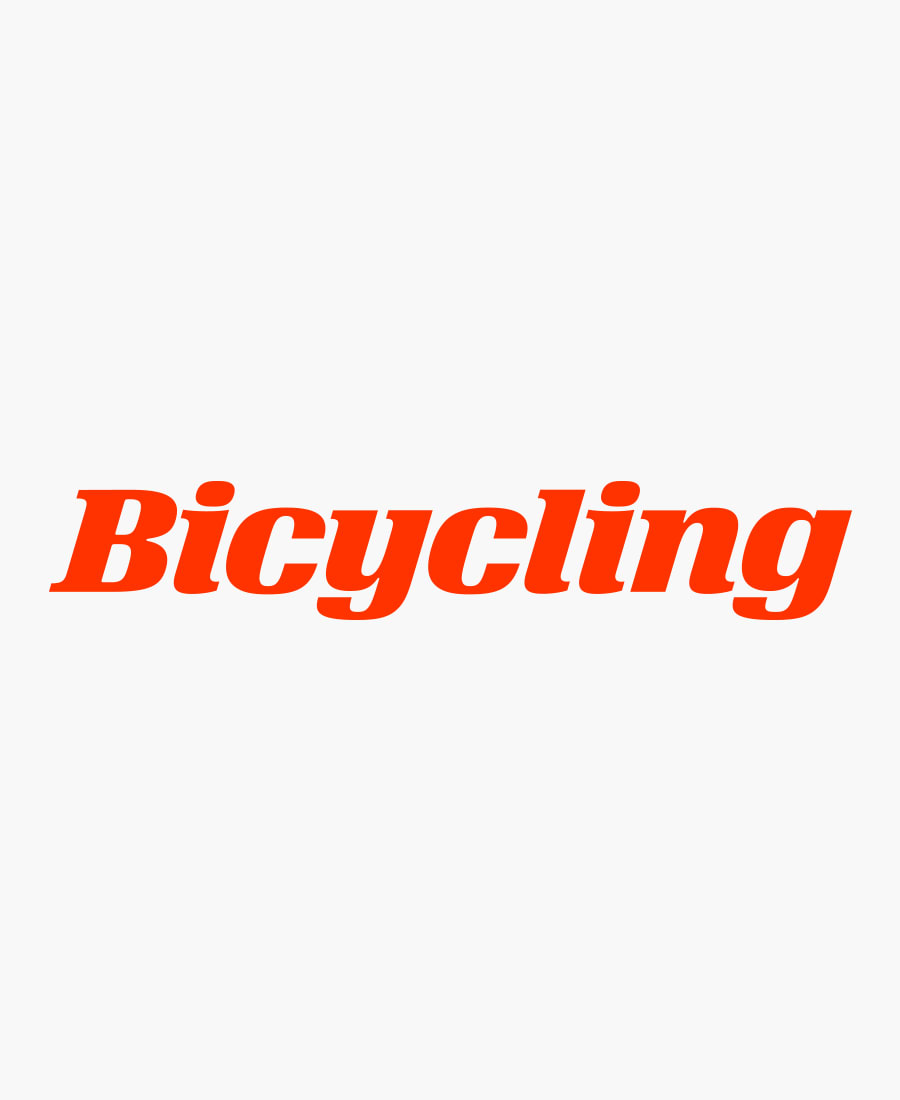
"One of the fiercest climbing bikes available, the new Émonda is even faster thanks to a dose of aero"
"I expect so much from a modern high-end pro-level road racing bike that it’s hard to exceed those expectations. It’s rare when a bike does: The Émonda SLR is one of those rare bikes."

"It's an incredible update from Trek"
"The updated Emonda packs one helluva punch, and Trek has a winner on its hands. The integrated cockpit is nice and all, but the real win is the H1.5 fit, which makes the Emonda feel more stable while maintaining the aggression and responsiveness of previous Emondas. That, coupled with a lightweight construction, comfortable ride, and aerodynamic shaping, brings Trek's top of the line climber from a very good bike to an excellent one."
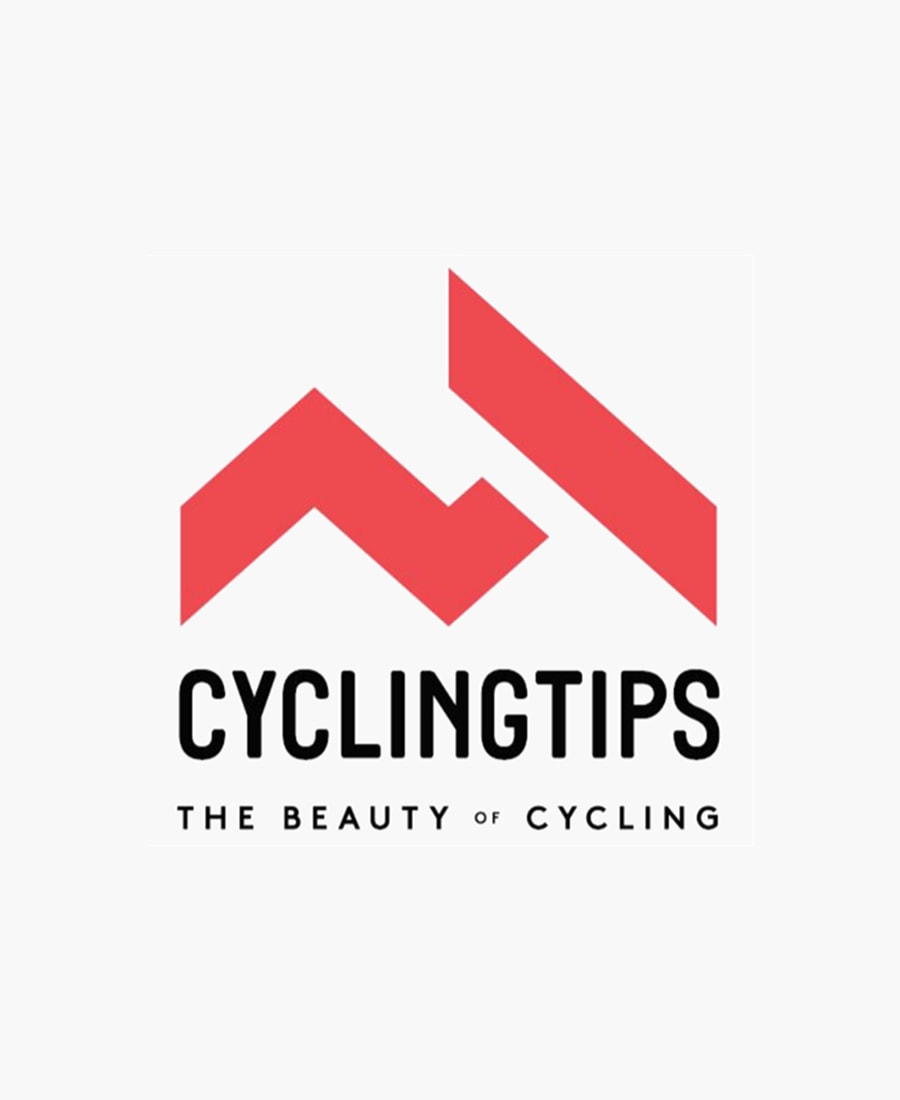
"The Emonda is still light, and it’s still stiff, but now there’s an extra dose of free speed"
"Overall, Trek has done a solid job here of updating the Emonda, infusing meaningful improvements in several key areas, but without breaking the basic formula that has made the bike so popular."
More options
trek 3700 disc mountain bike

IMAGES
VIDEO
COMMENTS
The SL's frame comes in at 1,142 grams, with a 380-gram fork (SLR fork weight: 365 grams). But material (and weight) are the only difference between the SL and SLR. Aeolus Bar Stem
The range of frame sizes varies, depending on the model and fit of the frame. The SL6 is offered in sizes 47-62cm with a H2 fit only while the SLR6 is available in sizes 50-62cm with a H1 fit and 47-64cm with a H2 fit. Trek's H1 fit can be considered very aggressive and race-oriented, affording plenty of handlebar drop.
The following picture shows the comparison with Specialized Tarmac SL 7. Trek Emonda vs. Specialized Tarmac SL7 geometry comparison using the bikeinsights.com tool Weight & Aerodynamics. Trek Émonda frame weighs 760g in size 56. The highest-end Émonda even weighs below the UCI 6.8 kg limit. However, low weight is not everything.
When it was first released, the Emonda was a climber's dream that Trek claimed as the world's lightest production offering. Dealer events would have the ultra-premium 4.6 kg (10.25 lb) SLR 10 hanging from large helium balloons, and the American company made a big deal of it providing a benchmark stiffness-to-weight ratio.
Trek continues to work on developing the Émonda, dropping the weight of the top end Trek Émonda SLR to 640g in a size 56cm (665g with discs) and 1091g for the Trek Émonda SL (1149g with discs ...
Trek Emonda 2021 - ALR or SL. Jump to Latest ... Still ride: '21 Trek Emonda SL5, '15 Giant TCX SLR 1, '10 Jamis Sputnik Used to ride: '06 Trek 5200, '06 Gary Fisher Cake 2 DLX, '08 Trek Madone 5.2 Pro, '11 Trek Superfly, '12 Specialized Langster, '14 Specialized Allez - Tour Edition Frame ... Lookin at gettin a Sl-5 or 6, any updates on weight ...
The Émonda line-up can be split into three: the Trek Émonda SLR, SL and ALR. The SLR is the flagship build with a brand new frame designed out of 700 OCLV carbon. The SL model is based on the current Emonda SLR, but has adopted a more affordable carbon lay-up. The rim brake frame model weighs in at 1091 g while the disc model is 1149 g.
The current equivalent Madone has a claimed weight of over 1.3 pounds heavier than the Emonda SLR 9 eTap. I used the Trek Emonda SLR 9 eTap as a long-term review bike, putting it on the roads for ...
A look at the Trek Emonda SL 6 Pro 2021. A quality frameset that works both on the flat and the climbs - and well specced for the money. ... The SLR models also use a new OCLV 800 grade carbon fibre while the SLs use the 500 series, which increases the weight a bit, although a claimed frame weight of 1,142g and 380g for the fork is far from ...
Trek made quite a splash when it unveiled the stunningly light Emonda SLR 10, with its jaw-dropping 4.65kg (10.25lb) claimed weight and a correspondingly high price. We'd argue that the SLR 8 ...
With the Emonda SLR bikes, Trek has taken that winning formula and added additional aerodynamic tweaks to make the bikes even faster. In this review, we'll be looking at the latest Emonda SLR 7 which retail for $8,999.99 and sits in the middle of the SLR range. The SLR 7 combines the 800 Series OCLV carbon fiber frame with fast shifting ...
Coming in at 8.55kg (18.8lb), the Emonda SL 5 is light but it doesn't feel like Trek has filled the tubes with helium (the frame weight is a claimed 1,091g, size 56cm). The Merlin Nitro SL (£200 more expensive at £1,999.99) that we reviewed back in the summer hit the scales at 7.7kg (17.0lb), for instance, while the Boardman SLR Endurance ...
As with the entire Emonda range the SL6 Pro runs on Bontrager wheels; Aeolus Elite 35 to be precise. These feature a carbon 35mm depth and complement the new 'aero' frame without compromising too ...
The 2021 Trek Emonda SL 6 Pro is an uncompromising and spectacularly stiff all-round race bike, but one spec niggle makes it is just short of greatness.
See the bike and visit your local Trek retailer. Shop now! Discover your next great ride with Émonda SLR 9 Disc. ... Emonda SLR full carbon, tapered carbon steerer, internal brake routing, flat mount disc, 12x100mm thru axle: ... Weight: 56 - 6.72 kg / 14.82 lbs: Weight limit: This bike has a maximum total weight limit (combined weight of ...
Upgrade pOTENTIAL. Trek offer the Émonda SL 6 as standard in two variants; the SL 6, at £2900 with Bontrager Paradigm alloy rims and the SL 6 Pro at £3350, which is the same bike but equipped with Bontrager's Aeolus Elite 35 carbon wheels. Both wheelsets are tubeless ready, but the Paradigm are a fairly "entry level" wheelset, tough and ...
The Trek Emonda SL 6 is a high-performance road bike with a carbon frame and advanced features for an exceptional riding experience.
Trek's original climbing bike is aero, weighs in at less than 700g, and rides like a dream. Wireless Ultegra Di2 delivers even faster, smoother, and more responsive shifts than ever. 800 Series OCLV Carbon is incredibly light and meticulously crafted for next-level performance. Aerodynamic tube shaping makes this our fastest Émonda SLR ...
Giant Propel Advanced SL 0 Trek Madone SLR 7 Gen 8 ... My own 2015 Trek Emonda ALR with box-section rims, rim brakes, external cables and round bars. ... it's well within the aero and weight ...
The Emonda ALR will initially come in two builds, the "6" with full Ultegra, Bontrager Race tubeless ready wheels with R2 tires, and a Bontrager cockpit with alloy short reach/drop bar and carbon seatpost for $2,249.99. Our local Trek Bike Store says complete bike weight is claimed at 17.25lb (7.82kg). The Emonda ALR 5 drops down to a full ...
Gear-obsessed editors choose every product we review. We may earn commission if you buy from a link. How we test gear. The New Trek Émonda Is Faster Than Ever. Already one of the
Émonda SL 5. 65 Reviews / Write a Review. $2,499.93 $3,349.99. Model 5277654. Retailer prices may vary depending on location and delivery method. The final price will be shown in your cart. Émonda SL 5 is a lightweight carbon road bike with a balanced ride quality, superior handling characteristics, and the added benefit of free speed thanks ...
Trek just introduced a totally new re-imagining of the Emonda, the brand's lightweight climbing/GC model platform, with a substantially aero-ised chassis.The model family is divid
I'm in Moscow for 4 days this weekend and think about which lenses to take with me. I have a 50D. My lenses: EF-S 10-22mm 17-40mmL 24-105mmL IS